HOW DEFINITE ARE WE ABOUT THE ENGLISH ARTICLE SYSTEM? CHINESE
LEARNERS, L1 INTERFERENCE AND THE TEACHING OF ARTICLES IN
ENGLISH FOR ACADEMIC PURPOSES PROGRAMMES.
By
RICHARD NICKALLS
A thesis submitted to
The University of Birmingham
for the degree of
DOCTOR OF PHILOSOPHY
Department of English Language and Applied
Linguistics
School of English, Drama and American &
Canadian Studies
College of Arts and Law
The University of Birmingham
December 2019

University of Birmingham Research Archive
e-theses repository
This unpublished thesis/dissertation is copyright of the author and/or third
parties. The intellectual property rights of the author or third parties in respect
of this work are as defined by The Copyright Designs and Patents Act 1988 or
as modified by any successor legislation.
Any use made of information contained in this thesis/dissertation must be in
accordance with that legislation and must be properly acknowledged. Further
distribution or reproduction in any format is prohibited without the permission
of the copyright holder.
ABSTRACT
Omission and overspecification of the/a/an/Ø are among the most frequently occurring
grammatical errors made in English academic writing by Chinese first language (L1) university
students (Chuang & Nesi, 2006; Lee & Chen, 2009). However, in the context of competing
demands in the English for academic purposes (EAP) syllabus and conflicting evidence about
the effectiveness of error correction, EAP tutors are often unsure about whether article use
should or could be a focus and whether such errors should be corrected or ignored. With the
aim of informing pedagogy, this study investigates: whether explicit teaching or correction
improves accuracy; which article uses present the most challenges for Chinese students; the
causes of error and whether a focus on article form can be integrated within a modern genre
based/student centred approach in EAP. First, a questionnaire survey investigates how EAP
teachers in higher education explicitly teach or correct English article use. Second, the effect
of explicit teaching and correction on English article accuracy is investigated in a longitudinal
experiment with a control group. Analysis of this study’s post-study measures raise questions
about the sustained benefits of written correction or decontextualised rule-based approaches.
Third, findings are presented from a corpus-based study which includes an inductive and
deductive analysis of the errors made by Chinese students. Finally, in a fourth study hypotheses
are tested using a multiple-choice test (n=455) and the main findings are presented: 1) that
general referential article accuracy is significantly affected by proficiency level, genre and
students’ familiarity with the topic; 2) Chinese students are most challenged by generic and
non-referential contexts of use which may be partly attributable to the lack of positive L1
transfer effects; 3) overspecification of definite articles is a frequent problem that sometimes
gives Chinese B2 level students’ writing an ‘informal tone’; and 4) higher nominal density of
pre-qualified noun phrases in academic writing is significantly associated with higher error
rates. Several practical recommendations are presented which integrate an occasional focus on
article form with whole text teaching, autonomous proofreading skills, register awareness, and
genre-based approaches to EAP pedagogy.
DEDICATION
This thesis is dedicated:
To my loving family, past and present.
ACKNOWLEDGEMENTS
At the University of Birmingham, I am profoundly grateful to Professor Jeannette Littlemore
and Dr. Nicholas Groom for helping me through my Masters and then later supervising me at
Doctoral level. My thesis (perhaps even more so than most) has ended up a long way from
where we started (the proposal they agreed to supervise) and I’m very grateful for their
tolerance and continued interest. I need to express my sincere gratitude to the many students
who have participated in various studies and my many colleagues who have contributed to this
research.
There’s too little space to mention every single academic, student and colleague who has
generously helped me or simply exchanged ideas on this rather dry topic – but they know who
they are. A special thanks to Jane Sjoberg and my nephew Oliver for checking my thesis for
typos and inconsistencies. Thanks to Dr. Oliver Mason for use of his Java-based programme
to extract noun phrases and to Dr. Laurence Anthony of Waseda University for programming
(and regularly updating) the freely available Ant. Conc. Programme. For help in understanding
aspects of the Chinese language I must finally thank Zhijun Wang, Shimeng Liu and Xinyu Li.
i
Table of Contents
1 INTRODUCTION ......................................................................................................... 1
1.1 Brief overview ........................................................................................................ 1
1.2 Personal interest ...................................................................................................... 2
1.3 Background and justification for the research .......................................................... 4
1.4 Previous Research into Chinese L1 learners’ English article accuracy ..................... 8
1.5 Summary of research aims .................................................................................... 10
1.6 Thesis overview .................................................................................................... 11
2 LITERATURE REVIEW ............................................................................................ 15
2.1 Key term definitions.............................................................................................. 15
2.2 The English article system .................................................................................... 17
2.3 Contrastive Analysis ............................................................................................. 26
2.4 Empirical research into Chinese L1 learners’ written L2 English errors ................. 32
2.5 Other factors influencing English Accuracy .......................................................... 41
2.6 English articles within the current EAP pedagogical paradigms............................. 49
2.7 Empirical research into the effect of teaching and correcting articles ..................... 52
2.8 Research Questions ............................................................................................... 55
ii
iii
3 METHODOLOGY ...................................................................................................... 59
3.1 Critical methodological issues in Error Analysis ................................................... 59
3.2 Error detection ...................................................................................................... 62
3.3 Error classification ................................................................................................ 65
3.4 Error explanation .................................................................................................. 66
3.5 Evaluation of recent methods in English article studies ......................................... 67
3.6 The need for a preliminary study ........................................................................... 75
3.7 Preliminary study .................................................................................................. 76
3.8 Summary of methodological approaches in main studies ....................................... 84
3.9 Conclusion ............................................................................................................ 85
4 SURVEY OF TEACHER ATTTITUDES AND PRACTICES .................................... 87
4.1 Background and recap of Research Question 1 ...................................................... 88
4.2 Methodology ......................................................................................................... 91
4.3 Results and Discussion .......................................................................................... 96
4.4 Conclusion .......................................................................................................... 122
iv
v
5 LONGITUDINAL STUDY OF THE EFFECT OF TEACHING/ CORRECTION ON 24
(L1 MANDARIN) LEARNERS OF ENGLISH ON A 15-WEEK PRESESSIONAL ENGLISH
COURSE .......................................................................................................................... 127
5.1 Study overview ................................................................................................... 128
5.2 Methodology ....................................................................................................... 129
5.3 Ethical issues ...................................................................................................... 143
5.4 Constraints of the study ....................................................................................... 145
5.5 Data analysis ....................................................................................................... 145
5.6 Tagging reliability checks and inter-rater reliability checks ................................. 151
5.7 Results and discussion......................................................................................... 154
5.8 Conclusion .......................................................................................................... 172
6 CONTRASTIVE ANALYSIS OF CORPORA .......................................................... 177
6.1 Study overview ................................................................................................... 177
6.2 Methodology ....................................................................................................... 179
6.3 Data analysis ....................................................................................................... 184
6.4 Results and discussion......................................................................................... 186
6.5 L1 transfer effects ............................................................................................... 211
vi
vii
6.6 Linguistic context of noun phrases ...................................................................... 212
6.7 Conclusion .......................................................................................................... 215
7 TESTING OF HYPOTHESES USING ONLINE MULTIPLE-CHOICE
GRAMMATICALITY JUDGEMENT TEST .................................................................... 221
7.1 Study overview ................................................................................................... 223
7.2 Methodology ....................................................................................................... 225
7.3 Findings and discussion ...................................................................................... 235
7.4 Conclusion .......................................................................................................... 242
8 CONCLUSIONS ....................................................................................................... 247
8.1 Restatement of aims ............................................................................................ 247
8.2 Summary of main findings .................................................................................. 247
8.3 Limitations and future research ........................................................................... 258
8.4 Recommendations for EAP instructors ................................................................ 259
8.5 Final comments ................................................................................................... 262
REFERENCES ................................................................................................................. 267
APPENDICES .................................................................................................................. 279
APPENDIX 1 ................................................................................................................ 279
viii
ix
APPENDIX 2 ................................................................................................................ 281
APPENDIX 3 ................................................................................................................ 293
APPENDIX 4 ................................................................................................................ 303
APPENDIX 5 ................................................................................................................ 311
APPENDIX 6 ................................................................................................................ 318
APPENDIX 7 ................................................................................................................ 322
APPENDIX 8 ................................................................................................................ 324
APPENDIX 9 ................................................................................................................ 334
APPENDIX 10 .............................................................................................................. 341
x

xi
Abbreviations
In this thesis, the following abbreviations are used:
BALEAP
BIA
CEFR
DELTA
EAP
EFL
EGAP
EISU
ELAL
ESOL
ESP
IELTS
L1
L2
OED
SELT
UKVI
British Association of Lecturers of English for Academic Purposes
Birmingham International Academy
Common European Framework of Reference for Languages
Diploma in Teaching English to Speakers of Other Languages
English for Academic Purposes
English as a Foreign Language
English for General Academic Purposes
English for International Students Unit (Former name of BIA)
Department of English Language and Applied Linguistics
English for Speakers of Other Languages
English for Specific Purposes
International English Language Testing System
First Language (once called ‘native language’)
Second Language
Oxford English Dictionary
Secure English Language Test
UK Visas and Immigration
xii
xiii
Table of Figures
Figure 1: Examples of generic NPs in all forms (Krifka & Gerstner, 1987).......................... 20
Figure 2: Further examples of non-referential noun phrases from Ekiert (2004)................... 22
Figure 3: Comparison of means of missed the by category (Liu and Gleason, 2002: 13) ...... 33
Figure 4: Example of definite article ‘overuse’ from Lee & Chen (2009: 287) ..................... 35
Figure 5: Reproduced from Chuang and Nesi (2006: 257): 3 stages of developing a tagging
system ................................................................................................................................. 75
Figure 6: Summary of mixed method approach to Error Analysis ........................................ 85
Figure 7: Survey Question 1 ................................................................................................ 93
Figure 8: EISU EAP Tutor Responses to Question 1 (n=12) ................................................ 97
Figure 9: BALEAP mailing list responses to Question 1 (n=127) ........................................ 97
Figure 10: ELAL MA Distance programme responses to Question 1 (n=53) ....................... 98
Figure 11: EISU EAP Tutors’ responses to Question 2 (n=12)............................................. 99
Figure 12: BALEAP list EAP Tutors’ responses to Question 2 (n=127)............................... 99
Figure 13: ELAL MA Distance programme responses to Question 2 (n=53) ..................... 100
Figure 14: Question 3 prompt ............................................................................................ 101
Figure 15: EISU EAP Tutors Question 3 (in class) n=12 ................................................... 102
Figure 16: BALEAP EAP Tutors Question 3 (in class) n=120 ........................................... 102
xiv
xv
Figure 17: ELAL MA Distance programme Question 3 (in class correction) n=52 ............ 102
Figure 18: EISU Tutors Question 4 (weekly homework) n=12 ......................................... 103
Figure 19: BALEAP EAP Tutors Question 3 (weekly homework) n=127 .......................... 103
Figure 20: ELAL MA Distance Programme Tutors Q.3 (weekly homework) n=53 ............ 104
Figure 21: EISU Tutors Question 3 (in first draft) n=12................................................... 104
Figure 22: BALEAP EAP Tutors Question 3 (in first draft) n=127 .................................... 105
Figure 23: MA list tutors Question 3 (in first draft) n=52 ................................................. 105
Figure 24: BIA EAP Tutors Question 3 (conference paper) n=12 ..................................... 105
Figure 25: BALEAP EAP Tutors Question 3 (conference paper) n=127 ............................ 106
Figure 26: MA List Tutors Question 3 (conference paper) n=52 ........................................ 106
Figure 27: Transcribed extract Tutor #1 ............................................................................ 108
Figure 28: Transcribed extract Tutor #2 ............................................................................ 110
Figure 29: Transcribed extract Tutor #3 ............................................................................ 112
Figure 30: Transcribed extract Tutor #4 ............................................................................ 114
Figure 31: Transcribed extract Tutor #5 ............................................................................ 115
Figure 32: Tutor #5 continued ........................................................................................... 116
xvi
xvii
Figure 33: BALEAP list pedagogical recommendations (number of mentions, n=101) ...... 117
Figure 34: Transcribed extract Tutor #6 ............................................................................ 118
Figure 35: Reasons given for not teaching articles explicitly (n=101) ................................ 121
Figure 36: Three group experimental design ...................................................................... 129
Figure 37: Policy of tagging for correctness ...................................................................... 148
Figure 38: Example 1: Identification of error problems .................................................... 149
Figure 39: Example 2: Overt errors ................................................................................... 150
Figure 40: Example 2 from annotator instruction materials ................................................ 152
Figure 41: Oversuppiance issue disagreements .................................................................. 153
Figure 42: Appropriacy for genre disagreements ............................................................... 153
Figure 43: Disagreements about whether Type 3 or Type 4 ............................................... 154
Figure 44: Box plot showing distributions of median TLU scores (n=24) ......................... 154
Figure 45: Target-Like Use of definite article (Type 1, 2 and 5 combined) ....................... 157
Figure 46: Target-Like Use of Ø (Types 1, 3, 4 and 5 combined) ...................................... 158
Figure 47: Target-Like Use of a/an (Types 1, 3 and 5 combined) ...................................... 158
Figure 48: TLU of 2DA definite article (n=24, all participants by group) .......................... 159
Figure 49: Progress by three groups (Mdn TLU of Ø) n=24 .............................................. 164
xviii
xix
Figure 50: Bar chart – omission and oversuppliance of definite articles in Task 1 .............. 166
Figure 51: Bar chart – omission and oversuppliance of definite articles in Task 2 .............. 166
Figure 52: Participant responses to Survey Question 3 (n=23) ........................................... 169
Figure 53: Participant responses to Survey Question 4 (n=23) ........................................... 170
Figure 54: Tutor examples................................................................................................. 189
Figure 55: Student examples ............................................................................................. 189
Figure 56: Median TLU scores in the three article types (3 prompts, n =24). ..................... 191
Figure 57: 2GADA errors compared to 2DA correct use ................................................... 197
Figure 58: 4GAZA errors compared to 4ZA correct use .................................................... 200
Figure 59: 4GAIA errors compared to 4IA correct use ...................................................... 202
Figure 60: 3GAIA errors compared to 3IA correct use ...................................................... 204
Figure 61: 5GADA errors compared to 5DA correct use ................................................... 206
Figure 62: 1GADA errors compared to 1DA correct use ................................................... 207
Figure 63: 3GAZA errors compared to 3ZA correct use .................................................... 208
Figure 64: 1GAIA errors compared to 1IA correct use ...................................................... 210
Figure 65: 5GAIA errors compared to 5IA correct use ...................................................... 211
Figure 66: Omissions of article with nouns pre-qualified with proper nouns ...................... 213
xx
xxi
Figure 67: Typical omission and oversuppliance errors (with pre-modified head nouns) ... 214
Figure 68: Example of question development (Question 10) .............................................. 227
Figure 69: Example of multiple dropdown question .......................................................... 228
Figure 70: Paired noun phrase examples ............................................................................ 229
Figure 71: Histogram showing overall IELTs scores ......................................................... 233
Figure 72: Histogram showing IELTS writing test scores .................................................. 234
Figure 73: Histogram of test scores ................................................................................... 235
Figure 74: Oversuppliance (ten questions) box-plot (n=455) ............................................. 237
Figure 75: Boxplot of omission rates (grouped by proficiency) in complex noun phrases .. 240
Figure 76: The relationship between general writing ability and overall test scores (n=455, 100
question items) .................................................................................................................. 242
Figure 77: Mapping specific-general functions of lexis to research project structure .......... 261
Figure 78: Deduced uses by Chinese L1 Engineering student [anonymised] ...................... 262
Figure 79: Student 1, conversation #1 ............................................................................... 324
Figure 80: Student 1, conversation #2................................................................................ 325
Figure 81: Student 1, conversation #3................................................................................ 325
Figure 82: Student 1, conversation #4 ............................................................................... 326
Figure 83: Student 1, conversation #5................................................................................ 326
xxii
xxiii
Figure 84: Student 1, conversation #6................................................................................ 327
Figure 85: Student 2, conversation #1................................................................................ 328
Figure 86: student 2, conversation 7 ................................................................................. 328
Figure 87: Student 2, conversation 8 ................................................................................. 329
Figure 88: Student 2, conversation 9................................................................................. 329
Figure 89: Student 2, conversation 10 ............................................................................... 330
Figure 90: Student 3, conversation 11................................................................................ 331
Figure 91: Student 3, conversation 12................................................................................ 332
Figure 92: Student 3 conversation 13................................................................................. 332
Figure 93: Distribution of written placement test scores (Chapter 5) ................................. 341
Figure 94: Distribution of student scores in the placement test........................................... 341
Figure 95: Test of normality (Q scores) ............................................................................. 342
Figure 96: Tests of Normality (Detrended Q scores) .......................................................... 343
xxiv
xxv
Table of Tables
Table 1: Bickerton’s (1981) semantic and pragmatic Framework ........................................ 18
Table 2: A comparison of important corpus findings ........................................................... 41
Table 3: Error Analysis Steps/common methodological issues ............................................ 60
Table 4: Review of influential article acquisition/corpus-based studies ................................ 68
Table 5: Five learner corpus studies compared .................................................................... 72
Table 6: IELTS score descriptions (from IELTS, 2012) ....................................................... 82
Table 7: Response rates ....................................................................................................... 95
Table 8: Participant information ........................................................................................ 133
Table 9: Essay prompts ..................................................................................................... 136
Table 10: BME Teaching materials ................................................................................... 139
Table 11: Five extra English article sessions...................................................................... 141
Table 12: Tagging system for correct uses (Díez-Bedmar & Papp, 2008) .......................... 146
Table 13: Tagging system for incorrect uses (Díez-Bedmar & Papp, 2008) ....................... 146
Table 14: TLU ratings for all groups summarised (n=24) with no adjustment .................... 155
Table 15:TLU ratings all groups (n=24) with adjustments* for zero counts ....................... 156
Table 16: Wilcoxon Signed Rank Test *=statistically significant at 0.05 .......................... 160
xxvi
xxvii
Table 17: Omission and Oversuppliance of definite articles (all types, Mdn coefficients*) 165
Table 18: Misuse of article errors ...................................................................................... 167
Table 19: Participant information (including borderline B1/B2 students). .......................... 181
Table 20: Four Task prompts ............................................................................................. 183
Table 21: Framework adapted from Bickerton’s (1981) semantic and pragmatic uses ........ 185
Table 22: Proportion of errors by context .......................................................................... 187
Table 23: L1 writers (n=5) article uses compared to Chinese L1 essays (n=24) ................ 188
Table 24: Overall TLU (all essays) in all contexts (n=24) ................................................. 192
Table 25: TLU is essay prompts compared to case study prompt ...................................... 194
Table 26: The effect of pre-modification ........................................................................... 199
Table 27: Density of noun phrases (in 610 article errors) ................................................... 212
Table 28: Analysis of 9186 correct noun phrases ............................................................... 212
Table 29: Results of ten questions investigating oversuppliance (n=455) ........................... 236
Table 30: Articles omitted in twenty nominal groups (with and without pre-modification) 239
xxviii

1
1 INTRODUCTION
1.1 Brief overview
This PhD research stems from an interest in one of the most confusing and frequent
grammatical choices that learners of English must make: whether to use the, a/an, or no article
(Ø) in written production. The is by far the most commonly occurring word in the English
language (Sinclair, 1991) and, since the most frequent choice is not to use any determiner, the
Ø article has been argued to be the most frequently occurring free morpheme (Master, 1997).
On the assumption that accuracy is considered important, a focus on these small words in
English for Academic Purpose (EAP) classes appears necessary, as it has long been pointed
out that the/a/an together account for more than one in every ten words in academic writing
(Berry, 1991).
While the complexities of the English article system are likely to challenge all international
students whose first language is not English, the literature suggests that students from a first
language (L1) background that does not grammaticalise definiteness/specificity may face
particular challenges in applying certain aspects of the English article system (Master, 1997;
Lu, 2001; Ekiert, 2004; Díez-Bedmar & Papp, 2008; Snape, Mayo & Gürel, 2013; Crosthwaite,
2012, 2016a). The extent to which Chinese Mandarin grammaticalises these notions will be
discussed in Chapter 2, but some researchers have claimed that Chinese learners’ first language
affects their use of the/a/an/Ø in academic writing at university at Upper-Intermediate levels
of English proficiency (Milton, 2001; Chuang & Nesi, 2006; Díez-Bedmar & Papp, 2008; Lee
& Chen 2009). Indeed, it has been suggested that article errors (omission and overspecification
of the definite article) are the most commonly occurring grammatical errors made in English
academic writing by Chinese L1 undergraduate university students (Chuang & Nesi, 2006).
The increase in the numbers of Chinese L1 students in UK Higher Education over the past 15
2
years (see Section 1.3.1) has further heightened the need to understand these students’
challenges with English articles in academic writing.
Having briefly outlined the topic, this chapter now has four aims: to explain my personal and
professional interest in this research, to justify this interest in academic terms, to highlight why
further research is necessary and to outline the structure of this thesis.
1.2 Personal interest
My curiosity regarding EAP students’ article usage can first be explained anecdotally. In my
observations of over 30 EAP teachers in my role coordinating an English for Academic
Purposes Presessional at a UK university (some of whom were new entrants to EAP from the
fields of English as a Foreign Language and English as a Second Language), it has been my
personal experience that the English article system can be taught effectively by EAP tutors. As
will be illustrated in Chapter 4, which presents a survey of English for Academic Purposes
(EAP) tutors’ beliefs and practices regarding the teaching of English articles, many tutors
manage to focus students on accurate article use in authentic academic texts in ways which
motivate students and promote learner autonomy. However, my experience over 14 years of
teaching EAP suggests that some tutors are unsure about whether they can and how they should
improve students’ accuracy in English articles. Can and should they teach article use? If so,
which aspects of the article system challenge Chinese L1 learners most? Should they correct
article errors in academic writing feedback and does this help learners or simply discourage
them?
Unfortunately, some EAP tutors have not stopped to even ask the questions above. In a
depressingly similar fashion to my own experiences as a learner of second languages, I have
also sometimes noticed students being overcorrected and discouraged, taught rules they already
3
learned in middle school, made to complete decontextualised grammar gap-fill exercises that
may have little effect on written production, told oversimplified rules and even provided with
incorrect advice and feedback.
On the opposite end of the spectrum, some tutors totally avoid focussing on the English article
system in EAP. As discussed in Chapter 4, possible causes can include a tutor’s lack of
confidence of their own understanding of the article system, some tutors’ belief that students
can naturally improve article accuracy without intervention, a principled objection to focussing
on form within EAP, or a perception that article errors are trivial surface errors. Irrespective
of the tutors’ beliefs, many also perceive that they have insufficient time to devote to this minor
error in the typical EAP curriculum in which the need for accuracy of articles has to compete
with many more important priorities. Moreover, given that genre analysis, register awareness,
and many competing lexico-grammatical areas are simpler to teach and have proven efficacy,
many tutors need convincing that a focus on article accuracy could and should merit occasional
attention in the EAP classroom.
Although the personal anecdotal evidence presented above is not proposed to support the
claims made in this thesis, these experiences underpin my personal and professional motivation
for addressing the topic. The following section will present the more academic background to
this issue before summarising the aims of this thesis: to give EAP tutors greater clarity on
whether they can and how they can facilitate improved English article accuracy among Chinese
learners.
4
1.3 Background and justification for the research
1.3.1 Justification for the focus on Chinese L1 Postgraduate level students
The focus on the English article use of Chinese L1 international students at postgraduate level
is justified due to the massive expansion of Chinese L1 students studying in many UK HE
institutions over the last 15 years (Universities UK, 2019). According to this source, 19.6% of
the total UK student population in 2017/18 were international students making a net worth
contribution to the UK of £20.3bn. Of these 458,490 international students, 106,530 came
from China and this figure has been rising steadily since 2013. Over 70% of students in the
summer Presessional English for Academic Purposes Programme at the author’s own
institution are Chinese L1 students who progress onto postgraduate programmes in which they
often outnumber home students, notably in the university’s Business and Engineering Schools.
This reflects broader national trends, for which current data indicate that the majority of
postgraduate Chinese speaking students enrol onto Business studies, Economics, Accounting
and Finance, and Engineering programmes at UK universities (The Higher Education Statistics
Agency, 2019). It thus seemed appropriate to focus on Chinese L1 Business School students in
the studies presented in Chapter 5 and 6. These official UK statistics may already be out of date
according to a recent Guardian Newspaper report (Weale, 2019) which suggests that
applications for study in the UK 2019/20 have increased by 30% due to China-US tensions. It
is therefore more relevant than ever to understand any L1 effects upon language inaccuracy.
The question of whether Chinese students could be assisted to improve their English article
accuracy is also related to the instruction provided within the university setting and the
following section therefore provides the definition and background of English for Academic
Purposes (EAP).
5
1.3.2 English for Academic Purposes (EAP)
Rather than being defined simply as English lessons in a university setting, English for
Academic Purposes (EAP) is generally argued to be a separate paradigm of instruction (Swales,
1990; Flowerdew & Peacock, 2001; Hyland & Hamp-Lyons, 2002; Alexander, Argent &
Spencer, 2008). Linked to the greater use of English across the world by non-native speakers
of English (Flowerdew & Peacock, 2001), the proliferation and expansion of EAP courses in
the UK is also related to the internationalisation strategies of many UK universities. In the UK
context, the term EAP covers a broad range of activities including highly specific courses
embedded within disciplines; presessional courses designed for students who have not reached
the English proficiency entry requirements and need to show some progress before starting
their intended academic programme; insessional classes covering a ‘core skills’ approach
offered to all students during their programme, and new forms of integrated academic English
skills and content instruction such as Foundation programmes. The core defining feature of
any EAP course is that the objectives are needs-focussed with the aim to help international
students achieve success in their intended academic community (Hyland & Hamp-Lyons,
2002).
Any discussion about whether English article accuracy can be a focus in the EAP curriculum
needs to recognise the competing demands for any EAP tutor’s time in the classroom. As will
be developed in Chapter 2, a focus on language forms such as the/a/an/Ø needs to be integrated
within a curriculum which has an arguably greater priority of preparing students for the
functions and processes of academic writing. While most EAP Presessional courses offer a
mixture of general and academic English, EAP is often defined by its more dominant focus
on the socialisation of students within their discourse communities which involves special
attention to the genres of writing that students will be producing in these communities (Swales,
6
1990; Swales, 2004; Swales & Feak, 2004) and the many variances in genre across disciplines
(Hyland, 2002a, 2007b; Nesi & Gardner, 2012). In contrast to the general English syllabus
which prepares students for English language demands in their entirety (an integrated syllabus
which tends to recycle grammatical accuracy issues over shorter texts of various topics), the
‘EAP paradigm’ involves more time restricted programmes on academic English more
focussed on writing and reading (Alexander, Argent, & Spencer, 2008). This generally entails
deeper exploitation of a smaller number of denser academic texts (ibid.). With regards to
grammatical features such as English articles, an ‘EAP paradigm’ could thus be expected to
include such a focus more incidentally than general English, as and when needed, if at all
(reference will be made to the researcher’s programme in Chapter 5).
While acknowledging that some researchers continue to see accuracy in articles as acquired
naturalistically without instruction (Alexander, Argent, & Spencer, 2008), this thesis makes the
assumption that a focus on form in language generally accelerates accuracy. In EAP’s related
sister field of Second Language Acquisition (SLA) the consensus view for the past 35 years
has rejected theories of naturalistic L2 language learning of the written form of L2 (Long, 1983,
1990; Norris & Ortega, 2000; Ellis, 2006). The generally accepted view in SLA research is that
students need both content-driven ‘comprehensible input’ (Dulay, Burt & Krashen, 1982;
Nunan, 1991) in addition to a focus on form that helps learners notice patterns more
consciously (Norris and Ortega, 2000; Ellis, 2006). However, the assumption that a focus on
form has theoretical benefits should not be confused with a traditional decontextualised
approach to grammar teaching. This thesis in no way seeks to argue for a return to the
behaviourist and prescriptively ill-informed approaches of writing composition classes in the
1960s and 1970s (Paltridge, 2001). More realistically, the investigations into the effects of
different methods of teaching articles were carried out on the theoretical assumption that form-
7
focussed instruction can sometimes contribute to students’ noticing of written accuracy. This
assumption would appear solidly grounded on theory since the total rejection of any focus on
grammar is less common today in the EAP field and many EAP researchers conclude that an
incidental focus on form integrated within an EAP genre-based approach can be beneficial
(Hyland & Milton, 1997; Hinkel, 2003; Fang, Schleppegrell & Cox, 2006; Hyland, 2008).
One unresolved polemic within the EAP literature, more directly affecting the topic of this
research, relates to written error correction. The review of the literature in Chapter 2 will more
critically juxtapose the research that supports focussed written corrective feedback (Ellis, 1994;
Polio, Fleck & Leder, 1998; Ferris, 1999; Chandler, 2003; Bitchener, Young & Cameron, 2005;
Dale, Anisimoff & Narroway, 2012; Ferris & Kurzer, 2019) with research that questions the
value of the labour-intensive process of written corrective feedback (Truscott, 1996, 2004;
Crosthwaite, 2016b). Within EAP, Alexander, Argent, & Spencer (2008: 210) certainly
discourage the correcting of ‘every misuse of articles’. Thus, the practices I have anecdotally
witnessed during summer presessionals over 11 years of teaching and coordinating EAP
courses does not always appear to sit so harmoniously within the recommended practice of
EAP. It was therefore of interest to know why EAP teachers were so frequently seen to be
correcting article use and whether such correction served a purpose.
The justification of this thesis thus follows the practical objectives of past error analyses
(Corder, 1967; Master, 2002; Chuang & Nesi, 2006): to improve pedagogical approaches
through understanding. Through knowing the extent to which different contexts of article use
cause challenges for Chinese L1 learners and the reasons for which mastering some contexts
may prove more difficult, EAP pedagogy and materials development could be refined to better
suit these learners who are so highly represented in student numbers. However, as shall be
reviewed in the next section and the Literature Review, there are gaps in knowledge and
8
disagreement about the extent to which different article use contexts cause challenges for
Chinese L1 learners and even whether they continue to make frequent errors at Upper-
Intermediate levels of English proficiency.
1.4 Previous Research into Chinese L1 learners’ English article accuracy
The question of whether Chinese L1 university students make the most errors through definite
article omission (Chuang & Nesi, 2006; Díez-Bedmar & Papp, 2008) or through omission of
Ø/oversuppliance of the definite article (Lee & Chen, 2009) will be discussed further in the
next chapter and then investigated using both corpus methods and a testing approach. As the
Literature Review will show, previous studies have arrived at very different conclusions
regarding this question. While some researchers (e.g. Crosthwaite 2016a) have found that most
article contexts pose few challenges for Chinese students by the time they have reached Upper-
Intermediate levels, other researchers (e.g. Lee & Chen 2009) report frequent and meaningful
effects of article inaccuracy among Chinese majors in English and Applied Linguistics with
high levels of English.
As shall be presented in the next chapter, this thesis adopts a weak form of the Contrastive
Analysis Hypothesis. The assumption is made that learners with an L1 containing an article
system [+Article] could have a different ‘natural order of article acquisition’ to learners whose
language has no article system, but that this effect should not be oversimplified (as many other
factors affect acquisition and written accuracy). Master (1997: 216) found high levels of
inaccuracy among higher levels of article-less L1 background EAP students including Chinese
L1 learners and concluded that transfer effects were a large contributor. However, many EAP
tutors are likely to hold an overly simplified working hypothesis about the effect of L1 on their
Chinese students’ accuracy in academic English based on less evidence-based research. Over
many years, one hugely influential book has been Smith and Swan’s (2001) Learner English:
9
A teacher’s guide to interference and other problems, within which Chang’s (2001: 318)
chapter creates a somewhat negative impression of Chinese L1 writing with a strong
assumption of ubiquitous error through L1 transfer effects in L2 English:
There are no articles in Chinese. Students find it hard to use them consistently correctly. They
may omit necessary articles: *Let’s make fire *I can play piano. Or insert unnecessary ones:
*He finished the school last year. *He was in a pain. Or confuse the use of definite or
indefinite articles: *Xiao Ying is a tallest girl in the class. *He smashed the vase in the rage.
However, Chang provides little evidence to support such claims. In fact, as shall be discussed
in Chapter 2, more empirical recent research suggests that the L1 of Chinese students has a far
more complex and nuanced effect on their accuracy in different contexts of article use (Díez-
Bedmar & Papp, 2008; Crosthwaite, 2016a). These latter empirical findings are extremely
useful, particularly in the context of the competing demands for attention in the EAP syllabus
and the obvious benefit of focussing learners on specific article uses effectively, rather than on
the article system in its entirety. After reviewing this empirical research in Chapter 2, this
study will further investigate these nuanced effects and thereby contribute to the insights such
evidence can give to materials and syllabus designers in EAP.
The issue of whether article errors are minor surface errors that cause only annoyance or can
cause meaningful problems in communication is fundamental to the question of whether tutors
should attempt to teach accurate use of the/a/an/Ø articles in EAP. The issue of error gravity
(Corder, 1967) will thus need to be addressed in several chapters in this thesis. In addition to
discussing the effects of Chinese learners’ article morpheme errors in terms of sentence-level
accuracy, this research will also seek to explore the effect of article inaccuracy on the overall
register of students’ writing. Indeed, in recent years, some interest has been shown in the
writing errors that Chinese learners make (including articles, pronouns and adverbs) and the
effects these errors have on the reader’s perceived academic register of writing. A number of
10
studies have noted informal characteristics in the English academic writing of Chinese L1
university students (Mayor, 2006; Gilquin & Paquot, 2007; Lee & Chen, 2009; Chen, 2014).
Such claims are often refuted (see Leedham, 2015), but there is a possibility that this impression
is related to the observation made in the research that [-Article] L1 background students go
through a ‘flooding’ stage of definite article overuse in their acquisition process (Huebner,
1983; Master, 1997;Thomas, 1989; Zdorenko & Paradis, 2008), which has also been claimed
to be seen in Chinese L1 university students’ writing (Lu, 2001; Lee & Chen, 2009). It is
certainly possible that such effects are often overestimated in a similar way to how many EAP
tutors assume all article errors are due to L1 transfer effects, but this interference is an
interesting focus for research.
1.5 Summary of research aims
The intention is to further the EAP field’s understanding of the types of article use that cause
Chinese learners the most frequent challenges, in order to inform the development of more
targeted pedagogical resources relevant for Chinese learners in EAP. To develop this
pedagogy, a greater understanding is required not only of the errors that Chinese learners make,
but the causes of such errors (including L1 effects) and EAP tutors’ current approaches to
teaching article use. Another aim is therefore to understand the current attitudes and practices
of EAP tutors with regard to teaching and correcting article use. The findings of this research
could then help tutors to decide which article uses to teach or ignore and whether or not they
should correct errors in student writing. With a greater understanding of these article errors,
after briefly focusing learners on article forms, tutors could potentially focus students upon
self-correction and peer-marking which are more consistent with current student-centred
approaches that encourage learner autonomy. By investigating students’ accuracy and
teachers’ attitudes, the thesis inevitably touches on some of the ongoing debates in EAP.

11
Although not the main objective of this research, this thesis will contribute to the discussion
about whether an occasional focus on accuracy (morpheme choice) is fully compatible with
current approaches to teaching EAP recommended in the literature.
1.6 Thesis overview
Chapter 2
After reviewing the English article system and the effect of article errors in writing, a
contrastive analysis of Chinese Mandarin will be presented. The review of the research
literature will suggest some limited support for the L1 effect hypothesis, but also show a highly
complex range of factors affecting development and accuracy with English articles. Having
identified several gaps in the literature, the chapter summarises four Research Questions.
Chapter 3
While the procedural methodologies of the individual studies are presented in their individual
sections (Chapters 4 – 7), a methodological overview is presented in Chapter 3 of some of the
key issues that impact upon the methodological choices made in the course of the research.
The chapter also describes the ethical and methodological challenges that were identified by a
pilot study, and how these issues were resolved.
Chapter 4
Chapter 4 presents a small survey that was conducted to contextualise the research by
investigating the extent to which EAP teachers in Higher Education programmes in the UK
explicitly teach/correct English article use.

12
Chapter 5
The first main corpus-based study presented is a longitudinal study of the effect of explicit
teaching on 25 (L1 Mandarin Chinese) English learners during a 15-week Presessional
programme. The relative effects of correcting English article errors, teaching the article system
or not making any mention of articles will be compared and contrasted.
Chapter 6
Combining the data collected for the preceding study with some essays from lower proficiency
learners and case study responses, a corpus of 50,319 words was analysed for comparison with
a smaller corpus of L1 essays on the same topic. A comparison is then made between the essays
and a mini-corpus of case-studies in order to investigate genre effects on accuracy. In addition
to deductive analysis using the analytical framework developed by Bickerton (1981), some
qualitative methods and a freer/simpler corpus-driven inductive analysis of the same data are
conducted to investigate further the possible causes of errors.
Chapter 7
The final study uses a grammatical judgement multiple-choice methodology (455 participants)
to investigate several hypotheses formed as to why Chinese students oversupply or omit articles
and this chapter further investigates the link between the students’ general proficiency
development and their typical article use errors.
Chapter 8 (Conclusion)
After summarising and critically evaluating some of the findings in the four studies presented,
the final chapter provides some practical suggestions for EAP teachers wishing to focus on this
area of language. In addition to many concrete recommendations, it is hoped that several of
13
the main findings can help inform teachers’ ‘working hypotheses’ as to why students make
errors in article use and how students can be helped to improve their article accuracy.
14

15
2 LITERATURE REVIEW
The many variables which can affect Chinese L1 learners’ accuracy in any grammatical choice
are as wide ranging and complex as the English article system itself. The first section of this
chapter shows how the grammaticalisation of definiteness in the English language has led to
an extremely complex system that does not have a simple one-to-one mapping of form and
meaning. A contrastive analysis of Chinese is then presented in order to build hypotheses about
the predicted errors in later chapters. In addition to a greater understanding of the many
variables affecting article accuracy, the review of the literature presented here highlights many
areas of uncertainty that will be addressed in the Research Questions summarised in the final
section. More generally, the last part of this chapter aims to evaluate the arguments introduced
as to whether accuracy of English articles in academic writing should and could be an
appropriate focus of attention in the teaching of English for Academic Purposes.
2.1 Key term definitions
Ø article
Throughout this thesis, reference will be made to the, a/an, and Ø (zero) articles. In the
terminology employed in some of the published literature (Langendoen, 1970; Chesterman,
1991), the ‘null’ article (sometimes termed Ø2) refers to the zero article found with singular
nouns/proper nouns) as opposed to Ø used for plural/common nouns. However, to avoid
confusion, this thesis will define all contexts in which a noun phrase can be used alone (bare)
without an article or other determiner as a Ø article context. For the sake of simplicity the
thesis therefore does not distinguish between Ø article usage with proper nouns, singular, plural
or mass nouns.

16
Omission/overspecification
Based on Dulay, Burt & Krashen’s surface taxonomy (1982), most studies use the term
‘omission’ to denote a missing article in an obligatory context (Chuang & Nesi, 2006; Díez-
Bedmar & Papp, 2008; Lee & Chen 2009; Crosthwaite, 2016a, 2017). However the terms
‘overinclusion’ (Chuang & Nesi, 2006), ‘redundancy’ of article use (ibid.), ‘overspecification’
(Lee & Chen, 2009), ‘oversuppliance’ (ibid.) and ‘oversupply’ (Crosthwaite, 2016a) are among
the many different terms used in the literature to describe article use when such use is
ungrammatical/inappropriate. This study will use the nouns ‘overspecification’ and
‘oversuppliance’ and the verb forms ‘overspecify’ and ‘oversupply’ to denote inappropriate
use (when considered an error). When use of article is unnecessary but does not affect
grammatical accuracy or appropriacy, the word ‘redundancy’ is used to denote a more broad
connotation of marked use. To illustrate, the definite article in the following example taken
from a conclusion in the corpus of essays analysed in Chapter 6 shows a noun phrase (the
managers) which was agreed as correct, if marked, by three L1 English tutors. The three tutors
agreed that Ø was more likely, but that the was permissible in context of the parallel structure:
Motivation is not the only way to incentivise people in practice, since the managers just
search for the best ways in every situation [M_09552-4-Wk1]
Underuse/overuse
In contrast with omission (and its connotation of grammatical accuracy), ‘underuse’ is used in
this thesis to denote a lower than expected frequency used when compared to L1 discourse on
the same prompt or genre. Overuse is the parallel term used for quantitatively more frequent
use in a text as a whole, whether or not such use is grammatically correct.
17
2.2 The English article system
Although many Indo-European languages have some form of article system, their ancestors
(such as classical Latin and Sanskrit) did not. Today, many other world languages (Japanese,
Hindi, Chinese) do not have an article system, even if they have other markers of definiteness.
It is generally accepted that while all languages can refer to the specificity, definiteness and
number of a noun referent in some fashion, some languages have articles [+Article] while
others are article less [-Article]. The Oxford English Dictionary (OED Online, 2010), in its 23
main entries for the use of the definite article, reported that the in its current form was first seen
in the East Midlands dialect in c 1150, firmly establishing itself in English by the time of
Chaucer. Since then it can be seen from the OED that the use of the definite article has been in
a constant state of flux. In the 17
th
century all dates were preceded by the (e.g. the 1685) and
languages were always prefixed by the (i.e. the Latin), indeed the OED cites Webster in 1934
stating that ‘The modern descendants of the Latin are called the Romance languages’.
According to most sources (Bybee, Perkins & Pagliuca, 1998) it is agreed that the definite
article originated from the Old English demonstrative that (Old English did not have an article
system) while the indefinite article a/an came from the numeral one.
2.2.1 Bickerton’s four ‘Types’ of article use
Whether or not the English article system is today used uniformly by its different users, any
framework that explains its functions and forms needs to incorporate both its pragmatic and
grammatical functions. Grammatically, the form of article will in some cases depend on the
noun’s countability and number. Pragmatically, in its referential uses, articles reflect both the
context (whether the reader can infer its definiteness or indefiniteness) and the construal of
context (whether the reader can be expected to know about the referent and whether it is to be
construed in a specific or general way). Bickerton’s Framework, as shown in Table 1 below,

18
acknowledges that article choice is determined by the discourse features of the referents,
namely whether construed by the user as a specific referent [± SR] and whether known [± HK]
to the hearer. This framework provides four ‘Types’ of English article use and has the
advantage of explaining both definite, indefinite and generic uses of articles (but not idiomatic
or proper noun uses). The next section outlines each of these in turn.
Table 1: Bickerton’s (1981) semantic and pragmatic Framework
Type
Features
Context
Form of
Article
Examples
1
1
[-SR, +HK]
Generic: The reader knows of
its existence, but not a specific
reference.
a/an
Ø
The
An elephant never forgets.
Elephants never forget.
The elephant never forgets.
2
[+SR, +HK]
Writer and reader both know of
the specific referent.
The
Remember to feed the
elephant!
That’s the biggest elephant I’ve
ever seen.
3
[+SR, -HK]
The writer knows of a specific
referent the reader does not
know.
a/an
Ø
The local zoo has an elephant.
The local zoo has elephants.
4
[-SR, -HK]
Neither writer nor reader
believe the noun refers to a
specific thing
a/an
Ø
The zoo does not have an
elephant.
The zoo does not have
elephants.
1
Examples taken from Langendoen (1970), Cziko (1986), Heubner (1983), and Butler (2002).

19
Type 1 [-SR, +HK] Generic
The Type 1 (Generic) function of the English article system is used to indicate the more
general nature of the noun as a class. This generic function is often equally served by plurals,
a/an or the, as an example from Langendoen (1970) illustrates:
i. An elephant never forgets
ii. The elephant never forgets
iii. Elephants never forget
Although generic article use is one of the rarer forms of article use generally, it is far more
common in written academic English than other forms of discourse due to its use in defining
terms and topics. Indeed, Master posited some evidence (1987: 184) that generic the is most
common in essay paragraph topic statements, supporting the assumption that paragraphs
normally start with a core generalisation since, ‘topic sentences are by definition more
generalised than other sentences in the paragraph’. After analysing a corpus of articles from
the journal Scientific American, Master (1987) reported that the Ø article was the most frequent
generic article form (54%) of all generic uses, followed by generic the (38%) and finally the
generic a/an article (8%).
The importance of generic reference in academic writing is thus clear. However, an added
complication in generic noun phrases for L2 learners of English is that, as shown in Krifka and
Gerstner’s (1987) examples in Figure 1 below, generic contexts can allow various morphemes
(including Ø). That is to say that most generic phrases can be formulated in a variety of ways
with an article or Ø with plural count nouns (sentences 1, 2, 3 and 5), often with a choice of
bare plural or singular definite with little or no change in meaning.

20
1. The lion is a ferocious beast. (singular definite generic NP)
2. A lion is a ferocious beast. (singular indefinite generic NP)
3. Lions are ferocious beasts. (generic bare plurals)
4. Gold is a precious metal. (generic bare singular)
5. One cat, namely the lion, is a ferocious beast. Some cats, namely the lion and the tiger,
are ferocious beasts. (taxonomic NPs)
6. Rice was introduced in East Africa some centuries ago. (generic bare mass noun)
Figure 1: Examples of generic NPs in all forms (Krifka & Gerstner, 1987)
Mass nouns generally only allow the limited Ø article choice (sentence 6) but, apart from this
simple observation, the bewildering choice and the complicated rules of whether bare plurals
(Lions are dangerous), definite singulars (The lion is dangerous), or indefinite singulars (A
lion is dangerous) are preferred or restricted are highly complex issues (Langendoen, 1970;
Huebner, 1983; Cziko, 1986; Butler, 2002; Yang & Ionin, 2008; Ionin et al., 2011). To some
extent this complexity will clearly prove a challenge to all L2 learners of English, but section
2.3.1 will discuss claims that Chinese L1 learners may have particular issues with this type of
use.
Type 2 [+SR, +HK] Definite Articles
The definite article is the one type of article that can (and must) take only one morpheme as its
article: the. To be definite the referent must not only be specific, but must be construed as
‘known’ to the hearer. Being ‘known’ means it could be previously known or implied in an
inference to be made known through an utterance, or as Verspoor (2008) explains, ‘those
entities that are not necessarily identifiable to both the speaker and hearer, but the hearer can
infer that the speaker refers to a unique one in his mind as in “Be aware of the dog”, “I went

21
to the park”, or “I took the bus”’. As Berry points out (1991: 254), in such cases the definite
article ‘notifies the reader of the future significance of the referent’.
The definite article is also important in academic English because, although much of academic
writing at university relates to general ideas (and generic noun phrases), many of these ideas
will be supported by reference to specific examples. Moreover, the language of an academic
paper will be quasi-specific due to intra and inter-textual references; anaphoric (second
mention) reference; reference to the literature in the field; and cataphoric reference among other
functions. Quirk & Crystal (1985) identify eight functions of the definite article in writing:
as a marker of specific reference: the immediate situation (the roses are beautiful); unique
reference (the sun/the moon); anaphoric reference (second mention); cataphoric reference
(post-modified noun phrases and ‘of’phrases); sporadic reference (my sister goes to the theatre
every month); logical use with adjectives (the same, the only, superlatives) and reference to
body parts (the mind). Six of these functions of the definite article, setting sporadic reference
and body parts aside, seem most important for academic writing. Of these six written functions,
evidence suggests moreover that it is cataphoric reference which learners will most need in
academic English since, according to Biber et al. (1999), 40% of definite articles used in
academic writing have this function.
Type 3 [+SR, -HK] Indefinite articles
Where the reader cannot be assumed to have knowledge of the reference (for instance first
mention), a specific referent will be determined by a/an if a singular count noun, or Ø if
referring to a mass noun or plural count noun. Again, their use in academic English will be
related to specific examples used to support the more general claims in academic writing.
Type 4 [-SR, -HK] Non-referential noun phrases

22
When neither writer nor reader believe the noun refers to a specific thing, there is again the
same choice of morpheme: a/an for singular count nouns and Ø for non-count or plural. Further
examples from Ekiert (2004) are listed in Figure 2 overleaf. Such non-referential noun phrases
are likely to dominate much of academic writing, particularly when the genre requires general
claims, an evaluation of different (unreal) scenarios, conditional clauses and possible unproved
hypotheses.
Alice is an accountant.
I guess I should buy a new car.
Ø Foreigners would come up with a better solution.
Figure 2: Further examples of non-referential noun phrases from Ekiert (2004)
2.2.2 The conventional use of articles
Following Liu & Gleason (2002) and Ekiert (2004), this thesis will classify all uses of articles
that fall outside the Bickerton Framework, as ‘conventional use’, in that they are not a matter
of choice and do not follow immediately evident contextual considerations. This includes
idiomatic uses and proper nouns that are often taught to students as ‘things you just need to
learn’. This is not to say that such uses were not historically motivated. In fact, many uses of
proper nouns can be seen as logical (the definite article is normally only used when the proper
noun combines with a common noun). However, many uses would be difficult to explain
without in-depth research of the historical roots of the linguistic motivation.
Many discourse markers in academic English (e.g. the first point, on the other hand) could be
argued to fit into what Quirk & Crystal (1985) term ‘logical uses’ of definite article. However,
it might be more difficult to explain the majority of discourse idioms (e.g. on the whole, on the
23
rise, in the main). Even greater confusion is moreover caused by proper nouns, which normally
take Ø article (e.g. France, Mont Blanc, Peugeot, Tower Bridge) but sometimes take a definite
article (e.g. the UK, the Alps, the Seine, the Tower of London). This confusion may affect
[+Article] students as well as [-Article] learners because these conventions are so different (for
example the French would say ‘la France’ in addition to ‘le Royaume Uni’, adding a definite
article regardless of whether a country is singular, plural, a group of islands or a kingdom).
In summary, the grammaticalisation of the article system in English has led to an extremely
complex range of choices for the English L2 learner that may impact upon their writing style
and quality in academic English. Regardless of L1 background, the main problem facing all
learners is first and foremost that the article forms do not have simple form to function patterns
of use (Butler, 2002) and various forms of article have duplicated uses in different functions.
Furthermore, the learner needs to know the characteristics of the head noun before making their
choice. For Type 1 and Type 3 contexts, the choice of article often requires a knowledge of
the head noun’s singular/plural and count/mass-noun characteristics. Type 1 (generic) contexts
sometimes allow a choice of article (Ø with a plural or mass noun or a/the with a singular) but
in other cases require more restricted use. Finally, there are conventional uses that require a
knowledge of the original motivation for using the article (which may be obscured in the
present form). In sum, unlike many aspects of grammar that have a clear form/function
relationship, L2 English learners are facing a range of choices that have lesser or greater
restrictions in different contexts.
2.2.3 Evaluation of the effect of article errors
Article errors are often invisible and may be often considered less relevant in spoken English.
However, there seems a convincing argument that learners who wish to write academically or
professionally require more accurate use of articles (Master, 1987). There are two main

24
problems often caused for students who make many article errors. Firstly, the reading audience
may negatively perceive their message, equating their grammatical accuracy with their subject
knowledge (Master, 1995). Secondly, although the majority of errors are superficial – causing
only annoyance rather than confusion – some article errors can cause a barrier to effective
communication. The following example is taken from a student’s assignment in which she
first used (1) but later saw that she was meant to use (2) after teacher feedback.
The WTO has developed a high level of influence and consequently has had a large impact on
(1) …the number of trade-related issues …
(2) ...a number of trade-related issues….
(unpublished – author’s student)
In another published example Berry (1991) illustrates how article choices can have an effect
on the readers’ understanding:
(3) I want to know the English.
(4) I want to know English.
A further example from Berry shows how the article error can have a more nuanced but
nonetheless important effect on the readers’ construal of the message:
(5) Police investigating the crime have discovered a gun.
(6) Police investigating the crime have discovered the gun. (i.e. the one used
in the crime)
It could be counter-argued that the vast majority of article errors have a negligible effect on
communication, being only superficial or what are sometimes called ‘local errors’ (Burt &
Kiparsky, 1974) which seldom lead to miscomprehension. There are certainly academic
English competencies that should take a higher priority in the EAP teaching curriculum at all
25
learning levels and a high emphasis on all elements of the rule based article system in the most
intense courses or lower level classes will not be recommended at any point in this thesis. On
the other hand, when time permits incidental attention to this area, the neglect of the most
frequently occurring word in the English language seems less reasonable. This attention seems
particularly important in the context of international students paying high fees in university
Presessional EAP courses to learn how to avoid any misunderstandings of any sort in their
writing. Regardless of world English arguments, with their eyes set on the submission of
academic assessments, most international students expect EAP tutors at university to provide
scaffolded support towards accurate and genre appropriate writing skills.
Clearly, given that students frequently set themselves unrealistic and unnecessary goals such
as ‘native-like accuracy’, part of an effective EAP tutor’s role is to make students understand
that the occasional slip or marked overuse of articles will not prevent them achieving their
goals. The frequent overcorrection of article use that shall be demonstrated in this thesis is
likely to represent a recognition of such demands without adjustment of expectations, however
unhelpful such practices are shown to be. Equally, however, given the financial/time
investment these students have made in a presessional programme, it would seem disingenuous
to pretend that excessively inaccurate use of determiners in a piece of academic writing will
not have any effect at all on the reader. At some point in the learners’ proficiency, the neglect
of the article system in the syllabus becomes more difficult to defend. It may be more related
to the complexity of the grammar itself, teachers’ concerns about discouraging learner
motivation or a gap in available resources for the effective teaching of this language area.
On the one hand, difficulties with articles may be experienced by all learners of English,
regardless of L1 background. On the other hand, it has often been assumed that differences in
the way L1 languages express definiteness may have crosslinguistic interference on their
26
learning of the article system in English. The background to this assumption is explored in the
next section.
2.3 Contrastive Analysis
The claim has historically been made, both strongly (Lado, 1957) and in more nuanced forms
(Gilquin, 2008), that L1 background contributes to language inaccuracy in some way (the
Contrastive Analysis Hypothesis). A hypothesis has thus been made (Díez-Bedmar & Papp,
2008) that students will be more challenged by article use if their first language does not 1)
grammaticalise the article system at all or 2) grammaticalises the system in a different way.
This thesis will investigate a weak form of the Contrastive Analysis Hypothesis, but it will not
make the simplistic uncritical assumptions of linguists from the Contrastive Analysis era (e.g.
Lado, 1957) in which L1 negative transfer effect was thought to be the dominant if not singular
determiner of error. On the other hand, it will not take the equally extreme assumption of the
dominant SLA theories of the 1970s-1980s which perhaps underestimated crosslinguistic L1
interference.
Indeed, in the 1970s the widespread rejection of all forms of the CA hypothesis in both the
SLA and teacher training fields would have made this thesis impossible to write. Fortunately,
this thesis is written in an era of less doctrine and greater plurality of linguistic assumptions.
Cognitive linguistics in particular has been responsible for ‘reopening’ the issue of
crosslinguistic interference (Langacker, 1986). Figuratively speaking, applied linguists today
are more unshackled in their assumptions and can investigate all the possible determiners of
L2 development. This has given opportunities for a diversity of new approaches including
learner corpus-based integrated contrastive analysis approaches (Granger, 1996). Meanwhile,
the affordances of modern technology, combined with an acceptance of a range of factors
affecting L2 development have allowed the empirical examination of learner data (Ellis &
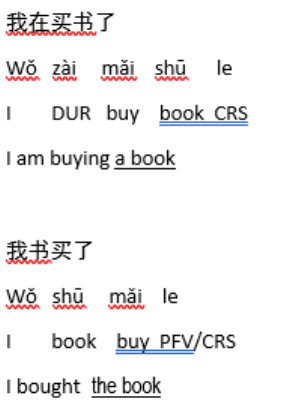
27
Larsen-Freeman, 2009) with a renewed focus on L1 transfer effects in general (Gilquin, 2008)
and an interest in crosslinguistic interference in article acquisition (Master, 1997; Lu, 2001;
Ekiert, 2004; Díez-Bedmar & Papp, 2008; Snape, Mayo & Gürel, 2013; Crosthwaite, 2012,
2016a).
2.3.1 Referential and non-referential noun phrases in Chinese
The high frequency of citations (Robertson, 2000; Díez-Bedmar & Papp, 2008; Crosthwaite,
2016a) to Li & Thompson’s (1981) ‘Chinese grammar reference’ show that it is widely
respected and useful for researchers investigating Chinese systems for showing definiteness
and indefiniteness. All examples in this section are also taken from Li &Thompson (ibid.)
unless otherwise stated.
As a [-Art] language, Chinese does not grammaticalise definiteness formally like a [+Art]
language such as English. However, writers can mark definiteness optionally if they wish
through word order, since definiteness ‘is partially signalled by preverbal position for topics,
subjects and objects.’ (p.20). The following examples (p.21) juxtapose how ‘book’ used before
the verb suggests definiteness, but after the verb commonly implies a notion of indefiniteness.
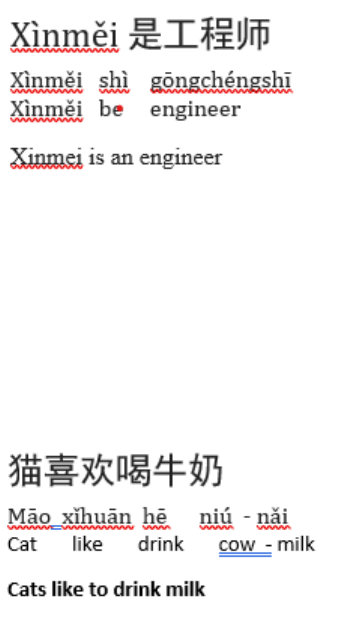
28
According to Li & Thompson, like English, nominal groups in Chinese have a head noun which
is always final, whether or not modified by other words in the noun phrase. As explained by Li
& Thompson, referential noun phrases in Chinese thus provide the writer with a degree of
choice. The writer can provide readers with a classifier, numeral or demonstrative for added
emphasis. Very often, alternatively, no such emphasis is added and readers are asked to infer
the definiteness or indefiniteness of an entity from context (ibid.). However, a key difference
in Chinese (that will be highlighted in Chapter 6) is that non-referential noun phrases, in
contrast, ‘never take classifier phrases’ (p.130). In the Type 4 indefinite sentence below
(p.127), ‘gōngchéngshī’ is non-referential in that it expressed a quality rather than a person.
Similarly, Li & Thompson (ibid.) demonstrate that generic noun phrases in topic position also
have no classifiers or demonstratives that could act to determine the noun in Chinese:
The challenge of understanding the grammatical constraints that determine how meaning is
mapped is also argued to be the main cause of error rather than the conceptual system itself
(Master, 1997; Robertson, 2000; Milton, 2001; Chuang & Nesi, 2006), but these challenges are
29
also influenced by L1 differences. More basically, plurality in Chinese is mapped by numerals,
classifiers and suffixes rather than final -s and there is no orthographic indication to
differentiate proper and common nouns in Chinese (Shi, 2016). Thus, the English article
system involves choices that Chinese learners must make without the contextual clues they
gain in their L1. As a consequence, Chuang & Nesi (2006: 266) attribute many article errors
they recorded to L1 transfer effects:
The Chinese language does not distinguish between count and noncount nouns, and does not
have a rigid, formal distinction between singular and plural (plural markers are not required);
this makes the concept of countability problematic for Chinese learners.
Faced with article choices, L1 English writers draw on their knowledge almost unconsciously
of how choices are constrained by the count/non-count/plural/mass noun distinctions of the
head noun (in each context). Thus [-Art] L1 learners face not only a new system of denoting
definiteness, but also need to understand how new lexis constrains their choice.
Based on the marked differences of English and Chinese in noun phrase determination Díez-
Bedmar & Papp (2008: 154) make a very generalised hypothesis of L1 transfer effects:
On the basis of the description of the lack of an article system in Chinese, we hypothesise that
Chinese speakers will underuse the definite and indefinite articles in English, overuse the zero
article, and even misuse them until they manage to learn to restrict the use of them to the specific
semantic contexts and pragmatic functions in which they are employed in English.
However, some commentators (Robertson, 2000; Xu, Shi & Snape, 2016; Crosthwaite, 2016a)
argue that Chinese is a system more ‘article-like’ (Crosthwaite, 2016a: 94) than article-less,
and the above hypothesis requires more nuance. In fact, definiteness can also be denoted by
demonstratives (e.g. zhèi ‘this’ and nèi ‘that’ ) while yi- ‘one’ is can also be optionally used
with referential nouns to signify indefiniteness. As explained by Li & Thompson (1981: 131-
30
132), Chinese learners of English will already be somewhat familiar with grammaticising
definiteness:
Finally, we should point out that Mandarin does not have words that correspond to the English
words the and a. The demonstrative nèi ‘that’, however, is beginning to function as ‘the’ if it
is not stressed and the numeral Yī ‘one’, if it is not stressed, is beginning to function as ‘a’.
This is logical because this is how languages such as English developed the definite article
(Bybee, Perkins & Pagliuca, 1998). The use of demonstratives leads Crosthwaite (2012, 2016a)
to argue that Chinese Mandarin students have an advantage (a positive transfer effect) over
Koreans and Japanese (other languages with grammaticised articles) when learning English.
Moreover, given that non-referential noun phrases can never be modified with classifiers,
Robertson (2000: 143) makes the point that Chinese learners are familiar with understanding a
referent as indefinite when used with a numeral but not a classifier while known to the writer
and specific (definite) through the use of such a classifier:
In Mandarin there is an interaction between referentiality and the use of nominal classifiers. Li
and Thompson (1981: 130) point out that nonreferential NPs never take classifier phrases. It
follows that a noun phrase with a classifier phrase must be referential. Furthermore, if the
classifier phrase includes a demonstrative (i.e. zhèi ‘this’ or nèi- ‘that’), then the NP must be
definite.
However, the extent to which Chinese can be depicted as ‘article-like’ is controversial. The
view that there are equivalents of some articles (mixtures of ‘one’ + classifier words) in
referential noun phrases in Chinese is shared by Chen (2004) only to the extent of indefinite
articles. While agreeing that demonstrative zhe and na are occasionally used in Chinese in
similar ways to definite articles, Chen is not convinced that occasional uses are evidence of the
grammaticalization of definiteness in Chinese. In fact, while not all uses are purely pure deictic

31
(referring to physical or linguistic co-presence), Chen (2004: 1156) highlights that their use to
demonstrate anaphoric or shared knowledge is rare in writing compared to speaking:
In sum, while demonstratives in Chinese have developed some functions which are typically
served by definite articles in languages like English, they are, generally speaking, still much
closer to demonstratives than definite articles on the path of grammaticalization.
It should also be finally noted that demonstratives in Chinese may have a slightly nuanced
notion of definiteness, which could also explain some L1 transfer effects. Xu, Shi & Snape,
(2016) claim that Chinese learners sometimes confuse specificity with definiteness and may
overuse the in a/an contexts as a result. Moreover, researchers such as Ionin (Ionin, Ko &
Wexler, 2004; Yang & Ionin, 2008; Ionin et al., 2011) have argued that article-less L1 learners
of English L2 often make this interlanguage ‘fluctuation hypothesis’ error of misusing articles
during their gradual L2 development, confusing [+/- definiteness] with [+/- specificity].
In sum, the contrastive analysis of Chinese and English shows that there are both similarities
and differences in the methods of expressing notions of indefiniteness and definiteness in the
two written languages. These differences appear most marked in the way the two languages
treat non-referential noun phrases since English displays greater choice (a/an, Ø) than the
Chinese bare nominal form (without a classifier) in Type 4 contexts and even greater choice
(a/an, Ø,the) in the way generic Type 1 noun phrases are determined. Beyond this consensus,
however, this literature review has shown some divergent views about the extent to which the
pseudo grammaticalisation (use of demonstratives and classifiers) in Chinese will create
opportunities for positive transfer effects. Various hypotheses are developed in Chapters 6 and
7 which address a central Research Question in this thesis:
To what extent does the Chinese students’ L1 background affect (1) Target-like use and (2)
their types of article error?
32
2.4 Empirical research into Chinese L1 learners’ written L2 English errors
2.4.1 Studies of [-Art] L1 background students’ use of articles
Much research has focussed on whether [-Article] L1 students have greater problems mastering
accurate use of articles than [+Article] L1students in English. A number of earlier studies
certainly claimed that such ‘article-less’ background students show less accuracy with
indefinite and definite articles (Yamada & Matsuura, 1982; Master, 1995; Master, 1997; Odlin,
1989; Jarvis, 2002). Investigating the universal language acquisition hypothesis, much effort
in SLA studies was also focussed on the effect this ‘[+/- article] parameter’ had on English L2
learners’ order of acquisition. According to some (Huebner, 1983; Master, 1997; Thomas,
1989) article-less L1 learners were observed to go through stages of ‘flooding’ language with
definite articles at beginner-intermediate stages of development.
Other studies by Liu & Gleason (2002) and Young (1996) however conclude the opposite:
early and accurate control of the indefinite article is observed before definite article accuracy.
In addition, in their study of the ‘natural order’ of article acquisition (excluding generic uses),
Liu & Gleason (2002) found that learners had the greatest problems inserting the obligatory
use of the in texts where the definite article had been omitted in contexts of conventional, or
what they termed ‘cultural’ use of the definite article. As Figure 3 shows below (comparing
average errors made on the vertical axis with levels and types of article error), this not only
seemed to be the most marked problem for learners but also the most persistent, less affected
by level of proficiency.
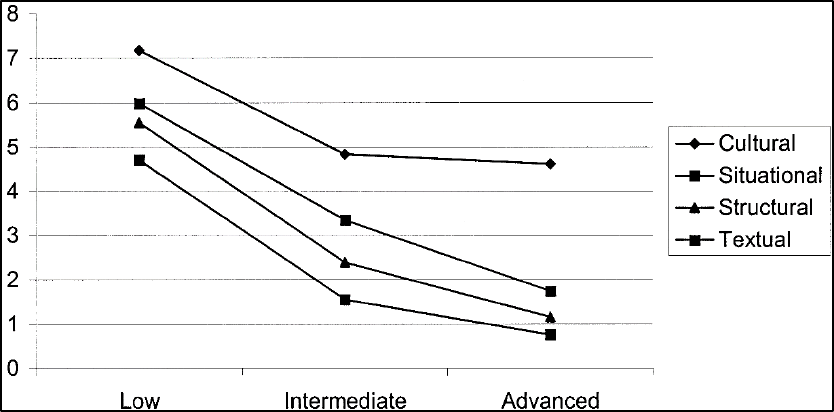
33
Figure 3: Comparison of means of missed the by category (Liu and Gleason, 2002: 13)
For Liu & Gleason this is less surprising given what learners perceive as arbitrary uses of
articles (2002: 7):
…such use of the is often not framed by situation but is determined, to a large extent, by
conventional practice. For example, we use the with some but not all disease names. Similarly,
we place the before some geographical names (such as rivers) but not others (such as most
lakes). We also use the with the musical instruments we play but not with the sports we play,
for we can say play the piano but not play the basketball.
One clear limitation of all the studies above was their approach of grouping Chinese students
with Japanese/Korean/Russian students to form ‘article-less’ background L1 groups.
Moreover, few earlier studies properly accounted for level and most have little relevancy for
the study of university student writing. Certainly, the findings of any studies that conflated the
analysis of Chinese learners’ article use with other L1 background students or observed just
one student such as Heubner (1983) need to be treated with a great deal of caution. In fact,
there are few valid justifications for studying the errors of such groups of students mixed
together since, as shown in the contrastive analysis in Section 2.3, some claim that Chinese to
some extent grammaticalises definiteness relative to other article-less languages (Robertson,
34
2000; Xu, Shi & Snape, 2016; Crosthwaite, 2016a). This chapter now turns its attention to
more robust recent studies that used corpus-based approaches and differentiated Chinese L1
groups from others to make more convincing claims about Chinese university students’ English
L2 article use.
2.4.2 Corpus based evidence from university EAP contexts
Using a corpus-based approach, Milton ( 2001) found that Chinese L1 students at a Hong Kong
university made frequent article errors and argued that these often resulted from their problems
distinguishing between countable and uncountable nouns. Making the point that article errors
were difficult to differentiate from final -s noun errors, Milton chose not to differentiate
between errors in singular/plural distinctions and article error.
In Chuang & Nesi’s (2006) study of undergraduate level Chinese students academic writing,
grammatical errors (85.9%) were far more common than lexico-grammatical (5%) or lexical
errors (9.1%). Of these, article errors (27.6%) were by far the most frequent category of
grammatical errors identified. This large corpus study was one of the first to present
meaningful findings based on authentic student work (50 pieces of authentic academic writing
of 1,500-2,000 words by Foundation level students at a B1/B2 level). Chuang & Nesi’s (2006)
finding that omission of definite articles is the most frequent error, closely followed by
overspecification of definite articles is therefore of significance to this research into
Presessional students’ article use (though Chuang and Nesi’s students were slightly younger).
According to Chuang and Nesi, the omission of a/an was the third most frequent error and
misselection or ‘a for the’ and vice versa was a rare error.
Another important corpus-based study is Lee & Chen’s (2009) keyword analysis of
undergraduate Chinese L1 English major students’ dissertations and some shorter texts from
the BAWE corpus. This study reported that the definite article was ‘overused’ compared to the

35
authors’ corpus of L1 academic writing. Indeed, Lee & Chen suggest that it is closed
class/function words and common words that students overuse rather than the academic words
typically focussed upon in EAP classes. Their finding that Chinese students oversupply the
definite article appears to support the claim that Chinese learners go through a ‘flooding’ stage
of definite article use in their acquisition process (Heubner, 1983; Thomas, 1989; Master, 1997;
Lu, 2001), even at university level.
Lee and Chen (2009) illustrate the frequent overspecification of definite article use with the
example from a Chinese L1 English major’s undergraduate dissertation submission, shown in
Figure 4. This demonstrates what they claim is ‘a tendency to use the even when talking about
general rather than definite subjects’ (ibid, 2009: 287).
Figure 4: Example of definite article ‘overuse’ from Lee & Chen (2009: 287)
The example above serves to illustrate what some researchers have identified and claimed to
be a rather ‘spoken like’ characteristic in Chinese university students’ academic writing (Cobb,
2003; Hinkel, 2003; Granger, 2004; Mayor, 2006; Gilquin & Paquot, 2007). While out of
context it is not easy to decide if all the alleged overspecifications are errors, the uses of definite
article in ‘the confidence’, ‘the language ability’ and ‘the text-based questions’ do show (in the
researcher’s opinion) an excessively conversational tone for the genre in question (an Applied
Linguistics dissertation), particularly as the student was seeking to make a generalised claim
about a topic (as evidenced from their use of Ø + students in the topic sentence). If Lee and
Chen’s example is representative of the overall dissertation style, there seems to be a plausible
36
argument that such overspecification would create at best an informal tone and at worst a
misunderstanding in meaning. In turn, this again shows that article errors can sometimes go
beyond mere surface level error and can affect the perceived register (and appropriacy within
a genre).
One frequent criticism of such generalisations (i.e. that Chinese students write too informally
when producing academic texts) is that the data analysed often comes from semi-formal IELTS
type prompts and Leedham (2015) makes a convincing case that many of the cited studies
alleging a conversational tone failed to sample the students’ true abilities in academic writing
because they examine short IELTS type essays which themselves promote an informal tone.
Lee & Chen’s use of authentic (assessed) 5,000 word dissertations, however, makes their claim
of a register effect of article oversupply in academic writing more convincing.
Another critique of such broad generalisations of ‘oral tone’ or ‘informal language’ is the huge
variability across disciplines and even university departments about what constitutes
acceptable academic style (Hyland & Milton, 1997; Hyland, 2004; Swales, 2004). Admittedly,
EAP tutors and even researchers can struggle to make judgements about register appropriacy
for different genres and, as Gardner & Holmes (2009) point out, most come from a humanities
background which has conventions that differ from those of than the students they are teaching
which can somewhat invalidate such judgements. It is indeed essential that any researcher
makes judgements specific to a given genre and discipline. As will be highlighted in Chapter
6, a redundant definite article might be marked but acceptable in one genre (a case study) but
wholly inappropriate in a journal article introduction or conclusion (when the writer is creating
a frame of reference to the general rather than the specific actors in the discourse community).
37
On proviso that judgements are kept discipline specific and focussed on a specific genre that
the researcher understands, this thesis makes the assumption that nuanced judgements of article
use and misuse can be made and, moreover, that such a research focus is essential in the EAP
community if it is to help novice academic writers develop register awareness in an L2. The
role of EAP tutors in helping students conceptualise their audience (Ede & Lunsford, 1984) is
long acknowledged and more effective EAP tutors are often argued to be those who teach
through genre (Flowerdew & Peacock, 2001; Hyland, 2007b). The ideal EAP programme
would therefore appear to be one that trains students so that they leave their course ready to
investigate the genre requirements in their own disciplines for themselves (Paltridge, 2001).
Focussing on small words such as articles can occasionally be essential to teach genre and
register awareness to students. In contrast, to focus only on stance and purpose and ignore how
small morphemes in language frame the writer/reader relationship arguably defeats the central
purpose of EAP in training students in the interplay between language, register and genre
variation. By showing students that different genres within their discipline may prefer or
discourage the informal tone created by definite article use (as opposed to a bare Ø plural),
students can be shown what Leedham calls ‘the preferred ways of making meaning’ (2015: 7)
in the genre. The issue of how students conceptualise their reader is clearly the underlying
variable (Ede & Lunsford, 1984) but students might usefully be focussed upon how article use
invokes their audience distance in writing composition. In short, Lee & Chen’s (2009)
argument that EAP needs to be ‘making a bigger deal of the smaller words’ (their paper title)
appears persuasive.
One more justifiable criticism of the approach of the three corpus studies discussed above could
be of their ‘deficit approach’ (Leedham, 2015) in problematising Chinese students’ errors. It
is difficult to argue against this accusation, and it must be acknowledged that all such error
38
studies make the assumption that L1 norms are a valid target. In fact, by focussing on article
error frequency, such studies risk ignoring the accurate use of articles. However, two corpus
studies summarised in the following section (Díez-Bedmar & Papp, 2008; Crosthwaite, 2016a)
have overcome this emphasis by using ratio measures that allow a more holistic picture of
students’ accurate use in addition to their errors.
Using Granger’s (1996) Integrated Contrastive model and the Bickerton Framework (see
Section 2.2.1), Díez-Bedmar & Papp (2008) compared the errors made by Chinese L1
international students at Portsmouth University with the writing of L1 English writers and
Spanish L1 students of L2 English. Their use of the framework in addition to Pica’s (1983)
Target-Like Use (TLU) ratio has been replicated by other studies including those of Chapter 5
and 6 in this thesis. Using Pica’s index (which measures correct use as a ratio of incorrect use),
Díez-Bedmar & Papp found that their Chinese L1 students used Ø article most correctly
(75.9%), followed by a/an (73.2%) and lastly the definite article which was used least
correctly (67.4%). This low Chinese learner accuracy contrasted with the Spanish learners who
were least accurate with zero articles and more accurate with a/an articles than the articles.
Chinese learners were also reported as having particular problems with generic articles and
Type 3 (see Section 2.2.1) context articles.
It is very difficult to compare the findings reported in raw frequency terms (Chuang & Nesi,
2006; Lee & Chen, 2009) with those that use ratios such as ‘Target-Like Use’ (Díez-Bedmar
& Papp, 2008; Crosthwaite, 2016a) because the former analyses are reporting the under/over
specification of articles in terms of frequency (the most frequent errors), while the latter are
taking the accuracy rate in terms of how often the student made the right choice in obligatory
contexts. In other words, the former is answering the question ‘what are the most frequent
article errors made in writing?’ while the latter is asking ‘given an equal number of obligatory
39
contexts, which article’s use would challenge the learner most?’. As Ø is the most frequent
free morpheme in written academic English with many more obligatory uses in most genres
than a/an, Díez-Bedmar & Papp’s (2008) conclusion that Chinese students’ ‘Target-Like Use’
of a/an is lower than that of Ø cannot be interpreted as showing Ø to be less of ‘a problem’
in frequency of error terms, but does helpfully acknowledge the high accuracy of Chinese
students’ use of Ø when its frequency of use is factored into the discussion.
Crosthwaite (2016a) investigated differences between the accuracy in article use of different
article-less L1 background students (Chinese, Korean and Thai) and the divergences of
accuracy order among four different language competency levels (beginner/low-
intermediate/intermediate/upper-intermediate). Compared to Díez-Bedmar & Papp’s 2008
study, Crosthwaite’s findings suggest a higher accuracy Target-Like Use among Chinese
learners. Indeed, at Upper-Intermediate levels equivalent to a Presessional EAP programme’s
entry levels, he reports that such levels of learner do not struggle significantly with any of the
articles (the, a/an, Ø), apart from occasional challenges with generic use contexts. In fact, in
the two short essay prompts set in the ICNALE corpus that Crosthwaite used, students at
Upper-Intermediate level showed almost perfect Target-Like Use (TLU) ratios (statistically)
in most article contexts and a fairly equal order of accuracy in all articles apart from generic
contexts.
However, at intermediate levels (slightly below Presessional entry levels), Crosthwaite (2016a)
does report that the TLU of definite articles was significantly lower than that of indefinite
articles. Moreover, he acknowledges that Chinese learners struggle with generic contexts,
oversupplying definite and indefinite articles when they do attempt to use them (but the median
measures he uses removes such outliers from his headline results). In another study of the errors
made longitudinally over three data-points in essays and reports by Chinese L1 university

40
students (while students received error correction) Crosthwaite (2016b) found that the most
frequent article error in both essay genres and reports was definite article omission. In
addition, but to a lesser extent, students oversupplied definite articles in generic and non-
referential contexts. As a ratio of response length, Crosthwaite also reports that article accuracy
was higher in the reports than the essays.
2.4.3 The contrasting hierarchy of difficulty reported in the research
To summarise, in the four most important corpus-based studies summarised in this chapter, as
shown in Table 2, there are divergences in the reported findings pertaining to the order of
difficulty. Discussing this order in terms of the contexts that students find most difficult to
master, it can be seen that the two studies showing definite article omission to be the most
serious error for Chinese learners (Chuang & Nesi, 2006; Díez-Bedmar & Papp, 2008) conflict
with the other two studies. This area of disagreement motivates the next Research Question
developed at the end of this chapter:
What are the linguistic contexts of obligatory article use in which international students are
most likely to make errors?

41
Table 2: A comparison of important corpus findings
Study
Student level
Discipline
Hierarchy of difficulty
(lower accuracy first)
(Chuang & Nesi, 2006)
Foundation
B1-B2 level
Business studies
Foundation students
The> Ø> >a/an
(Lee & Chen, 2009)
Undergraduate
Unspecified English level
Linguistics/Applied
linguistics
Ø>the (no mention of
a/an)
(Díez-Bedmar & Papp,
2008)
University students in 2
nd
year or later UG/PG level,
IELTS 4.5 – 7.0
Various
The >a/an> Ø
(Crosthwaite, 2016a)
4 levels: (A2-B2/C1)
Various
The =a/an= Ø at Upper-
Intermediate levels.
2.5 Other factors influencing English Accuracy
To make conclusions about how article accuracy could be promoted by EAP pedagogy and to
differentiate L1 transfer effects, it is clearly necessary to consider a number of various
developmental factors. L1 transfer effects are just one of many possible factors affecting
learners’ academic writing accuracy. Firstly, there is general consensus in the EAP community
(Master, 2002; Hinkel, 2003; Alexander, Argent & Spencer, 2008) and SLA field (Larsen-
Freeman and Long, 1991) that L2 learners of English make errors as novice academic writers
42
as a process in their natural acquisition and that, regardless of L1 background or instruction,
students’ surface writing accuracy improves with sufficient comprehensible input in the
discipline discourse of their new academic community. Empirical studies into Chinese
learners’ article accuracy all therefore acknowledge general proficiency as a factor that must
be controlled in any measure of L1 transfer effects (Lu, 2001; Díez-Bedmar & Papp, 2008;
Díez-Bedmar, 2015; Crosthwaite, 2016a) or teaching/error-correction (Master, 1995, 1997;
Crosthwaite, 2016b). There is more generally a natural order of acquisition of L2 grammar
forms (Larsen-Freeman and Long, 1991; Ellis & Larsen-Freeman, 2009). Research into L2
acquisition of English articles by different L1 groups has shown that this order of acquisition
of English articles is slightly divergent across different L1 backgrounds of English L2 learners
(Luk & Shirai, 2009; Murakami & Alexopoulou, 2016), but these studies have shown that
article accuracy improves at higher proficiency levels. Moreover, it has been shown that not
all contexts and forms of article use are affected by proficiency equally and the effect of
proficiency level on different contexts of article has been the focus of some studies (Liu and
Gleason, 2002; Crosthwaite, 2016a).
Different parts of the EAP community agree and disagree about the extent to which academic
writing accuracy in general is affected by instruction. The section below discusses how article
use accuracy may or may not be accelerated by:1) Reading into writing methodologies, 2) a
focus on lexis and phraseology, 3) error correction and/or explicit teaching of the article
system, and 4) current approaches to teaching EAP.
2.5.1 The ‘reading into writing’ paradigm
A strong argument can be made that students increase their accuracy of article use in their own
discipline’s genres by reading extensively in their field. In broader linguistic terms, the main
evidence for this consensus view come from SLA studies (Dulay, Burt & Krashen, 1982;
43
Richards & Rodgers, 1986; Nunan, 1991; Savignon, 1991; Larsen-Freeman & Long, 1991)
which showed that acquisition is most closely accelerated or hindered by the requisite student
access to comprehensible input. EAP theorists meanwhile argue that academic texts (through
a genre approach) give students models for academic writing (Hyland, 2007a; Hirvela, 2016).
From passive input it is argued that students learn about genre interplay with language to frame
their own output (Carrell & Carson, 1997; Hirvela, 2016). Therefore, by passively seeing
how new terms colligate with articles in their discipline’s lexis, students could be expected to
gain confidence in accurately determining these concepts in noun phrases within their writing.
While the focus in EAP is normally upon meaning from input to output (Nation, 2007), students
in parallel also acquire patterns of how new vocabulary is paired together with other lexical
words (collocations) and frequently partnered with grammatical words (colligations). Through
reading, students therefore acquire many idiomatic uses of articles in fixed colligations within
phrases (lexical bundles). Although the acquisition of many article uses within lexical bundles
can to some extent be framed as vocabulary development, research has shown that knowledge
of vocabulary and appropriate control of fixed terms within formulaic phraseology are
accelerated through reading rather than list learning (Li & Schmitt, 2009; Hyland, 2008). By
reading discipline specific texts students see the vocabulary in their field and the pragmatic
ways of appropriately referring to concepts in different genres. Returning to Lee & Chen’s
(2009) example of student writing in Figure 4, this student might read further Applied
Linguistics texts that show how key concepts and actors (students, vocabulary etc., ) have
divergent references in specific and generalised examples. Extensive reading might illustrate
to students how articles are used or not used in the generic references of the key concepts in
their discipline. This key importance of new vocabulary further demonstrates Nation’s (2007:
5) argument that ‘Knowing a word involves many different aspects of knowledge’.
44
2.5.2 Knowledge of lexis and phraseology
The different aspects of knowledge of a word to which Nation alludes include its
singular/plural/mass noun characteristics and its colligations and collocations. As accurate
article use requires such knowledge, the students’ knowledge of vocabulary is inextricably
linked to their accuracy of articles in a given topic. In recalling Sinclair’s (1991) finding that
lexical choices are sometimes ‘closed’ as well as ‘open’, EAP tutors also have a role in
focussing students on the use of articles in fixed phraseology. A review of 35 most frequently
used ‘lexical bundles’ (e.g. ‘on the basis of’; ‘at the time of’) across academic disciplines
reported by Byrd & Coxhead (2010) shows that only 8 phrases do not contain an article. Byrd
& Coxhead (2010) argue for the importance of drawing learners’ attention to such
‘prefabricated and often repeated language’ (p.50). Li & Schmitt (2009) examined one EAP
student’s acquisition of phraseology over 12 months and found that after first contact with new
terms the learner went through stages of using the new vocabulary inappropriately before
mastery. In light of this aspect of the EAP approach, the main input to such acquisition of
articles is therefore reading, but instruction may also play a part in correcting inappropriate
use.
2.5.3 Error correction
Aside from form-focussed corrections, there is some support for feedback and corrections in
the genre approach to EAP when focussed on content or the way lexico-grammatical features
affect genre. In fact, within a genre approach, some argue it is an essential tool for correcting
inappropriacy and scaffolding learning:
In genre classrooms feedback is a key element of the scaffolding provided by the teacher to
build learner confidence and the literacy resources to participate in target communities.
(Hyland & Hyland, 2006; 83)
45
As outlined in the introduction, error correction of all surface errors in students’ writing without
focussed purpose is generally argued to conflict with the ‘EAP paradigm’ (Alexander, Argent,
& Spencer, 2008). Yet, what teachers have read or learned in their training does not always
determine their classroom practices. In fact, research by Etheringon & Burgess (2002) into the
practices of 48 UK based EAP tutors in centres affiliated with the British Association of
Lecturers of English for Academic Purposes (BALEAP) showed that over half the EAP tutors
regularly corrected grammar errors even when they did not affect meaning. Moreover, over
half the teachers believed grammatical accuracy in writing was improved by form-focussed
corrections.
Empirical studies often claim to show significant effects on writing accuracy in general from
error correction (Polio, Fleck & Leder, 1998; Chandler, 2003; Ferris & Kurzer, 2019). There
is a broad consensus that correction has risks and can often be ineffective (see Truscott, 2004
for example), but some voices in the literature claim that such risks can be overcome under the
right conditions with sufficient teacher training (Ellis, 1994; Ferris, 1999; Bitchener, Young &
Cameron, 2005; Russell, 2009; Gass & Selinker, 2010; Rahimpour, Salimi & Farrokhi, 2012).
Even more consistently, studies show students value corrective feedback (Lee, 2005; Ferris,
2006; Hyland & Hyland, 2006) and prefer a teacher’s error focussed corrections to peer
corrections (Zhang, 1995). As a rule-based area of language accuracy, it has been argued that
article use is more amenable to error correction than other surface errors (Ferris, 2006; Dale,
Anisimoff & Narroway, 2012). However, the empirical claim that error correction improves
writing accuracy over the long term continues to be disputed in general (Truscott, 1996, 2004)
and in the more particular case of article use accuracy (Crosthwaite, 2016b). An evaluation of
this evidence in particular reference to article use will be presented in Section 2.7.
46
2.5.4 Explicit teaching of the article system
Although there has long been a broad consensus that EAP teaching should be content-driven
(using authentic texts wherever possible to provide the comprehensible input for acquisition),
there is less agreement about the extent to which language instruction about grammar should
be overt and form-focussed (Brinton & Holten, 2001). On the one hand, tutors report they do
not believe decontextualised grammar teaching is appropriate in EAP when surveyed
(Etheringon & Burgess, 2002). On the other hand, as Chapter 4 shall highlight, what teachers
say they do and what they actually do in the classroom has been shown to be divergent (Phipps
and Borg, 2009). In addition, when they are asked students appear to want more grammar
teaching than their tutors feel it is necessary to provide (Schultz, 2001; Ferris, 2006). This
may be in part due to the background of Chinese students and the way they have been
continually tested in decontextualised grammar terms in the Chinese education system
(Leedham, 2015). Ironically, Lu (2001: 43) points out that Chinese students spend a lot of time
doing tests and grammar exercises at lower levels, when they have little possible hope of
applying the rules, but less time on such errors when they are more ready to acquire them.
2.5.5 How articles can be taught in EAP
Based on the assumption that a focus on form in terms of selective text based noticing or
consciousness-raising activities can be appropriate as long as any focus on form is not
decontextualised from the text and overall discourse ( Hyland & Milton, 1997; Hinkel, 2003;
Hyland & Hyland, 2006; Alexander, Argent & Spencer, 2008; Hyland, 2008), this section
develops the thesis that a focus on articles can be integrated within the pedagogical methods
often recommended in EAP literature such data-driven learning and a genre-based approach.
Peter Master (1990; 1995; 1997; 2002) has long been the fiercest advocate of focussing
students on the effects of articles in texts and his later approach calls for a combined focus on
47
juxtaposed uses of articles with error correction (student self-correction and teacher
corrections). Another advocate was Johns (1991), who argued that such complex issues of
grammar could be covered within ‘data-driven learning’ in which the teacher tells the students
“I’m not sure: let’s find out together” (p.2) in contrast to the ‘spoonfed’ approach of grammar
books the data-driven approach involves asking students to deduce colligation and collocation
patterns by themselves through concordance lines (i.e. examples searched from a corpus of
academic texts). For Johns (ibid.) framing students as researchers rather than learners makes
the approach particularly suitable in the university context. Furthermore, for Johns: (ibid.; 3)
only data-driven approaches allow teachers to address the most complex grammatical problems
in student work:
There are large areas of English syntax which have traditionally been neglected in the standard
descriptive and pedagogic grammars not because they are unimportant but because they are too
difficult (e.g. Article Usage) or because they have simply been overlooked (e.g. Transitivity).
Hinkel (2013:7) argues that higher level learners need tutors to focus on ‘effects of grammatical
features on context, discourse and text’. There are certainly many calls for more form focussed
instruction with regards to nominalisation in EAP (Halliday & Martin, 1993; Fang,
Schleppegrell & Cox, 2006; Biber & Gray, 2010; Bennett, 2011; Parkinson & Musgrave,
2014) and this is inextricably linked to article use. Helping students to ‘pack meaning into
the noun phrase, and to make their text nominally rather than clausally complex’ (Parkinson &
Musgrave, 2014; 48) also requires a parallel focus on article use (or non-use).
In Chapters 6 and 7 this thesis advances the claim that the ‘compressed’ nature of academic
noun phrases in academic writing obscure the grammatical characteristics (-/+ number, -/+
countability) of the nominal group, just as they have been argued to obscure complex implicit
meaning relations (Halliday & Martin, 1993; Biber & Gray, 2010) in academic writing. The
48
hypothesis will be examined that any challenges that article-less L1 background international
students face in learning the grammatical properties of new lexis are heightened when they
are asked to use them in noun groups with pre-modifiers that increase the cognitive load of
applying new grammatical mappings onto language. Thus, among the many causes for the
omission of articles in Chinese students’ writing, one factor that may amplify their potential
for error is this compression of the linguistic context of article use.
Indeed, according to Biber et al (1999), 60% of nouns in academic writing are pre-modified
compared to only 15% in conversational English. Biber & Gray (2010: 19) note that
compressed noun phrases help experts write and read academic discourse, but challenge
students new to the genre:
In contrast to the academic professional, the compact, inexplicit discourse styles of research
articles are difficult for novice students. This is because students lack the specialist knowledge
that would allow them to readily infer the expected meaning of compact, inexplicit
constructions.
Lamenting that learning materials typically ignore the issue of nominalisation, Biber & Gray
(2010: 19) also criticise materials and pedagogical grammar books for presenting over
complicated elaborations less relevant to EAP in their place:
Traditional grammar practice for advanced academic purposes tends to focus on elaborated
structures, often dependent clauses like relative clauses, adverbial clauses, and complement
clauses. Phrasal modification especially noun phrase structures with multiple levels of phrasal
embedding is usually given much less attention.
Unfortunately, when they do pay attention to noun phrases, teaching materials and grammar
reference materials tend to present articles in prototypical sanitised contexts, not in the messy
academic contexts in which head nouns are obscured by pre-modification. For example, it has
been observed that grammar textbooks pay particular attention to simplified anaphoric forms
49
of indefinite and definite article and little attention to Ø or the generic definite article (Yoo,
2009). Rather than the simpler aspects of the article system ‘rule’ there is arguably a greater
need for the teaching of the article system in relation to such dense academic nominalisation.
The corpus-based analyses of the spoken and written grammar of academic English conducted
first by Quirk & Crystal (1985) and in the 1990s by Biber and colleagues (Biber, et al, 1999;
Biber, Leech, & Conrad, 2002) are frequently used to juxtapose students’ L2 English use with
the norms of use these frequency counts can be claimed to represent. Comparing the writing of
expert academic writers and students in ‘Freshman writing composition classes’ in the UK,
Bennett (2011) highlights the greater frequency of pre-modified noun phrases in academic
writing which novice writers need help in noticing and developing within their own writing. It
has also been shown that L2 English EAP students, challenged by compressing nominal groups
in the first instance, go through a stage of pre-modifying noun phrases with attributive
adjectives rather than classifying nouns (Parkinson & Musgrave, 2014). In later stages of
development, the students must learn to use other noun classifiers, participle phrases,
possessive nouns and appositive noun phrases to qualify the head noun (ibid). The relevance
for EAP tutors, for Parkinson & Musgrave, is that this feature of academic writing needs more
focus on EAP courses and they propose ‘a focus on nouns as premodifiers and prepositional
phrases as postmodifiers’ (p.49).
2.6 English articles within the current EAP pedagogical paradigms
As discussed in the introduction to this thesis, the extent to which a focus on form is compatible
with EAP has often been challenged with simplistic rejections of decontextualised grammar
teaching and assumptions of a ‘core knowledge’ of grammar or lexis that is useful across
disciplines. In fact, new teacher entrants to EAP might be forgiven for thinking that a focus on
grammatical accuracy had been consigned to history by more recent approaches to pedagogy.
50
However, this thesis argues that current pedagogies allow for a more meaningful focus on
language forms such as article use. A focus on how the writer uses articles to move the readers’
focus from specific examples to general statements or when and how knowledge is assumed
would seem have obvious synergies with the genre approach to EAP in which emphasis is put
on contrasting different writing purposes and appropriate writing styles (Swales, 1990; Hyland,
2002a; Swales, 2004; Swales & Feak, 2004; Hyland, 2007b).
The genre approach focusses students on different text types (essays, research reports, case
studies, lab reports ect.,) that they may meet in their academic community (Paltridge, 2001).
Hyland (2007b) argues that the genre approach allows students to see models of how language
choices are made in authentic text types. It would seem logical to argue that the way in which
article use varies across genres and how usage itself shapes the register and framing of the
audience-writer relationship build a strong case for a focus on articles. As shall be shown in
Chapter 6, uses of articles may be different from one genre (a case study report) to the next (an
essay) as the conventions of providing evidence and the purpose and assumed audience of the
writing changes. Rich language content in such authentic texts provides many opportunities
for a focus on grammar and form (Master, 1997; Brinton & Holten, 2001), as students can be
focussed on article use within texts and between genres.
As exemplified by the example of definite article overuse by a student in Chen & Lee (2009),
article use can affect the academic style of writing. The same authors argue for the importance
of focussing students on lexico-grammatical features and their effects upon register. However,
such ‘register’ awareness sessions can have little meaning out of context since the appropriacy
of a determiner will be greatly affected by framing of the reader-writer relationship and the
degree to which specific examples are being referenced in the genre. In fact EAP learners
need to be encouraged to start writing compositions by considering their audience (Flowerdew,
51
1993; Dudley-Evans & St John, 1998; Swales, 2004; Swales & Feak, 2004) and EAP tutors
also have a role in developing students’ consciousness of how they invoke the audience (Ede
& Lunsford, 1984). Teaching students about articles within a genre approach is naturally
somewhat contingent on how specific the focus of the EAP instruction is, and this review of
the literature would be incomplete without discussing the issue of whether students are in
specific disciplines or more general academic English courses.
The controversy in EAP that has occasional bearing on the issue of teaching article use in EAP
is the issue of whether students are taught in English for Specific Purpose (ESP) groups by
discipline or can learn the academic English they require effectively in more general mixed
disciplinary English for General Academic English Purposes (EGAP) classes. Some argue very
strongly for the former (Dudley-Evans & St John, 1998; Hyland, 2002b, 2012) while others
argue that EGAP can be effective (e.g. Hutchinson and Waters 1987; Spack 1988; Alexander,
Argent & Spencer, 2008). Those arguing for discipline based teaching often claim that the
writing requirements are extremely divergent across different disciplines (Swales, 1990;
Hyland, 2002b, 2012) and only through grouping students by discipline can a proper focus be
given to the lexis and genre of each student’s specific field (Dudley-Evans & St John, 1998).
Those supporting EGAP argue that there is a core body of academic English vocabulary, skills
and grammar needed by all students and that practical impediments make such ESP classes
unrealistic in real world contexts.
While attention to article use in EGAP contexts is possible, it is likely to be especially effective
in ESP contexts due to the importance of lexis and colligational knowledge for article accuracy.
The assumption made by EGAP advocates that students acquire specialised vocabulary fairly
quickly in their later studies is sound, but each discipline has not only a specialised lexis but
its own preferred ways of making generic references in writing, by using definite generic,
52
plural count nouns or mass noun references (Master, 1990). Drawing attention to such
differences can arguably help students understand the genres in their fields. Thus, when the
opportunities for learning lexical bundles that colligate with articles are also considered,
discipline specificity is indeed helpful for a focus on English article use. While English for
General Academic Purposes can focus on the colligations with the Academic Wordlist, there
are clearly more opportunities in ESP and in the words of Coxhead (2016: 186):
When it comes to specialisation through academic studies, it is important to find out at what
point it is better for learners with special purposes to start focussing on learning the specialised
vocabulary of their chosen field.
On the other hand, most summer presessional programmes in the UK are built around EGAP
principles. A focus on article use and its effect on genre is not impossible within a ‘core skills’
approach in which an EAP tutor is addressing a mixed discipline class of English for general
purposes. While less than ideal, tutors teaching on EGAP presessional programmes can
nevertheless give students the autonomous learning skills to consider genre and its effect on
article choice. EAP tutors can thus be thought of as facilitators who train students to find about
the genre requirements in their own disciplines for themselves (Flowerdew & Peacock, 2001;
Paltridge, 2001).
2.7 Empirical research into the effect of teaching and correcting articles
Having further developed the thesis that a focus on English article accuracy is compatible in
principle with modern approaches to EAP pedagogy, this section will further evaluate some of
the empirical claims in specific reference to 1) article teaching and 2) correction in pedagogical
practice.
53
2.7.1 The distinction between teaching and error correction
In this thesis, error correction denotes the term which the SLA field describes as ‘negative
feedback’, the fourth option within VanPatten’s (1993) focus-on-form model of 1) structured
input; 2) explicit instruction; 3) production practice and 4) negative feedback stages. It has
been pointed out (Ellis, 1998) that teacher practitioners sometimes conflate all these stages as
‘teaching’, for example corrective practices with explicit instruction, while researchers attempt
to separate processes into analysable components. In fact, it must be conceded that some error
correction is often combined when tutors check concepts and interact with students
spontaneously. However, this thesis generally distinguishes teaching (structured input and
explicit instruction stages) from the written error correction provided after students have
produced and submitted written work.
2.7.2 Empirical research into explicit instruction
Peter Master reported that the teaching of articles produced significant improvements in
students’ article accuracy (1986, 1990). For Master, the key was simplifying the many complex
usages and rules of articles into a simpler ‘binary system’ in which students were asked to
construe noun phrases as either classifying or identifying a referent. However, Master’s
research methods lacked control groups or post-study measures and many of his manuscripts
making the strongest claims were not peer reviewed.
2.7.3 Empirical research into error correction
Far more research has been published into the efficacy of error correction than explicit
teaching. A number of studies have claimed a significant effect upon article accuracy from
instructing ‘article-less’ students about article use through ‘consciousness raising activities’
involving error correction (Master, 1995; Master, 1997). However, notwithstanding the
mixture of Chinese L1 with other groups, these studies all failed to use control groups or
54
properly account for other variables that contribute to accuracy/error. A lack of control groups
in much of the literature is in fact a critique made by the main proponents of error corrections
(Ferris, 2006; Ferris & Kurzer, 2019). Nevertheless, a number of studies evaluating error
correction with control groups have shown significant improvements in article use (Chandler,
2003; Bitchener & Knoch, 2008). The latter two researchers found significant improvement in
the progress of lower level learners’ use of the definite article for anaphoric reference with
highly focussed oral and written corrective feedback on this error.
A major criticism of grammatical error correction research is that the extremely focussed and
considered correction of errors in the research environment has little relation to the real world
process of error corrections (Truscott, 2004). Truscott (1996) has long argued that grammar
error correction is ineffective, incongruent with theories of L2 learning, overly time-
consuming and even ‘has significant harmful effects’ (Truscott, 1996: 328). Truscott (2004)
indeed continues to critique other flaws in the methodology of Chandler’s (2003) and Ferris’
(2006) studies, most notably the difficulty in attributing causality to observed decreases in
errors. It is indeed extremely difficult to show clear evidence of causality, as highlighted in a
study by Crosthwaite (2016b) who found a significant improvement in the accuracy of articles
among students doing an EAP course, yet concluded that task prompt effects, which may have
affected accuracy rates, made the results inconclusive.
Given the evidence that feedback on grammatical form errors can be discouraging (Truscott,
1996; Polio, Fleck & Leder, 1998), in addition to the inconclusive evidence regarding the
effectiveness of correction (Krashen, 1992, Truscott, 2004), there is a compelling argument
that indiscriminate article error correction may be a less deserving of tutor and students
valuable time. There are clearly circumstances in which a tutor is obliged to correct occasional
errors as part of the teaching process (Hyland & Hyland, 2006). However, while there is a case

55
for focussed article correction and there will be contexts in which a tutor is compelled to
correct articles errors, such as in preparation for high stakes assignments or paper submissions
in which error correction is justifiably ‘product focussed’, this thesis makes the assumption that
overcorrection of article errors is ineffective. Thus, when dealing with more regular writing
tasks in EAP there is insufficient evidence to support the hypothesis that mass article error
correction improves accuracy, so teachers may wish to spend their limited time and resources
on more proven areas of pedagogy (Truscott, 1996, 2004; Crosthwaite, 2016b; Crosthwaite
2017). On the other hand, there is a clear need for more highly focussed and effective conscious
raising of English article functions (which may include error correction as a modelling for peer
and self-correction), particularly if it such focus can be integrated within a contemporary text-
based/data-driven student centred approach.
2.8 Research Questions
This chapter’s review of the literature has highlighted the imperative of addressing four
important Research Questions, as now summarised.
2.8.1 Research Question 1
To what extent do EAP teachers in Higher Education programmes in the UK explicitly
teach or correct English article use?
While a strong case has been made for incidental focus on article use through the ‘EAP
paradigm’ and against indiscriminate mass article error correction, there are clear indicators
that much pedagogy related to article accuracy falls within more traditional approaches to
grammar teaching. The review of the literature showed some controversy about the
teaching/correction of grammatical errors. Based on this this literature review and anecdotal
reference, it has been suggested that there may be a tension between EAP theory and the actual

56
practice of teachers. Anecdotally, the researcher has witnessed the wide-spread error correction
of article errors at a UK university, but only one UK based survey was found to have
investigated EAP tutors’ methods or attitudes to grammar teaching and this study is now 16
years old, and thus pre-dates the huge influx of Chinese students into UK higher education.
Whether and how EAP teachers teach the article system is therefore the first Research Question
addressed in the survey presented in Chapter 4.
2.8.2 Research Question 2
What are the linguistic contexts of obligatory article use in which Chinese L1 students
at Upper-Intermediate levels of English L2 are most likely to make errors?
Given the conflicting research findings presented in this chapter, the extent to which Chinese
L1 university students at B2 level (the minimum level for university entrance in the UK)
continue to make article errors will be investigated. Crosthwaite's finding (2016a) that Chinese
L1 learners displayed fairly accurate use from intermediate levels was contrasted with some
studies showing less accurate use even at high levels. It is critical that material
designers/syllabus designers have a better picture of the accuracy rates of university students
in various contexts. In addition to simple frequency, the second Research Question also
requires an examination of the relative accuracy with which the three article choices (a/the/Ø)
are made. More specifically, beyond the issue of a morpheme hierarchy of accuracy, the thesis
will investigate the extent to which Chinese students arriving for a Presessional EAP
programme (with Upper-Intermediate L2 English level) display ‘Target-Like Use’ in various
contexts of obligatory article use as presented by the Bickerton Framework. In addition,
following Sinclair’s recommendation (1991) to use more corpus-driven inductive research
without framework assumptions, Chapter 6 will also investigate the simple linguistic context

57
in which the article is found less accurately produced by Chinese L1 students at clause level,
with a particular focus on the pre-modification of nominal groups showed to be characteristic
of academic writing.
2.8.3 Research Question 3
To what extent does the Chinese students’ L1 background affect (1) Target-like Use
and (2) their types of article error?
As discussed in this chapter, accuracy of article use may be linked not only to developmental
proficiency, instruction and phraseology, but also to L1 interference. While the research
evidence for an effect of L1 interference is often presented as overwhelming in studies that
compare accuracy among [+Article] and [-Article] L1 background students, the literature
review has shown a more complex number of hypotheses for L1 effects. As shall be presented
in later chapters, hypotheses centred on the largest differences between Chinese and English
shown by contrastive analysis, i.e. the absence of any classifiers, demonstratives or quantifiers
in Chinese non-referential contexts (including generic) contrasted with the many different
article forms used in English in such contexts.

58
2.8.4 Research Question 4
Does the explicit teaching or correcting of English article usage lead to more target-like
use of articles by Chinese L1 university students whose L2 English displays
inaccuracy?
While it has been shown that students value and expect grammatical corrections, the evidence
regarding whether long-term effects are achieved through this lengthy and time-consuming
process is mixed. Research Question 4 is an empirical question (requiring an experiment).
Building on the findings in Chapter 4 (showing the extent to which EAP tutors teach/correct
article use), it needs to be asked whether such teaching or correction serve any purpose in EAP.
2.8.5 Conclusion
This literature review has revealed areas of both agreement and disagreement in the literature
regarding the place for a focus on English articles in EAP. The argument has been developed
that a focus on article forms could be fully compatible with an integrated genre approach to
EAP if teachers had a better understanding of the challenges faced by different learners and
familiarity with methods that were more effective. Answers to these research questions could
afford understanding of this type with regards to Chinese learners, the overwhelmingly
largest single L1 group at most UK universities. If it can be shown that the article system can
be taught/learned, pedagogy and materials development could then focus selectively where
most needed/helpful for such L1 groups most represented in university presessional EAP
courses.

59
3 METHODOLOGY
The aim of this chapter is to introduce the background to the methods of the studies referred to
in this research with particular attention to the methodological considerations of error analysis
using a learner corpus. A detailed presentation of research methods is provided for each
individual study in Chapters 4, 5, 6 and 7. However, methodological issues are more critically
developed in this chapter in reference to Corder’s (1967) five steps of error analysis. As shall
be shown, decisions about whether to include dispreferred forms such as marked
overspecification of definite articles were particularly important due to the ‘covert’ nature of
many article uses and genre effects in all judgements (Ellis & Barkhuizen, 2005). Through the
presentation of a preliminary study at the end of this chapter, it will be demonstrated how the
methodology evolved. More reliable and valid methods of error identification, annotation and
reliability checking were facilitated by the trialling of alternative solutions with a small group
of students before using the methods presented in later chapters. While the steps taken to ensure
methods were ethical are presented in each individual study, this chapter also discussed the
critical issues needing consideration. Most fundamentally, one issue faced was achieving
informed consent with fee paying students who were sometimes taught by the researcher. As
discussed at the end of this chapter, the University of Birmingham Ethics Board helped find
resolutions to these issues. The guiding principles of giving students enough time to refuse
consent and not disadvantaging students by non-participation informed the design of all
methods presented in this thesis.
3.1 Critical methodological issues in Error Analysis
Error analysis is affected by decisions of data collection, error detection, error classification,
error explanation, and a consideration of error gravity (Corder, 1967). Thewissen (2015)
provides a critical summary of the many methodological errors that can invalidate research by

60
reference to Corder’s (1967) five steps in error analysis and inferences from Thewissen’s
survey of issues that can invalidate error analysis are presented below in Table 3 before being
further evaluated in Sections 3.1 to 3.4.
Table 3: Error Analysis Steps/common methodological issues
Error Analysis Step (Corder, 1967)
Key methodological issues identified by Thewissen
(2015)
1. Data collection
• Under specification can invalidate research:
importance of reliably reporting genre, task-type, text
numbers, text lengths, corpora size).
• Research sometimes does not transparently and
reliably report the proficiency level.
2. Error Detection
• Does not account for complexity of error concept – a
relative concept with blurred border between actual
errors and dispreferred norms, mistakes/errors or
does not convincingly show how covert errors are
dealt with.
3. Error Classification
• Is a descriptive (taxonomies or surface structures) or
explanatory error classification system appropriate?
• How errors are quantified (e.g. obligatory occasion
analysis, T-unit analysis, proportion of part-of-
speech)?
4. Error Explanation
• Not accounting for Errors of performance (knowing
whether the ‘errors’ are simple mistakes or genuine
competence error).
• Lack of control of other factors causing error
(proficiency).
5. Error Gravity
• Are errors important?
• Do errors affect comprehensibility? How is non-
acceptability distinguished from minor irritation?
3.1.1 Data collection
Traditional error analysis methods relied upon judgement tests of grammatical acceptability
using invented prototypical examples, whereas computer-aided error analysis (CEA) can use
61
more authentic corpora of learner data (Granger,1996). The main criticism of the former
traditional methods is that they only allow the researcher to find predicted answers to questions
defined by assumptions of the researcher which in linguistic contexts may be less representative
of authentic academic language. Acceptability judgement tasks are therefore generally less
valid than corpus-based approaches. Nevertheless, the testing approach does have a number
of strengths, as outlined below, which is why the method was used to complement corpus-
based approaches in the latter stages of the research.
One major strength of the acceptability judgement task approach is the ability to focus on
defined areas of L2 language exposure in addition to the possibility of controlling factors such
as proficiency level (Ionin, 2012). Granger (2011) argues that large learner corpora can
overcome problems of variable control and allow for the study of rare forms of language use,
but this assumes corpora are over 1 million words in size which was only true of all the subsets
of the International Corpus of Learner English (ICLE) corpora combined together. Moreover,
comparing and aggregating findings from different corpus studies can be problematic since as
yet very few learner-corpus based studies transparently report variable specifications
(Granger, 2003; Díez-Bedmar, 2015; Thewissen, 2015; Crosthwaite, 2016a). Without
precisely controlling and reporting genre, task-type, text numbers, text lengths, and corpora
size the ability of other researchers to replicate or compare studies is limited. In particular,
Thewissen (2015) stresses the need to accurately define and measure proficiency levels and
notes that some stated proficiency levels (such as those in ICLE) have been shown to be
unreliable. This caveat is shared by Díez-Bedmar (2015) who points out that many error
studies are limited by using only institutional membership as a proxy measure of L2
proficiency. Unfortunately, these issues of participants’ actual proficiency can also affect the
62
validity of results, since later explanations of error differences between groups are less
meaningful. As Thomas (1994 as cited in Thewissen, 2015: 32) highlights:
It is vital to control for levels of proficiency in studies of the acquisition of a given L2 by
different groups of learners […] If the two groups do not start out with comparable skills in L2,
the research pay spuriously attribute differences in knowledge or performance between the two
groups to their differences in L1.
The next variables to consider in choosing the data (the ‘corpus’) in which to investigate errors
are genre, task-type, text numbers, text lengths, and conditions in which texts are written. To
compare one study with another or generalise from a small study across the wider population
requires consideration of these variables as well as careful design and clear reporting. For
example, many lexical-grammatical features found in error-analysis may be subject/topic
specific. For this reason ICLE (Granger, 2003) standardised the tasks across studies meaning
that each new researcher could replicate these variables when applied to other L1 language
background students. Yet this approach can sometimes be criticised for the lack of authenticity
given to the texts investigated in learner corpora (Leedham, 2015). Considering task type also
encompasses the question of whether students planned their work to the same extent, faced
similar writing conditions (e.g. reference materials or help were controlled), and had similar
access to technological aids. Thus the extent to which a researcher can generalise any findings
from a corpus study to the wider community depends on controlling a number of variables
(which has resource and time implications) while a tension arises between ‘control’ and
‘authenticity’.
3.2 Error detection
The first major challenge related to any analysis of article errors is that an error can sometimes
not only be attributed to an ‘error’ of omitting the article but also the alternative possibility of
being a simple ‘slip’ (careless mistake). This issue is heightened in the analysis of English
63
article errors because an incorrect use can occur from using a singular rather than plural noun.
For example, students may have missed a final –s on a noun.
Assuming that language is used by a learner consciously, the identification of errors is also
affected by the way the researcher defines an ‘error’. Corder’s (1967) notion of
‘grammaticality’ suggests that researchers focus on language that would be impossible for a
native speaker to accept. The first controversial issue is therefore which L1 speaker is chosen
in light of the polemic debate about the linguistic imperialism against emerging forms of
English. However, rightly or wrongly, all published studies seem to return to the notion of
‘native’ speakers’ correct use as the measure of accuracy and this thesis makes this same
assumption in full acknowledgement of the debate as to what actually constitutes ‘native’ status
(Davies, 2003, Brown, 2014). Combining both ‘grammaticality’ and ‘acceptability’, Lennon
(as cited in Ellis & Barkhuizen, 2005: 56) offers the following definition of error:
A linguistic form or combination of forms which, the same context and under similar conditions
of production, would, in all likelihood, not be produced by the speakers’ native speaker
counterparts.
3.2.1 Dispreferred forms
The notion of ‘dispreferred’ judgement (Thewissen, 2015) relates to whether an error is
marked but possible, or categorically impossible and inaccurate. This is a challenging issue
because of its subjectivity at more advanced levels of English. Moreover, in terms of the issue
of ‘academic style’ (when students use overly informal English), this is greatly affected by the
given genre. That is to say, it is agreed in the EAP field today that there are huge variations of
genre that may be broadly referred to as ‘academic writing’, indeed differences in register and
conventions often occur within report/assessment genres of the same university department
64
(Hyland, 2012; Nesi & Gardner, 2012). To agree on the identification of error, annotators will
therefore need not only a similar view of grammaticality but a similar appreciation of the genre.
3.2.2 Competence and performance errors
Error analysis should ideally be focussed on true systematic errors that are being made because
of insufficient knowledge (competence errors) of the L2 rather than slips on the keyboard. To
some extent, this relates to the control of variables such as motivation or time allowed on a
task, but a thorough methodology may also involve checking with students about whether they
only made a careless ‘slip’. All L1 language users make ‘mistakes’; any meaningful error
analysis must therefore be focussed on true systematic errors that are being made because of
insufficient knowledge of the L2 rather than slips of the pen/tongue (Corder, 1967). Some
authors define error as only one that learners simply cannot comprehend. Sowton (2012), for
example, distinguishes between ‘slips’, mistakes and errors, relegating inaccuracies that the
learner can understand with teacher prompt as a ‘mistake’.
Three possible solutions to this challenge (of confusing mistakes with errors) would appear
possible. The first would be to give the study participants the opportunity to check their
errors/mistakes and self-correct (assuming that mistakes would by definition be corrected on
review). Another would be to use large quantities of data in the hope that the ‘mistake’ effect
on results will be insignificant. Student could finally be made to write texts in highly controlled
conditions. Admittedly, this last solution is likely to become more necessary in today’s world
of online grammar checkers and improved word-processor functionality. However, in the early
years of the data collection for this research project these online tools were less sophisticated
(2010 – 2014). In fact, no solution to this challenge is perfect, since controlled conditions
without grammar tools and dictionaries are less representative of the modern realities of
academic writing. Checking of errors (for example by interview) is time consuming and is also
65
problematic as errors might often be changed simply by the attention being focussed upon
them. The frequency solution is also imperfect as it ignores the fact that some mistakes may
be systematic and frequent especially when using a keyboard to type written language. Some
efforts are made in Chapter 6 to tentatively examine this issue through a limited number of
interviews, but the main solution adopted in this research is the first (allowing students time to
review their work). The basic assumption made in this thesis is that students proofread their
work and used word-processing tools to the extent that most errors are genuine.
3.2.3 Overt versus Covert errors
One issue in checking the reliability of the first researcher’s identification of error, as shall be
highlighted in Section 3.7.4, is that annotators cannot make judgements in decontextualised
sentences. The whole text may need to be studied to look at possible implicit first referents or
implied meanings, especially in the case of anaphoric reference in articles. Thus, Ellis &
Barkhuizen (2005: 56) point out that the annotator is not looking only at overt errors, but covert
errors
An error is said to be overt if it can be detected by inspecting the sentence/utterance in which
it occurs. An error is covert if it only becomes apparent when a larger stretch of the discourse
is considered.
3.3 Error classification
The researcher is faced with two choices when analysing data, either choosing to apply a pre-
determined classification/explanatory system, i.e. a deductive research approach, or adopting
a more open-minded inductive research approach, i.e. simply looking for patterns of error
without any prior assumptions. Sinclair (1991) argued that corpus-driven inductive approaches
allow for analysis of patterns that were not predicted in a previously delineated framework. As
shall be presented in Chapter 6, the use of computer programmes such as the freeware
66
AntConc toolkit for concordancing and text analysis allows for the analysis of the key word
in context (KWIC) view and the application of simple left and right searches around the
keywords (or error tags) to look for common error patterns. As Groom and Littlemore (2012:
164) point out:
The appeal of the concordancer is that it allows you to sort data alphabetically to the right or
the left. This in turn allows you to analyse your data more efficiently and to see otherwise
hidden patterns.
Another advantage of inductive approaches over the application of a previously published
framework is that it is simpler. Classifying semantic environments of noun phrases inevitably
involves an element of subjective judgement. In Butler’s (2002: 455) words, the application
of a deductive method, for example using the Bickerton Framework to authentic student work,
is not without challenges:
Although some contexts may be quite straightforward to classify, others are not. Quite often
researchers have to make assumptions or guesses about semantic contexts and then try to judge
whether or not the articles were used correctly based on these assumptions.
Nevertheless, as will later be discussed in the preliminary study, this research showed that the
Bickerton Framework could be reliably used with sufficient annotator training.
3.4 Error explanation
In terms of explanation of errors, as discussed in the preceding chapter, the earliest traditional
error analyses in the era of Contrastive Analysis (during which time behavioural linguistic
assumptions informed all explanations) simply assumed that all errors were caused by language
transfer effects. Yet by the 1970s most linguists agreed that many errors made by L2 language
learners were developmental (intralingual), whether or not the order of acquisition of L1 and
L2 learners of a language was identical. The modern approach taken by this thesis is to make
67
more cautious/tentative speculations about L1 interference within the greater interplay of
proficiency level, genre, task, instruction and other such variables affecting accuracy.
3.5 Evaluation of recent methods in English article studies
Before evaluating the various choices of method, it is worth quickly reviewing the
methodological choices made by other researchers. Table 4 overleaf shows some of the
methods in recent influential article error studies, which include ethnographic study, testing
through prompts, testing through grammaticality judgement tasks, contrastive interlanguage
analysis with learner corpora, and experimental/control studies (to test the effect of teaching).
The evaluation which follows focusses on the risks and limitations of each study in the context
of English article acquisition research.
3.5.1 Ethnographic study methodology
In the context of English article acquisition research, this qualitative method is the most
effective way of explaining learner errors and the stages of their development. The insights
can be extremely rich as shown by Huebner’s (1983) hypothesis of a ‘flooding’ stage in the
English article acquisition of [-Article] L1 background students. However, this method is
extremely time-consuming, and the conclusions can seldom be generalizable without further
investigations. Another difficulty is understanding student utterances and the laborious process
of transcribing data into a manner that can be interpreted.
3.5.2 Testing through prompts
Employed by the 1970s child acquisition studies, these methods focus on what the learners
are confident to use at the current stage of development (recording, transcribing and then
analysing naturalistic conversation arising from the prompts). Results can be reliably

68
Table 4: Review of influential article acquisition/corpus-based studies
Researchers
Learners
Level
Method
(Yamada and
Matsuura, 1982)
Japanese
Upper –
Intermediate
level
Cloze tests in which participants asked to identify the
missing articles in obligatory contexts
(Huebner, 1983)
Hmong
Complete
beginner
Study of the natural acquisition of English by one Hmong
speaker (Ethnographic)
(Thomas, 1989)
Various
Various levels
30 learners given oral elicitation interviews with picture
prompts
(Master, 1995)
Chinese and
Japanese
Advanced
Measured effect over 3-4 weeks of consciousness-raising
techniques (interviews, written corrections and students
asked to keep journal of errors)
(Butler, 2002)
Japanese
Various levels
Investigated accuracy with gap fill test & learners’
metalinguistic knowledge through interviews
(Ekiert, 2004)
Polish
Various levels
Compared learner corpus compiled from ESL and EFL
settings
(Bitchener, Young
and Cameron, 2005)
East Asian
Various levels
Treatment and control groups used to compare students’
progress when given various forms of corrective feedback
(Díez-Bedmar and
Papp, 2008)
Chinese and
Spanish
Upper-
Intermediate
Learner corpora compiled from university students’ essays
(Crosthwaite, 2012)
Madarin
Korean
Various levels
Analysed referring expressions used in L2 narrative
discourse in Written Learner corpora
(Crosthwaite, 2016a)
Chinese
Korean
Thai
Various levels
Written corpora
69
generalizable, but an extremely expensive and time-consuming method if strict controlled
conditions are to be effectively applied. On the one hand, understanding and transcribing
participants’ responses is very time consuming. On the other hand, as Brown reflects (1973:
28), the difficulty of keeping up with answers can be mitigated by recording the students, and
such analysis has an important role:
It turned out, however, that a great deal could be learned from meticulous records of
spontaneous speech in combination with answers to simple questions.
3.5.3 Interviews
The interview method involves choices of whether interviews are structured, semi-structured
or unstructured and whether the data is analysed using an emic perspective analytical
framework developed before the interview process or an etic perspective analysis that evolves
from the interaction itself (Groom & Littlemore, 2012). As shall be further discussed in Chapter
6, the limited number of interviews conducted for this research lent itself to more student-led
interviews that could not be minutely structured. The approach was therefore taken to record
discussions about errors that students found most confusing, transcribe them and search for
patterns that could be analysed and quantified.
3.5.4 Testing through grammaticality judgement tasks
Judgement tasks that ask participants to rate the acceptability of grammatical forms have the
advantage that the researcher has control over variables and can provide measured
semantic/genre/linguistic contexts to participants. Thus, the test designer can focus on the
aspect of the English article system that they wish to investigate and control other factors. Such
control also means that the learner cannot use avoidance strategies and rarer grammatical
patterns can be investigated while such features may not naturally occur frequently enough for
study in corpus-based approaches. On the other hand, such tasks are less authentic than learner
70
corpora approaches which allow for analysis of the actual writing contexts that students face
in real life. For this reason, a mixed corpus-based and testing approach was used in this
research. Corpus methods are the only way of validly achieving a full picture of students’
control of English articles, but it became clear that several hypotheses required investigation
through a tighter control of the linguistic context of article use. This advantage of the testing
paradigm was particularly useful in the investigation of article overspecification and the effect
of pre-modification of noun phrases (as will be presented in Chapter 7).
As Chapter 7 will show, the testing approach can complement corpus-based research by
addressing issues such as dispreferred forms (i.e. overspecification of articles). Many
redundant uses of definite article found in natural student writing cause disagreement among
researchers/tutors. As shown by the example of a student’s ‘overuse’ (see Literature Review
Figure 4) of definite articles, subjective judgement means that it is difficult for researchers to
agree on which errors are completely inappropriate and which are simply marked. The testing
approach can present errors that are unanimously considered as errors and also avoid challenges
of ambiguous error (caused by ungrammatical language) that can also be found in the authentic
writing of many students.
3.5.5 Corpus linguistic approaches
Sinclair (1991) defined any corpus as ‘[a] collection of naturally occurring language text,
chosen to characterize a state or variety of a language.’ Through studying authentic learner data
electronically (a learner corpus) corpus-based research is often argued help EAP materials
writers develop better EAP pedagogy/resources (Johns, 1991; Sinclair,1991). Indeed, Chuang
& Nesi (2006: 251) conducted their analysis of Chinese undergraduate writing ‘… with a
view to creating remedial grammar materials for Chinese students studying in the medium of
English.’
71
In the Sinclair tradition, an inductive corpus-driven approach analyses data with fewer a priori
assumptions. Other more deductive approaches can involve the use of a previously established
framework or hypotheses. Whether deductive or inductive in approach, corpus-based research
clearly offers the most valid insights into student writing when using authentic student data.
The advantage of using truly authentic data (Chuang & Nesi, 2006; Lee & Chen, 2009) is that
genre effects on error rates can be analysed. Particularly for post-graduate level students, the
longer word length of the dissertations in data collected for these studies is more representative
of the academic writing such students must submit in their academic programmes.
3.5.6 Contrastive Interlanguage Analysis
Granger’s Integrated Contrastive Model (ICM) (1996) methodology is a corpus-based
approach that involves the analysis of authentic data through computerised corpora. In short,
this more deductive method involves the study of the L1 and building of hypotheses before the
analysis of learner data. To go beyond the identification of errors, Granger argues that the
explanation of errors can be achieved by a combined contrastive analysis (CA) and corpus-
based approach (the study of L1, L2 and even L3 comparative use). Without interlanguage
analysis through corpus-based studies, CA analyses are simply predictions with no evidence.
However, vice-versa, little interpretation of interlanguage studies can be made without some
form of CA (ibid). Borrowing from Jarvis’s hypothesis of transfer effects (2000), Gilquin
(2008) presents a Detection-Explanation-Evaluation (DEE) transfer model which requires
stages of L1/L2 Contrastive Analysis, stages of interlanguage analysis, and stages of analysing
other language uses of the L2 in order to quantify and explain the crosslinguistic interference
process.
Whether or not the approach preferred is deductive or inductive, comparisons of any corpus-
based research requires a critical understanding of the data collection and error identification

72
methods used. For example, a review of five recent corpus-based studies (see Table 5) shows
some marked differences in the authenticity, genres, text length, corpora size and backgrounds
of students. The advantage of the use of short essay prompts (Diez Bedmar & Papp, 2008;
Table 5: Five learner corpus studies compared
Study
Data
Word
length
Corpus size
Student level &
Discipline
Error
Classification system
Chuang &
Nesi (2006)
Authentic
EAP
Writing (essays)
1500-
2,000
words
50 essays
(75,000 –
100,000
words)
Foundation
B1-B2 level
Business studies
Foundation students
Own error categorisation
system:
(omission
overinclusion
misselection)
Lee & Chen
(2009)
Authentic EAP
writing:
dissertations
5,000
words
78
dissertations
(390000
words)
Undergraduate
Unspecified
English level
Linguistics/Applied
lingusitcs
Keyword analysis of
overuse and underuse)
Díez-
Bedmar &
Papp (2008)
ICLE
argumentative
essay prompts
Mean
average
540
words
74 Essays
(39, 663
words)
University students
in 2
nd
year or later
UG/PG level,
IELTS 4.5 – 7.0
Various
Bickerton Framework
Crosthwaite,
(2016a)
Two
argumentative
short essay
prompts from
ICNALE corpus.
Mean
word
length
217 –
250
words
575 essays
(125. 588
words)
4 levels: (A2-
B2/C1) Various
Bickerton Framework
Crosthwaite,
(2017)
Essays or reports
(assessed EAP
compositions).
800 – 1500 words
794
words
mean
length
257 essays and
reports
(205,683
words)
1
st
year
undergraduates
Various
Annotation of multiple
language errors. System
adapted from Dahlmeier
et al. (2013, as cited in
Crosthwaite, 2017)
73
Crosthwaite, 2016a; Crosthwaite, 2017) is that more reliable comparisons can be made across
proficiency levels by students who have answered the same prompt. There is also variation in
the measures of proficiency and Crosthwaite’s (2016a) study can be seen to be the only study
that reports accurate proficiency rates across four levels (the ICNALE corpus required all
students to do an Oxford Quick Placement test).
3.5.7 Experimental/control studies
The empirical question of whether explicit teaching or correction of articles helps learners to
improve (Research Question 4) can only be investigated by experimental methods, as shall be
detailed in Chapter 5. As shall be discussed, studies that use an experimental paradigm must
control all variables apart from the ‘treatment’ and then seek to show the effect was the result
of the ‘treatment’ through the use of control groups. Ionin (2012: 31) stresses the importance
of controlling variables in order to investigate learning over time:
By keeping constant such factors as native language, proficiency level, type of L2 exposure,
and age of acquisition, among others, an experimental SLA study can reduce variability among
learners, and determine how learning proceeds within a given population.
3.5.8 Critical evaluation
The main advantage of corpus-based contrastive interlanguage approaches is that correct use
can be measured (and annotated) in addition to incorrect use. When combined with coefficient
measures such as Pica’s TLU (Pica, 1983), which factors both omission and overuse in addition
to correct use, quantitative measures can become more meaningful and comparable (Díez-
Bedmar, 2015). Moreover, by using full texts written by the participant on topics relating to
their academic subjects and in authentic genres found in academic writing, error analysis can
have greater validity. In contrast, grammaticality testing techniques typically use contrived
language that may neglect the language and choices that learners actually make in academic
writing.
74
The main advantage of simple cloze or multiple-choice testing approaches is that they
circumvent many of the methodological problems of ambiguous error, mistakes/error issues
and ungrammaticality of responses. Since the test takers are typically focussed on accuracy,
this avoids some of the issues of competence/performance errors. Moreover, the researcher
can give choices that he/she knows are categorically correct, avoiding some of the issues of
error identification that can arise, especially when analysing lower proficiency learner data
(which may be too ambiguous/ungrammatical to categorise). The greatest advantage, however,
of a simple testing approach is that the researcher can investigate large groups of learners with
lower resource implications.
When comparing the validity of corpus-based and testing methods, however, it is clear that
testing methods tend to exaggerate the inaccuracy rates found, since the test designers will
focus on error types that they know are challenging, while many uses of articles that the learners
find straightforward will not be reflected in the ‘rate of accuracy’. On the one hand, Butler
concludes (2002: 455) that testing allows for research into areas of grammar that students avoid
in their own writing. However, Granger (1996, 2011) makes a convincing argument that the
study of learner corpora provides greater validity as it allows the analyst to study natural
authentic language that students actually use at university. Although a testing approach allows
large-scale studies that can produce significant results, cloze or multiple-choice questions use
contrived language that may neglect the language and choices that learners actually make in
authentic academic writing. In fact test questions represent the ‘tricky’ words and findings from
a testing approach may be dramatically affected by the researchers’ choice of question in a
parallel way to the effect of corpus-studies from choice of prompts.
Given the issues regarding both methods discussed above, this research used a mixed Corpus-
based and testing methods approach. A Corpus-based methodology that used both deductive
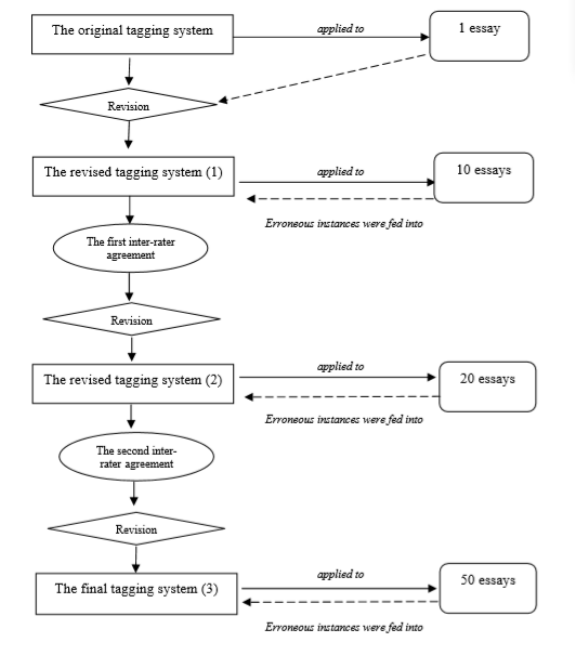
75
and inductive approaches was first employed to answer the question ‘what errors do Chinese
L1 students make?’. A testing approach was then employed to further investigate effects of
linguistic context and proficiency. While a full explanation of errors was outside the time
constraints of this research, student interviews were also planned to give qualitative insights
into the data.
3.6 The need for a preliminary study
In the light of the critical importance of the control of variables, the decisions to make in error
identification, and the ethical review of all procedures it was necessary to conduct a preliminary
study to ensure compliance and reliability. Methods in the research of a learner corpus can be
seen as an evolving process (Chuang & Nesi, 2006) as shown in Figure 5 as preliminary studies
Figure 5: Reproduced from Chuang and Nesi (2006: 257): 3 stages of developing a tagging
system
76
can investigate and evaluate various methods in the error identification process through
trialling alternative approaches with a small amount of data from a small number of students.
3.7 Preliminary study
Participants in the trial study were drawn from three classes in a 42-week Presessional course
at the University of Birmingham. A small number of students (mostly Arabic L1 and only one
Chinese student) participated in five extra ‘article use’ lunchtime lessons and extra online
quizzes in the first year of the project to trial several approaches to error identification and
other methodological procedures. The effect these workshops had on the students’ accuracy
of article use was measured by the analysis of their essays over the course of the term. Although
this data was collected and analysed, the findings of this preliminary study are not presented in
this thesis (which focusses on Chinese students). However, the way in which the
methodological approaches to error identification, classification, reliability checking
procedures and ethical recruitment evolved as a result of this first trial (with impact on later
studies) is outlined below.
3.7.1 Evolution of ethical safeguards
The main ethical concern in all studies in this thesis centred on the use of students as
participants. Serious consideration was given to the risks of demotivating the students;
impacting the students educationally from the point of view of participation or non-
participation; and students’ rights to confidentiality, integrity, respect and privacy (Phakiti,
2014). Any study recruiting study participants from among the researcher’s own teaching
cohort adds risks and limits the degree to which participation can be voluntary if 1) the research
takes place during normal scheduled teaching hours (at which times the student is expected
to attend) or 2) the students find it difficult to refuse their teacher’s request.

77
After gaining permission from the Director of the English for International Students Unit
(EISU), the next step in the preliminary study was to apply for ethical review. All research
involving human participants must go through the three stages of the University of
Birmingham’s Ethical Review procedure (University of Birmingham, 2016): 1) online initial
assessment stage; 2) application for Ethical review 3) responses and adaptation of methods to
gain approval from the Ethical Review panel. In fact, the first original contact with the review
board was the start of many negotiations as the methods in the research project evolved and
amended applications were submitted for later studies ( ERN_10-0375/amended 14-0375,
ERN_14-1455, ERN_16-1493 & ERN_17-1549) and this evolution will be discussed in greater
detail in the next section.
3.7.2 Ethical review of Corpus/experimental studies
Recruitment
The main ethical concern in this study centred on the use of students as participants. In light
of the risks of demotivating the students, the educational impact of participation and fairness,
the ethics board asked that all research activities took place outside the teaching timetable
(normally on Friday and Wednesday afternoons or at lunchtime). A small number of students
were 17 years old and it was not clear if they would legally be allowed to give informed consent
without the involvement of their parent(s)/guardians. The decision was therefore taken to only
seek participation from students who were over 18.
Consent
In order to ensure that consent was ‘informed’, students had to be given full information about
the study, its objectives and their right to non-participation. To achieve informed consent, the
decision was made to 1) tell students about the research projects in person and distribute an
information sheet, 2) give the students 24 hours, and 3) ask students to sign consent forms only

78
after they had fully understood the research project and their right to non-
participation/withdrawal. Based on requests from the ethics board, the students’ right to not
participate was made more prominent (see consent forms in Appendix 4). Participants were
free to withdraw from the project at any time before or during the study. Participants were also
given the freedom to withdraw their results within a year after the experiment was conducted.
Information given to participants
Students were not deceived in any way. They were told the focus of the research, how they
would be asked to help in the research and about their rights to withdraw/refuse consent at all
times. The university Ethical Board took a special interest in the feedback measures.
Highlighting the risk that students could be negatively disadvantaged by not participating in
the project, the board asked for an additional session to be made available to all students
regardless of participation at which the main points and preliminary research findings were
shared. Therefore, all students on the course (regardless of participation) were invited to end
of study briefings and sent reports of preliminary findings.
Storage of data
Recognising the student’s rights to privacy (and the researcher’s responsibilities under data
protection law), all data was stored electronically on an encrypted network drive backed up on
an encrypted flash disk held in a secure filing cabinet on university premises.
3.7.3 Ethical review of online testing with cloze/multiple choice tests
A number of quizzes were presented to the students on the same online learning environment
(Canvas) used for their main assessments throughout this research. Thus, there was a risk that
students would either not see participation in research as voluntary or do the online quizzes
accidentally. The Ethics Board’s main concerns were 1) that no confusion occurred between
79
what students were mandatorily required to do as part of their programme and the research
project and 2) that they could do the online quizzes and receive feedback regardless of their
participation. A suggestion to put the consent box at the start of the quiz was rejected because
students might have felt they could not do the quiz and benefit from its feedback. The solution
found to these concerns in the preliminary study and all future ethics applications (ERN_16-
1493: ERN_17-1549) was to make it clear to students that quizzes were non-mandatory and
request consent to use their data some days after completion (giving the students informed
consent without implying their non-participation would stop them seeing valuable quiz
feedback).
3.7.4 Evolution of error identification, classification and reliability checking procedures
The presentation of the procedures for reliability checking is postponed until Chapter 5, in
which Section 5.6 provides details for how three colleagues checked a 10% sample of errors
identified. However, the preliminary studies contributed to the development of both the
reliable methods of error classification and this reliability checking system.
At the early stages of the research, an overly complex classification procedure involved the
annotation of article use according to both the Bickerton Framework and Quirk & Crystal’s
(1985) descriptions of cataphoric reference and post-modification, logical use with adjectives,
unique reference, anaphoric reference and immediate situational reference. However, when
the first researcher’s classifications were compared with three other researchers, disappointing
levels of inter-rater agreement were found. This highlights the problems in applying a complex
explanatory system to language (Taylor, 1989). Given that the application of the Bickerton
Framework was challenging in of itself, the main studies eventually focussed only on this one
Framework (without further categorisation of 2DA definite articles).
80
The preliminary studies discussed here also led to the evolution of more robust inter-rater
checking procedures. Preliminary efforts with the Bickerton Framework alone failed to
produce sufficiently high Fleiss Kappa coefficients of inter-rater reliability. However, these
poor initial results were shown to be the result of the tagging review interface. For the first
attempt, an online interface had been built on a Virtual Learning Environment in order to
organise the training and annotation checking. This online interface presented the sampled
noun phrases (from the preliminary corpus dataset) in a standardised form to the three
annotation checkers. These colleagues were asked to apply the Bickerton Framework/judge
correctness using the online interface without sight of the researcher’s judgements. However,
this online system resulted in low Kappa coefficients of inter-rater agreement. On closer
analysis, it was discovered that the checkers 1) lacked sufficient training and 2) were finding it
hard to make judgements without the full context of the student response. In fact, checkers did
have the opportunity to review the whole essay/response with a click of a button in the first
online interface, but they found this procedure time-consuming and cumbersome. In later
studies, a simpler paper-based approach achieved more reliable results. Checkers were given
more training and the whole texts in printed form with highlighters to show their coding
decisions. The inter-rater agreement went up substantially (see 5.6), which shows that
decisions about semantic/pragmatic meaning are best made holistically without the
decontextualization that had mistakenly been applied in the first approach.
3.7.5 Challenges identified for the experimental study
The first methodological challenge highlighted by the preliminary study was the control of
variables such as class teacher pedagogy and error-correction. Participants in the preliminary
study were drawn from three classes which gave students 9 hours of academic English and 12
hours of general English each week, delivered by between two and four teachers for each class.
81
As the students were using General English textbooks which covered article use, it is likely
that some of the students were receiving instruction from their normal classes in article use.
Thus, participants’ article accuracy rates were being measured while taking part in five extra
lunchtime workshops, but it was impossible to attribute their progress to this extra treatment in
the preliminary study as the corrections and teaching in the students’ classes had not been
controlled. For this reason, the main studies presented in Chapters 5 and 6 made calls for
volunteers from the 15-week and 10-week Presessional courses which had only one class
teacher, far more structured syllabi more focussed on EAP and not general English. This
enabled the researcher to quantify and establish the effect of the normal teaching that the
participants received.
Another key challenge experienced at the pre-study stage was the issue of how English
proficiency level of students could be measured. With the participants’ permission (from the
consent form), students’ results in recent secure English tests could be accessed, which
normally related to Cambridge International English Language Testing System (IELTS).
Table 6 below (overleaf) presents descriptors and rough equivalents to the Common European
Framework for Reference to Languages (CEFR) from the British Council’s IELTS Guide for
Teachers (British Council, 2012). Most students entering university programmes at the
University of Birmingham are required to hold at least a B2 CEFR level of English proficiency,
equating to a recent IELTS score of 6 - 6.5 (Competent user) or IELTS 7 grade (depending
on programme). At Presessional level, students normally therefore enrol at the B1/B2 threshold
with IELTS 5 or 6 band scores and the presessional programmes aim to accelerate students’
progress to reach the equivalent IELTS level. While IELTS was a robust test taken under
controlled conditions, the fact that so many students on the 42-week Presessional were grouped
along a very narrow range of bands (generally 5.5 and 6) made it difficult to estimate the effect

82
Table 6: IELTS score descriptions (from IELTS, 2012)
Band score
CEFR
Description
9 Expert user
C2
Has fully operational command of the language: appropriate, accurate
and fluent with complete understanding.
8 Very good user
C1
Has fully operational command of the language with only occasional
unsystematic inaccuracies and inappropriate words. Misunderstandings
may occur in unfamiliar situations. Handles complex detailed
argumentation well.
7 Good user
C1
Has operational command of the language, though with occasional
inaccuracies, inappropriate words and misunderstandings in some
situations. Generally handles complex language well and understands
detailed reasoning.
6 Competent user
B2
Has generally effective command of the language despite some
inaccuracies, inappropriate words and misunderstandings. Can use and
understand fairly complex language particularly in familiar situations.
5 Modest user
B1
Has partial command of the language, coping with overall meaning in
most situations, though is likely to make many mistakes. Should be able
to handle basic communication in own field.
4 Limited user
B1
Basic competence is limited to familiar situations. Has frequent problems
in understanding and expression. Is not able to use complex language.
3 Extremely limited user
n/a
Conveys and understands only general meaning in very familiar
situations.Frequent breakdowns in communication occur..
2 Intermittent user
n/a
No real communication is possible except for the most basic information
using isolated words or short formulae in familiar situations and to meet
immediate needs. Has great difficulty understanding spoken and written
English.
1 Non-user
n/a
Essentially has no ability to use the language beyond possibly a few
isolated words.
0 Did not attempt the
test
n/a
The test taker did not answer the questions.
83
of proficiency on small sample sizes, as statistical measures could only show significant results
with an adequate number of students across different bands.
3.7.6 Preliminary study conclusions
The students in the preliminary study (including one Chinese L1 learners) made fewer errors
when given extra sessions on English article use. However, the aforementioned issues in
controlling all variables made it difficult to attribute causality to these extra sessions.
Moreover, it was not known whether students were making fewer article mistakes due simply
to their increased focus on ‘monitoring’ their language. The ambiguous nature of the
grammatical errors that students made in their writing occasionally made classification of
errors more challenging, but most nouns could be reliably annotated for error. One concern had
been that the involvement of B1 or borderline B1/B2 students would involve language so
ungrammatical as to make the intended meaning (including definiteness/ specificness) too
ambiguous to categorically state as correct or incorrect. However, the trial showed that such
occurrences (just eight noun phrases in this study) would not be a major problem with the
higher level proficiency of students who were to be invited to the subsequent main study.
Nevertheless, there were some particularly difficult decisions to make when the
overspecification of the definite article had created an issue of ‘register’ (academic style),
rather than grammatical accuracy. This indicated that a greater formalised training would have
to be given to annotation checkers to show how error had been defined. After replacing the
overly complex explanatory framework with a simplified Bickerton Framework, giving
annotator checkers more training and allowing them to make judgements of the whole texts,
the trial showed that researchers could agree a concept of ‘accuracy’ in grammatical terms and
apply it fairly consistently.
84
In addition to highlighting many challenges to be overcome, the preliminary study showed that
authentic student data from real students could inform the analysis of article errors made by
Presessional students. Reliable and ethical ways of collecting data and identifying errors in
were developed on the basis of this pre-study trial.
3.8 Summary of methodological approaches in main studies
Research Questions 2 and 3 were investigated with two main methods: a learner-corpus
approach and a grammatical judgement testing approach. As shown in Figure 6 below, after
identifying errors in the student writing (step 2), the annotated errors would need to be checked
for reliability (step 3). Step 4 then involved both a deductive corpus analysis (testing of the
hypotheses) and an inductive analysis (using a concordance). Step 5 involved a multiple-choice
test of a larger population to mitigate some of the constraints in the corpus-based approach and
further investigate some insights from the inductive approach that refined the hypotheses. The
aforementioned advantages of the testing approach (increased sample size, control of variables
and less ambiguous errors) allowed the last stages of the research to investigate some complex
questions less amenable to study in small corpus-based studies. For example, the effect of
proficiency could be investigated (the small corpus-sizes made statistical measures less
significant). However, given the limitations of any testing approach, this last stage in the
methods should not be seen as a test of the corpus findings themselves. Only the use of

85
authentic student data can give a picture of students’ accuracy in academic writing with any
validity as these tests would be affected by the limitations discussed in Section 3.5.4.
Figure 6: Summary of mixed method approach to Error Analysis
3.9 Conclusion
This chapter has critically evaluated some of some key methodological issues experienced in
the research project’s main corpus and testing approach studies. The main methodological
concerns relating to error identification (ambiguity/ ungrammatical language, dispreferred
forms) and annotation checking appeared to be resolvable. By applying for Ethical Review
and amending procedures to satisfy the university’s Ethics Board, it was possible for informed
consent to be gained ethically and several principles for safeguarding students’ rights were
established for the main studies (for which ethical approval was also obtained). The
methodological procedures of each study are further developed in each of the next chapters.
1.Preliminary
study to develop
error analysis
systems, control
of variables and
ethical review
2.Corpus led
identification of
errors
4. Testing of
hypotheses and
more inductive
approaches
3. Error
annotation
reliability
checking
5. Further
investigations of
hypotheses
using grammar
judgement tasks
(larger numbers)
86
Before investigating student error, however, the next chapter moves attention to the issue of
EAP tutors’ attitudes and practices with regard to English article use in academic writing.

87
4 SURVEY OF TEACHER ATTTITUDES AND PRACTICES
This chapter presents a survey undertaken to investigate the extent to which EAP teachers in
the UK Higher Education system teach the English article system. Before applying the corpus-
based and testing approach outlined in the previous chapter, the unknown context of whether
and how tutors teach the article system in EAP required investigation. As was highlighted in
Chapter 2, there could be a theoretical tension between the ‘EAP paradigm’ of teaching and
teaching/correction of English articles, especially when examples given are prototypical and
decontextualised from academic writing. The ‘EAP paradigm’, as outlined in the BALEAP
competency framework (Alexander et al., 2008), promotes at all costs the use of authentic texts
and a focus on the function of language rather than its form. There would therefore assumedly
be little support in this paradigm for isolated decontextualised exemplars from invented
language to show prototypical uses of English articles. With regard to written feedback,
Chapter 2 also showed how divisive the issue of written error correction is among the teaching
community. Certainly, mass indiscriminate English article correction is argued against by
many leading contemporary EAP researchers (Truscott, 1996, 2004; Ferris, 2006; Hyland &
Hyland, 2006; Alexander et al., 2008; Crosthwaite, 2016b). In order to investigate whether and
how tutors correct and teach article use, a survey and some qualitative interviews were
conducted within the EAP community.
Before presenting the survey itself the first part of this chapter briefly goes over some
definitions and highlights evidence that there may be a gap between the theoretical aspects of
the contemporary recommended practices in the EAP literature and what is actually happening
in many classrooms.
88
4.1 Background and recap of Research Question 1
Evidence was provided in Chapter 2 that the ‘EAP paradigm’ may not support either the
decontextualised teaching of articles or regular corrections of written article errors. However,
if EAP teachers are grouped together with other language teachers, the literature shows that
their practice is influenced by many factors beyond pedagogic theory and published best
practice. From a meta-analysis of 22 studies which investigated second language teachers’
beliefs and practices regarding grammar teaching, Borg (2003: 91) found that ‘language
teachers’ are shaped by a wide range of interacting and often conflicting factors’. In the EFL
field, in which many EAP tutors are trained before moving into EAP, Phipps and Borg (2009)
cite an example of a teacher using a highly decontextualised grammar ‘choice of article’
exercise using overly simplified examples even though the teacher himself believed a context-
based approach was more valid and appropriate. Several teachers cited in Phipps and Borg’s
study stated that they often used oversimplified controlled approaches such as gap-fill exercises
in grammar teaching in conflict with their own beliefs because the approaches were expected
by students. Furthermore, some tutors in Phipps and Borg’s study reported that their students
seemed to be more motivated when grammar was presented in such a way or even that they
used grammar to calm students down after discussions.
It is important to avoid assumptions about how EAP tutors teach article use in the classroom.
The fact that many experts of EAP teaching discourage excessive correction of surface errors
in student writing and insist that all teaching of grammar is incidental and based around text
meaning does not necessarily mean that such recommendations are followed. Investigating this
difference between stated beliefs and practice more specifically in EAP grammar teaching,
Etheringon & Burgess (2002) conducted a survey of 48 UK based EAP tutors in centres
affiliated to BALEAP about the tutors’ attitudes to a grammar teaching in EAP. Most teachers
89
in interviews expressed a theoretical preference for more discourse orientated approaches to
integrated grammar teaching (i.e. a focus on form when needed within a meaningful context),
rather than a decontextualised approach. However, these authors report that grammatical error
correction in writing was shown to be widespread even when it did not affect meaning. The
majority of tutors in Etheringon and Burgess’ study believed that error correction and formal
instruction helped students to improve their written accuracy, irrespective of their reported
belief in more content-based teaching approaches. Repeating the same questions in New
Zealand, Barnard and Scampton (2008) surveyed 32 EAP tutors and reported that four out of
five teachers believed that ‘form-focused correction helps students to improve their
grammatical performance’ (ibid: 59). Together with other answers that showed traits of highly
traditional approaches to writing composition instruction, the authors (2008: 59) concluded that
EAP teachers in New Zealand showed ‘a preference for more extensive treatment of
grammatical issues than is usually suggested by proponents of a strictly incidental Focus on
Form approach’.
On the one hand, teachers’ continued correction of errors may potentially have resulted in a
perceived improvement in the process and methodologies of giving feedback since error
correction is another example of changing practices in EAP. In addition to moving from a
‘product’ orientated summative approach of the past to a ‘process orientated’ formative focus
(Ferris, 2006; Ferris & Kurzer, 2019) which is currently favoured, many new approaches such
as peer assisted marking, guided self-correction, changes in EAP writing pedagogy and
computer assisted feedback have transformed the way in which formative writing feedback can
be given (Hyland & Hyland, 2006). On the other hand, if new technologies and approaches
have facilitated mass correction that is demotivating for students, overcorrection again requires
research attention.

90
The present study followed Etheringon & Burgess’ (2002) investigation into the actual
grammar teaching practices in EAP classrooms with a focus on the teaching/correction of
English articles. Anecdotal evidence in the researcher’s own institution suggested that English
article error correction was frequent and widespread, while articles were taught more often in
‘hygienic’ prototypical examples somewhat divorced from the reality of academic writing.
Such observations suggested the need for more rigorous empirical research in order to
investigate Research Question 1:
To what extent do EAP teachers in Higher Education programmes in the UK explicitly teach
or correct English article use?
4.1.1 Definitions of the notion of grammar teaching
Grammar teaching today refers to the broad range of ways that teachers focus on grammatical
form, which means not only the traditional focus upon decontextualised isolated grammatical
examples of one structure with a presentation/practice paradigm, but any activity that focusses
students on a discrete part of a language’s grammar. In the modern sense, grammar teaching
includes; asking students to notice patterns; asking students to self-correct or peer correct each
other’s work for grammatical accuracy, and studying concordance lines from an academic
corpus and identifying grammatical patterns. While the issue of corrective feedback is in itself
an area of academic and pedagogical interest, written/oral/direct/indirect corrective feedback
is a necessary feature of teaching. Thus, grammar teaching involves any focussing of learners
upon ‘correct’ grammatical form, or as Ellis explains (2006: 84):
Grammar teaching involves any instructional technique that draws learners' attention to some
specific grammatical form in such a way that it helps them either to understand it
metalinguistically and/or process it in comprehension and/or production so that they can
internalize it.
91
Since this is a very broad definition it will also be useful to distinguish between explicit or
implicit grammar teaching. Implicit knowledge can only be held or expressed unconsciously
and is acquired for communicative purposes by interactions with the environment. As Ellis
(ibid) notes, explicit grammar teaching does not necessarily imply that metalinguistic reference
is made to the language element being focused upon and it should also not be confused with
inductive or deductive teaching styles which are both types of explicit grammar teaching. Thus,
for example, asking students to reflect on why/how the definite article is used as a cohesive
device in a text (or looking for other patterns of use) would still be ‘explicit’ grammar teaching,
even if the teacher had not prefaced the activity with a focus on forms, the objectives of the
exercise or specialised metalinguistic terms such as ‘cataphoric or anaphoric reference’. The
distinction in explicit grammar teaching is that the teacher moves the students’ whole focus to
form and its related meaning or function, rather than the text’s meaning alone. Therefore, the
notion of grammar teaching in this thesis will include any explicitly conscious raising activity
aiming to increase language accuracy.
4.2 Methodology
A survey questionnaire (followed up by interview) was distributed to a small number of
teaching staff in the university’s English for International Students Unit (EISU), at that time
responsible for Presessional and Insessional EAP programmes at the university. The same
survey was then distributed (as detailed in 4.2.4) among two larger populations of English
teachers recruited via a first email distribution lists of BALEAP teachers and a second email
distribution list of teachers involved in an MA TEFL Distance Learning Programme. This
sampling approach allowed an investigation of EAP tutors’ beliefs and practices at both the
local and national level.
92
4.2.1 Survey design criteria
In designing the survey, the aim was to create an instrument with a mixture of closed and open
questions. With a view to extending the survey to further populations of teachers, a second
design criterion was to include as few questions as possible in order to maximise participation
and reduce drop-out rates. No biographical information was collected in order to fully
anonymise the survey and ensure that responses would be as honest as possible.
4.2.2 Questionnaire instrument
As can be seen in the Questionnaire shown in Appendix 1, the first 3 questions were closed
response multiple-choice questions. Question 1 (see Figure 7) prompted respondents with
various article errors and asked tutors whether the examples were used accurately, were errors
or somewhere between (correct even if unnatural). Question 2 aimed to investigate how often
participants taught article use with options ranging from ‘never’ to ‘most weeks’. Question 3
returned to the errors introduced in the first prompt and asked participants about the likelihood
with which they would provide written corrective feedback in different scenarios. Finally
question 4 allowed open responses to a question asking tutors to reflect on how learners could
be made to improve English article accuracy.
The four questions were first piloted with colleagues. As a result of their ideas, the definitions
of ‘sometimes’ and ‘occasionally’ in question two were expanded to illustrate and define the
terms which initial respondents found confusing. The examples given in prompt 1 shown below
in Figure 7 were provided following feedback that questions about errors needed
contextualising with some actual examples of student article errors. These examples were
authentic errors from a previous student’s particularly error filled essay (consent given for use
when anonymised) were added as a prompt, as shown in Figure 7:

93
Figure 7: Survey Question 1
4.2.3 Interview structure
In addition to the online surveys, six EAP colleagues at the University of Birmingham
volunteered to participate in semi-structured interviews to allow for some more qualitative
insights into their survey responses. At interview, a paper copy of the survey questionnaire
was shown to participants. In order to avoid overly leading questions, all tutors were asked the
same two identically worded questions at the start of the interviews:
1. Question 2 asked about how often you teach the article system to your students. Can
you talk a little more about when you teach them and how you teach them? When are
you most likely to teach article use?
2. Question 3 asked about how likely you’d be to highlight the errors/give feedback in the
example. In general, do you give corrective feedback? How often and when do you give
corrective feedback? How do you do it?
All the teachers were asked to bring to interview some recent examples of written work they
had corrected. All tutors agreed to be recorded (the recordings are transcribed in Appendix 3).
4.2.4 Participant information
English for International Students Unit (EISU)
EISU has since been merged with the university’s Foundation programme and rebranded the
Birmingham International Academy. At the time, EISU mainly delivered a range of

94
Presessional and Insessional programmes. As a centre accredited by the British Council (BC),
teachers are required to hold TEFL Q (Masters level of education and/or a recognised English
teaching qualification) level qualifications. At peak summer periods the unit employs over 100
EAP tutors to teach the large summer Presessional cohorts. However, at the time of this initial
survey (in the Autumn term) there were 20 full-time EAP tutors employed at the unit (both
open-ended and fixed-term contract staff). All staff were teaching on one (or two) of the main
programmes in addition to seeing international students who request further support with their
academic English in one-to-one tutorials.
The British Association of Lecturers of English for Academic Purposes
BALEAP has 120 institutional members (from over 73 British Universities) and 130 individual
members. The association has an active JISCMAIL forum discussion list on which members
discuss issues in EAP, upcoming conferences/meetings/groups/ training events, and various
other topics. This email distribution list was used to invited participants to respond the four-
question online survey.
The ELAMA Mail Discussion List for Distance MA students
The University of Birmingham’s Department of English Language and Applied Linguistics
(ELAL) runs two distance course for teachers/applied linguists working abroad /off campus
wishing to follow a UK Masters programme: MA Teaching English to Speakers of Other
Languages (TESOL) and MA Applied Linguistics. The programmes attract a diverse range of
students, most of whom are practising English teachers. Each year there are between 200 and
300 students enrolled on the programme (and enlisted on the mail discussion list). Most are
L1 English, but some are L2 English speakers. Their experiences range from being initial
entrant teachers (in language school, college or university settings) to teachers/institution

95
managers and directors with many years of experience. Most are in broad TEFL contexts (even
if working at university level). The programme’s students are all automatically registered onto
the ELAMA mail Discussion forum which is used to discuss a range of course and TESOL
related topics. In addition to the 200-300 current (and active) students, there were reported to
be approximately 400 further past students, course lecturers and staff enrolled on the list at the
time of the survey.
4.2.5 Recruitment/Response rates
As shown in Table 7, the first small survey was a convenience sample of the English for
International Students’ Unit, the researcher’s own institution. 13 online responses were
Table 7: Response rates
Population
Responses
Response
Rate
English for International Students Unit (n=20)
13
65%
BALEAP JISCMAIL (n =250)
129
52%
University of Birmingham Distance MA ELAMA List (n=600)
54
9%
completed (65% response rate). In the email sent to colleagues with the link to the anonymous
online survey, teachers were asked to respond by email if they would be happy to participate
further by following up the 5 minute questionnaire with a ten minute one-to-one recorded
interview at which they were also asked to bring recent written corrective feedback (marking)
of student work they were currently doing or had recently done (with the incentive of being

96
entered into a small prize draw). Six of these colleagues further agreed to an interview/audit of
their teaching materials/corrective feedback.
Survey of the wider EAP field
The online survey was copied and redistributed to the BALEAP JISCMAIL Discussion List
(129 responses) and the University of Birmingham Distance MA ELAMA List (54 responses)
to achieve a more representative sample of the field. There are no known response biases that
explain the higher BALEAP mailing list response rate (52%) response rate to the ELAMA
Distance MA List response rate ( 9%). However, it is known that the high number of calls for
participation in the ELAMA list is responsible for ‘response fatigue’ among tutors.
4.3 Results and Discussion
The quantitative results of the survey responses are now analysed (Sections 4.3.1 - 4.3.3) before
the qualitative results are discussed in Sections 0 - 4.3.11.
4.3.1 Question 1
As can be seen in Figures 8 – 10 below, there was general agreement in Question 1 (multiple-
choice response), from 91 percent to 100 percent, that the student examples provided in the
question prompts could be classified as errors. All EISU tutors in the survey identified the
exemplar as containing errors in overspecification and omission of definite article. Only a small
number of teachers disagreed with the categorical classification as ‘errors’ in the BALEAP
(Figure 9) and ELAL samples (Figure 10). The ‘middle’ choice allowed the respondent express
their view that the student’s use was ‘correct’, even if not ‘natural or native-like’ (6.3 percent
in BALEAP list, 5.7 percent in MA List and 0 in EISU). From reviewing the BALEAP open

97
Figure 8: EISU EAP Tutor Responses to Question 1 (n=12)
choice questions (Question 4), it can be seen that two teachers believed the sentences might be
acceptable in another World English (with which they did not want to interfere).
Figure 9: BALEAP mailing list responses to Question 1 (n=127)
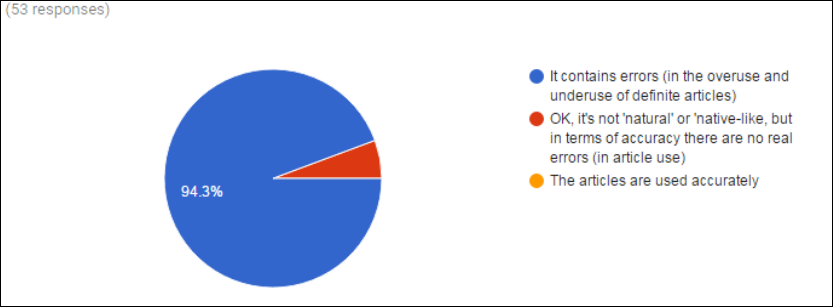
98
Figure 10: ELAL MA Distance programme responses to Question 1 (n=53)
4.3.2 Question 2
Figures 11 - 13 show the responses to Question 2 which enquired about the frequency with
which they taught articles in the classroom (with a list of possible examples to stress that this
was not limited to traditional methods of teaching). The frequency descriptors were designed
to help teachers to reflect on their practices with a given class. For an EAP Presessional tutor
this class contact is typically a fairly intensive period of 6, 10 or 15 weeks, but in some instances
lasts for two or more terms. For example, at the time of writing, most of the EISU Presessional
tutors had just finished teaching EAP for ten weeks (18 hours with a full timetable). However,
the other survey responses reflect a broader diversity of other course periods and timetables.
The most striking point observed in the data collected is the surprisingly low number of
teachers who reported never teaching article use. An assumption had been made that many
teachers, especially from the BALEAP list, might be teaching highly advanced academic skills
classes that do not focus on grammar. Yet no EISU teachers (and only 5.5 percent in the
BALEAP list and 9.4 percent in the MA list) chose ‘never’. The small difference between the
BALEAP and MA list tentatively suggests the possibility that EAP teachers are more (not less)
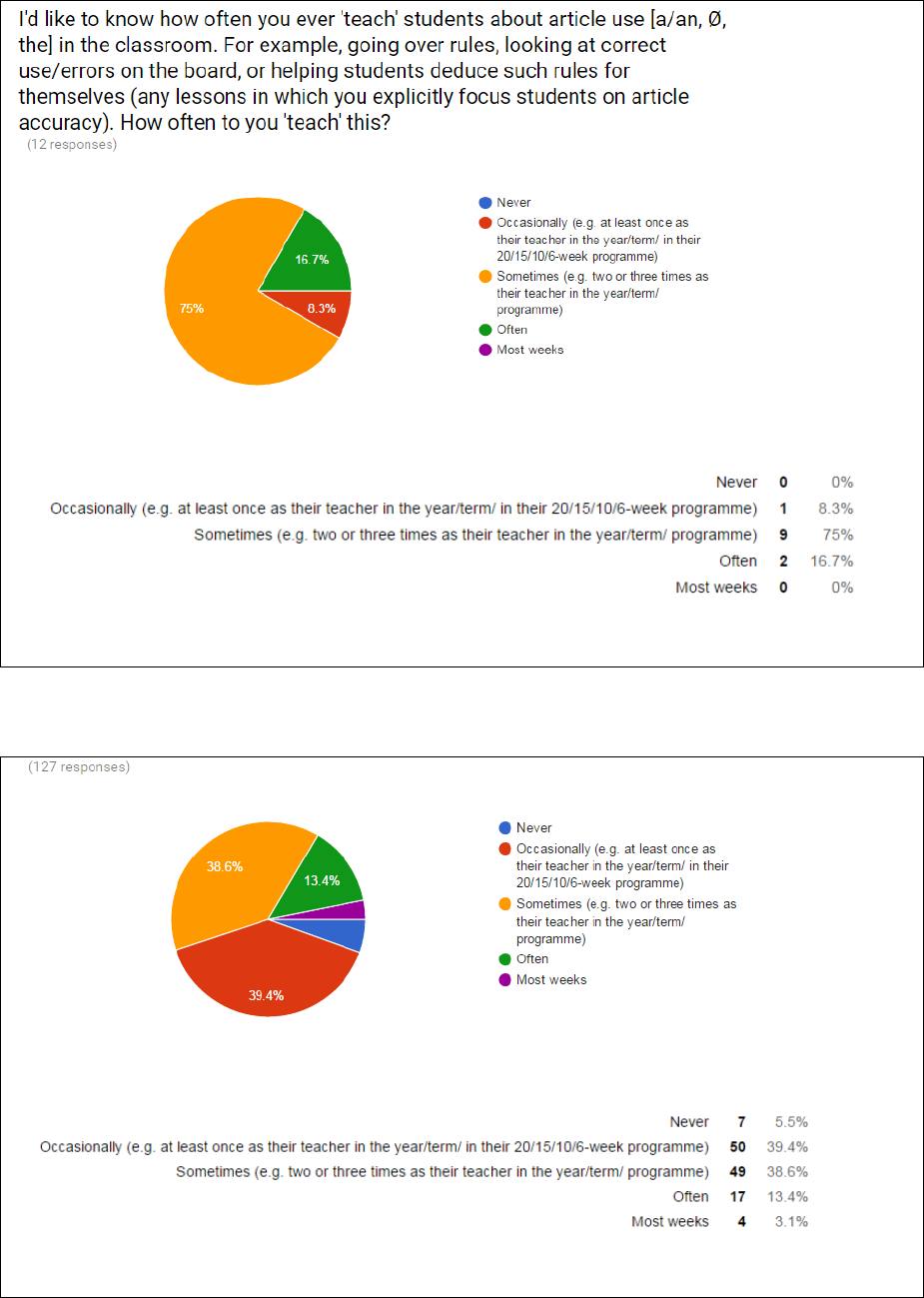
99
Figure 11: EISU EAP Tutors’ responses to Question 2 (n=12)
Figure 12: BALEAP list EAP Tutors’ responses to Question 2 (n=127)
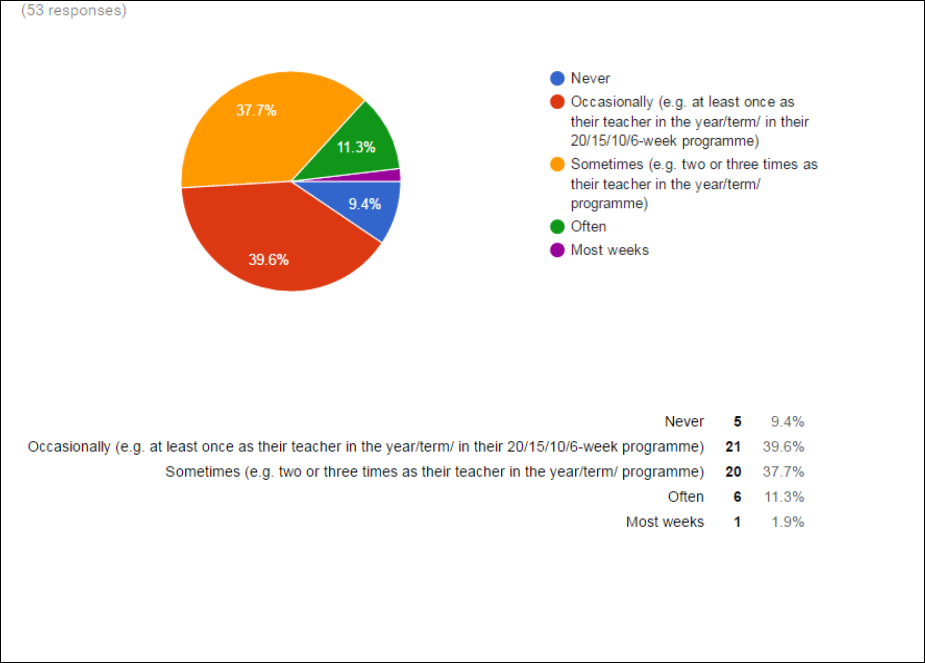
100
Figure 13: ELAL MA Distance programme responses to Question 2 (n=53)
likely to teach articles than TEFL orientated teachers (the MA list had more TEFL teachers
subscribed than the other two groups). On the other hand, while the majority of tutors are
teaching English articles one, two or three times a year/term/programme, very few tutors were
teaching the article system more than three times.
4.3.3 Question 3
Question 3 (Figure 14 below) aimed to assess how likely the teachers were to provide corrective
feedback to the errors presented in the first prompt. It had been expected that most teachers
would follow the general recommendations across the EAP literature and not correct all such
errors in certain contexts (such as classwork or in homework tasks). However, reflecting the
anecdotal experience that some tutors rightly or wrongly see themselves as proofreaders for

101
students’ higher stake assignments, it had been predicted that tutors would be more likely to
correct such errors in certain contexts.
Going back to this piece of writing (see below) how likely would you be to highlight any written
errors you saw in your feedback to students (written or verbal)? This could mean
annotating/marking errors, underlining errors or simply pointing them out to students in a
tutorial. Please consider the situations below:
Figure 14: Question 3 prompt
Indeed, as had been predicted, the vast majority of teachers in all groups would correct such
errors in a ‘first draft’ or ‘conference paper’. However, it was surprising to see not only that a
large majority of teachers in all groups would correct the errors in written homework, but also
that over half of teachers in all groups were likely or very likely to correct the errors in a quickly
written piece of work in class time (58.3 percent of EISU tutors, 60.7 percent of BALEAP
tutors and 51.9 percent of the ELAL MA list).
Figures 15-17 illustrate the responses to the question of whether tutors would correct article
errors in writing produced quickly in class.
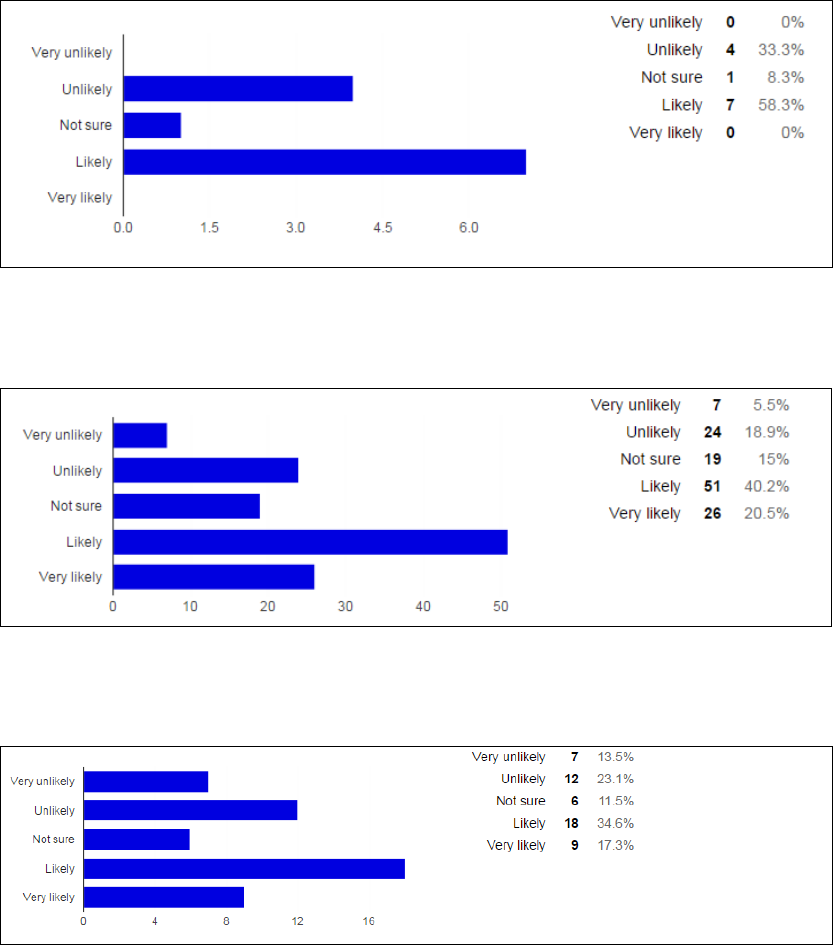
102
Figure 15: EISU EAP Tutors Question 3 (in class) n=12
Figure 16: BALEAP EAP Tutors Question 3 (in class) n=120
Figure 17: ELAL MA Distance programme Question 3 (in class correction) n=52
Figures 18-20 below illustrate the teachers’ responses as to whether they would correct the
article errors in a writing task set for homework. Again, for weekly homework it had been
expected that many tutors would not be likely to correct article use or would be unsure without
further knowledge of the students’ general writing ability. However, across all groups most
tutors were ‘likely’ or ‘very likely’ to correct such errors. The group with the smallest number
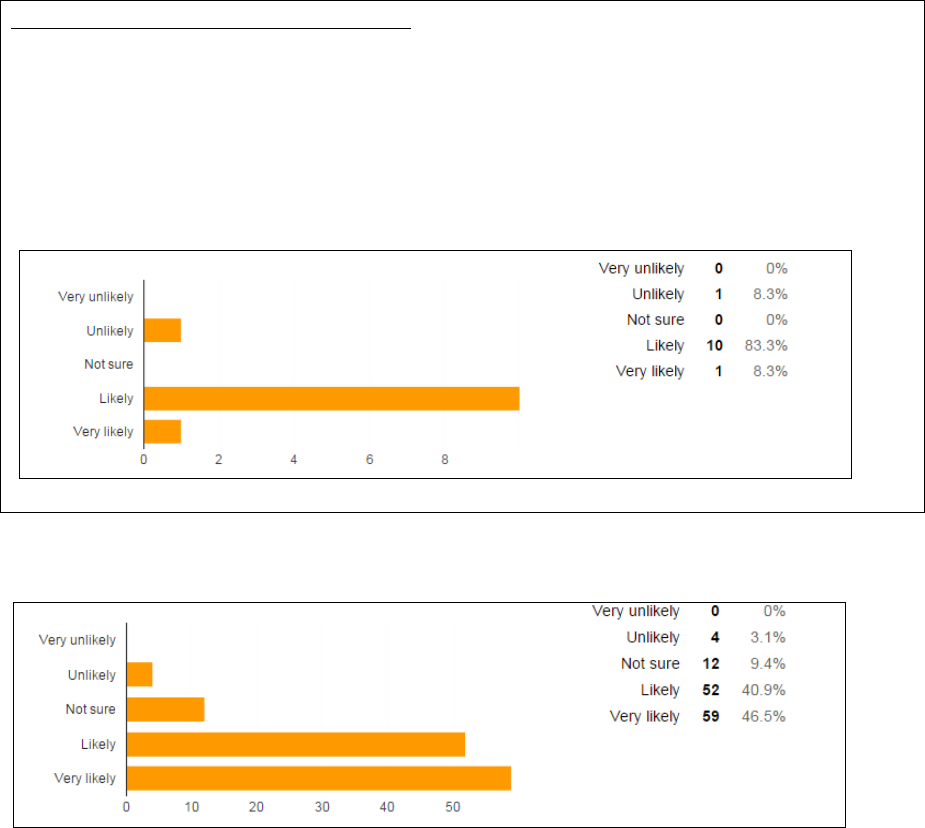
103
of teachers answering ‘likely’ or ‘very likely’ was the MA list (79.3 percent), with 87.1 percent
and 91.3 percent for BALEAP and EISU teacher groups respectively.
If this was in a weekly writing homework Going back to this piece of writing (see below) how
likely would you be to highlight any written errors you saw in your feedback to students
(written or verbal)? This could mean annotating/marking errors, underlining errors or simply
pointing them out to students in a tutorial.
Figure 18: EISU Tutors Question 4 (weekly homework) n=12
Figure 19: BALEAP EAP Tutors Question 3 (weekly homework) n=127
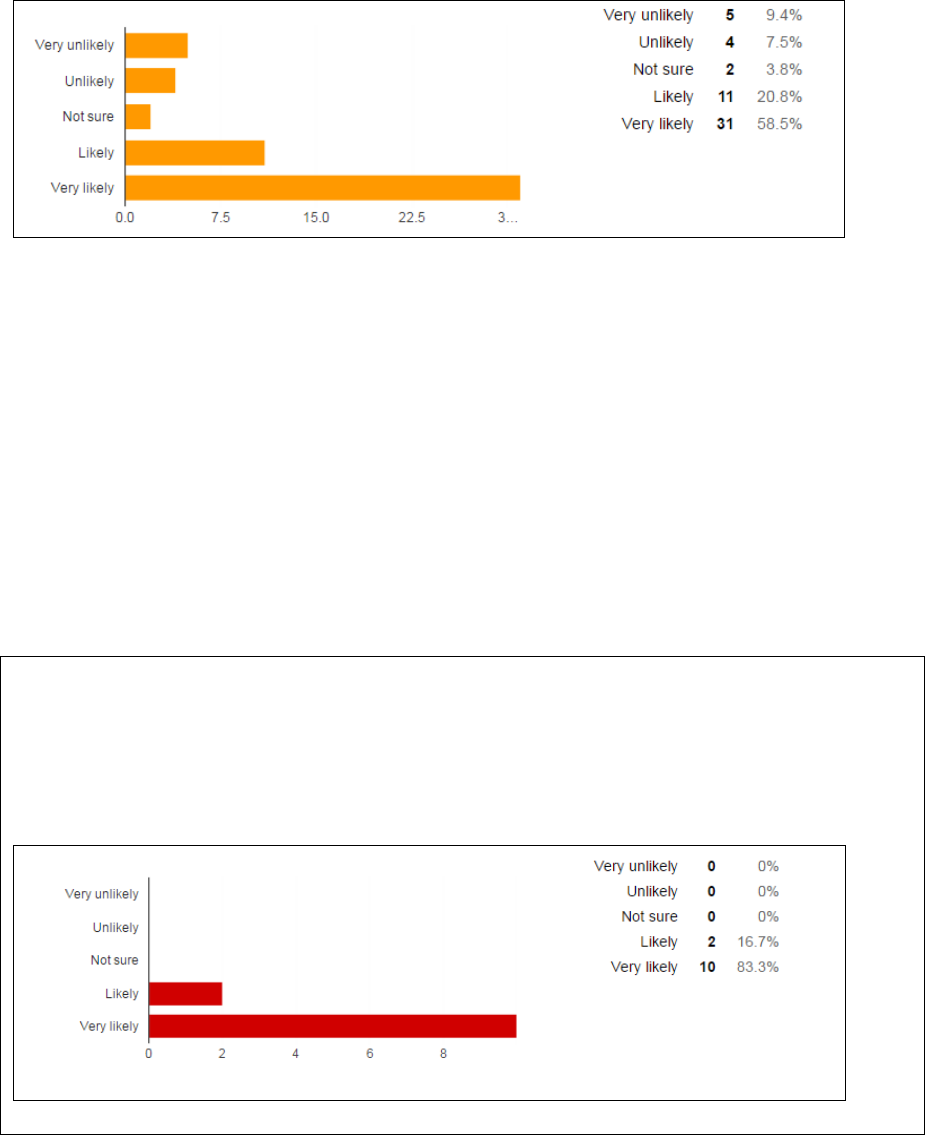
104
Figure 20: ELAL MA Distance Programme Tutors Q.3 (weekly homework) n=53
There was less surprise about the first draft of an assessed piece of work (as illustrated in
Figures 21-23 below) since at EISU for example, the teachers were actually expected to mark
the first page of the process writing extended writing assignment. Finally, as shown in Figures
24-26, it can be seen that most teachers were ‘likely’ or ‘very likely’ to correct such errors in
when they were co-authoring a conference paper with the student.
Going back to this piece of writing (see below) how likely would you be to highlight any written errors
you saw in your feedback to students (written or verbal) in the first draft in process writing? This could
mean annotating/marking errors, underlining errors or simply pointing them out to students in a
tutorial.
Figure 21: EISU Tutors Question 3 (in first draft) n=12
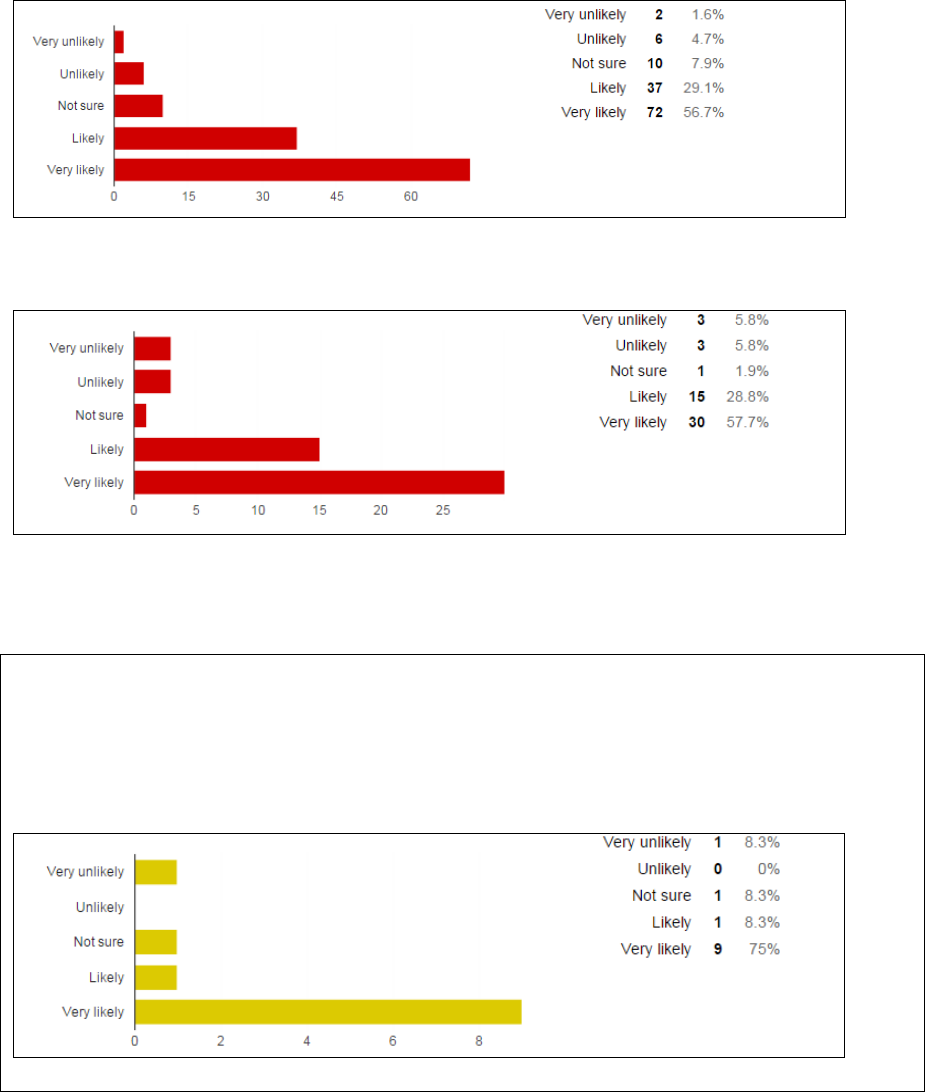
105
Figure 22: BALEAP EAP Tutors Question 3 (in first draft) n=127
Figure 23: MA list tutors Question 3 (in first draft) n=52
In a conference paper you plan to submit (and co-present) with the student. Going back to this piece
of writing (see below) how likely would you be to highlight any written errors you saw in your feedback
to students (written or verbal)? This could mean annotating/marking errors, underlining errors or
simply pointing them out to students in a tutorial.
Figure 24: BIA EAP Tutors Question 3 (conference paper) n=12
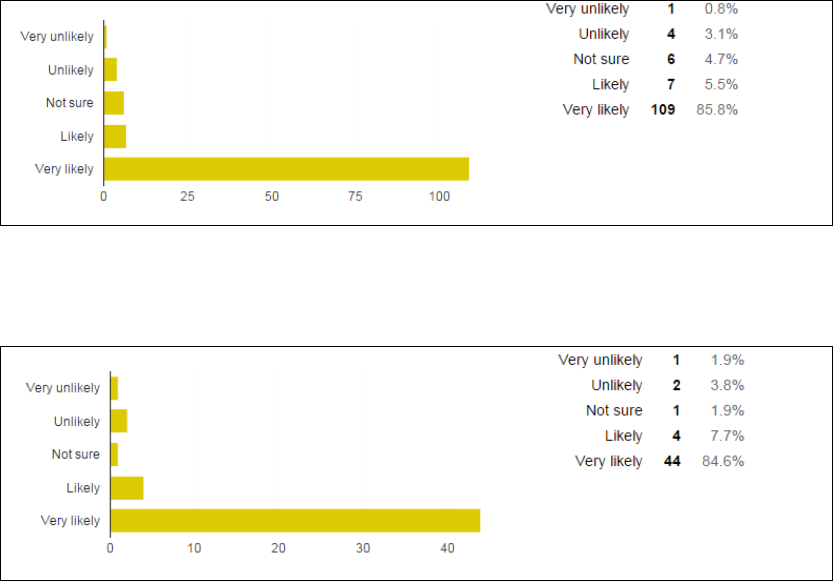
106
Figure 25: BALEAP EAP Tutors Question 3 (conference paper) n=127
Figure 26: MA List Tutors Question 3 (conference paper) n=52
4.3.4 Qualitative findings
This section now presents the qualitative insights gained in this study which includes the
respondents’ answers to the survey open question (Question 4) and the interviews with six EAP
tutors. The full answers from the tutors who responded to the open response question are
shown in Appendix 2 (n=101). The analysis below starts instead with the insights gained from
the answers given in six tutor interviews carried out following the survey. In the interviews the
teachers were asked to give more information about their answers. Their full answers were
transcribed and are presented in Appendix 3. By analysing their answers and comparing them
to the wider survey responses to the open question (Question 4) asking tutors to reflect on how
learners could be made to improve English article accuracy, this analysis provides a deeper
indication of when, how and why tutors correct or teach article use.

107
Interviews/audit of feedback.
On request, all teachers brought a class set of marked papers (or gave access to a class set the
week after the interview) with the aim of establishing whether the tutors regularly corrected
errors and contextualising the interviews with specific examples. A review of these papers
showed that only two teachers had not made annotations of article errors in their marking. One
teacher of the four who corrected articles had made only two article corrections, but all the
others had corrected at least one example of what was perceived as an article error in each
essay. In brief, the picture was again one of correction of articles for four out of the six teachers
even when the task was not assessed.
Sections 4.3.5 to 4.3.10 below summarise and interpret the answers of the six interviewed
teachers in turn (their full responses are presented in Appendix 3).
4.3.5 Tutor #1
Tutor #1 was an English L1 tutor with three years’ experience of Presessional teaching.
Analysing her answers at interview, it can be seen that this tutor saw her role as correcting
article misuse rather than teaching correct use in the classroom. Her initial responses suggested
that she did not see the teaching of articles to be consistent with EAP best practices or possible
in the time constraints of the Presessional. However, arguably in conflict with this asserted
rejection, it was clear from the examples she brought to interview that she was regularly micro-
marking article use. From her answers (see transcribed extract in shown in Figure 27 below),
it is also clear that she believed such article corrections helped learners improve their accuracy:

108
Question 2 asked about how often you teach the article system to your students.
Can you talk a little more about when you teach them and how you teach them?
When are you most likely to teach article use?
Teaching the article system? To be frank, I don’t have enough time to teach it in the classroom
in one session of its own. With the time pressure and everything we cover, I don’t have time
to dedicate time to this. […] It might come up in cohesion and I might send them to a grammar
reference for homework. But I don’t formally teach it in EAP. I think it’s quite a trivial surface
error. But each time when I correct writing…when I check students’ writing, I will check and
point out any errors in articles most of the time.
Question 3 asked about how likely you’d be to highlight the errors/give feedback
in the example. In general, do you give corrective feedback? How often and when
do you give corrective feedback? How do you do it?
I would like to say I do peer correction and things like that…but I just don’t have time. Each
time… I correct the errors – I often use codes for all grammar errors. Students will get articles
marked two or three times…sometimes more if there’s a high stakes assignment. Maybe that’s
not ideal, but we are so short of time. So, each time if I spot any error I will just mark it. And
then in the tutorial time I will talk through it. And…if..actually if there are more than one
students making similar mistakes…in sort…maybe in of in similar usages, I will collect
examples and talk through very briefly in the classroom as a group.
How often do you correct their errors?
Most weeks I’ll micro-mark a few paragraphs of their writing. For the important
assessed work I’ll probably mark two pages of the first draft of the assignment.
Does that help?
Definitely. Without correction they wouldn’t normally realise that they‘ve used the article in
the wrong way and after I’ve picked it up they normally ask questions and try to reason…find
the correct way and they ask questions. OK, no I wouldn’t be able to evaluate how effective
this practice this. But I think in my opinion they do get better over time.
Figure 27: Transcribed extract Tutor #1
While the view that absolutely all article errors should be indiscriminately proofed and
corrected is likely to be a minority view across EAP teaching community, this tutor’s
109
assumption that correction led to improved accuracy was representative of a small number of
responses in survey Question 4 (open response), four of which are shown below for illustration:
• Correcting surface errors like articles are part of our role as EAP tutors. I feel this is
best done using error codes and the student’s own work rather than abstract sentence
level grammar exercises.
• Firstly, students need to be aware that they have a problem with their own use of
articles…
• ...constantly flagging it up in corrective feedback may help over time.
• Yes, we can. Written and oral feedback on written work.
Such tutors show an underlying belief that accuracy improved over time through regular
correction. It appears that such tutors see themselves as ‘proofreaders’ for their students.
While most teachers will perceive a need to micro-mark parts of the early drafts of high stakes
assignments in a justifiable ‘product-oriented’ approach, some teachers appear to believe they
should correct all article errors in all written assignments. However, their underlying
assumption that teacher led indiscriminate error correction of written work automatically leads
to learning was not fully supported by the literature reviewed in Section 2.5.3.
4.3.6 Tutor #2
Tutor #2 was an English L1 tutor with an EFL background, very new to EAP teaching
(interviewed after her first year of Presessional teaching experience). Her answers are
representative of a type of teacher who regularly focusses students on the grammar of articles,
both within and outside of recommended practices in the EAP literature. In fact, (as shown in
Figure 28) she reported teaching the article system 5-6 times during a 15-week presessional.
This started with one very specific 45 minute article focussed session followed by more
impromptu 5 minute incidental sessions and whole class reviews of common errors made in
articles (in feedback on writing). On the one hand, many of this tutor’s approaches (focussing

110
on articles in presentation skills classes, peer corrections and a focus on proofreading skills)
were well within the frequently recommended pedagogy in the EAP literature. She also clearly
thought article errors represented a lexical issue in addition to a conceptual ‘rules’ problem for
students. However, it was clear from her answers that she would have spent longer on the rules
of article use with greater time and she was still adopting somewhat of an EFL paradigm in her
view that teachers should return to grammar points like articles in a ‘cyclical way’.
Question 2 asked about how often you teach the article system to your students.
Can you talk a little more about when you teach them and how you teach them?
When are you most likely to teach article use?
[…] So, thinking about what I normally do….In the 15-week Presessional I did this - I had
one session which was...like a 45 minute session where we look specifically at articles and then
there were two or three times when it came up and we had 5-ten minutes each time. And then
there’s the ARP feedback, so maybe I help them with articles 5 or 6 times on a longer
presessional. But I didn’t do this so much with the 10-week students.
[…]OK, last question. In question 4 you were asked for
recommendations/suggestions about helping students improve their accuracy of
English Articles in writing….(do you have any further comments?). Do you have
any more tips? Can we help students improve their English article accuracy and
if so, how?
OK, so from what I have…from what I’ve understood. OK look I’ve got my Diploma but I’ve
not done …I’m not someone who’s done a lot of reading on this. But from what I’ve
understood, articles are late acquired. So, to a certain extent, it’s one of those things that is
cyclical. It comes up at various points in what you’re teaching. It’s just a complicated thing.
So, what I’ve done in the past with …because I have taught Russians and East Europeans…so
for speaking, making it part of the rhythm. I teach it more in the speaking skills. You can make
them understand that there’s a space for the article, even by clapping it out. For example ‘as a
result’…you clap on the syllable….include them in a group. The focus shouldn’t be on ‘why’,
it’s just look it’s there in that chunk of language. As with everything, for some students it really
helps them, for some students it’s like water off a duck’s back.
Figure 28: Transcribed extract Tutor #2
Reviewing survey Question 4 open responses (n=101), it appears that a number of EAP
teachers assume that continued references to rules or a novel method of helping students
111
understand the general purpose of articles is the key to improving accuracy. The following
responses typify what could be characterised as an ‘optimistic rule giver’ type of tutor:
• I try to teach them some basic 'rules'. 'The' is used for something specific, one of a kind,
unique. 'A, an' are used for one of many.
• Simplify article use by showing that the definite article is an audience oriented particle
which signals to the reader - you know what I'm talking about.
• Some basic rules e.g. with plural country names (the UK, USA etc.) are helpful. Ideas
which are harder to grasp quickly, e.g. talking about generic versus specific items, can
be illustrated through reading and recognising article use.
• There's no magic wand - they just have to learn the rules and develop an ear for how
articles are used.
• Learn about articles ourselves.
Having established that many tutors continue to believe in rules-based grammar teaching, as
also suggested by the quantitative findings, it was important to examine whether such pedagogy
was effective in improving accuracy (as discussed in the next chapter).
4.3.7 Tutor #3
Tutor #3 (English L1) had eight years of ESOL experience and five years of EAP Presessional
experience. Of the six interviewed teachers, this tutor’s reported beliefs and classroom
practices (see Figure 29 overleaf) appeared most aligned to the pedagogy most usually
advocated in the EAP literature. He had not marked article errors in the student feedback
examples he brought to interview. However, he did focus students’ attention on article use.
Rather than decontextualised prototypes, this teacher used a modified authentic academic text
to highlight how article was used in definitions and later how articles helped the writer change
the focus from general to specific references. The teacher used a springboard session to focus
students on correct use within an academic article, but then stopped teaching and emphasised
the use of peer-marking and self-correction to promote learner autonomy. When asked about

112
error-correction, the only articles that this teacher reported correcting were those in high-stakes
assignments. As shown in the transcribed extract below, this tutor did not correct articles in
most homework submissions as he saw this as ‘spoon-feeding’. This teacher again seems to
be practising contemporary EAP best practices advocated in most literature.
Question 2 asked about how often you teach the article system to your students. Can
you talk a little more about when you teach them and how you teach them? When
are you most likely to teach article use?
Yes, I do introduce it more formally at the start. I often look at correct use first, maybe at how
it works with definitions of generalisations in the introduction, which is normally a plural form
without article. This is important because I can’t assume they’ve been taught it [the article
system] in the way I want them to understand it. It fitted in quite nicely in the 10-week course
this year at the beginning – I brought forward the stuff about proofreading. But rather than
focus on errors, I first looked at how correct use worked. Then I put a Powerpoint slide up with
a research article I’d chosen but simplified a bit. I got them to focus on how articles determine
specific examples at some points and generalisations in others – I think I got this idea from
Swales. Then I gave them some proofreading exercises with correct and incorrect article use.
Then I got them to start peer marking their own work. I actually do that with every written task
– they peer mark it every time…. before it comes to me. And that first time it was with articles.
Question 3 asked about how likely you’d be to highlight the errors/give feedback
in the example. In general, do you give corrective feedback? How often and when
do you give corrective feedback? How do you do it?
[…] I think there’s a lot of teachers overmarking articles. The problem is, the student is just
going to depend on your spoon-feeding. And do they actually learn? You’re not going to be
there in their main programme – they have to learn to do this themselves. And we have these
really amazing motivated students in EAP which is so great – I come from an ESOL background
where I spent so long trying to get students to take responsibility, but our Presessional students
get this more quickly.
Figure 29: Transcribed extract Tutor #3
While the majority of respondents in the survey appeared to error-correct students work more
indiscriminately, many answers to survey Question 4 (open response) appeared to follow these
more data-driven approaches to teaching article use:
113
• I haven't found generic exercises such as 'correct the errors' in random sentences help
really. However, I have found that activities which help students notice their own
specific errors in their own writing does seem to make some difference.
• I think it is important to sensitise students to the issue of article use and encourage them
to self-correct in revision drafts.
• I generally ask students to proofread and peer check. I think that students can generally
avoid article errors when they concentrate on articles specifically. However, when
grammar is not the focus I think there is a tendency to translate from the student's L1
which means they make errors with articles.
• At lower levels, raising students' awareness of their use of articles can make a
difference, with peer correction being useful in this regard.
• My response to this is to get students to closely analyse reading texts which have either
been introduced as part of the syllabus or which they independently chosen and to look
for specific language use issues - in this case the use of the article (pre-teaching article
use if appropriate) and to compare in pairs
• Awareness-raising will be useful for some students, allowing them to improve their
understanding/use over time. Short focused activities (e.g. correction exercises, use of
corpora lines to note patterns) may also help (some) students appreciate
when/where/why the use/omission of an article may to blur meaning.
Stressing the importance of autonomous study skills (self-correction, peer marking) and
focussing students on article use through data-driven learning approaches the tutors above
appear to be following the best practices of the recommendations found in the EAP literature.
These best practices show that focussing students on article accuracy certainly does not need
to be decontextualised or teacher centred. For the sake of simplicity, within this fivefold
typology, such teachers are thus labelled ‘EAP paradigm tutors’.
4.3.8 Tutor #4
Tutor #4 was an (L1 English) EAP teacher with over 15 years’ of experience. At interview she
stated an assumption of a strong L1 transfer effect on Chinese students’ presumed inaccuracy
with articles. While mentioning several practices (see Figure 30) that could fit within the

114
pedagogy and learner autonomy most advocated in the EAP literature (the ‘EAP paradigm’),
she also showed a strong belief in error-correction and rules from grammar reference guides.
More similar to tutors #1 or #2 than #3, this tutor might therefore best be characterised as a
combined ‘proofreader’ and ‘optimistic rule giver’.
Question 2 asked about how often you teach the article system to your students.
Can you talk a little more about when you teach them and how you teach them?
When are you most likely to teach article use?
Yes, we need to teach articles in EAP if the students are IELTS 6.5 or below. For higher level
students, I think they’re sorting themselves out alone, but most Presessional students from
China need help. The Chinese students really struggle with articles because their first language
doesn’t have them. There isn’t much time, but I’ll try at least twice to pull some of the students’
errors that I’ve noticed and put them on the screen. They need to see how important articles
can be especially in definitions or about how generic articles work in an engineering topic and
the difference between when they generalise about a term in one paragraph but may need to
refer to specific and known things in another paragraph. And apart from that I send them to
grammar reference books. I tell them they should all have Hewing’s grammar book so if they
get a correction they don’t understand they need to look it up and learn the usage. I correct
their errors too so they can see what they need to learn.
Figure 30: Transcribed extract Tutor #4
Tutor #4’s confidence in the effect of grammar rules and mass error-correction was not widely
shared among the surveyed responses. However, a small number of the open responses given
to survey Question 4 (open response) were equally confident in such practices:
• Chinese speakers will need to be continually supported with frequent exercises and
focused correction of their writing.
• [Recommendation of book]. This book outlines 125 rules for articles.
• Yes, teach, practice with paragraphs of error-filled text, etc.
• Access to a grammar reference source such as McCarthy and Carter's Cambridge
Grammar.
• Yes, but it's very difficult. Awareness raising, examination of rules, practice exercises.

115
The responses above suggest that some EAP tutors wish to keep away from the issue of article
use in whole class teaching, but see some responsibility for making sure students are noticing
their errors through correction and then assuming the students’ independent use of grammar
references materials can help them improve their accuracy levels.
4.3.9 Tutor #5
Tutor #5 (L1 English) had an ESOL background and 3 years of EAP Presessional teaching
experience. This teacher showed a strong commitment to data-driven learning, learner
autonomy and peer/self-correction, but framed this focus through a rule-deduction approach.
He had only marked two article errors in all of the feedback he brought to the interview. As
shown in Figure 31 below, like Tutor #3 many best practices were reported that seemed
harmonious with EAP literature recommended practices (the ‘EAP paradigm’).
1. Question 2 asked about how often you teach the article system to your
students. Can you talk a little more about when you teach them and how you teach
them? When are you most likely to teach article use?
From the get go I would try to introduce them to the idea of proofreading and learner autonomy.
So in the first week I’d expose them to the idea of how to correct some of these problems. I
created proofreading prompts… (checking countability, plurality). For articles I get them to
deduce three basic rules and that single countable noun phrases needs a determiner. I take
them through these intensely in this one session with this proofing prompt (he demonstrated).
So I’d expose the issues to them like this and make them aware of it, but I wouldn’t keep
pressing it. I wouldn’t keep micro-marking it. If they wanted to, in tutorials I’d direct them to
further resources, but it’s something they have to do autonomously. OK, if it was the ARP
(extended writing assignment) I feel there’s too much at stake so normally I micro-mark the
third page, or I would micro-mark a page or two, but they’d have to go over the rest of it.
Figure 31: Transcribed extract Tutor #5
On the issue of error-correction, this tutor argued the case for occasional highlighting of article

116
errors, but without telling students the correction itself:
Question 3 asked about how likely you’d be to highlight the errors/give feedback
in the example. In general, do you give corrective feedback? How often and when
do you give corrective feedback? How do you do it?
I didn’t correct much on the 6-week course this year. But on the 10-week course last year, I
marked them …I would just put ‘G’ for grammar and I would leave it up for the student to work
out what the mistake is. I would leave it up to them to come to me if they didn’t’ understand
what this issue was. I really want to reinforce learner autonomy. So, another thing I do is peer
marking. I think er…I’ve especially learned this with learner autonomy, it’s more about
promoting their confidence. So with peer marking, it doesn’t matter if they’re not 100%. It’s
ok, but they will learn from their mistakes from making mistakes. And obviously I will do some
quality control.
Figure 32: Tutor #5 continued
In many ways, Tutor # 5 appeared to best characterise the attitudes, beliefs and practices most
frequently mentioned in the BALEAP survey responses. These teachers teach the form of
language, but always usually with an authentic text driven approach with emphasis on students’
own noticing of patterns. Figure 33 below presents an analysis of the BALEAP answers
(n=101) clustered into group types. As can be seen, by far the most frequently recommended
teaching strategy was the general notion of asking students to ‘notice’ article use (32 mentions).
These 32 mentions did not explicitly make reference to the third most popular recommendation
of asking students to deduce the function-form meanings (18 recommendations) from studying
texts/examples, but it can probably be assumed that many of the 32 respondents recommending
‘noticing’ strategies’ implicitly suggested some sort of data-driven learning approach. As can
be seen below, the more frequent approaches (apart from correction of errors) are not
incompatible with the frequently recommended pedagogy in the EAP literature.
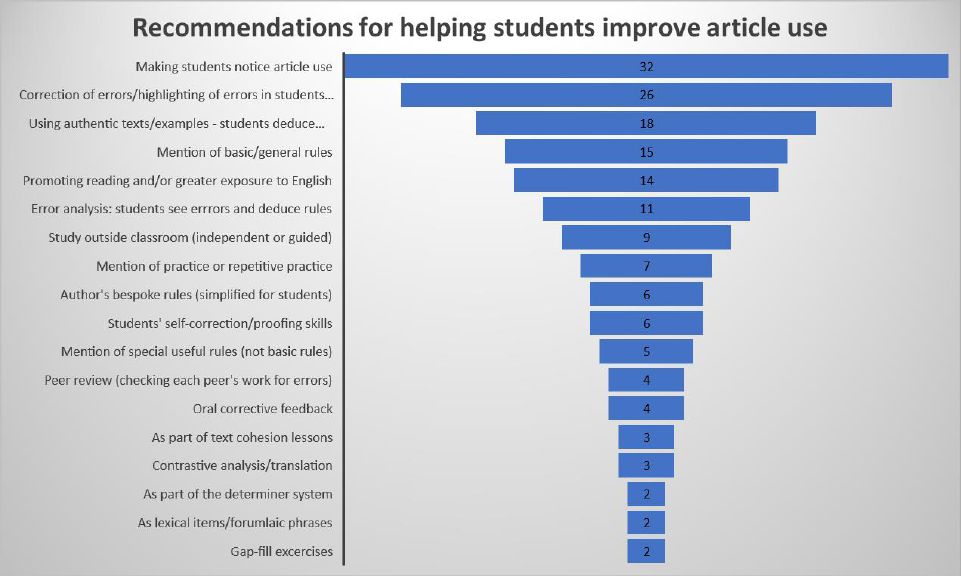
117
Figure 33: BALEAP list pedagogical recommendations (number of mentions, n=101)
4.3.10 Tutor #6
Tutor #6 was an L2 English speaker of (L1 Chinese) at the end of her first year of teaching
EAP in the UK, following five years of teaching college English in China. Tutor #6 had
corrected two article errors in the high-stakes assignment (first draft), but no article errors in
the other homework examples that she brought to interview. As can be seen in her full interview
transcript (see Appendix 3), this tutor reported that she rarely corrected English articles in
regular homework feedback because 1) she preferred to focus on ‘the way they structure their
ideas’ and 2) she did not ‘feel confident correcting them’. She therefore rather reluctantly
corrected article usage only in the most important high stakes assignments, mostly because she
felt it was what the students wanted rather than seeing any acquisitional benefit from doing so.
As a teacher with experience of teaching academic English in China, this tutor explained (see
Figure 34) that Chinese students often wanted more grammar in lessons because of the way

118
English is taught in the compulsory ‘college English’ courses in China. She further speculates
that Chinese students can feel frustration at their lower accuracy in real production compared
with their better performance in multiple choice tests:
Could you think of any cultural reasons for misunderstanding article use? As
you’re Chinese, perhaps you can help me understand whether it’s the students’
background or their misunderstanding of academic genres that is the problem.
I was teaching English actually at university in China for five years. You know in
China it’s compulsory for the students to study English for the first two years. We call
it ‘College English’ and we have a dedicated coursebook that they will study no matter
what their subjects are. On reflecting on these practices, we did actually do a lot of
grammar practice. In fact, more often or not we’re using multiple choice questions with
texts, so you only need to pick out the correct answer. So you’re not really producing
your own writing. It’s very different…picking out the correct one…to writing your
own one. This college English is more about grammar. A major part of it is to
consolidate grammar points and a major part of it is to show them exam papers and 60-
70% of the exam is multiple choice. I don’t know why students make more errors in
their writing than they do in the tests, but I think it’s like….like being on a simulator to
learn to drive a car. However long you go on a simulator, it cannot prepare you for
driving your own car on the road. And English for Chinese students is like this. I
actually use this analogy when I teach essay writing. Knowing the rules is quite
different to using the rules accurately. Chinese students spend so much time on those
multiple-choice questions, but their knowledge is not useful in real language situations.
I notice some students overuse definite articles. It is sometimes that Chinese students
want to reinforce something. But it is really confusing.
Do you think it can have any negative effects when we correct students? Are there
any dangers of overcorrecting students? I worry what would happen if I tried to
learn Chinese writing and had lots of corrections on parallel forms like measure
words or something.
I wouldn’t have thought so, to be honest. They are all very keen. They can see that
attending this course can help them to improve. Actually, one of the feedback I had
from students at the end of the 6-week Presessional was ‘why don’t you teach more
grammar’ and ‘why don’t you teach pronunciation’. I think they would like more
grammar.
Figure 34: Transcribed extract Tutor #6

119
Tutor #6’s attitude resonates with two other responses in the survey. In response to Question
4 (the question which allowed tutors an open response), two respondents commented that they
found the rules too challenging to explain:
• I find it difficult to explain and believe that extensive reading on part of the student is
the best solution
• I'm a second lang [sic] learner myself at PhD level and make mistakes with articles
and prepositions. I'd teach the rules which are sort of vague anyway but in general I'd
let it go.
While two BALEAP tutors indicated a reluctance to teach or correct articles due to their own
lack of confidence in understanding or explaining article use, 99 other respondents made no
reference their own lack of abilities or understanding. This result was surprising as the English
article system is extremely complex to fully comprehend. It is possible that some tutors felt
embarrassed to discuss their own abilities even in an anonymous survey so, like any self-
reporting survey, this result must be treated with some degree of caution. For whatever reasons
they would prefer to avoid correcting article use, this typology characterises these tutors as
‘reluctant error correctors’.
4.3.11 Principled ignorers of English articles
None of the interviewed EISU teachers showed a principled outright objection to focussing on
article form (either through noticing techniques or correction). However, 5.5 percent (n= 127)
of the BALEAP questionnaire respondents reported that they never taught English articles and
39.4 percent only taught them once or so during the programme. As shown below in their
answers to the survey open question, there is therefore evidence that a small minority of
teachers have principled objections to focussing on articles in any way. These teachers can be
characterised as ‘principled ignorers’ who may see the EAP best practices as incompatible with
120
the focus on minor surface forms. Five example answers to survey Question 4 (open response)
are shown below:
• I'm unconvinced that beyond pre-academic study it's really worth explicitly teaching
this point at all, for the little return which may come from doing so, not least in terms
of its impact on meaning. By the time students reach undergraduate or postgraduate
level, I doubt if it's more than a minor irritation to their subject lecturers (with perhaps
a few exceptions in language-related subjects). With more and more English-medium
research published (and edited) by non-native speakers of English, occurrences of
article 'errors' may well become increasingly frequent.
• We used to talk about 'error gravity' a long time ago, and I believe that inaccuracy in
this particular area is seen as 'error lite'.
• For a more confident tutor, it's much less important. In a less parochial sense, English
is becoming much more global (cf English Next et al), with washback into "Centre"
countries from other users.] Is it practical?
• I would say that I am less likely to address it explicitly as an EAP teacher because it is
less important than other features of EAP.
• Not sure. I think articles are one of 'final errors', if you like, NNS that have been in an
English country for many years can still make errors with articles. It may be improved
with greater exposure to language and language environment than direct teaching in
class.
Further analysis of these 101 BALEAP teachers’ responses (specifically the principled
ignorers) involved grouping their responses into 7 categories, as shown below in Figure 35.
These categories paraphrase the gist of the respondents, rather than show verbatim responses.
As can be seen, eight of the 101 BALEAP respondents made reference to the fact that articles
could be left to acquisition processes with enough naturalistic contact with academic English.
Other reasons for not teaching the article system included; the ineffectiveness of teaching the
system; the low return for the effort; the higher perceived level in EAP, and World English
arguments. Nevertheless, these views were rare among the surveyed respondents.
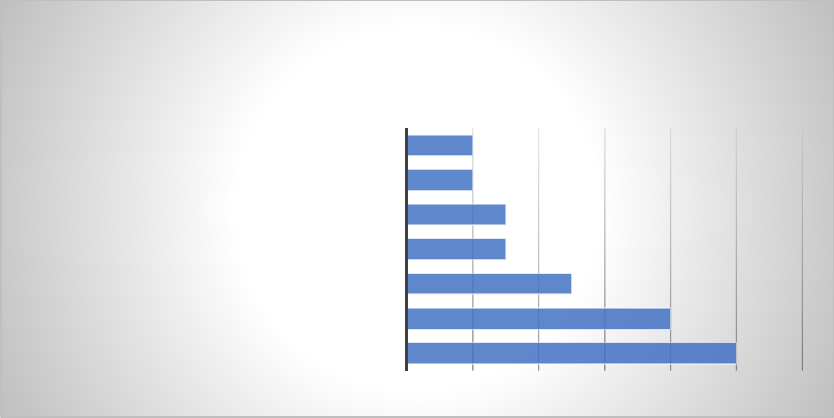
121
Figure 35: Reasons given for not teaching articles explicitly (n=101)
4.3.12 Fivefold typology of EAP tutor approaches to English articles
The analysis above has shown five ‘types’ of EAP tutor: 1) tutors who teach English articles
within the data-driven learning and student-centred recommendations found in the EAP
literature (the ‘EAP paradigm’), 2) optimistic rule givers, 3) proofreaders, 4) reluctant error
correctors and 5) principled ignorers. The tutors using the ‘EAP paradigm’ made mention of
noticing techniques, text-based pattern focus, guided proofreading, self-correction and peer
correction. Some EAP tutors see themselves as proofreaders whose main role is to correct
every error they see on the assumption that students learn from frequent correction. The
‘optimistic rule givers’ appear to see the problem as conceptual, the assumption being made
that students have previously misunderstood article use and some sort of clearer or more
accessible explanation can help the students’ understanding. A small number of tutors are
‘reluctant correctors’, overcoming their low confidence or principled objection to focussing on
articles because of perceived student demands. Finally, a small group (principled ignorers) see
any focus at all on article accuracy as contrary to best practices in EAP, irrelevant or
unnecessary or simply too trivial to merit attention.
10
8
5
3
3
2
2
0 2 4 6 8 10 12
Teaching rules is ineffective/useless
References to natural acquisition/naturalistic…
There are more important things to focus on in EAP
Lack of understanding of article rules (by teacher)
World English/language in flux arguments
Teaching rules only useful at lower levels, not…
A lot of effort for a little or no return
Reasons given for not teaching articles
explicitly
122
4.4 Conclusion
The anecdotal observation that many presessional teachers at the researcher’s institution teach
article use was confirmed. Survey and interview data showed that all respondents at EISU had
somehow focussed their students on article use at least once in the preceding term. Moreover,
across the wider sector, the survey of BALEAP tutors suggests that the overwhelming majority
of EAP tutors ‘sometimes’ or ‘occasionally’ focus on article use in their classroom. One
unexpected finding was that EAP tutors appeared to be marginally more likely to focus on
English article use than EFL tutors (as represented by the ELAL MA list). A small minority of
‘principled ignorers’ see any attention to articles as inconsistent with contemporary EAP
approaches, but the overwhelming majority appear to be teaching article use within text based,
data-driven and student-centred approaches consistent within the ‘EAP paradigm’ outlined in
Chapter 2. A smaller number of EAP tutors across the UK appear to also be optimistically
looking for a simpler/clear rule to teach article use with decontextualised examples, which is
slightly inconsistent with the ‘EAP paradigm’.
However, while most teachers mentioned focussing and teaching approaches that contribute to
learner autonomy, many appear to be overcorrecting article errors in a more teacher-centred
manner more divergent from the recommendations found in the EAP literature. When asked
if they would have corrected the article errors in regular low stakes homework tasks, the
overwhelming majority of EAP teachers surveyed responded positively. This confirmed the
researcher’s earlier anecdotal observations and appears to confirm previous research that has
shown a marked difference between EAP tutors’ stated beliefs and their actual practices
(Etheringon & Burgess, 2002; Barnard & Scampton, 2008). Based on the responses at
interview it is likely that many teachers (termed ‘proofreaders’ in this study) continue to believe
that correcting all students’ article errors will lead to improved accuracy over time. It is also
123
likely that many are ‘reluctant correctors’, basing their behaviour more on what students appear
to want or peer behaviour than their own beliefs about the efficacy of such methods. These
findings confirm Borg’s (2003) proposal that a broad range of factors beyond the published
best practices affect teacher pedagogy.
Regarding error correction, the practices described by two teachers at interview (modelling
proofreading skills and training students to self-correct and peer correct) would appear more in
tune with the commonly recommended pedagogy in the EAP literature. Judging from the
BALEAP survey responses, many EAP tutors across the UK know about these methods and
see their worth. Such practices certainly appear to pose less dangers of confusing or
demotivating learners and allow students to leave the EAP presessional ready to monitor their
own writing without the teacher’s help. It could be argued, figuratively speaking, that most
EAP teachers embrace these principles and ‘talk the talk’ but are not ‘walking the walk’ since
they correct their students’ article errors more indiscriminately than most experts would
recommend.
Due to the fact that ELAL MA participants are less likely to work in English for specific
purpose contexts, as many Masters students work in EFL contexts as well as English for
General Academic Purpose contexts, they had been assumed to be likely to hold a more
communicative teacher outlook than the BALEAP list. Although some of these tutors are
delivering academic writing lessons, it had been generally expected that they would show
markedly different attitudes either because of the widespread use of an integrated lexical and
grammar based curriculum in EFL (a reason article teaching might be more frequent) or
because of their greater focus on oral skills and reduced need to focus on long academic writing
texts (a reason for less teaching). It seems possible these two dynamics cancelled themselves
out. For whatever reason, the MA list teachers overall appeared slightly less likely to explicitly
124
teach or correct article errors. Moreover, there are a high number of these teachers working in
[-Article] L1 countries (the biggest two markets are Japan and Korea), but the impact of this
work setting was not possible to ascertain without further interviews.
There are remarkable similarities across the three groups of teachers surveyed, particularly so
given the diversity of teaching contexts from which the teachers came. However, some
limitations must be acknowledged in this study relating to this variance. The wide range of
backgrounds and failure to control variables such as level, programme type and the failure to
collect biographical information about the teachers, could be argued to be invalidating features
of this study. They certainly require a degree of caution to be exercised in the interpretation of
these findings. A second limitation of any survey-based piece of research is the tendency of
teachers to report their opinions and practice selectively. Moreover, examples of errors were
given to the survey respondents to help them frame their answers meaningfully, but it is
conceded that these errors had more gravity than the errors teachers typically face in EAP (thus
different examples may have gained slightly different results).
A third limitation is the simplistic framing of the topic of correction in questions without
nuancing how students are trained to use feedback or reference to new forms of electronic
feedback (Hyland & Hyland, 2006). This study has not researched how tutors might direct
students to use their feedback, for example using data-driven approaches (Crosthwaite, 2017).
Future studies would benefit greatly from investigating new forms of feedback regarding article
use, particularly since it may be this technology that is encouraging tutors to correct errors so
frequently. Finally, in retrospect it is acknowledged that the study could have gone deeper into
the question of why tutors appear to go against their own stated beliefs and occasionally teach
and correct articles inappropriately. Judging from the Chinese L1 tutor’s explanation of
125
Chinese students’ experience in China, this is likely to be linked to the teachers’ perceptions
of their learners’ expectations and this would be an interesting area of future research.
Notwithstanding the limitations, this survey of teachers’ attitudes and practices has suggested
some conclusions that provide a foundation for the future studies presented in this thesis. Most
EAP teachers clearly believe that article use can and should be focussed upon at some point in
an EAP programme. These teachers would benefit from a greater understanding of the
challenges faced by Chinese learners and how different contexts could be taught within the
pedagogic approaches most advocated in the EAP literature. If EAP teachers can be persuaded
to stop excessively marking article inaccuracies, it would be helpful to provide more evidence
to counter their assumptions and, moreover, to recommend an alternative range of peer-
marking / self-correction type activities that can satisfy their students’ demands for help in this
area.
126

127
5 LONGITUDINAL STUDY OF THE EFFECT OF TEACHING/
CORRECTION ON 24 (L1 MANDARIN) LEARNERS OF ENGLISH
ON A 15-WEEK PRESESSIONAL ENGLISH COURSE
The research reported in this chapter proceeded to investigate the effect of explicit teaching
and correction on English article accuracy in a longitudinal experiment in which control groups
and post-teaching measures were used to overcome the methodological challenges discussed
in Chapter 3. The previous chapter examined the extent to which tutors focus on English article
accuracy in EAP and, having established that many EAP teachers are teaching/correcting
article use, the question now turns to the effectiveness of any such approaches. As highlighted
in the preliminary study presented in Chapter 3, investigating the efficacy of pedagogy poses
many challenges. In the first preliminary study, students made fewer errors when given extra
sessions on English article use, but may have made fewer article mistakes due to their increased
focus on ‘monitoring’ their language. This necessitated the analysis of any effects after the
teaching/error correction had stopped. The preliminary study highlighted the difficulty of
investigating causal relationships between the teaching/correction of the article system and
improved accuracy. This study therefore sought to control variables with 1) an experimental
group which was given extra teaching and article corrections; 2) an ‘error-corrected’ group
who would have extra corrections of their article errors (but no extra teaching) and 3) a third
control group (with no extra attention focussed on articles through either error correction or
teaching).
It should be noted that this chapter focusses on the effect of teaching and error correction. After
reviewing the research question and the methodology, the discussion of the results is limited to
describing and statistically analysing the effects of the experiment. Thus, references to the

128
literature and the issues determining why Chinese students made the reported errors are
discussed in the deeper analysis of the different article types presented in Chapter 6.
5.1 Study overview
5.1.1 Recap of Research Question and hypotheses
This study focuses on Research Question 4:
Does the explicit teaching or correcting of English article usage lead to more target-like
use of articles by Chinese L1 university students whose L2 English displays
inaccuracy?
When designing this study it was predicted that teaching, through ‘consciousness’ raising and
encouraging ‘noticing’ of article forms, would improve students’ accuracy (Master, 1990,
1995, 1997; Bitchener & Knoch, 2008). Similarly, after being focussed on the single
grammatical issue of article use, it was hypothesised that the error corrected group would also
make significant improvements in their article accuracy (Bitchener, Young & Cameron, 2005;
Ferris and Kurzer, 2019). There nevertheless remained questions about whether such
conscious raising leads to sustained improvements or more temporary accuracy gains (Master,
1997), so a post-study analysis over a month after cessation of extra treatment was required to
examine whether any improved accuracy rates would be maintained.
5.1.2 Chapter Overview
Section 5.2 outlines the methods used to source and compile a longitudinal corpus of student
essays and how the different groups were taught during the a Presessional. Section 5.3 presents
the application of the ethical considerations negotiated with the Ethics Board. The final
evolution of the data analysis approach, as discussed in the preliminary study, is presented in
Sections 5.4- 5.5 and the steps taken to check the reliability of the annotation system are
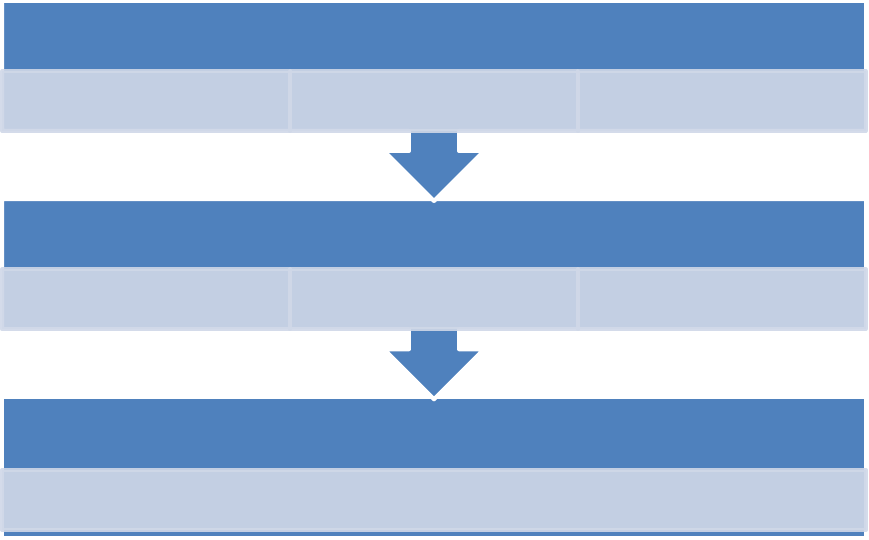
129
discussed in Section 5.6. After reporting and analysing the results in Section 5.7, the
conclusions are drawn in Section 5.8.
5.2 Methodology
5.2.1 Experimental design
As presented in Figure 36 below, three groups of students received differing pedagogical
treatment. In addition to an experimental group (given extra instruction and corrections in
article use), responses to the same essays were taken from a group given extra error-corrections
and a control group that had no extra attention focused on English article use. The first data
collection was in week 1 of the Presessional (before teaching/correction began), the second
essay was submitted at the end of the extra attention focussed on articles in two groups (week
8) and finally six weeks after extra teaching/corrections ceased (week 14).
Figure 36: Three group experimental design
Data taken pre-treatment (week 1), week 8 and week 14
Analysis
Weeks 1 - 7: Three groups have different treatment
Teaching/correction Corrections only No increased attention
Recruitment
Experimental group Error-corrected group Control group

130
5.2.2 Data
As discussed in Section 1.2.2, in the UK a great deal of EAP teaching activity takes place each
summer on ‘presessional’ programmes which allow students who have not reached English
proficiency entry requirements to enter their university, without retaking an English language
test course, upon satisfactory completion of the programme. The next section will provide
details about this programme to contextualise the experimental study.
The Business Management English Presessional Programme
The intensive summer presessional programmes at the University of Birmingham are divided
into four strands: foundation, undergraduate, the Business Management English (BME)
programme and a more general postgraduate EAP programme (for all other disciplines in
which students are not streamed into more specific discipline-related classes until the 10-week
stage). Students can select from a range of presessional course durations, depending on their
English proficiency and their programme entry requirements: 42-week, 31-week, 20-week, 15-
week, 10-week or 6-week courses. The data in this study is taken from presessional students
on the 15-week BME programme, a large English for Academic Purposes Presessional
programme for future Business School postgraduate students that runs each summer at the
University of Birmingham. At the time of this study, the BME 15-week Presessional ran six
classes with between 11 and 12 students in each class and the researcher was teaching one
class.
The BME was chosen for three reasons as follows: 1) convenience of sampling (the researcher
taught regularly on the BME programme); 2) Business subjects are the most popular subject
among Chinese students studying in the UK (The Higher Education Statistics Agency, 2019);
and 3) the BME allowed for the tightest control of variables.
131
BME students in 2010 were predominantly from China (and Taiwan), in addition to a much
smaller number of other nationalities (Thai and Arabic L1 backgrounds). The students in this
study were all preparing to study on one of four main Business School postgraduate
programmes: MSc Marketing, MSc Business and Management, MSc Accounting and Finance
or MSc Marketing communication.
The officially published range of levels of students admitted to the programme ranged from
low B2 to middle B2 level English proficiency on the CEFR framework. However, some
students were accepted with 4.5 IELTS writing level (B1 writing level) on the basis of their
overall IELTS 5.0 band in all four IELTS tests, which means students who presented as high
B1/low B2 borderline were also accepted on the presessional (but excluded from this study).
The entrance requirements and eventual pass mark for students on the BME reflected the three
levels of entry to the university’s Business school (ranging from an overall IELTS score of 6.0
to a requirement of 7.0). Most Business programmes at the time of the study required an
IELTS entrance level of 6.5 overall, so the overwhelming majority of the 15-week programme
students entered with an IELTS score of either a 5.5 or 6.0. The 15-week programme attracted
no students with a 6.5 IELTS score or above because such students were accepted onto the 10-
week programme no matter the department.
In addition to IELTS grades, a writing test on entry was used to identify the students who might
be in most need of language support as the course progressed. This assessment comprised of
a 300-word essay completed in 30 minutes, marked by two programme coordinators using the
same BME criteria used for assessing the end of programme exam. The writing criteria were

132
designed to mirror IELTS criteria because all students were measured against IELTS
equivalents by the end of the presessional. Marks were allocated as percentage scores and a
mark of 55 was equivalent to IELTS 5.5 and a grade of 60 to IELTS 6.0.
Participants
Given the potential challenges of analysing grammatical errors of students below an IELTS
5.5 level of proficiency data was collected only from students with at least 5.5 IELTS overall
scores and no less than IELTS 5.0 in writing. Since the lowest scoring presessional students
had all been grouped into three lower level classes, this was achieved by recruiting participants
for the study only from the three higher groups. Twenty-four of the twenty-nine Chinese L1
students in these three classes consented to participate in the research.
As shown in Table 8, 15 participants were Chinese and nine were from Taipei/Taiwan, but all
declared Mandarin to be their first language. The ages of the students ranged from 22 to 31,
with an average English learning history of eight years (in their home countries). No student
had been in the UK for more than three months; 22 students had arrived in the UK the day
before starting the programme while two students had been studying in the UK for 5-10 weeks
on a previous presessional programme before joining the 15-week cohort. No students had
lived in the UK or other English-speaking country for extended periods prior to arrival. All of
the teaching groups also included other nationalities and several Chinese students who refused
to give consent, but these are not referred to further in this study.

133
Table 8: Participant information
Control group
Error-corrected
group
Experimental
taught group
Summary
Age
22-25
23-31
23-26
Median: 23
Male
Female
1
7
4
4
3
5
Male 8
Female 16
Chinese
Taiwanese
4
4
6
2
5
3
15 Chinese
9 Taiwanese
IELTs level 5.5
6.0
4
4
6
2
6
2
16 IELTS 5.5
8 IELTS 6.0
BME entrance
writing test score
Range: 56-61
Median: 57
AD= 1
Range: 53 -59
Median: 5.5
AD= 1
Range: 56-61
Median: 57
AD= 2
Mean:56.8
SD 2.158
Length in the UK
or English L1
countries at entry
7 students under 1
month. 1 student
under 3 months
All students under 1
month
Seven students
under 1 month, one
student under 2
months
No students over 3
months in the UK
English L2 proficiency level
Another reason for choosing the 15-week BME programme students was their narrow range of
proficiency levels, allowing this study to report findings based on a more homogeneous
proficiency level, with a smaller range of levels than those seen in studies such as Díez-
Bedmar & Papp’s (2008) in which participants had proficiency levels reported on a far wider

134
spectrum (IELTS 4.5 to IELTS 7.00 levels). Sixteen participants in this study had achieved (in
the previous two years) a 5.5 band score in IELTS tests while 8 students had achieved an overall
IELTS score of 6.0. However, as two students had studied five weeks of English immediately
before joining the 15-week presessional, the written placement test was used as the preferred
measure of written English proficiency. As mentioned, this test used marking criteria based on
IELTS bands and the two examiners of this placement were highly trained (both had been
IELTS and Cambridge examiners) and had undergone intense standardization.
The scores in the placement test across the groups ranged from 52 to 61 with a median score
of 57, and a variance of 4.3/standard deviation of 2.08 (see Figure 93, p.341 in Appendix 10
for further information). Non-parametric tests were applied to the data given the small sample
size and slight skew. At the time of this study on the BME programme, all students scoring 54
or under were offered extra 1:1 language support tutorials and were generally put into
separately streamed groups. Although there was some marginal variance in students’ writing
proficiency within and across groups, with one student scoring an IELTS 5.0 borderline grade
of 52, these placement test scores showed there were no significant differences in writing
ability by group on entry as shown by an independent samples Kruskal-Wallis Test (n=24, H
(2) =2.143, p = .284) at the .050 level of significance (hence P ≤ 0.05).
5.2.3 Data sample
As discussed in Chapter 3, choosing a learner corpus data source is always a balance between
the competing demands of authenticity and variable control. The main BME 3,000 word project
writing assessment was not chosen as a data source because the topic was selected by each
student individually. Although this data would have provided rich insights into the authentic
contexts causing challenges for article use to Business School students, comparisons between
students and groups would have been meaningless. One solution might have been to use the
135
placement test responses or set another short IELTS type 250-word essay in controlled
conditions but, as outlined in Chapter 3, such task prompts are arguably less realistic and limit
the inferences that can be made about performance in academic writing. The study therefore
needed to collect more valid representations of academic work which required the use and
synthesis of sources and more developed academic argument (with examples and citations).
On the other hand, the tasks could not overburden the students while they worked on their
writing project and other case study assessments, so minimum words counts were kept realistic
(although students were allowed to go over the suggested word limit without penalty).
The three essay prompts used are summarised in Table 9 overleaf. In total, 27,940 words were
collected for analysis. The prompts followed the weekly topics studied on the BME each week.
The topic of week 1 was leadership and motivation, weeks seven and eight reviewed topics of
marketing and accountancy and the students had read several case studies about loyalty
schemes and brand management in the weeks preceding the final week 14 task. The growing
demands of the tasks set reflect the growing skills that could be demanded of novice academic
writers. The course introduced referencing and the paraphrase of sources from week 1, but in
Task 1 it was decided to require only 350 to 400 words and general reference to the theories
they had studied (with or without citations). As can be seen from Table 8, this prompt gave the
students a somewhat familiar argumentative question type which they would have presumably
have faced in IELTS exams. Later in the course (for Tasks 2 and 3), however, students were
asked to write more critically and provide greater references to the literature.

136
Table 9: Essay prompts
Rubric
Texts
Total
number
of words
Minimum and
Maximum
lengths and
Median word
length
Task 1
(week 1)
Does fear motivate employees to work harder?
Illustrate your ideas with reference to theories
of motivation studied on the course. (350 - 400
words)
24
9030
Minimum: 302
Maximum: 440
Mean: 376.3
words
Task 2
(week 8)
An effective marketing strategy is crucial to the
success of a business. Critically assess the value
of segmenting, targeting and positioning as a
marketing tool. Illustrate your answer with
suitable examples. (400-600 words)
*option for the three accountancy students:
Summarise the responsibilities of accountants
and discuss how they can contribute to efficient
information flow both within and outside
business organizations.
24
11383
Minimum: 474
Maximum: 605
Median: 474.3
words
Task 3
(week 14)
Retailers compete for customer loyalty and
retention in many ways.
Examine the issues, illustrate with examples and
suggest ways in which retailers can promote
loyalty and retention. (400-600 words)
16
7527
Minimum: 403
Maximum: 667
Mean: 470.4
words
In each of the groups there was a student progressing to an accounting and finance course.
Therefore, these three students were allowed to do an alternative essay title relating to
137
accounting in week 8. Since the aim of the research was to measure the comparative progress
of the groups and since there was one accountancy student in each group, this did not
dramatically affect the homogeneity of task type. A further complication was that one student
was automatically referred to a language support tutor because of his low score in the writing
test, and another student was referred to a tutor due to her lack of confidence in speaking. To
avoid external influences on English article accuracy in the study, the two language support
tutors agreed not to pay any particular attention to the subject of English articles in any of their
1:1 sessions.
Despite these efforts to control the teaching input around article use, it could be argued that the
homework nature of the tasks make the essay responses less reliable than studies which went
to greater lengths to control the environment, i.e. the opportunity for external help and time
spent on tasks (Bitchener & Knoch, 2009). However, as concluded in Chapter 3, such
controlled conditions do not accurately reflect the process of academic writing in the real
world: students make many careless mistakes under time pressure and the planning/drafting/
proofing stages allowed in this study are more characteristic of academic writing. In short, lack
of control is acknowledged as a limitation, but the greater validity is considered to have
outbalanced this risk. Moreover, while all essays were written for homework with full access
to spell check/word-processing tools (and no control to stop third party help), it should be
stressed that these tasks were not ‘high stakes’. Students therefore had little reason to use essay
mill services or proof-readers. Furthermore, while the students theoretically had access to
electronic tools at home, the use of electronic technology to aid writing accuracy was less
advanced when this data was collected in 2010.
In fact, at the time of this data collection (2010), most students were using very basic word-
processing software. The University of Birmingham did not make a licensed version of Word
138
for windows available to students until 2012 and even the most up-to-date word-processor
packages with fully updated English language settings (which few students had at this time)
rarely corrected article errors. In addition, while today’s standard of technological tools are
clearly influencing the language accuracy of student work, it should be noted that in 2010 the
students did not have modern translation software of today’s standard or grammatical proof-
reading tools such as Grammarly.
5.2.4 The BME course content
The students on the Business Management English programme were chosen because they had
the most tightly prescribed teaching scheme of work (i.e. teachers had very little choice about
each day’s lesson materials). While this course cannot be defined as an ‘English for Special
Purposes’ course because of the broad range of disciplines studied at the Business School, it is
far more specialised than many other UK programmes which focus on more generic EAP
topics. With regards to this study the specialised nature of the BME meant that the student data
provides rich insights into the writing errors made by novice academic writers with Chinese
L1 backgrounds writing in English on business related topics and genres for the first time. It
secondly allowed most variables, such as how articles were taught, to be controlled.
The three teachers (the researcher and two further tutors) were experienced teachers with
DELTA/TEFL Q level qualifications. All had over 5 years of EAP teaching experience and
previous BME teaching experience. The main text input on the BME course is a weekly
Business case study and the teaching timetable was in 2010 divided into six main skill areas:
academic writing, working with Business case studies, presentation skills, Business feasibility
study research skills, listening skills, and seminar skills. To an even greater extent than other
presessional programmes, there was little time in this highly intensive programme for
reviewing basic language concepts. Indeed, as shown in an audit of the programme’s main

139
materials presented in Table 10 below, there was little specific attention to article use in the
scheme of work beyond proofreading exercises. It was clear that teachers might make
reference to articles in nominalisation activities, but this was a teacher choice (and could be
influenced in this study).
Table 10: BME Teaching materials
Programme Materials
Coverage of English Articles
Working with Case Studies Materials
No mention
Academic Writing Materials
Only mention of article use in Proofreading exercise (see
Appendix 7: 323). The use of articles was not explicitly
mentioned in the sections on nominalisations or noun phrase
density.
Academic Reading Guide
No mention
Feasibility Study (extended writing)
Materials
No mention
Presentation and Seminar Skills Guide
One mention of definite article stress in a speaking pronunciation
exercise
The only marginal attention to articles demanded by the programme curriculum was therefore
in the proofreading activities which were normally covered towards the end of the course.
Admittedly, all the teachers in 2010 reported that they corrected article use in their student’s
writing on a regular basis. Moreover, there was nothing to stop teachers using their own
supplementary materials or discussing their use in ad hoc mini-teaching situations in response
to student queries. Such possibilities presented variables that needed to be addressed in the
context of this study and the following section explains how these variables were tightly
controlled.

140
5.2.5 Study procedures
The two teachers who participated in this study (in addition to the writer) agreed to limit how
they taught articles and to allow the recruitment of participants. Homework tasks were
normally at the discretion of each individual teacher, but these colleagues also agreed to make
a shared essay title mandatory for three weekly homework tasks.
Experimental taught group
The experimental group consisted of eight Mandarin L1 speakers. This class was the
researcher’s own class, already part of the course. Five supplementary thirty-minute English
article sessions were delivered in five extra sessions (given in hours outside their normal
teaching contact time) in weeks 2 -7, as shown in Table 11 overleaf. As can be seen, students
received both teaching and extra article corrections in their homework feedback. All teaching
and extra correction of articles ceased from week 7 in order to measure (in week 14) whether
improvements could be sustained when students’ consciousness about article errors was no
longer being raised (by Task three there had been no mention of articles in class for four weeks).
The decision to revise the students’ article use using the Bickerton Framework was made
because the students in the preliminary study had a) seemed familiar with the [+/-SR] concept
and b) had given good feedback about the whole system when presented.

141
Table 11: Five extra English article sessions
1. Session 1 (week 2)
Introduction and review of process of proofing
for article errors and typical errors to check.
Brief introduction to the Bickerton Framework
Students were also asked to read reference
materials for homework.
2. Session 2 (week 3)
Students asked to analyse definite article uses
in a text already analysed in class for meaning
(uses underlined). Students then presented
with the concepts of [+HK] [+SR] from
Bickerton Framework. Students were asked to
proof their week 1 essays and discuss errors
found in week 4.
3. Session 3 (week 4)
Review of homework, leading to analysis of
each other’s errors (teacher cut strips of paper
with examples from week 2 homework).
Further analysis of text from course materials
– further uses underlined and then matched
with concepts of [+HK] [+SR] and [-HK]
[+SR].
4. Session 4 (week 6)
Special attention to generic contexts [+HK] [-
SR] through the Bickerton Framework. First
through prototypical examples and then
through looking at list of errors made in the
class. Further reading and grammar exercises
set for homework (Swales and Feak, 2004, p.
395-402, Tasks 2 & 3).
5. Session 5 (week 7)
Review of homework. Review of article errors
related to proper nouns and idioms.
6. Participants invited to voluntarily take
part in six follow-up post-study one-to-
one sessions.
In the term following the presessional, three
volunteers for the post-study sessions had
various article uses underlined. They were
then asked if they were correct/an error or a
mistake. The teacher and participant then
discussed the reasons for errors.
142
5.2.6 Written article correction group
The article-corrected group consisted of eight Mandarin L1 students. This group received no
formal teaching of article use but did have all their article errors corrected. Students in this
group attended an extra session with the researcher in week 3 where the importance of
correcting work for article errors was stressed and useful proofing strategies were revised. In
addition, by prior agreement with the teacher of this group, extra emphasis was placed on the
written correction of article errors (i.e. written article errors were simply underlined without
explanation at least once a week between week 4 and week 8). Corrections were paper based
(not electronic versions). The students did not have to re-write the sentences. No article
grammar instruction was given except a very brief recap of the article system in week 1. Error
correction stopped in week 8.
The teacher of this group had over seven years’ experience teaching EAP and three years’
experience teaching the Business Management English course. She reported that her normal
approach to correcting article errors was contingent on the length of EAP course, the number
of article errors (and students’ other grammatical errors), gravity of error and the purpose of
the writing task. However, for the duration of this study she agreed to provide written error
corrections for all article errors in her students’ writing for four weeks. The teacher described
her normal approach to teaching articles, if she had not taken part in this study, as ‘ad hoc’.
She did not normally devote a formal teaching session to their use because of the time pressures
of the course. However, in normal teaching conditions she reported that she would revise article
use if opportunities presented themselves more spontaneously in the classroom. She reported
that she most frequently reviewed them in previous years in tutorials if students had questions
(if they wanted to discuss their feedback). However, for the purposes for this study she agreed
143
to avoid teaching articles in the classroom and tutorials beyond the clarification ‘you have made
an error with the article’ if students wanted to discuss their homework feedback in tutorials.
5.2.7 Control group (1)
Control group 1 consisted of eight Mandarin L1 speakers. Overall, this group’s IELTS grades
were marginally higher than the other two groups at the start of the course, but this was mostly
due to the students’ speaking scores. More students in the control group (4) had higher IELTS
6.0 writing scores than in other groups (2), but their BME writing entry test scores were almost
identical to the other group ranges. No extra article teaching or written corrective feedback for
articles was given to this control group over and above the first page of the draft of one high
stakes assignment in week 9 (as per the teacher’s normal practice).
This teacher of this group reported that, apart from occasional ad-hoc clarifications, she would
normally refer to article use only in week 12 of the course (when she completed the end of
course proofreading activities). With regards to corrections, this teacher reported that when she
started her career in teaching, she had ‘overcorrected’ all errors, but now seldom corrected
article errors in homework feedback. She also gave students a lot of proofreading help at the
end of course when students submitted their extended writing projects and essays. However,
this was not a problem for the purposes of this study and she readily agreed to not correct or
teach article use in the time periods agreed.
5.3 Ethical issues
As discussed in Chapter 3 (Section 3.7), the Ethics Board had stressed the importance of not
disadvantaging students from not participating in the study, allowing for informed consent and
reporting back any beneficial findings to students in their responses to initial ethical review

144
applications (ERN_10-0375 amended 14-0375). This section will examine how the agreed
ethical safeguards were enacted in the main study.
Consent
Students were given an information sheet on the 2
nd
day of induction and at least 24 hours to
read some information about the study (see Appendix 4). The researcher then visited
classrooms to orally present the study’s objectives. It was explained that students could receive
the same extra resources at the end of the study even if they did not choose to participate.
Students were then given a further 24 hours to reflect and were asked to bring their forms in
for their class teacher (signed or unsigned) the next day.
Information given to participants
Students were given full information about the research, but only informed of their group after
agreeing to take part in the study. They were reminded at this point that they could still
withdraw their consent.
Sharing of results with participants
The Ethics Board insisted on a workshop in week 14 at which point some of the researcher’s
preliminary findings (common errors identified) were presented to anyone on the BME who
wished to attend regardless of whether they had taken part in the study. At this lunchtime
session a worksheet about article use (see Appendix 5) was also shared with attendees.
Participants were sent a conference paper published on the university website that summarised
the study findings six months after the study.
Participant feedback
To check students had benefitted from participating in the study, all students were asked to
complete an end-of-study feedback form in week 14 (see Appendix 6).
145
5.4 Constraints of the study
As planned, at the end of the ‘intervention’ in week 8, in which one group was explicitly taught
article use rules and a further ‘correction’ group had all their article errors underlined, all
experimental pedagogical treatments ceased (students were not taught the article system and
no extra emphasis was placed on the correction of errors). After a six week period in which
students could ‘forget’ the study, a third essay was then set in week 14 in order to investigate
whether any learning was sustained. Unfortunately, due to a misunderstanding (the teacher set
a different essay for homework), it was not possible to collect a third third essays from one of
the control groups (the impact of this issue is discussed in Section 5.7.6).
5.5 Data analysis
For consistency in the distinction between head nouns and any nouns used as modifiers, head
noun phrases were extracted from the corpora automatically using a Java programme
developed by Oliver Mason at the University of Birmingham. Errors were then identified
manually by the researcher and tagged using macros in word (before conversion to text format).
In this study, every single head noun phrase was tagged for whether the it had a correct article,
an incorrect article or an alternative determiner.
5.5.1 Tagging system
The word macros were developed following the tagging system (see Table 12 and Table 13)
presented by Díez-Bedmar & Papp (2008) and many replicated studies (Díez-Bedmar, 2015;
Crosthwaite, 2016a) based on the Bickerton Framework as outlined in 2.2.1.
Following Ekiert (2004), who argued that articles for idiomatic and other conventional uses
are very different to other referential and generic uses, all fixed academic expressions and
articles used with proper nouns were denoted as a ‘Type 5’ error. Type 6 contexts (other
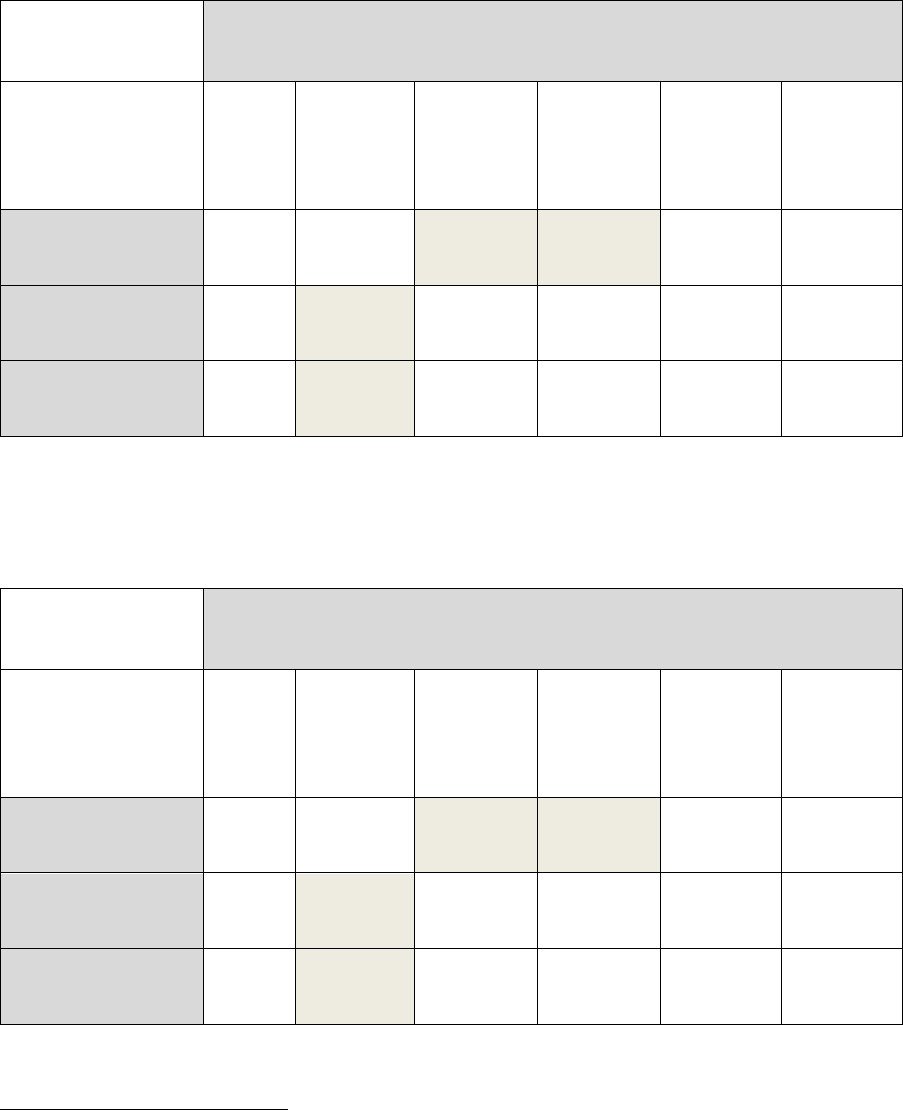
146
determiners used) will also be examined in the next chapter, when the underuse or overuse of
articles is discussed as compared to L1 use.
Table 12: Tagging system for correct uses (Díez-Bedmar & Papp, 2008)
2
Determiner used by the learner
Generic
Referential
Definite
Referential
Indefinite
Non-
referential
Idiomatic
use or
proper noun
Other
determiner
Definite article
1DA
2DA
5DA
6
Indefinite article
IIA
3IA
4IA
5IA
6
Ø articles
1ZA
3ZA
4ZA
5ZA
6
Table 13: Tagging system for incorrect uses (Díez-Bedmar & Papp, 2008)
2
Determiner used by the learner
Generic
Referential
Definite
Referential
Indefinite
Non-
referential
Idiomatic
use or
proper noun
Other
determiner
Definite article
1GADA
2GADA
5GADA
6
Indefinite article
IGAIA
3GAIA
4GAIA
5GAIA
6
Ø articles
1GAZA
3GAZA
4GAZA
5GAZA
6
2
Based on Bickerton (1981) and adapted by Thomas (1989) and then Díez-Bedmar & Papp (2008)

147
In addition to the tagging of the extracted noun phrases, the student data was also tagged with
‘^’ omission error and ‘$’ oversuppliance annotations. Misuse article errors (a/an errors, the
for a/an, a/an for the) were also annotated with a ‘$^’ code. 5383 noun phrases were inputted
onto a spreadsheet as the researcher annotated each text. In order to check for data entry error,
the data was later checked by running frequency counts on each text using a concordancer to
check the entries, and spreadsheet tallies were recorded.
5.5.2 Pica’s Target-Like Use
Following other researchers (Pica, 1983; Lu, 2001; Díez-Bedmar & Papp, 2008; Díez-Bedmar,
2015; Crosthwaite, 2016a) the study used a ratio measure that allowed for comparison of
accuracy across different text lengths and comparisons with other studies. Across the literature,
this equation is called either Pica’s (1983) coefficient of ‘Target-Like Use’ or ‘Target
Language Use’ (TLU):
𝑇𝐿𝑈 =
𝑛. 𝑐𝑜𝑟𝑟𝑒𝑐𝑡 𝑠𝑢𝑝𝑝𝑙𝑖𝑎𝑛𝑐𝑒 𝑖𝑛 𝑜𝑏𝑙𝑖𝑔𝑎𝑡𝑜𝑟𝑦 𝑐𝑜𝑛𝑡𝑒𝑥𝑡𝑠
(
𝑛. 𝑜𝑏𝑙𝑖𝑔𝑎𝑡𝑜𝑟𝑦 𝑐𝑜𝑛𝑡𝑒𝑥𝑡
)
+ (𝑛. 𝑠𝑢𝑝𝑝𝑙𝑖𝑒𝑑 𝑖𝑛 𝑛𝑜𝑛 − 𝑜𝑏𝑙𝑖𝑔𝑎𝑡𝑜𝑟𝑦 𝑐𝑜𝑛𝑡𝑒𝑥𝑡𝑠)
5.5.3 Chosen notions of grammaticality and acceptability
As highlighted in the preliminary study, it was important to establish a clear policy regarding
ambiguous grammar and the line between acceptable informal tone and inappropriate register.
The researcher was interested in overspecification, but the preliminary study had shown the
issue often caused disagreement among researchers (i.e. about whether a redundant definite
article was simply ‘marked’ or completely inappropriate). As the reliability checkers (see 5.6)
would need to know these policies, many examples were given in training and standardisation.
Figure 37 shows an extract from the training material that helped standardise this approach.

148
Instructions for annotators
Please mark noun phrases as incorrect <GA> only if they were impossible to accept as
grammatical or completely inappropriate in the academic style of the assignment task.
You are asked to ignore cases where the ambiguous meaning makes a judgement about article
choice impossible.
Omission errors
If a bare noun phrase could have been corrected by either plural form or an article with the
singular form, mark as incorrect (add “^” before noun and <GA> to tag).
Overspecification errors
There will be occasions when the appropriacy of the definite article will create an effect on
register and a judgement will be required about whether the effect is marked but appropriate
for the assignment task set or completely inappropriate (and therefore incorrect). If in any
doubt, please ignore only slightly ‘marked’ uses. For instance, in example 1 below the use of
the is used when many native speakers would have discussed a general statement with a bare
noun in plural form without article. However, as this student has referred to a ‘target market’,
this article could arguably be used as an inexplicit referential to this market and its consumers.
However, please mark as incorrect any overspecification of definite article when no inexplicit
reference can be reasonably inferred or when such reference creates a tone that would be
completely inappropriate for a Business Studies journal article (see example 2). Many
examples will be shown during training to standardise our approach.
(1): In a target market, brand image is very important for the consumers. (acceptable)
(2): For example, the young generation likes to follow $the new trendy stuff.
(unacceptable)
Figure 37: Policy of tagging for correctness

149
5.5.4 The issue of competence and performance errors
As explained in Section 5.2.3, the methods used ensured that most errors can be assumed to be
valid competence errors. Students were trained in how to proof their work and use Microsoft
Word for Windows to spell-check and grammar-check their work. The use of homework
assignments in a relatively ‘high stakes’ presessional course (the students could not enter their
Masters degree programme without success on the course) to some extent assured a level of
student motivation in the tasks.
5.5.5 The issue of final -s errors
The examples below show how singular count nouns (market, strategy, card) could have been
rendered correct either by adding a determiner before the noun or a plural final –s at the end
of the noun to make the count noun plural. In some cases it was completely unclear which
error was more likely.
[1 ] *Segmentation includes diverse points, mainly can separate into three aspects
which are ^ consumer market, business market and segmenting international marketing.
[ 2] * It refers to the process of dividing ^ whole market into smaller segments, targeting
one or certain segments to enter, and establishing a superior position in customers’
mind.
[3] *Organisations should select their professional field and facility compare with
competitors in a particular market, and select ^ concentration strategy or multisegment
strategy.
[4] *…^ Loyalty card is a common method to attract customers to go to the shops
Figure 38: Example 1: Identification of error problems

150
It could be argued that the parallel structures in [1] and [3] and the conjugation of the verb in
[4] display a motivation of the student to use a count noun in singular form (and therefore not
a mistake in omitting the –s). Moreover, most noun phrases seemed to give such ‘clues’ as to
the students’ intention. However, given that the homework tasks were word-processed, all
annotators were instructed to treat all such cases as errors (assuming that students had proofed
the work carefully using their word processors). With this training, all raters annotated the
above examples above as ‘incorrect use of English article or determiner’ with complete
agreement.
5.5.6 Straightforward cases
In fact, the majority of noun phrases appeared relatively straightforward to annotate as ‘correct’
or ‘incorrect’, particularly with regards to the omission of definite articles as shown below.
Errors [1] to [3] in Figure 39 below show examples of overt errors. These three noun phrases,
judged to be incorrect by the main researcher, were later verified during inter-rater reliability
tests when three further human raters independently annotated them as incorrect on two
separate sessions.
[1]* In ^ short time, it could increase customer turnover, but it is useless to attract
high-income customers.
[2]* Indeed, ^ business environment is complex.
[3] * Therefore, it would be hard-pressed to imagine that how these employees coud
work effectively in ^ a long term.
Figure 39: Example 2: Overt errors
151
5.6 Tagging reliability checks and inter-rater reliability checks
Reliability of the tagging was checked by the researcher and then by two L1 English EAP
teachers (DELTA Level qualified, with Masters in TESOL/Applied Linguistics). Three Task 1
responses, three Task 2 responses and two Task 3 responses were randomly selected and
checked by the two teachers. As discussed in the preliminary study, the approach taken to
annotation checking was text-based with annotators asked to check the whole text, since earlier
attempts to check the tagging at the sentence level had produced unsatisfactory results (with
teachers unable to understand the context of the sentences).
Before checking the text annotations, the teachers were given thorough training (prior reading
and a one-hour training workshop). As highlighted in the preliminary study, it was anticipated
that the parts of the framework most difficult to apply consistently to Academic English would
be 1) Generic use (and its distinction from non-referential uses) and 2) the difference between
Type 3 (indefinite) and Type 4 (non-referential uses). A further extract from the training
materials in Figure 40 shows how annotators were trained to use context and apply the
framework consistently. After going through some examples in the workshops, the annotators
standardised further by annotating one example text and comparing decisions.
Annotators were given the texts printed on paper in their entirety so that they could check the
context of each noun phrase context. The eight randomly selected texts gave a total number of
745 noun phrases which accounts for over 10% of the total dataset. Analysed with the Fleiss
Kappa inter-rater correlation formula (Fleiss, 1981), in order to account for chance agreement,
the pairwise agreement of 90.25% gave a coefficient of 0.87, showing strong reliability. This
shows that the text-based checking, training and standardization combined to give confidence
to the initial rater’s judgements.

152
Policy for difficult cases in the Bickerton Framework
On occasion, as shown in the example below, you may find it hard to make judgements between
a generic Type 1 context and a non-referential Type 4 context. For example:
A loyalty system helps keep loyal customers.
In this study please tag the above example as generic only if it occurred in the introduction of
an essay, particularly if the writer was defining their terms. If the example appeared in the later
body of the essay and was clearly not a known referent (but rather an unreal prototypical
example), as shown in the example below, please tag as a type 4 context. For example:
Many companies have not considered the best method of maintaining brand fidelity.
<4IA> A loyalty system could help keep loyal customers.
Decisions about whether a context is indefinite (Type 3) or non-referential (Type 4) also require
careful examination of context. The following examples suggest an approach to this sort of
decision:
Example out of context:
Marketing strategies are vital to companies which want to find a successful way to
increase their market share.
In this case, the distinction must be made by reviewing the position in the text and carefully
interpreting the context. If the context of this example was within a paragraph which had
mentioned specific referents, this example would be interpreted as an indefinite Type 3 context,
as shown in example below.
<3ZA> Cosmetics companies in Europe such as Unilever are spending increasing sums
on marketing consultants. <3ZA> Marketing strategies are vital to companies
which want to find <3IA> a successful way to increase their market share.
However, many examples you will find in academic essays relate to hypothetical non-specific
referents, as shown in the example below, in which it clear from the wider paragraph context
that the student is theorising about an imaginary company. In cases of ambiguity, you are asked
to select the same context type as the surrounding paragraph context.
If a company does not have <4IA> a clear marketing strategy, its managers will make
inconsistent decisions about pricing and promotion. <4ZA>Marketing strategies are
vital to companies which want to find <4IA> a successful way to increase their market
share.
Figure 40: Example 2 from annotator instruction materials

153
5.6.1 Dealing with disagreements in the sample checked
While there was general agreement about most annotation decisions, the three raters met to
discuss the tagging which was disagreed. Any tags that could not be quickly agreed
unanimously were then discarded from the dataset.
On decisions of accuracy (about which there were very few disagreements), the disputes mainly
arose in questions of overspecification and were most difficult to resolve when there was
ambiguity about the meaning due to ungrammaticality of the sentence. Errors [1] and [2] in
Figure 41 below show the challenge annotators faced in these situations (both annotations were
removed from the data).
[1] People prefer works in <$ overspecification?> the happiness environment.
[2] * After <$ overspecification?> the spending in the education of customers, if they
could not be maintain, that is a waste of money .
Figure 41: Oversuppiance issue disagreements
Disagreements about whether overspecification of definite articles caused inappropriate
informality for the genre were not as frequent as had been expected. Figure 42 shows two
cases of where raters could not agree about the ‘conversational tone’ created by definite
articles.
[1] *Trust is an important driver while considering how to retain $the existing
customers.
[2] *To sum up, under $the pressure from big supermarkets, it is necessary for retailers
to seek for a reasonable way to attract more loyal consumers .
Figure 42: Appropriacy for genre disagreements
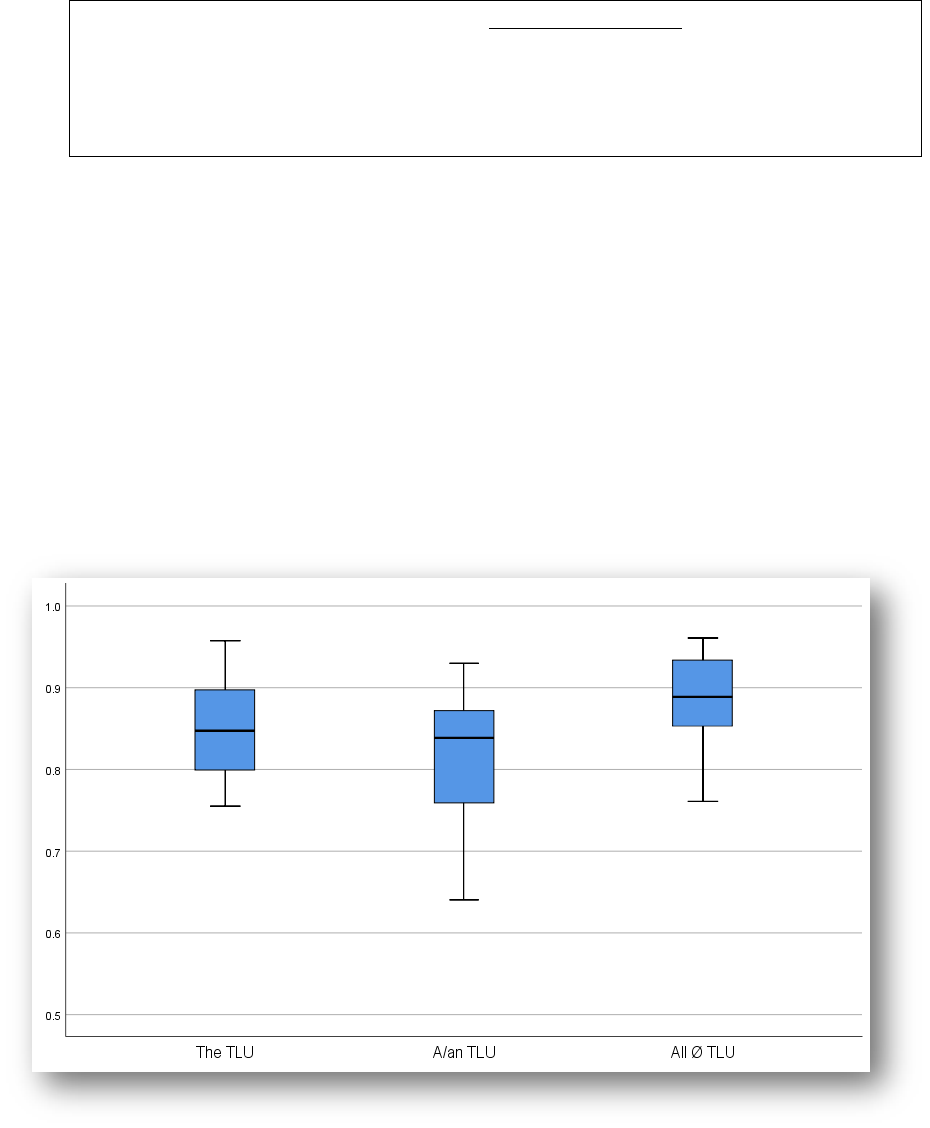
154
In terms of the tagging system itself, the main cause of annotators’ disagreement was in issues
of uses of a/an and whether to tag them as Type 3 indefinites or Type 4 non-referentials. Figure
43 gives two examples of such issues.
[1] * In order to create <3IA or 4IA?> a close relationship with customers, many
companies differentiate their products from other competitors .
[2] *Every company has different kinds of organization structure, but the accounting
department is <3IA or 4IA?> an essential part of <3IA or 4IA?> a company.
Figure 43: Disagreements about whether Type 3 or Type 4
5.7 Results and discussion
After annotating the noun phrases with the 22 framework tags the TLU for each student’s
response in each essay Task was calculated. Following Crosthwaite (2016a), the median value
and median absolute deviations of these TLU values are reported in this thesis, rather than
mean and standard deviations. As can be seen, Figure 44 below summarises the median TLU
Figure 44: Box plot showing distributions of median TLU scores (n=24)

155
values of the three article types across all three Tasks. The distribution of a/an TLU values was
less normally distributed than the and Ø TLU values. Given the small sample sizes and the
slight skew of the distributions, the data was statistically analysed with non-parametric tests.
Table 14 and Table 15 summarise the median values and median absolute deviations (MAD)
for each article context in each Task across all groups. One issue confronted during the data
analysis was the treatment of zero counts. For example, 11 of the 24 participants made no use
of Type 1 generic a/an (1IA), so the TLU is shown as 0.00. The use of the median value of the
24 participants may therefore underrepresent the accuracy of those that used this article.
Table 14: TLU ratings for all groups summarised (n=24) with no adjustment
Task 1
IDA
11A
1ZA
2DA
3IA
3ZA
4IA
4ZA
5DA
5IA
5ZA
Median
0.25
0.00
0.75
0.85
0.75
0.50
0.83
0.92
0.80
0.00
1.00
MAD
0.25
0.00
0.25
0.10
0.25
0.50
0.17
0.05
0.20
0.00
0.00
Task 2
Median
0.73
0.71
0.87
0.88
0.89
0.80
0.88
0.96
0.84
0.00
0.97
MAD
0.27
0.29
0.13
0.05
0.11
0.09
0.13
0.04
0.16
0.00
0.03
Task 3
Median
0.75
1.00
0.86
0.83
0.94
0.85
0.71
0.94
0.78
0.25
1.00
MAD
0.25
0.00
0.13
0.09
0.06
0.15
0.21
0.04
0.22
0.25
0.00
On the one hand, the Target-Like Use measure is a robust equation and the literature shows
other researchers leaving these zero counts in the data. In fact, this may show avoidance of an

156
article (an issue that will be examined in the next chapter) and therefore a justifiable and
representative value. Moreover, this issue only affected the rarest article types (generic articles
and 5IA type contexts). On the other hand, with such small data sets and with rarer article uses,
a case could be made for the removal of these zero counts. The effect of this adjustment can
be quite dramatic, as can be seen in Table 15. This shows that removing all instances of zero
use from median calculations, the TLU for 1IA rises from 0.00 to 0.50. Even more dramatically
with the rarest form or article, the TLU for 5IA contexts (use of a/an with proper nouns and
fixed expressions) goes from 0.00 to 1.0.
Table 15: TLU ratings all groups (n=24) with adjustments* for zero counts
Task 1
IDA
11A
1ZA
2DA
3IA
3ZA
4IA
4ZA
5DA
5IA
5ZA
Median
*0.50
0.50
*0.86
0.85
0.75
0.50
0.83
0.92
*0.83
*1.00
1.00
MAD
*0.50
*0.50
*0.14
0.10
0.25
0.50
0.17
0.05
*0.17
0.00
0.00
Task 2
Median
*0.86
*0.88
*0.89
0.88
0.89
0.80
0.88
0.96
0.84
*1.00
0.97
MAD
*0.14
*0.13
*0.14
0.05
0.11
0.09
0.13
0.04
0.16
0.00
0.03
Task 3
Median
0.75
1.00
0.86
0.83
0.94
0.85
0.71
0.94
0.78
*1.00
1.00
MAD
0.25
0.00
0.13
0.09
0.06
0.15
0.21
0.04
0.22
*0.00
0.00
Nevertheless, this mostly affects only these two rarer contexts (1IA and 5IA). Thus, in order to
enable comparisons with other studies, the remainder of this thesis makes no adjustment for
these zero counts. Using the unadjusted values shown in Table 14, the remainder of this chapter
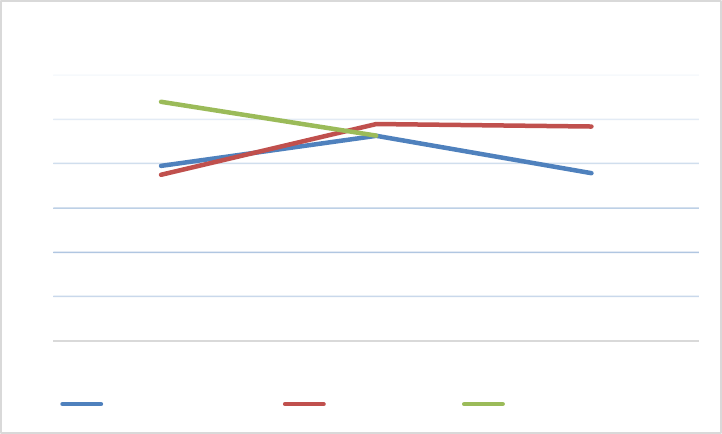
157
examines the quantitative effect of the teaching/error correction of articles. Comparisons with
L1 writers and comparison of TLU scores in other studies will be examined later in Chapter
6.
5.7.1 Improvements in accuracy of article use (pre-treatment to post-treatment)
Examining the summary data visually in Figure 45, Figure 46 and Figure 47 (before statistical
tests are presented in the next section), improvements can be seen in the TLU of all articles
(overall, all types) in the taught group and the error corrected group. Meanwhile, the control
group’s TLU figures started from a higher relative position but then fell for unknown reasons.
Figure 45: Target-Like Use of definite article (Type 1, 2 and 5 combined)
0.4
0.5
0.6
0.7
0.8
0.9
1
THE TLU essay 1 THE TLU essay 2 TLU The essay 3
Definite article TLU (all types)
Median taught group Error corrected Median control group
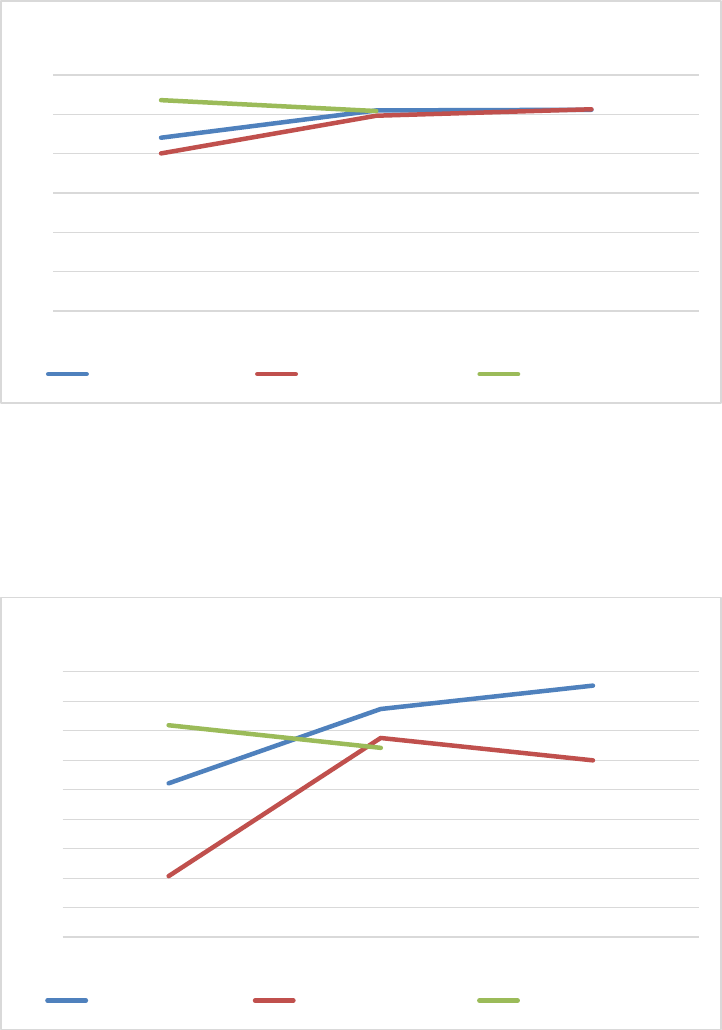
158
Figure 46: Target-Like Use of Ø (Types 1, 3, 4 and 5 combined)
Figure 47: Target-Like Use of a/an (Types 1, 3 and 5 combined)
The TLU in 2DA definite article contexts went up markedly between pre-treatment (Task 1)
and post-treatment (Task 2) in the taught and error-corrected groups, as shown in Figure 48
below.
0.4
0.5
0.6
0.7
0.8
0.9
1
1 2 3
Ø TLU (all types)
Median taught group Median error corrected Median control group
0.4
0.45
0.5
0.55
0.6
0.65
0.7
0.75
0.8
0.85
1 2 3
a/an TLU (all types)
Median taught group Median error corrected Median control group
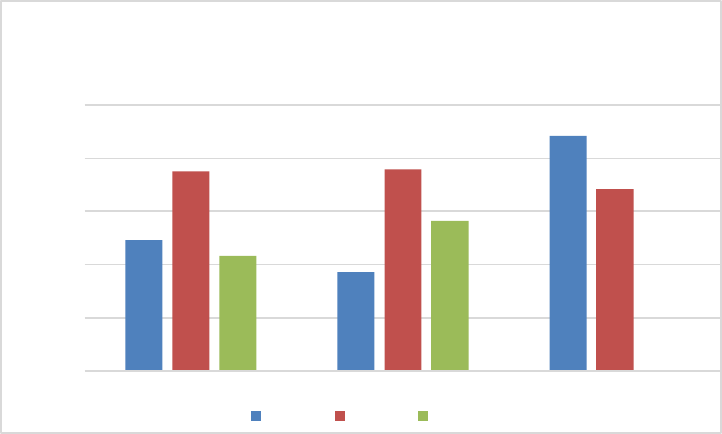
159
Figure 48: TLU of 2DA definite article (n=24, all participants by group)
5.7.2 Statistical tests: Progress in accuracy made by the taught group in Task 2
The 8 students in the experimental group demonstrated significantly greater accuracy in their
use of definite articles in Task 2 (following extra teaching and correction) than they showed in
Task 1. A Wilcoxon Signed Ranks Test indicated that the median post-treatment TLU (Task
2) of all definite articles combined (see Figure 48) in the experimental group, Mdn=0.86, was
statistically significantly (P ≤ 0.05) higher than the pre-treatment TLU of all uses of definite
article (in Task 1), Mdn=0.79, (Z=33, p =.036). The improvement in accuracy of all Ø articles,
from Mdn TLU 0.84 to 0.91 was also statistically significant (P ≤ 0.05) according to a
Wilcoxon Signed Rank Test (Z=36, p=.012). The same test also found significant
improvements in the 8 students’ article accuracy in 1IA contexts (Mdn TLU rising from 0 to
0.94, Z=27, p=.028), in 1ZA contexts (Mdn TLU rising from 0 to 0.92 (Z=28, p=.018), and
3ZA contexts (Mdn TLU rising from 0.63 to 0.8, Z=26, p=.043).
Table 16: on the next page presents all p values (asterisks* shows significant values).
0.7
0.75
0.8
0.85
0.9
0.95
Taught group Error corrected group Control group
TLU 2DA definite article
Essay 1 Essay 2 Essay 3

160
Table 16 Wilcoxon Signed Rank Test *=statistically significant at 0.05
Framework
Taught group
Error corrected group
Essay 1 v Essay 2
Essay 1 v Essay 3
Essay 1 v Essay 2
Essay 1 v Essay 3
1DA
0.779
0.746
0.233
0.750
1IA
0.028*
0.281
0.610
0.890
1ZA
0.018*
0.058
0.237
0.484
2DA
0.012*
0.161
0.028*
0.779
3IA
0.779
0.500
0.078
0.225
3ZA
0.043*
1.000
0.025*
0.093
4IA
0.161
0.575
0.310
0.499
4ZA
0.2068
0.401
0.161
0.575
5DA
0.933
0.090
0.778
1.000
5IA
1.000
1.000
0.591
0.552
5ZA
0.176
0.345
0.345
0.684
All the
0.036*
0.889
0.050*
0.779
All a/an
0.262
0.263
0.069
0.025*
All Ø
0.012*
0.161
0.012*
0.401

161
Looking in detail at the Bickerton contexts of use (see Table 16 on preceding page), many
article contexts showed no significant improvements between Task 1 and Task 2 in the
experimental group. Taking a statistically rationalist position that Type 2 errors can occur
through Bonferroni adjustments (Feise, 2002), no statistical controls for Type 1 errors were
applied. Given that multiple testing occurred, the P values in Table 15, particularly those at ≤
0.05 levels of significance, must therefore be treated with a degree of caution. On the one
hand, the improvement in 2DA context accuracy in the experimental group are significant with
or without correction at the ≤0.01 level, rising from Mdn TLU (n=8) 0.82 to 0.89 (Z=36,
p=.012). On the other hand, even at the ≤ 0.05 level of significance no improvement was found
in 1DA or 5DA, 3IA, 4IA, 5IA, or 5ZA contexts.
Progress in accuracy made by the error corrected group
The 8 students in the error-corrected group also displayed significantly higher accuracy in their
use of definite articles in Task 2 (having received extra correction) than in Task 1. A Wilcoxon
Signed Ranks Test indicated that the Task 2 post correction TLU (Mdn=0.89)) of all definite
articles combined (see Figure 48), were statistically significantly (P ≤ 0.05) higher than the
pre-corrections TLU (Mdn=0.78) in Task 1 (Z=32, p =.050). Again, statistically significant
improvements were also suggested by the same test of the TLU of all Ø articles, from Mdn
TLU 0.80 to 0.90 (Z=36, p= .012) The same test (P ≤ 0.05) showed statistically significant
improvements in Type 2DA definite articles (Mdn TLU rising from 0.76 to 0.89 (Z=27,
p=.028), and 3ZA (Mdn TLU increasing from 0.25 to 0.84, Z=34, p=.025).
The effect of group on progress
Without a control group, the case could be made that all progress of two experimental groups
was due to the task effect. Indeed, Crosthwaite (2017: 22) found even greater significant

162
improvements in error-corrected student writing, but concluded that the improvements were as
likely to be caused by choice of prompt topic and the use of word processors than by the
pedagogy:
Despite the overall finding that the number of errors dropped overall between data point
1 and data point 3, closer inspection reveals that any significant drop is likely to be
related to either the topic or conditions under which the writing was produced, rather
than any impact of the online materials taken, or the corrective feedback given to
students at DP1 or DP2
However, the use of a control group in this study for Task 1 and 2 (with the same topic) suggests
that topic was not the main effect of article accuracy between these two Tasks. The control
group completed the same two Task. On the one hand, this group admittedly started from a
higher accuracy level. On the other hand, their decline in the TLU of all definite articles was
found (from Mdn TLU 0.93 to 0.86) contrasts to the relative Mdn TLU rise in the experimental
group (from 0.79 to 0.86). The control group’s decline was mainly accounted for by a decline
in 2DA definite article TLU accuracy (from .92 to .82). Analysing the progress made by the
experimental and control groups, an independent Mann-Whitney U Test showed that the
difference in progress in TLU between the two groups of all definite articles (U=52, p=.005),
2DA(U=54, p=.021), and all Zero articles combined (Z=57.000, p=.007) was significant (P ≤
0.05).
Comparing the progress of the error-corrected group and the control group, again several
improvements in TLU were shown to be significant (P ≤ 0.05). The Mann-Whitney U Test
demonstrated that the Mdn 0.11 improvement in TLU of all definite articles combined,
observed in the error-corrected group, was significant (U=53, p=.038) when compared to the
lack of relative progress in the control group. Compared to the control group’s decline in
progress, the same test also found significant (P ≤ 0.05) progress (U=55, p=.015) in the error

163
corrected group’s progress in 2DA articles (rising by Mdn 0.06 TLU) and the Mdn 0.08 TLU
improvement in all Ø articles (U=60, p=.002).
As visualised in Figure 49 overleaf, if it is assumed that the variable of topic was having a
downward effect on accuracy and that no other variable affected performance, this finding of
improvement between 1
st
and 2
nd
Task would suggest that the two interventions (teaching and
error correction) impacted upon the observed increase in accuracy in some article contexts.
The progress made by all individuals in all three groups between Task 1 and Task 2 was
statistically analyzed by group and a Kruskal-Wallis Test showed highly significant (p ≤ 0.01)
differences in progress in Target-Like-Use of all Ø articles combined across all three groups
(H (2) =11.195, p= .004). Significant differences (p ≤ 0.05) in the progress made in definite
article 2DA contexts across groups were also suggested by the Kruskal-Wallis Test (H
(2)=7.595, p= .022). However, the differences between groups in overall definite article TLU
were not significant (H (2) =5.808, p=.055) at p ≤ 0.05. Moreover, the control group’s higher
initial accuracy is acknowledged as a limitation. In fact, the control group’s TLU remained
only marginally below those of other groups in Task 2. Caution must therefore be shown in
overinterpreting the progress made by the taught and corrected group.
Furthermore, it is also conceded that the impact of other variables, on the results reported here,
must be considered. The motivation with which students approached the tasks; the extent to
which they proofread their homework; the distractions of external factors; or even simple
tiredness could all have affected improvement (and lower accuracy in the control group).
Across the programme, perhaps the most likely extra unintended help students received before
Task 2 was the student exposure to a case study which had some examples of marketing (the
topic students addressed in the second prompt). On the one hand, the observed increases in
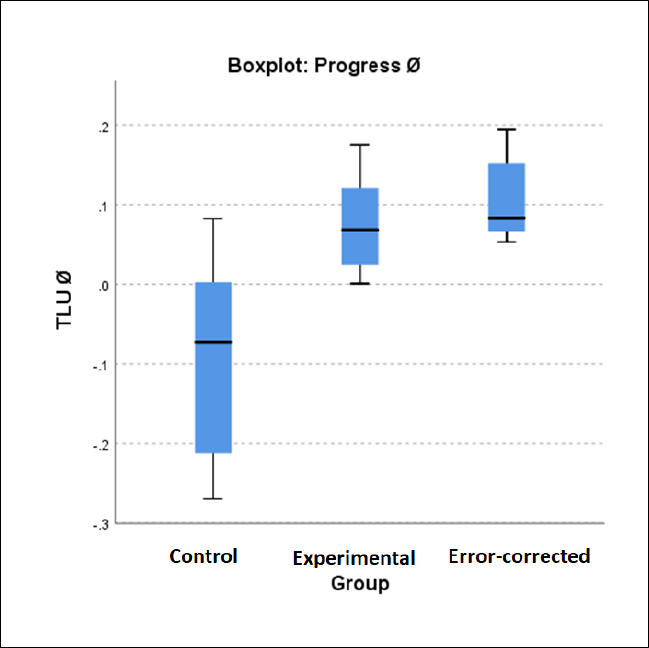
164
TLU scores in Task 2 could therefore have results from the fact that students were primed to
better understand the colligations and grammatical features of topic lexis. On the one hand, the
Figure 49: Progress by three groups (Mdn TLU of Ø) n=24
control group also studied this case study, yet did not demonstrate increased TLU scores. The
extent to which the control group teacher exploited this case study (as the researcher with the
taught class did) is not known. The likely combined effect of these multiple factors will be
further discussed in Chapter 6.
5.7.3 Analysis of differences between taught group and experimental group
While there were significant improvements in definite article TLU and Ø article TLU, no
significant differences were found between these improvements in the taught and error
corrected groups between Task 1 and Task 2 (P ≤ 0.05). A Mann-Whitney U Test
demonstrated that the Mdn 0.11 improvement in TLU of all definite articles combined,

165
observed in the error-corrected group, was not statistically significantly different to the Mdn
0.06 improvement in the taught group (U=36, p=.721). Equally, the 0.08 increase in target like
use of TLU of Ø in the control group between Task 1 and Task 2 was not significantly different
to the 0.07 increase observed in the taught group’s TLU (U= 42, p= .328).
5.7.4 Further analysis of definite article use
Further analysis shows that improvements in the TLU of Type 2 definite articles and all zero
articles could be accounted for by the lower counts of overspecification of definite articles in
Task 2. Table 17 compares the issue of omission and overspecification of the definite article
(Types 1, 2 and 5 combined) by presenting the median values of each group in all three tasks.
Table 17: Omission and Oversuppliance of definite articles (all types, Mdn coefficients*)
Task 1
Task 2
Task 3
Omission
Overspecification
Omission
Overspecification
Omission
Overspecification
Experimental
taught group
0.114
0.111
0.091
0.036
0.087
0.105
Error
correction
group
0.073
0.143
0.069
0.000
0.045
0.092
Control
group
0.045
0.049
0.099
0.081
*To adjust for response length and obligatory uses, the figures are provided by the following
coefficients:
Omission of THE coefficient = Omission in all contexts/accurate use in all contexts
Overspecification THE coefficient = oversupply in all contexts/accurate use + oversupply all contexts
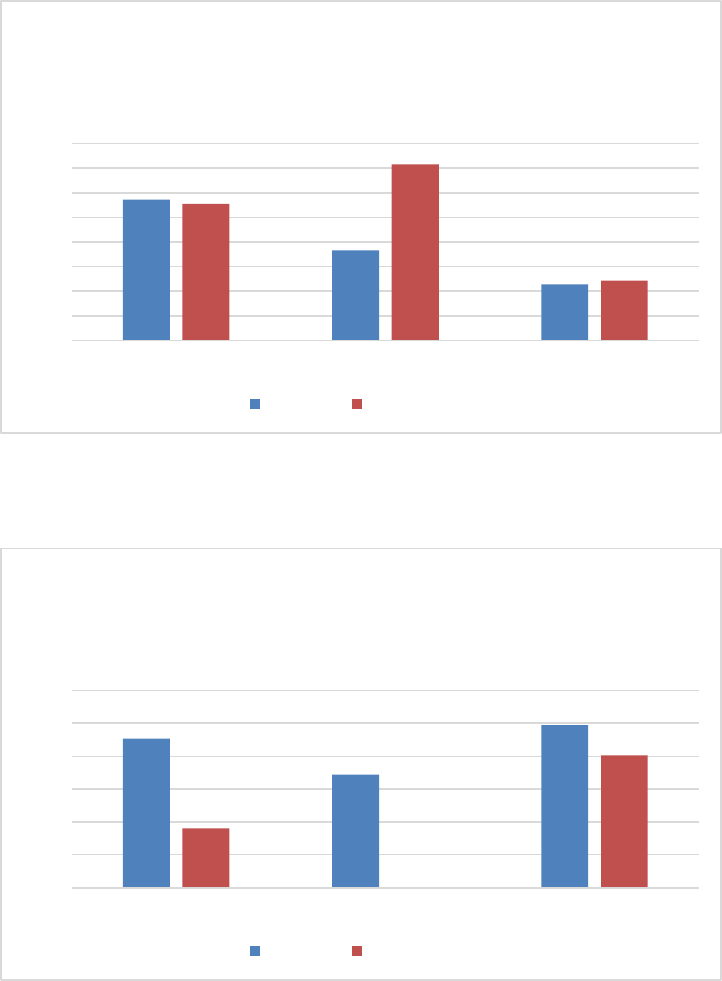
166
The information from Table 17 is further visualised in Figure 50 and Figure 51. It can be clearly
seen from these bar charts that omissions of definite article persist in Task 2, but the taught
group (as a ratio of obligatory contexts) is oversupplying the definite article to a much lesser
extent in Task 2, while the median overspecification value of the error-corrected group was 0.
Figure 50: Bar chart – omission and oversuppliance of definite articles in Task 1
Figure 51: Bar chart – omission and oversuppliance of definite articles in Task 2
0.000
0.020
0.040
0.060
0.080
0.100
0.120
0.140
0.160
Experimental taught group Error correction group Control group
Essay 1 Definite article (all types) omission and
overspecification (coefficients) medians per
group
Omission Oversuppliance
0.000
0.020
0.040
0.060
0.080
0.100
0.120
Experimental taught group Error correction group Control group
Essay 2 Definite article (all types) omission and
overspecification (coeffecients) medians per
group
Omission Oversuppliance

167
5.7.5 Article misuse errors
There were only 14 article misuse errors (a for an, a/an for the, the for a/an) in total in the
whole corpus. Indeed there was only one ‘a for an’ error. This result is in contrast with Díez-
Bedmar & Papp’s (2008) findings but confirms Master’s (1995) report that Chinese students
at this level make errors of omission (of any article) or overspecification of definite article, as
opposed to confusing the article (i.e. correctly judging nouns to need an ‘a/an/the’ specification
but choosing the wrong specifying article). This very small number of misuse errors is shown
in Table 18, but is ignored in the remaining discussion.
Table 18: Misuse of article errors
a/an confusion
a/an for the
the for a/an
Task 1
1
0
3
Task 2
0
1
2
Task 3
0
0
7
5.7.6 Accuracy at the 14-week stage
Unfortunately, in the taught group most of the improvements observed between Task 1 and
Task 2 were not sustained at the last data collection point. For example, with regard to Type 2
definite article use at the 14-week stage, six weeks after extra lessons on article use and article
error correction had ceased, the taught group’s TLU was in fact marginally lower (Mdn 0.81)
than it had been in Task 1 (Mdn 0.82) as illustrated in Figure 48 (p.173). Moreover, although
the error-corrected group’s Mdn TLU in Type 2 definite articles remained higher than it had
in Task 2, a Wilcoxon ranked test no longer showed a significant improvement (Z=19, p=.889).
168
TLUs of overall Ø articles maintained a fairly similar level, but a Wilcoxon Signed Rank test
suggested the improvement was no longer statistically significant (Z=28, p=.161). Even
though the TLU of a/an overall remained higher at the 14 week stage (Mdn 0.82) than when
students had began in week 1 (Mdn 0.66), this improvement was no longer significant (Z=26,
p= .263).
In the error-corrected group, one article category (a/an articles overall) showed a significantly
improved Mdn TLU (0.70) in week 14 to its equivalent pre-treatment TLU (Mdn=0.50) in
week 1 (Z=34, p=.025). However, this was the only article showing significant improvement.
As was presented in Table 15 (p.160), no individual Bickerton article context showed
significant Target-like accuracy improvement in week 14. For example, the Mdn TLU in
definite articles (0.88) in week 14 was not shown by the Wicoxon Signed Rank test to be
significantly higher than it had been in week 1 (Mdn= 0.76) TLU (Z=20, p=.779). Equally,
this inferential test suggested that TLU of overall Ø articles in week 14 (Mdn=0.91) was not
significantly different from pre-correction levels (Mdn=80) (Z=24, p=.401). The absence of
control group data for Task 3 unfortunately makes it impossible to evaluate the effect of the
task prompt on this disappointing drop in performance.
5.7.7 End-of-study anonymous survey
Twenty-three of the Twenty-four students in this study completed the online end-of-study
anonymous survey in week 15. This section reports on the most salient student responses. Full
responses to all questions can be found in Appendix 6.
With a view to gauging students’ reaction to written error correction, Question 3 asked
participant respondents:
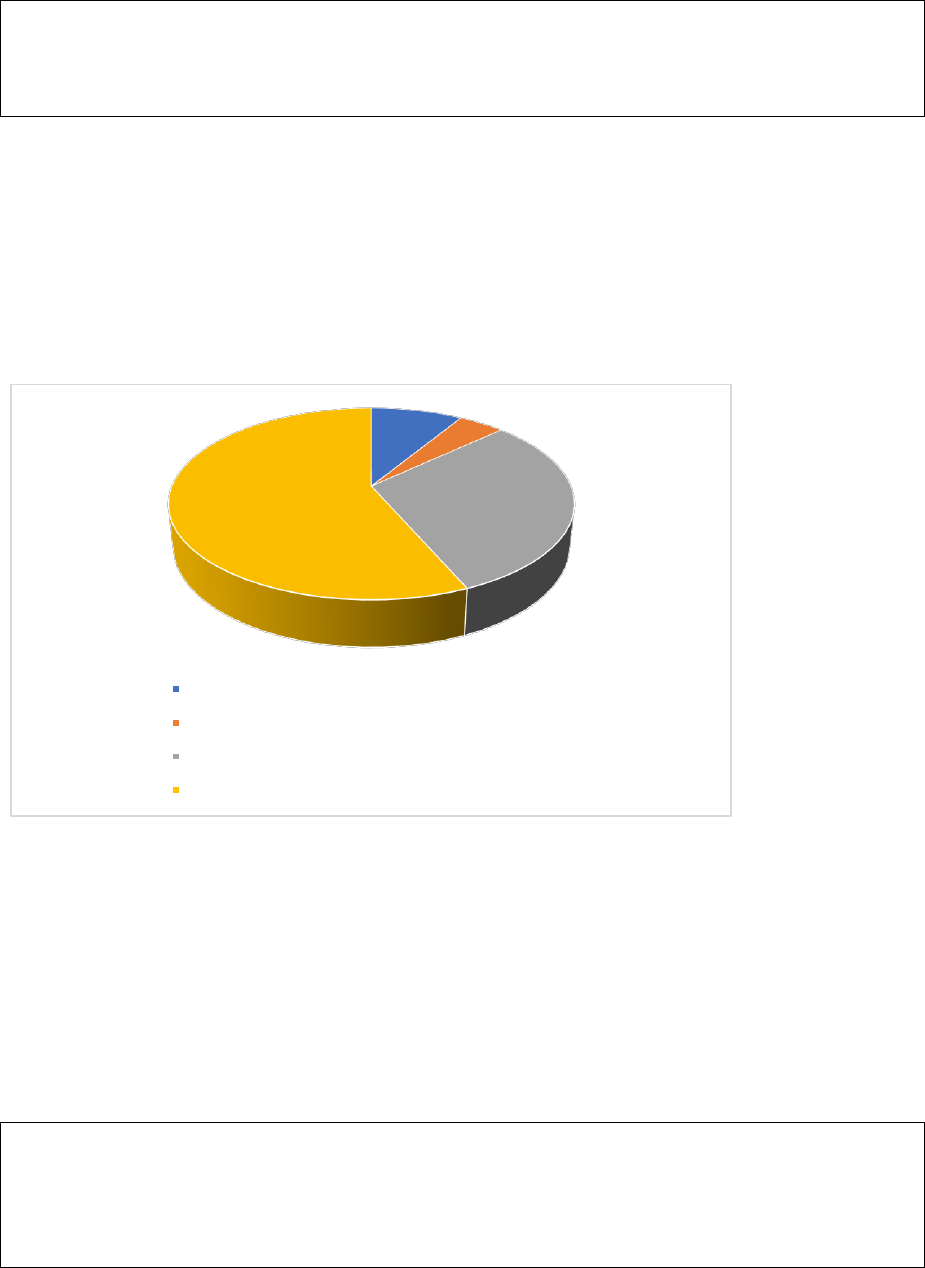
169
Your teacher marks your writing homework and points out an error in an article, e.g. (Art. –
you forgot the definite article).
How do you feel? (which one emotion below best described your reaction?
As visualised in Figure 52, the majority of the respondents (20 out of 23) reported a positive
or very positive response to receiving error corrections. Two of the respondents expressed
negative feelings and one was not sure.
Figure 52: Participant responses to Survey Question 3 (n=23)
In order to investigate students’ affective reaction to being corrected orally in class time,
Question 4 asked:
In an academic writing class a teacher notices an error that you make with your article (a/an/the)
and tells you. While other students are reading/writing he quietly explains a rule to you (about
article use).
How do you feel? (which one emotion below best described your reaction?
Negative (I dislike receiving feedback like this)
Not sure
Positive ( I like receiving feedback like this)
Very positive ( I really like receiving feedback like this)
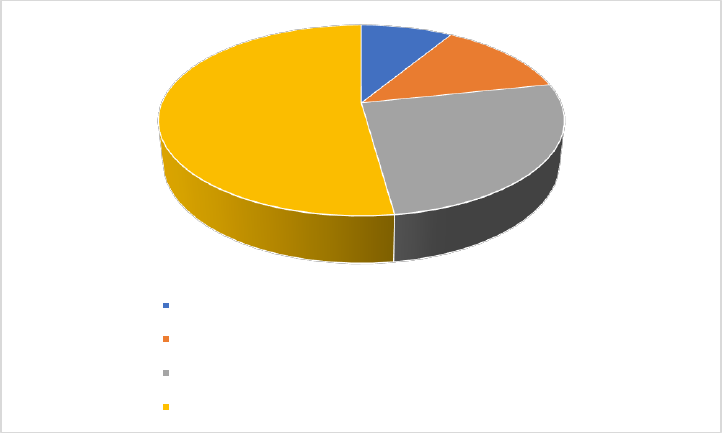
170
As shown in Figure 53, while 18 of the 23 participant respondents felt positive or very positive
about such correction, three reported they were ‘not sure’ and two disliked receiving such oral
feedback in class.
Figure 53: Participant responses to Survey Question 4 (n=23)
Although the negative affective responses to error correction (written or verbal) were low, there
is a possibility that students are under reporting their dislike of error correction or a focus on
the form of article. It is important (Wang, 2001; Shi, 2006; Leedham, 2015) to avoid the
cultural stereotypes that other authors have made in reference to Chinese students’ respect for
the teacher (Cotazzi & Jin, 1996; Wu, 2009). However, international students (regardless of
nationality) can feel uncomfortable criticising a researcher’s methods when that person is a
senior teacher on their programme, so the less positive reaction of five students could represent
a slightly larger opposition. Two responses in the open question at the end of the survey give
some insight into the students’ frustration with the topic (all five responses are reported in
Appendix 6).
Negative (I dislike receiving feedback like this)
Not sure
Positive ( I like receiving feedback like this)
Very positive ( I really like receiving feedback like this)
171
Anonymous student 1 (open question response):
I have learned about the article use since I was in a primary school. I can remember
some general rules for using article. It is helpful but not as much as I expect. I still want
to study more about this topic because it is very important for learning English.
Anonymous student 2 (open question response):
I like the correction from teacher, however, when I make some stupid error, I feel a
little bit embarrassed and lesser confidence in English.
5.7.8 Comparison with the literature and critical evaluation of results
In sum, this study showed that the taught group made significant improvements in their
accuracy of use of Type 1 generic a/an and Ø articles, Type 2 definite articles, and Type 3 Ø
articles in the period in which they received extra teaching/article correction. The use of the
error-corrected and control group enabled the study to show that students facing the same
prompt without any such extra consciousness raising activities (in the control group) made
significantly more errors in many article contexts. This evidence supports the hypothesis that
teaching can make a difference in students’ accuracy (Master, 1990; Master, 1995; Master,
1997; Bitchener & Knoch, 2008), at least in the short term. However, the finding that this
progress was not sustained significantly (in all but a/an articles in the error-corrected group)
six weeks after the extra teaching had ceased confirms Master’s (1997) conclusion that
students’ improvement at this level was mostly sustained only as long as their attention was
focussed explicitly on article use. Their improvement could thus be interpreted as a result of
the students’ extra attention to proofing their work for article errors that they were more
conscious of due to the teaching they had received.
172
Similarly, in the error corrected group, the finding that error correction (by simply underlining
the error) may have a significant impact in the short term supports the arguments, to some
extent, made by Ferris (1999) and Chandler (2003) about its role in writing classes and that it
is most effective when focussed on single language areas (Bitchener, Young & Cameron,
2005; Ferris & Kurzer, 2019). However, most significant improvements were lost six weeks
after the corrections were focussed so intensely on article accuracy, so it is not argued here that
the error-correction helped students across all article contexts in a sustained way. Moreover,
given lack of long-term impact, the negative affective impact on several students and the
significant time spent on such error correction, a clear argument can be made against such
‘scatter gun’ policies of correction.
5.8 Conclusion
The error-tagging methodology (using the adaptation of the Bickerton Framework for article
use) led to reliable results, as shown by the refined inter-rating reliability tagging. In contrast
to the initial issues encountered in the preliminary study, when the noun phrases were presented
to the annotation checkers in decontextualised forms, this text-based method showed that
properly trained researchers could apply the framework with greater reliability. To achieve
this consistency, an extremely thorough standardisation was required (particularly in
judgements about definite article redundancy/oversuppliance). Some borderline cases in which
some raters disagreed were presented, but these differences in opinion were not as frequent as
those in the preliminary study. While intensive training and the standardization process
achieved satisfactory reliability in this study, there could be difficulty in comparing studies that
examine the complex issues of register appropriacy with relation to article use if the same
polices and standardization was not repeated.
173
Several limitations to this study, not least the small sample sizes, mean that caution must be
shown in interpreting these findings. Furthermore, participation was limited to IELTS 5.5 and
6.0 level, slightly below the average 6.0 – 6.5 level of most students across the UK sector.
While efforts were made to control the teaching input of all three classes, outside laboratory
conditions it is acknowledged that certain variables cannot be scientifically controlled. Indeed,
in the following chapter some insights from student interviews will show the near impossibility
of designing three prompts on topics with equally familiar topic vocabulary for all students
(and this knowledge of the lexis will affect knowledge of countability and thus article
accuracy). Since these data were collected, several studies have emphasised the importance of
task prompt and the effect of topic and task and this may have been underestimated during the
design of this study and this variable has a huge effect on the conclusions that can be drawn
(Díez-Bedmar, 2015; Crosthwaite, 2017). Future studies need to find a way of presenting the
same topic to the students, perhaps requiring different sections of an extended piece of work to
be submitted. A further limitation is that there appears to have been a larger discrepancy
between the proficiency levels in the control group and other groups than had been initially
estimated, as shown in the initial control group’s higher TLU scores in Task 1. Comparisons
between the progress of the three groups must therefore be treated with a degree of caution.
Another limitation is the missed opportunity to reflect new modes of error correction and
feedback (Hyland & Hyland, 2006), since the experimental and control groups received
traditional paper-based correction methods rather than the latest innovative contemporary
feedback processes afforded by technology.
Notwithstanding the limitations, the use of a control group for Task 1 nevertheless suggests
that the improvement in accuracy shown by both the taught group and the error corrected group
may not have been due to this change of topic alone. At least in the time the students’
174
consciousness of article use was raised and in this limited proficiency range, both groups
showed statistically significant progress, particularly in Type 2 definite articles while a control
group studying the same topic and writing the same essay made more errors (relative to their
own Task 1 results) without these interventions. Future studies with larger sample sizes and
control group responses for both tasks are now required to make firm conclusions about the
effect of teaching/error correction, but this study offers some tentative evidence for the
argument that either of these interventions may help students improve their accuracy in the
short term.
Perhaps the most important finding in this study was that both teaching of article use and error
corrections had more effect on reducing overspecification than article omission. As redundant
definite articles have been shown to contribute to an inappropriate conversational tone and
since register awareness is a key objective of EAP courses, this insight requires further
investigation and future research is needed to more qualitatively investigate this effect. The
next chapter presents evidence from several student interviews, but a larger scale study is
needed to look into one possible explanation that students are simply careless with many article
redundancies while their omissions in article use may be the type of errors they make in true
misunderstanding of the noun’s countability or use in its lexical context.
The findings of this study have several implications for EAP teachers if the findings of such a
small scale study involving IELTS 5.5/6.0 levels were representative of the wider UK
population of Chinese L1 lower English L2 learners. The more practical recommendations for
the teaching of article use in EAP will be presented in the Chapter 8 conclusion in light of the
findings that will be reported in Chapter 6 and 7, but it can be immediately seen that the ‘one
off’ teaching session recapping the grammar of article rules may not necessarily have a
sustained effect on Chinese students’ written accuracy of articles. Equally, the occasional mass
175
correction of all of a students’ article errors can improve students’ consciousness and have a
short- term effect, but this extra attention to article accuracy may only last as long as students
have such regular corrections. Meanwhile, it should be remembered that a small number of
students expressed negative views towards such correction.
This study does not support the pessimistic assumption that teaching or error correction will
have no impact as, notwithstanding the fact that the improved accuracy only lasts as long as
the teaching/corrections, the study did observe significant improvement in accurate use in
certain contexts. Students generally embark upon presessional programmes knowing the
general rules of article use, so this was most likely a result of the students’ added consciousness
of articles during their essay proofing rather than learning anything new about articles during
teaching. On the other hand, as any consciousness raising activities are likely to have an effect
on short-term accuracy (which Chapter 4 showed as an end in itself for some teachers as they
prepare students for extended written assessments), this study has shown that a teaching
approach could be valid, however limited. As to which method of focussing attention is
preferable, there is a clear case for teaching and against overcorrection of articles because, even
if both are equally effective in the short term, teaching is less likely to cause a negative reaction
among learners.
As shall be developed in the conclusion, given the possible impact that article use is suggested
here to have had on the register (with many redundant errors argued to cause an informal tone
in the writing) this effect of inaccuracy may merit attention in EAP programmes. In parallel
with the positive effect that teaching/correction had on overspecification, a strong case shall be
made in the thesis recommendations for focussing in particular on definite articles and their
appropriacy for cohesive purposes but inappropriate effect when making generalisations or
176
discussing hypothetical or idealised situations in Type 4 contexts in their essays (when bare
noun plurals are usually preferred).
Before any conclusions or recommendations are made, there was a need to conduct research
with a larger population with a wider range of levels (as will be presented in Chapter Seven),
particularly since this chapter has only focussed on IELTS level 5.5 and 6.0 students. Before
extending the focus, however, the following chapter analyses these Chinese learners’ article
errors more deeply and compares the same learners’ use of articles in essays to their accuracy
in an alternative genre of academic writing. In addition, a comparison with responses from L1
tutors provides insights to underuse and overuse issues.

177
6 CONTRASTIVE ANALYSIS OF CORPORA
This chapter presents the further analysis of the data collected for Chapter 5 (which focussed
on the dynamic effects of article consciousness raising) together with further L1 data, data from
lower proficiency Chinese students, and data from a different genre of writing that some of the
students submitted (a case study) in order to gain a deeper understanding of the contexts in
which Chinese learners make article errors. In addition, through further qualitative and corpus-
based (deductive and inductive) methodologies, the thesis turns its attention to the possible
causes of errors made by Chinese L1 students in particular.
6.1 Study overview
Two of the four research questions as originally stated in the Literature Review are addressed
in this study:
Research Question 2: What are the linguistic contexts of obligatory article use in which
Chinese L1 students at Upper-Intermediate levels of English L2 are most likely to make
errors?
Research Question 3: To what extent does the Chinese students’ L1 background affect
(1) TLU and (2) their types of article error?
Research Question 2 refers to ‘contexts’ firstly in terms of the Bickerton article use Types as
presented in Section 2.2.1. By replicating the data analysis approach of recent studies (Díez-
Bedmar & Papp, 2008; Crosthwaite, 2016a) into Chinese students’ article errors, comparisons
of ‘Target-Like Use’ (TLU) can be made. This analysis will thus examine whether the
University of Birmingham’s Chinese L1 15-week B2 level students continue to demonstrate
the many ‘non-native features’ reported by Díez-Bedmar & Papp (2008) or whether, as found
178
by Crosthwaite (2016a: 94), they are generally ‘not struggling with article use in the majority
of article contexts’.
After analysing ‘context’ in terms of the Bickerton Framework, replicating the two
investigations mentioned above (Díez-Bedmar & Papp, 2008; Crosthwaite, 2016a), the study
then also turns to a more data-driven analysis through concordance tools. As discussed in
Chapter 2, academic writing presents a steep learning curve for L2 novice academic writers
not least due to the very frequent use of densely packed nominalisations in this register
(Halliday & Martin, 1993, Biber & Gray, 2010; Bennett, 2011). On the basis that novice
academic readers/writers have been shown to struggle with such compression of the noun
phrase (Fang, Schleppegrell & Cox, 2006) the effect of pre-modification of the head noun on
accuracy of article use is also examined.
The likely effect of L1 transfer (Research Question 3) will be addressed through a comparison
of the findings with secondary research findings. By comparing the findings with those of
Díez-Bedmar & Papp (2008) and Crosthwaite (2016a), their hypothesis that Chinese learners
omit articles due to L1 transfer can be tested. As reviewed in Chapter 2, Díez-Bedmar & Papp
(2008) hypothesised a greater omission of articles among article-less L1 students whose L1
language does not grammaticalise definiteness and specificity in the same way. They also
found Chinese learners oversupply articles due to a deficit in pragmatic awareness.
Crosthwaite’s (2016a) more nuanced hypothesis is that Chinese L1 learners show a lack of
positive transfer effect in their inaccuracy with generic article uses, particularly in indefinite
generic contexts as Chinese has no equivalent grammaticalization. Thus, evidence that Chinese
learners had higher accuracy in Type 2 and 3 contexts would support his hypothesis that
Chinese learners do show positive transfer effects, since unlike other article-less languages,

179
Chinese has the potential to show definiteness and indefiniteness with classifiers and
demonstratives.
Following the study presented in Chapter 5, it was also hypothesised that the Chinese students’
tendency to ‘oversupply’ definite articles may create an effect on the perceived register (Lee
& Chen, 2009). This effect could contribute to explaining claims in the literature that novice
L1 Chinese students’ L2 academic English writers can be perceived to be using an overly
informal or even conversational tone in their academic writing (Gilquin & Paquot, 2007;
Mayor, 2006; Lee & Chen 2009; Chen, 2014).
6.2 Methodology
L2 data
Four corpora will be used in this chapter: 1) a B2 level student corpus (n=24), 2) a B1/B2 level
corpus (n=30), 3) a micro case study corpus (n=16) and 4) a micro L1 corpus (n=5). As this
research project mainly pertains to B2 level learners most findings in this chapter relate to
Corpus 1 (three essay tasks written by 24 B2 learners) with the other corpora used for
comparative purposes.
Corpus 1: B2 level corpus.
This corpus contains data recycled from Chapter 5’s longitudinal study (35,716 words). As
suggested in the previous chapter, this data may have been affected by efforts to raise students’
consciousness about article accuracy. On the one hand, given that some of these essays (see
Table 19, p.199) were written while students were asked to pay extra attention to English
articles, it could therefore be unrepresentative of Chinese students’ grammatical accuracy or
at least only representative of Chinese students more consciously trying to proofread their work

180
for article mistakes. On the other hand, as the research is interested in investigating the average
Chinese international student in the middle of the process of writing their first academic texts
(with time to proofread their own work), the errors that such students continue to make –
despite these efforts – are argued here to represent a rich and valid source of data in their own
right.
Corpus 2: B1/B2 level corpus
In order to enable an analysis of the effect of proficiency presented in Section 6.4.5, 18 essays
(Tasks 1, 2 and 3) from lower level B1 students from one of the BME classes were added to
the corpus. The class teacher of these students had volunteered to ask students to take part in
the earlier study, but the lower level of the students and the added tuition given to the students
from several language support tutors during the programme (and the consequent difficulty in
controlling the pedagogic input) led to their disqualification from the investigation of Chapter
5. However, with lower scores in the BME writing placement test (which streamed these
students into a class that was provided with additional language support) their essays from each
of the three writing prompts were used to examine the effect of general writing proficiency on
article accuracy.
As can be seen from Table 19, the six lower level students had all achieved a maximum score
of IELTS 5.0 (overall) in the last two years. All had been studying on the university’s longer
presessional course prior to the time of the study (four students for five weeks and two for three
months). Their results on entry writing test (ranging from 48-51) showed that these six lower
level students continued to write at a borderline B1/B2 level. In sum Corpus 2 participants, in
addition to these six students at B1 level, included 14 students at the IELTS 5.5 low/middle

181
end of the upper=intermediate level and 10 students with stronger Upper-Intermediate IELTS
6.0 scores.
Table 19: Participant information (including borderline B1/B2 students).
IELTS 5.00
(n=6)
IELTS 5.5
(n-14)
IELTS 6
(n=10)
Total/Summary
Age
21-23
23-26
22-24
Median: 23
Male
Female
2
4
7
7
2
8
Male 10
Female 20
Chinese
Taiwan
6
0
9
5
6
4
21 Chinese
9 Taiwan
Entrance writing
test score
Range: 48-51
Median: 50
Median AD= 1
Range: 53 -59
Median: 5.5
Median AD= 1
Range: 56-61
Median: 57
Median AD= 2
Mean:
56.04
SD: 4.26
Length in the UK
or English L1
countries at entry
Four students
under two months,
two students under
five months
One student under
three months, one
student under two
months, 12
students under one
month.
All students under
one month
No students over
five months in the
UK
Corpus 3: Micro case-study corpus
In order to investigate the effect of genre, a micro-corpus of case studies produced by 13 of
the students from Chapter 5 was also compiled (14,603 words). Details about the case study
prompt can be seen in Table 20 (p.183) where the case study is labelled ‘Task 4’ to avoid
confusion with previous labels (although this case study was actually submitted in week 7,

182
before Tasks 2 and 3). This case study submission was the first draft of an assessed piece of
work (students turned in a final submission after feedback in week 12).
While the essays reflected the Presessional’s approach to building the academic writing skills
that students would need for the literature reviews of their Masters’ level dissertations, the case
study assessment on the Presessional more authentically reflected the assignment tasks that
students would face in the Business School (i.e. report structured assignments based on a case
study text). Unlike the essay prompt tasks, students were given a background case study text
and asked to use examples and make references mainly to this text in their response (only
synthesising theories from the literature where necessary). The main difference in this case
study prompt, however, was the instruction to provide recommendations. According to
multidimensional genre analysis (Conrad & Biber, 2002; Gardner, 2008) case studies can be
differentiated from essays due to their purpose of recommending a course of action. In terms
of Gardner’s (2008) cline of persuasion, the case study represent a register in dimension 4 quite
distinct from more argumentative forms of academic writing.
Summary of Prompts for all corpora
For ease of reference, the four prompts are presented in Table 20 overleaf.
6.2.1 Corpus 4: L1 data for contrastive analysis
To facilitate a contrastive analysis (and identification of ‘overuse’ or ‘underuse’ of articles),
five L1 English speaking tutors agreed to write responses for Tasks 1 and 3. All five ‘expert
writers’ held Masters/DELTA teaching level qualifications and had taught on the BME for at

183
Table 20: Four Task prompts
Rubric
Texts
Words
total
Minimum and
Maximum
lengths and
Median word
length
Task 1
Essay
(week 1)
Does fear motivate employees to work harder?
Illustrate your ideas with reference to theories of
motivation studied on the course. (350 - 400 words)
30
11147
Minimum: 302
Maximum:440
Mean: 371.6
words
Task 2
Essay
(week 8)
An effective marketing strategy is crucial to the
success of a business. Critically assess the value of
segmenting, targeting and positioning as a
marketing tool. Illustrate your answer with suitable
examples. (400-600 words)
*option for the three accountancy students:
Summarise the responsibilities of accountants and
discuss how they can contribute to efficient
information flow both within and outside business
organizations.
30
14306
Minimum: 443
Maximum:605
Mean: 476.9
words
Task 3
Essay
(week 14)
Retailers compete for customer loyalty and retention
in many ways.
Examine the issues, illustrate with examples and
suggest ways in which retailers can promote loyalty
and retention. (400-600 words)
22
10263
Minimum:403
Maximum:667
Mean: 466.5
words
Task 4
Case Study
(week 7)
Students were given a ‘case study’ about a Scottish
soft fruit grower and instructed to:
1) identify the marketing, human resources and
financial constraints. 2) With reference to the
Product Life Cycle tool, give two alternative methods
of extending their products’ life cycle and 3) make
recommendations about the company’s payment
strategy. (900 words)
16
14603
Minimum: 853
Maximum 976
Mean: 912.7
words
184
least one summer previously. Three responses were also gathered for Task 2 and three
responses for the case study Task 4, all from tutors with L1 backgrounds and Masters/DELTA
English teaching qualifications.
6.2.2 Limited number interview sessions
Three students participated in post programme one-to-one unstructured interviews designed to
investigate students understanding of why they made article errors. During interviews, students
were presented with a number of correct and incorrect article uses from their Task responses
and asked 1) whether they believed them to be correct and 2) if incorrect, why they had made
the error in their Task response. One-to-one sessions that enabled such qualitative investigation
of error were planned for all participants. However, due to the high pressure/stress students
were under in the high stakes assessments at the end of the course, it was not possible to
schedule these sessions until six weeks after the Presessional had finished. By this point,
participation was lower than expected. Nevertheless, some qualitative findings were gleaned
from these interviews and these will be reported in Sections 6.4.7 to 6.4.15.
6.3 Data analysis
For ease of reference, the Framework adapted from Bickerton (1981), as critically evaluated in
Chapter 3, is reproduced overleaf in Table 21. Procedures for tagging, training two annotation
reviewers, and checking the reliability of annotation were presented in the previous chapter
(Section 5.6). As aforementioned, these procedures led to a Fleiss Kappa inter-rater correlation
of 0.87, showing strong reliability.

185
Table 21: Framework adapted from Bickerton’s (1981) semantic and pragmatic uses
Type
Features
Context
Tag/Form
of Article
Examples
3
1
[-SR, +HK]
Generic: The reader knows of
its existence, but not a specific
reference.
1IA a/an
1ZA Ø
1DA The
An elephant never forgets.
Elephants never forget.
The elephant never forgets.
2
[+SR, +HK]
Writer and reader both know
of the specific referent.
2DA The
Remember to feed the
elephant!
That’s the biggest elephant
I’ve ever seen.
3
[+SR, -HK]
The writer knows of a specific
referent the reader does not
know.
3IA a/an
3ZA Ø
The local zoo has an elephant.
The local zoo has elephants.
4
[-SR, -HK]
Neither writer or reader
believe the noun refers to a
specific thing
4IA a/an
4ZA Ø
The zoo does not have an
elephant.
The zoo does not have
elephants.
5
Fixed
expression
Conventional use (use in
idioms and proper nouns)
5ZA Ø
5IA a/an
5DA The
On the one hand, Nelly the
elephant enjoyed the 1950s.
On the other hand, she was
now having a ball.
6
Alternative
determiners
Quantifiers or other
alternatives to article
determination
6
Two elephants.
Another elephant
3
Examples 1-4 taken from Langendoen (1970), Cziko (1986), Heubner (1983), and Butler (2002). Examples 5
& 6 author’s own examples.
186
6.4 Results and discussion
Before reviewing ‘Target-like Use’ (TLU) data, this section gives an analysis of percentage of
error type findings for the most common type of article error made by the students.
6.4.1 The most frequent errors Chinese students made in short essays (percentages)
Restricting this part of the analysis to the B2 level students (n=24), as this Upper-Intermediate
level is the main focus of this research project, 3.2% of all noun phrases were judged to be
underspecifying the referent, omitting either an obligatory the or a/an article (oversuppliance
of Ø). Overspecification (overuppliance of a/an or the when Ø was judged obligatory) occurred
in 2.1% of all noun phrases. Focusing on the definite article alone, omission was a slightly
more frequent problem (2.2% of noun phrases) than overspecification (1.7% of noun phrases).
In contrast, such oversupply was an extremely rare problem for a/an article use (0.3% of noun
phrases) compared to omission of a/an which occurred in 1.6% of noun phrases. In contrast
with some of the claims made in the literature (Master, 1987; Chang, 2001) misuse of a/an for
the (or vice versa) was highly infrequent (0.1% of noun phrases),
This analysis of percentages allows for comparisons with studies that reported raw data alone
(without ratio measures) and confirms Chuang & Nesi’s (2006) findings that Chinese B2 level
students make both omission and oversuppliance definite article errors, but that omission is a
marginally more frequent error. These results also lend support to the hypothesis of Díez-
Bedmar & Papp (2008) that L1 Chinese learners omit articles as a result of their article-less L1
background and oversupply articles as a result of their deficit in pragmatic awareness.
Table 22 presents the ranked contexts in which students produced errors as a percentage of all
article errors. As can be seen, almost half of all errors in the three essay prompts were judged
to be in Type 2 and 4 contexts. As 95.2% of the 4 GAZA type errors were a result of the

187
overspecification, it can be reported that over 47% of the article errors therefore involved either
the omission or oversupply of definite articles.
Table 22: Proportion of errors by context
Grammatical description
Bickerton Framework
Context
% of Head Noun phrases
Referential definite articles
2GADA
24.89
Non-referential Ø article
4GAZA
23.23
Non-referential a/an article
4GAIA
12.97
Referential a/an article
3GAIA
10.41
Conventional definite article use
5GADA
6.64
Generic definite article use
1GADA
5.13
Indefinite Ø article
3GAZA
4.98
Generic a/an article
1GAIA
4.07
Conventional Ø article use
5GAZA
3.92
Generic Ø article
1GAZA
3.17
Conventional a/an article use
5GAIA
0.60
100%
6.4.2 Contrastive analysis of all uses of articles
Returning to the issue of both correct and incorrect uses of articles, the B2 essay corpus of
Chinese students (n=24) was next compared to the L1 writer corpus. The number of ‘other
determiners’ (6OD annotations) was compared and found to be very similar. L1 writers used a
range of pronouns, quantifiers, possessives and alternative determiners for 16.6% of all tagged

188
noun phrases while the Chinese students chose other such determiners in 15.3% of noun
phrases.
As shown in Table 23, the most striking contrast between the L1 tutor essay responses and the
Chinese students’ responses is in the two groups’ use of Type 3 indefinite/Ø articles.
Particularly in Task 1, Chinese students used Type 3 articles (6.4% of all articles used) far less
frequently than L1 tutors (20.2%). In contrast, Chinese learners more frequently wrote in Type
4 non-referential contexts (54.7% of articles) than the L1 tutors (43.1%). The Chinese learners’
use of Type 3 indefinite/ Ø articles more than doubled in the essay 2 and 3 responses, but it
remained constantly lower than the L1 tutors’ use.
Table 23: L1 writers (n=5) article uses compared to Chinese L1 essays (n=24)
Essay 1
Essay 2
Essay 3
Case study
Chinese
L1
English
L1
Chinese
L1
English
L1
Chinese
L1
English
L1
Chinese
L1
English
L1
n=24
n=5
n=24
n=3
n=24
n=5
n=24
n=3
Type 1
6.2
6.4
11.7
7.4
8.6
5.8
3.8
4.3
Type 2
22.2
20.8
26.7
24.2
21.1
28.6
55.0
51.4
Type 3
6.4
20.2
14.3
22.8
14.3
20.8
12.5
13.2
Type 4
54.7
43.1
35.1
32.1
46.2
36.6
22.8
25.7
Type 5
10.5
9.5
12.2
13.5
9.7
8.3
5.9
5.4
Total
100.0
100.0
100.0
100.0
100.0
100.0
100.0
100.0
Closer inspection of the reasons for the divergence in article use seen between Chinese L1 and
English L1 writers showed that the latter were more frequently weaving between
generalizations and specific examples in all parts of their essays. L1 writers were likely to use

189
abstractions and generics in their introductions and conclusions, but far more likely to cite
examples in their introductions. By contrast, Chinese students often introduced their essay with
reference to generic, prototypical companies, but rarely used specific examples from the real
world to develop these ideas. Throughout the body of the essay, L1 writers often used generics
or non-referentials in the topic sentences and ends of paragraphs in the more abstract critical
evaluation of the topic, but were far more likely to invite the reader to consider concrete real
world examples (see Figure 54). In contrast, as shown in Figure 55 below, through their use
of conditional sentences, modality and continued discussion of generalised referents of
‘employees’ and ‘managers’, Chinese students often maintained a non-referential unspecified
level of abstraction throughout the entire paragraph and some maintained this level of
abstraction throughout most of the essay, particularly in Task 1.
[Task 1, Expert writer #1] Indeed, there have been well publicised high awards in courtrooms
in recent years following accusations of worker intimidation.
[Task 1, Expert writer #2] Another issue is that a fear of failure has been shown to lead to
risk averse employees.
Figure 54: Tutor examples
[Task 1, Student #10] On the other hand, motivation by fear may reduce employees’
performance. If the employees are only motivated by fear in a long term, it will be hard to
offer them a sense of job satisfaction and security.
[Task 1, Student # 7] Few can deny that one single motivation theory cannot fit all particular
situations, by which I mean effective managers should focus on various of motivation theories
and give more incentives to employees.
Figure 55: Student examples
Students’ increased use of Type 3 contexts in Tasks 2 and 3, to some extent reflects their
development as novice academic writers. Indeed, the principle objective of the academic
190
writing component on the Presessional programme was to take students from the habits
developed for IELTS writing exams (use of learned generic answers and formulaic expressions
learned in IELTS preparation courses) to a more academic style and the use of evidence to
support all ideas and claims. Another key aspect of academic writing taught in all classes
through the academic writing component was the ‘general to specific’ textual pattern of
paragraphs and ‘general-specific-general’ shape in most EAP essay structures. Thus, the
increased use of the specific referents between Task 1 and later Tasks may reflect the students’
growing understanding of this aspect of academic writing. On the assumption that the L1 tutors
were appropriate models of academic writing, the outstanding gap that remained between the
two groups shows that the students were still failing to provide examples and specific
references for the abstractions in their generalised claims.
In regards to the addition of case study prompts, it is interesting to note the very similar patterns
of article type use by L1 tutors and the Chinese students, as was summarised in Table 23
(p.188). Despite being a new genre of academic writing for the students, it appears that the
students had little difficulty in applying the same discourse patterns as tutors: i.e. using
examples from the given case study text to support their answers. When asked to keep their
focus on one specific company, the students had little difficulty in keeping their references to
concrete things in the real world. Two factors therefore are likely to explain the students’
greater challenges in other genres of more discursive essays: 1) the habits learned in IELTS
preparation courses (which reportedly often encourage formulaic answers) and 2) the need in
more academic writing to more dexterously weave between the specific examples and abstract
claims to critically argue a position.
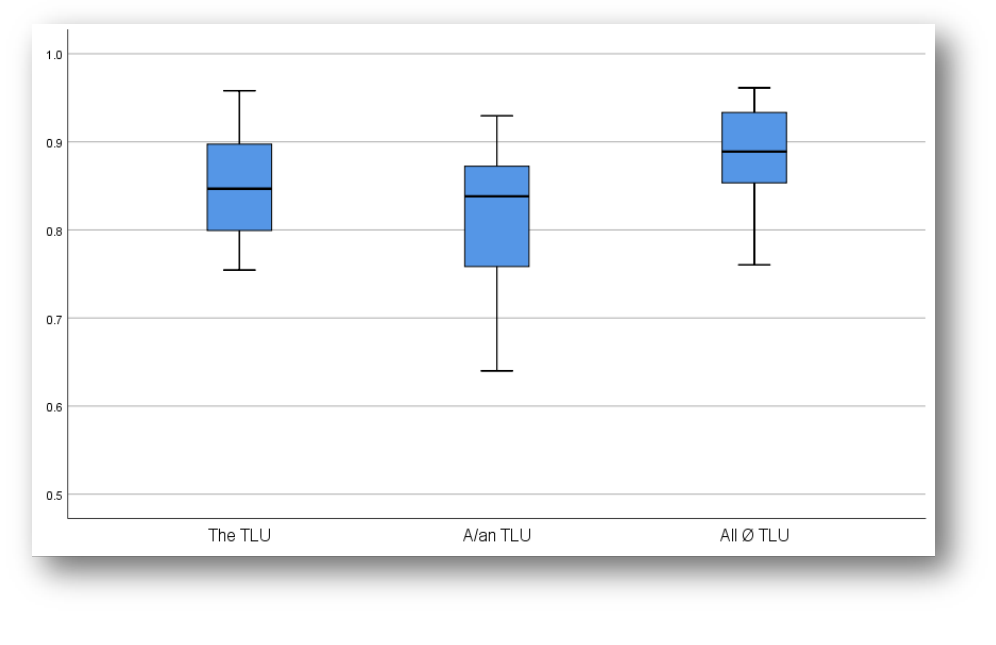
191
6.4.3 Order of accuracy
The medians and their distributions for accuracy of use of each article type are shown in Figure
56. Chinese students showed the highest TLU of Ø (0.89), followed by definite article
accuracy (0.85) and then a/an (0.81). These differences, while marginal, were shown to be
significant (P ≤ 0.05) by a related-sampled Friedman’s Two Way Analysis of Variance by
Ranks ( X² (2) =29.747, p=.000). Applying the Bonferroni correction for multiple tests, the
differences remained significant between a/an and the TLU (X² (2) =2.598, p=.028), and
between a/an and Ø TLU ( X² (2) =-4.980, p=.000), but not statistically significant between
the and Ø (X² (2) = -2.382, p=.052). These findings agree with Díez-Bedmar & Papp’s (2008)
finding that Chinese students are most accurate with Ø articles, but contrast with their finding
that the definite article was the most challenging article for students of this L1.
Figure 56: Median TLU scores in the three article types (3 prompts, n =24).

192
6.4.4 TLU of all types
As shown in Table 24, the data from the three essays shows that the B2 Chinese students
showed greatest target-like accuracy in 5ZA, 4ZA, 3IA and 2DA contexts. These four contexts
were among the five most frequent contexts for error, but when obligatory use was taken into
account (and the higher frequency of such contexts in academic essays), it can be seen that
Chinese students are generally more confident with definite articles and Ø than the raw error
frequencies suggested. However, the 4IA indefinite article, which was highly frequent in
essays, was one of the more inaccurate contexts for the Chinese learners (0.71 TLU). It should
be noted that the TLU for 5IA is greatly affected by its rarity and is therefore misleading – if
zero counts are removed from the analysis the students showed almost perfect accuracy.
Table 24: Overall TLU (all essays) in all contexts (n=24)
IDA 11A 1ZA 2DA 3IA 3ZA 4IA 4ZA 5DA 5IA 5ZA
Median 0.67 0.75 0.86 0.88 0.89 0.80 0.71 0.95 0.80 0.00 0.97
4
MAD 0.33 0.29 0.11 0.06 0.12 0.10 0.21 0.05 0.20 0.00 0.03
In sum, the essay data from this study would appear to suggest that B2 Chinese students are
most challenged by the following article contexts in order of difficulty:
IDA<4IA<1IA<5DA=3ZA<1ZA<2DA<3IA<4ZA<5ZA.
4
MAD = Median Absolute Deviation

193
6.4.5 The effect of proficiency on accuracy
By adding the six B1 students to B2 data to make Corpus 2, the effect of general writing could
be investigated with a slightly broader range of English proficiency levels. However, efforts to
find significant relationships between general writing proficiency and accuracy of article use
in the eleven contexts annotated met with only limited success. Students’ (n=30) individual
combined TLU coefficient for all three essays (in all eleven contexts) were analysed in relation
to their writing proficiency (as measured by the Presessional entrance writing test). No
significant relationship was found between the students’ general writing (as measured either
by writing test or by their IELTS writing bands) and their combined TLU in the three articles
(the/a/ Ø). Equally, no correlation was found between general proficiency level (measured by
either IELTS test band or writing entrance test score) and the students’
omissions/overspecification of either definite or indefinite articles in any of the contexts.
A Spearman’s rho test found a significant relationship (P ≤ 0.05) between all students’ (n=30)
placement writing score and their Target-Like Use with Type 1 definite articles (r
s
=.282,
p=.013). The same test (P ≤ 0.05) also found a significant relationship between all students’
(n=30) placement writing score and their Target-Like Use of Type 3 (3IA) indefinite articles
(r
s
=.228, p=.046). However, no significant relationship was found in this data between writing
proficiency and accuracy in 1IA, 1ZA, 2DA, 3ZA, 4IA, 5DA, 5IA and 5ZA contexts of article
use. This finding of no significant effect from proficiency level on the overall article accuracy
is surprising, since Chapter 2 showed a widely reported positive relationship in the literature
(Crosthwaite, 2016a; Murakami & Alexopoulou, 2016). Here, the effect is somewhat
accounted for by the very small sample of B1 students in the study and the large number of
students with an IELTS 5.5 band score.

194
6.4.6 Comparison of student accuracy in essays and case studies
Underspecification was again a greater problem than overspecification in the case study
responses. In terms of 2DA context definite articles, omission was a far more frequent issue
(2.6% of all noun phrases) than oversupply (0.7%). Equally, there was only one single
oversuppliance of indefinite article, while omission was the only error related to a/an articles
(1.3% of all noun phrases). This reduction in overspecification of definite articles is partly due
to the register differences of the genre. A case study response naturally entails inter-textual
cross references to the actors/organisations described in the case study prompt so the uses of
specific references to ‘the company’, ‘the workers’, the competition’ was more permissible
than an essay in which the focus is upon generalisations rather than specific cases.
This improvement in accuracy was sustained in the figures when ratios were used to factor in
the obligatory contexts. In fact, the Target-Like Use (TLU) of articles among these Chinese
students using the Bickerton Framework outlined in Section 2.2, as shown in Table 25 was
Table 25: TLU is essay prompts compared to case study prompt
Tasks 1-3 (3 essay prompts,n=24)
IDA 11A 1ZA 2DA 3IA 3ZA 4IA 4ZA 5DA 5IA 5ZA
Median 0.67 0.75 0.86 0.88 0.89 0.80 0.71 0.95 0.80 0.00 0.97
AD 0.33 0.29 0.11 0.06 0.12 0.10 0.21 0.05 0.20 0.00 0.03
Task 4 (Case study prompt, n=16)
IDA 11A 1ZA 2DA 3IA 3ZA 4IA 4ZA 5DA 5IA 5ZA
Median 0.00 0.00 1.00 0.92 0.91 0.89 0.78 0.95 0.83 1.00 0.86
AD 0.00 0.00 0.00 0.02 0.09 0.89 0.06 0.03 0.17 0.00 0.14
195
generally higher in the case studies than the essay responses. Ignoring use of generic articles
(students very rarely attempted their use in the case studies) the students showed greater
accuracy, for example, in Type 2DA (0.92), Type 3IA (0.91) and 4IA (0.89).
It is very likely that both the genre and the prompt Task were responsible for this greater
accuracy. In case study Tasks, students were required to only use the one set case study text
provided to give examples to support their answers. In effect, students were mostly
paraphrasing from a given text and synthesising these examples with their own analysis. In
addition to the greater allowance of specific reference, the students could see many examples
of the new vocabulary and its colligations with article use throughout the text that they were
referring to when writing their answers, so their confidence of article use with the new
vocabulary is therefore likely to have been enhanced. Although this makes the comparison
with essay tasks potentially problematic, the phrases were not removed from the analysis
because this use of case study texts authentically represented Business School assessments.
Thus, while this to some extent explains the students’ greater accuracy in this task type, it was
considered more valid to include the uses of prompt vocabulary (‘the company’, ‘the workers’)
in the analysis because the summary of such texts (retaining key words) is a normal part of
academic writing for business school students.
Given that students would more usually be writing responses to case studies of this kind (with
set texts to contextualise the genre and familiarise students with the new topic lexis) once
entering the Business School, it is possible that these higher accuracy rates are more reflective
of the students’ true abilities in the academic writing of their chosen discipline. This
196
conclusion would seem to support Crosthwaite’s (2016a) conclusion that students at B2 level
show little inaccuracy in article use outside generic contexts.
The remainder of this chapter now focusses on the individual article use contexts in order of
the frequency at which each error was found in Corpus 1. The analysis is confined to essay
responses at B2 level for comparative purposes to the studies replicated. In each section, the
L1 Chinese students’ errors in the three essays (n=24), are put in context of other studies and
the qualitative research undertaken in this project based on insights from student interviews.
In each of the sections below, a brief summary of the quantitative analysis will be followed by
some examples from the students’ three essays together with qualitative insights gained from
their interviews and the inductive analyses to which the student interviews led. In each of the
figures below, correct obligatory use examples are provided in blue text and examples of
incorrect use are given in red.
6.4.7 Context 2DA
The most frequent article error was omission on the in Type 2 contexts (24.9% of all article
errors), replicating the results of previous studies (Chuang & Nesi, 2006; Díez-Bedmar & Papp,
2008). Examples of correct and incorrect use are shown in Figure 57. The high frequency of
the error reflects its frequency in academic writing. In fact, among both students and L1 English
tutors the Type 2DA definite article was the second most frequent article used in essays. As a
ratio that takes account of high frequency obligatory use and overspecification, TLU of 2DA
definite articles was more ‘mid-range’ (0.88). This TLU contrasts with the slightly lower
accuracy reported by Díez-Bedmar & Papp (2008), but contrasts with Crosthwaite’s (2016a)
finding that Chinese students had almost mastered 2DA articles by B2 level.

197
2DA
It is clear from
the
above analysis that as a market tool,
segmenting, targeting and positioning all
do not have absolute advantages or
absolute disadvantages.
2DA
For instance,
the
main colours of Sainsbury’s stores are
orange and red which create the warm and
relax atmosphere for customers when they
are shopping in the store,
Error
example
1
The other one is the build-up method,
which only subdivides the market by
a single factor, such as gender in
^
cosmetics market and age in ^dress
market.
Error 2
^Switch ratio was developed by
Crouchely. It calculates
^
number of times a customer switches
from a retail store to another during a long
term (Kirkup, 2002).
Figure 57: 2GADA errors compared to 2DA correct use
At interview, students were presented with a mixture of such correct and incorrect uses (see
Figure 57) and asked to reflect on accuracy and then explain errors made. The student who
made Error 1 spent over one minute considering the example (with all articles removed) and,
as shown in the transcript below, showed great hesitation before finally agreeing the need for
a definite article:
198
Hmmm…can I take my time? This is stressful now, you take me back to my high school…
{student reads and rereads sentence for 50 seconds]…I’m not sure but I would prefer to put
nothing there. Let me read it again…[10 second pause]… no I’m not sure. [Teacher gives
student correction]…but …oh…there should be the here? It’s confusing. It confuses me
because cosmetics is plural…ah …ok I understand it is singular now.
[Student 1, six weeks after Presessional)
The above example shows the effect a pre-qualifying noun (cosmetics) had in obscuring the
student’s perception of the head noun (market) that they should have been determining. Indeed,
a recurring feature seemed to be that a pre-modification of any head noun (with adverb,
adjective or noun) confused the student’s grammatical understanding of the head noun. Thus
many omissions, as also shown in the example ‘^dress market’ occurred with pre-modified
head nouns.
On further investigation if the corpus with the Antconc concordance tool, an analysis of the
word ‘market’ used as head noun (n=83) showed that the was omitted in 13 of the contexts in
which the word was qualified (e.g. ‘^consumer market; ^young child toy market, ^adult market;
^new business market) representing nearly three fifths of the 22 qualified ‘market’ noun
phrases provided. Meanwhile, used singularly (without pre-modification) the lexis resulted in
only 6 omissions (under one tenth of the 61 uses of ‘market’ without any pre-modification).
Further analysis of all the 2GADA errors in the corpus, as shown in Table 26, showed that the
overwhelming majority of definite article omissions in 2DA contexts (69.4%) occurred when
the head noun was pre-modified, while only 18.5% of simple nouns were underspecified. The
effect of post-modified ‘of’ noun phrases, in contrast, appeared to have the opposite effect,
increasing the accuracy rate. It is possible that the ‘…of…’ pattern is a useful cue that students
can use to consider the use of definite article (which frequently colligates with ‘of’ cataphoric
reference).

199
Table 26: The effect of pre-modification
2DA (n=1780)
2GADA (n=159)
Head noun with no pre-
modification /not in cataphoric
‘of’ phrase.
37.3%
18.5%
Head noun ‘of’ phrase
(cataphoric reference)
28.4%
12.1%
Head noun of pre-modified
noun phrase (qualified by
adverbial, adjective or noun
classifier)
34.4%
69.4%
6.4.8 Context 4ZA
The second most frequent context for article error (23.2% of all article errors), occurred through
the overspecification of articles in Type 4 Ø article contexts, as exemplified by Error 3 and
Error 4 in Figure 58 below. With full sight of the context of these errors, the researcher and
two L1 English checkers agreed that redundant the was inappropriate because the writers were
judged to be attempting to construe non-specific concepts (‘turnover’ and ‘managers’) in a
general sense (in the conclusions to their essays). Owing to the fact that Ø morpheme is the
most frequent choice of article (and given than Type 4 contexts were the most frequent for both
students and L1 tutors), Ø TLU (0.95) is relatively high, despite these errors. 93% of these
147 errors involved the overspecification of definite article. In terms of frequency, this result
suggests that oversupply of definite article is the second most common error among Chinese

200
4ZA
If
Ø
people are worried about something, they
will not give their best.
4ZA
Ø
Aural cues such as music also could build
up an atmosphere which would influence
the consuming behaviours of customers.
Error
3
… may mean the sustainable
development of the companies is
hard to achieve. For example,
fear of redundancy may lead to
the
high staff turnover, which might destroy
the structure of companies’ human
resources.
Error
4
it works actually. Furthermore, since
the economic crisis last year, everyone
is afraid of losing their job. So
the
managers may consider that high pressure
is a helpful way to lead employees to
achieve the company’s goal .
Figure 58: 4GAZA errors compared to 4ZA correct use
L1 students at B2 level, replicating the conclusions of both Chuang & Nesi (2006) and Lee &
Chen (2009).
Interviews with the three students confirmed that overspecification of the errors were usually
genuine errors, rather than mistakes. Students often reported feeling unsure of whether an
article was required but also unsure about why the use of the definite article was problematic.
The three interviewed students admitted to sometimes adding definite articles when unsure,
almost as if considering the ‘odds’ in gambling statistics and deciding that adding the was
always the less risky option.
Asked to review Error 3, the student who made the error did not understand the explanation of
redundancy and informal tone created by the (given by the researcher) when prompted:
201
OK I don’t know whether we can say the, a or nothing here with turnover. Is it countable?
[researcher explains variation…on prompt explains redundancy of the in this context]. It’s
wrong? [5 second pause]… But even uncountable, I have a choice?... if I put the there, I mean
certain people. Is it not possible?…[5 second pause]…Actually, I often put the there when I’m
not sure.
[Student 2, six weeks after Presessional)
There was also evidence of students very logically overgeneralising aspects of English that
they had learned. For example, one student (see Error 4) could not see why ‘the management’
created an informal tone to the writing when they had seen examples of creation of nouns from
adjectives (the elderly, the poor, the young) which was not argued to have this effect. Indeed,
the researcher could not answer beyond discussing the ‘feeling’ of an informal tone created by
‘the management’ that was not created by ‘the elderly’:
Yes I see now, I feel less comfortable now with ‘the’ here. I see there is no article here
[researcher confirms]. I think I wanted to talk about the managers as a group. You know I
hate articles. I can say ‘the elderly’, ‘the poor’, ‘the rich’. So I think I wanted to specify a group
in a similar way. Is that not possible?
[Student 3, six weeks after Presessional)
6.4.9 Context 4IA
Type 4 a/an indefinite article was used by students with less accuracy across all three essay
Tasks. Examples of correct and incorrect use are shown in Figure 59. With a ratio TLU of
0.71, this was one of the most challenging contexts for students while also being the third most
frequently made article error in students’ essays (13% of all article errors). In addition, non-
referential noun phrases were the most common context of noun phrase use in the essays of
both students and L1 English tutors. These accuracy results contrast with previous research

202
4IA
If
a
firm does not differentiate, it will be like all
the rest and be forced to compete on price.
4IA
In conclusion, retailers should find
a
suitable strategy to keep their competitive
Error
5
If a retailer can provide high quality
products and service and establish
^
close relationship with its customer, it is
highly likely that they will gain competitive
advantages.
Error
6
^
hourly rate as a means of achieving high
quality output would make the pickers pay
more attention to pick the fruits without
damaging it.
Figure 59: 4GAIA errors compared to 4IA correct use
which has reported higher accuracy in this context (Bedmar & Papp, 2008; Crosthwaite,
2016a). The finding that Chinese students were less accurate with indefinite articles in non-
referential contexts than referential also contrasts with that of Xu, Shi & Snape (2016) who
reported the opposite effect, i.e. that non-referential types were more accurately used.
In interviews, Error 5 continued to confuse the student who reported that ‘…close
relationship…it sounds pretty good to me’ [Student 1]. Tentative anecdotal evidence was also
found that students were most confused when hypothetical recommendations were being
discussed in sentences where the head noun was within a densely packed nominal clause acting
as subject for a ‘would’ sentence. For example, the student who made Error 6 as the transcript
of her interview below shows, took over a minute to correct her error:
203
[45 second pause while student reads]. How?..., I’m struggling…[10 second pause to reread].
OK it is definitely with the or an. Definitely it needs an article I see. But to be honest I prefer
an. [Tutor confirms]. Because..yeah…I put nothing here…to be honest it’s challenging. I had
to read it several times to remember what it’s talking about. It’s the subject of the ‘would’…it
is the thing we are talking about. And the …it’s all a long noun. In fact it’s kind of
complicated…I find it hard when it’s so long and confusing.
[Student 2, six weeks after Presessional)
The insight shown above and several similar comments from students adds support to the
hypothesis that the density of nominalisations (through pre-modification) may have an effect
on this sort of error. Indeed, further analyses of the corpus with the AntConc concordance
programme showed that 51 of the 82 instances of 4GAIA errors were made determining pre-
modified noun phrases.
6.4.10 Context 3IA
There was great variation in the frequency with which students made reference to Type 3
contexts across prompts, ranging from as low as 6.4% to 14.3% (as mentioned in Section 6.4.2).
This analysis suggests underuse on behalf of the students, since the ‘expert writers’ never used
Type 3 indefinites in less than 20% of the noun phrases in the three essays. In terms of
accuracy of indefinite Type 3 a/an, 10.4% of all article errors related to omission of 3IA
indefinite articles. There was some range in the TLU accuracy of students across the three
prompts, but the median average across three essays was 0.89. Examples of correct and
incorrect use are shown below in Figure 60.
These results are between Diez Bedmar & Papp’s lower accuracy level findings and those of
Crosthwaite’s higher accuracy reports (2016a). Crosthwaite found that this article context is

204
3IA
A
report from YouGov SixthSense found that 93%
of consumers would continue to shop
somewhere, even if the retailers have their
loyalty scheme.
3IA
HP now has
a
functional structure which can be seen in figure
3.
Error
7
Nevertheless, the manager used
^
very strange way to incentivize its employees.
Error
8
According to their website (Google, 2010),
their matrix structure creates
^
more relaxed and free working environment.
Figure 60: 3GAIA errors compared to 3IA correct use
inaccurately used at lower levels but is generally mastered by Upper-Intermediate levels. As
discussed in Chapters 3 and 5, a strong variable affecting this article type’s accuracy is likely
to have been the extent to which students were familiar with the topic. It is possible that
students’ accuracy improved in Task 2 due to both teaching/error correction and the case study
that they had previously been given on a similar topic to the essay 2 prompt. After showing
students examples of their correct and incorrect 3IA article use (Figure 60) student interviews
again provided tentative evidence that article omissions can be caused by a lack of knowledge
about the grammatical properties of the head noun. For example, Student 3 in response to Error
7 stated ‘ I think that’s a problem …is It’s about whether way is countable of not? Is ‘way’
countable?’
Again, the location of the head noun at the end of long pre-modified noun phrases challenged
students. For example, reviewing her Error 8 Student 1 reported:
205
Yes I understand it needs a. Let me read it again (20 seconds). I think I was confused by
‘environment’. I’ve never heard people say ‘a environment’. Also, it was at the end of the
sentence. To be honest this is challenging. At my high school they gave us lots of tests like
this and it was difficult when the word was in a…what do you call this? In a long group.
[Student 1, six weeks after Presessional)
Further analysis of the corpus with Antconc showed that many 3GAIA errors occurred with
count nouns requiring determiners acting as head nouns in more complex nominal groups.
These were often pre-qualified with adverbials or adjectives such as ‘very’. In fact, only 16
errors in the corpus were unmodified single nouns and 57 of the 73 Type 3GAIA errors were
pre-modified. In addition to lexis familiarity, the pre-modification of noun phrases appears to
be a variable affecting the accuracy of use in this article context. The two variables may also
naturally be linked, in that students need knowledge not only of the nouns they find in their
discipline, but of how these nouns are typically compacted and condensed into longer noun
phrases.
6.4.11 Context 5DA
In terms of frequency, the omission of definite articles with proper nouns, idiomatic academic
expressions and cultural uses (5GADA) represented a mid-level percentage of all article errors
(6.6%). With a TLU of 0.80, the three interviewed students corrected the mistakes (shown in
Figure 61) quite promptly when asked to do so, suggesting that some academic fixed
expressions were careless slips while other errors may have been related to terms (e.g. the UK,
the EU, the Middle East, the Caribbean) that the student had not known before but had since
learned.

206
5DA
On
the
other hand, in ASML, if an employee
overtime is too frequently, the manager
might be required to report to the HR
manager.
5DA
For example, E-series mobile phones
of Nokia features to attract business
people with the special design on
^buttons which are easily accessible to
connect to
the
Internet to check and send e-mail by one
click.
Error
9
On
^
one hand, staffs can take part in the
management of the company. On the other
hand, staffs can be given some equity
capitals.
Error
10
For example, the United Kingdom and
Poland both belong to
^
EU.
Figure 61: 5GADA errors compared to 5DA correct use
6.4.12 Context 1DA
With the second lowest level of accuracy (TLU=0.67), this study supports previous findings
that generic context definite articles are very challenging for Chinese learners (Diez Bedmar &
Papp, 2008; Crosthwaite, 2016a). Accounting for 5.13% of article errors in a context that
accounted for 5-9% of article use by either L1 writers or Chinese students, the errors were
found, as shown in Figure 62, most frequently in the introductions, background statements and
definitions provided by students.

207
1DA
According to Mintzberg (1979),
the
structure of an organisation can be defined
simply as the….
1DA
An accountant is a practitioner of
accountancy, which is
the
measurement, disclosure or provision of
assurance about financial information…
Error
11
In the 21st century,
^
PC or laptop has changed our life.
Error
12
Segmentation refers to the process of
dividing
^
whole market into smaller segments.
Figure 62: 1GADA errors compared to 1DA correct use
At interview, students demonstrated their confusion with generic contexts and Errors 11 and
12 were clearly not simple mistakes. The student who made Error 11 spent 50 seconds at
interview hesitating between Ø, a and the, before deciding the was necessary. The student who
committed Error 4 suggested a after some hesitation between Ø and a (not the definite article,
as three L1 English tutors had instead agreed was more appropriate).
6.4.13 Context 3ZA
With a TLU of 0.8 across all essays, errors of over specifying articles in Type 3 Ø contexts
were infrequent, but a contributing factor to the aforementioned ‘informal’ tone that was judged
to make its use inappropriate. Most overspecification errors occurred in Type 4, not Type 3
contexts. Only 5% of article errors were within this Type 3 obligatory Ø article context. The
majority of the 26 omitted Ø articles (overspecification of a/the), resulted from over

208
specification of the definite article (n=22), as shown in errors 13 and 14 in Figure 63 below,
but there was also occasional overspecification of a/an (n=5).
3ZA
For example, Coca-cola divided its
differentiated marketing into
Ø
soft drinks which include Coca-cola, Diet
coke, Sprite and Fanta.
3ZA
For example,
Ø
customers will not go to Sainsbury’s if it is
located in the area where the transportation
is not convenient.
Error
13
In the 21st century,
the
retailing has increasingly become intensely
competitive.
Error
14
The market has switched from
the
transaction marketing to the relationship
marketing since the 1980s
Figure 63: 3GAZA errors compared to 3ZA correct use
In 3GAZA contexts students again shared that, just as they had in 4GAZA contexts, they were
not confident about whether an article was required but often supplied one on the balance of
probabilities. As shown in the following two examples, the students saw this ‘gamble’ as more
prudent than a less confident omission. The first student certainly remained confused by the
researcher’s explanation about Error 13:
OK, so retailing is not countable. I can see that. But it’s not wrong to put the there is it?
[researcher explained informal tone it added]. To be honest, if I know there’s a choice and I
know adding the is not wrong, I always add it because it is not usually wrong. What is the
answer here? Is it grammatically wrong?
[Student 1, six weeks after Presessional)
209
Asked about her Error 14. Student 2 explained:
I was wondering… I feel uncomfortable with the transaction marketing now. There is no
article here? [Researcher confirms overspecification and explains how its use was overly
informal for the register]. [Laughing] ? You know, sometimes in my mind I’m not sure. I often
just add an article if I’m not sure!
After some minutes looking at the next set of errors, the same student returned the researcher’s
focus to error 14 to explain:
I think I also like balance sometimes. it was because of ‘The market’…so I wrote ‘.the
marketing’. I wanted balance. Chinese people ... I think logically we need the in one part of a
sentence if we see it in others…why not the here? It’s more about balance. You know, Chinese
people like balance. We like to match everything.
Analysing further the 22 instances of oversuppliance of definite article in Type 3 contexts
within the corpus with Antconc, it was found that 17 occurrences had qualified head nouns.
6.4.14 Context 1IA
The finding that Chinese students’ median TLU of indefinite articles in generic contexts was
0.75 confirms Crosthwaite’s (2016a) hypothesis that L1 transfer effects may be more
prominent for indefinite article uses in generic contexts than in other contexts due to some
equivalent uses of proximal demonstratives in other generic contexts. Indeed, Crosthwaite
(2016a) reported a TLU of 0 in one essay prompt by B2 learners. Nevertheless, the analysis of
such rare uses of articles is not without problems. Crosthwaite’s finding that students showed
a TLU of 1.00 in another prompt shows the difficulty of analysing this rare generic context of
use in small samples with non-parametric data since the median value can be skewed by zero
counts. Indeed, were all zero counts to be removed from the calculation, the median TLU value
would have also been 1.00 across all Tasks in this study. Yet in the rare occasions of use, such
as in definitions, students do find this context challenging, as shown by Errors 15 and 16 in

210
Figure 64 below, perhaps due to lack of L1 positive transfer effects. Unfortunately, these
students were not interviewed and participating students had not made any 1GAIA errors.
1IA
A market segment has been described as
a
homogeneous group of consumers with similar
needs, wants, values and buying behaviour
(Harrell, 2002:166).
1IA
While, another definition from Cole (1995)
is a little bit different from Stacey, which is
an
intangible web of relationships between people,
their shared purposes, and the tasks they set
themselves to achieve those purposes.
Error
15
Buchanan and Huczynski (1997) claim that
^
tall organization structure is the structure with a
great deal of levels of hierarchy, such as the
armed forces, the police and the civil.
Error
16
Schein(1984) define corporate culture as a
model that …
^
organization has found or improved in studying
to solve their own problems, which involved in
outer change and inner integration.
Figure 64: 1GAIA errors compared to 1IA correct use
6.4.15 Context 5IA
Chinese students showed the lowest accuracy in 5IA contexts (Mdn TLU = 0) and examples of
both correct use and incorrect use are shown below in Figure 65. This evidence that students
had low accuracy with fixed academic expressions colligated with indefinite articles supports
earlier research by Liu and Gleason (2002) which suggested that inaccuracy with such
idiomatic and cultural uses of articles remain at higher levels of proficiency. However, errors
in this context accounted for only 0.6% of article errors and none of the three students
interviewed had made such errors in their writing.

211
5IA
Take gender as
an
example. The buying behaviours of female…
5IA
As
a
result, the company encourage staff improving
themselves
Error
17
For example, 13 employees committed
suicide…
^
few months ago.
Error
18
In
^
short time, it could increase customer turnover,
but it is useless to attract high-income
customers.
Figure 65: 5GAIA errors compared to 5IA correct use
6.5 L1 transfer effects
These findings presented above suggest that the B2 level Chinese students had far greater
accuracy with Type 2 definite articles and Type 3 indefinite articles than Type 1 generic
articles. These results appear to lend more support to Crosthwaite’s (2016a) hypothesis that
Mandarin does have equivalent classifiers and demonstratives that somehow provide positive
L1 transfer to 2DA, 3IA and 3ZA. In contrast, the use of bare nominals for generic contexts in
Mandarin may have contributed to the Chinese students’ poorer accuracy with generic context
articles in this study. Indeed, Crosthwaite’s (2016a) suggestion that indefinite generic articles
are the least likely to have positive transfer effects have been confirmed by this study as this
context showed the least accurate use apart from the 5IA context.
On the one hand, the deficit of pragmatic awareness that the Chinese students displayed in their
overspecification of redundant definite articles lends weight to Díez-Bedmar & Papp’s (2008)

212
hypothesis. Equally, the fact that classifiers and demonstratives are reportedly more ‘optional’
in Chinese (Li & Thompson,1981; Robertson, 2000; Xu, Shi & Snape, 2016) may also provide
insights regarding some of the confusion the interviewed students showed about the
redundancy of some of their definite articles. It is certain that the complexity of the English
article system and the variance in how different disciplines generalise about actors in their field
(e.g. ‘The elderly’ versus ‘managers’) affects all L1 students. However, article-less languages
are likely to have fewer positive transfer effects given the use of bare nominals in generic
reference.
6.6 Linguistic context of noun phrases
Given the suggested effect of pre-modification highlighted in the students interviews, a
summary analysis was made of the linguistic contexts of the noun phrases in the entire corpus
(including the case studies), in particular with respect to the effect of noun phrase density.
As the comparisons shown in Table 27 and
Table 28 demonstrate, the introduction of qualifying adjectives and nouns had a dramatic effect
on accuracy of use: 64 percent of all article errors were found within noun phrases in which
the head noun had at least one qualifying word.
Table 27: Density of noun phrases (in 610 article errors)
*Some Percentages were rounded up for ease of reading
Table 28: Analysis of 9186 correct noun phrases
Article errors: head noun
not pre-qualified
Article errors: one word
qualifying head noun
Article errors: two or more
words qualifying head noun
221
343
46
36%
56%
8%*

213
*Some Percentages were rounded up for ease of reading
This error effect can be best exemplified by some examples (see Figure 66 below) of proper
^Aldi store
^KFC company
^Tesco Club card
^Intel Core chip
Figure 66: Omissions of article with nouns pre-qualified with proper nouns
nouns which qualified singular common count nouns. It may be that students were confused
about which nouns were setting the ‘rules’ of determination, i.e. overgeneralising their learned
knowledge that these proper nouns required no article.
This issue of noun phrase density also affected common nouns, as shown in Figure 67 below.
This preponderance of premodifiers in nominal groups confirms the literature’s
characterisation of academic writing as making extensive use of complex nominal groups
(Halliday & Martin, 1993; Biber & Gray, 2010; Bennett, 2011). In some ways this shows the
Correct use: head noun not
pre-qualified
Correct use: one word
qualifying head noun
Correct use: two or more
words qualifying head noun
6491
2510
185
71%*
27%
2%

214
^business environment
^management team
^rural market
^economic crisis
^loyal customer
^retention scheme
^concentration strategy
^higher needs
^employment relationship
$the consumer information
$the traditional marketing
$the customer loyalty
$the brand loyalty
$the unpaid overtime
$the foreign nationals
$the population growth
$the purchasing behaviour
Errors with two or more words qualifying head noun
^undifferentiated marketing strategy
^information technology industry
^high speed calculation
^very strange way
^online retail store
$ the popular and profitable production
$ the internet search industries
$ the three important parts
$ the efficient accountancy information
$ the traditional pricing strategy
Figure 67: Typical omission and oversuppliance errors (with pre-modified head nouns)
215
success of the Presessional course in developing students’ ability to engage in what Halliday
& Martin (1993) term ‘grammatical metaphor’: objectifying actions and events in nominal
groups rather than verbs in order to compress information (Biber & Gray, 2010) and make
chains of arguments in the juxtaposition of these nominalisations (Halliday & Martin, 1993).
Students’ problems determining these more densely packed phrases is likely affected by the
ambiguity created in compressed noun phrases in addition to the many other variables always
affecting L2 students’ accuracy.
This finding lends support to Fang, Schleppegrell and Cox's (2006) conclusion that novice
academic readers/writers face challenges using densely packed nominalisations. The
hypothesis that pre-modification could affect Chinese learners’ confidence in article use would
to some extent go against the L1 transfer assumption, since the head noun is always the last
noun in Chinese. This hypothesis was tested further in the study presented in the next chapter.
6.7 Conclusion
The findings in this study have confirmed that one common perception among some teachers
that Chinese students are extremely inaccurate with articles is a fallacy even at this Upper-
Intermediate (IELTS 5.5/6.0) level. In fact, article use by Chinese L1 students is much more
accurate than it is inaccurate. The two most frequent errors (omission of definite articles in
referential definite article contexts and oversupply of the definite article in non-referential Ø
contexts were marginal compared to students’ near target-like accuracy in both areas (2DA
TLU of 0.88 and 4ZA TLU of 0.95, respectively). The reason these levels of accuracy are
higher than those reported by Díez-Bedmar & Papp (2008) but lower than those of Crosthwaite
(2016a) may be attributable to the narrower range of proficiency level than the former study
and the slightly more challenging task demands than the latter.
216
The academic writing genre and the familiarity of topic lexis have been shown to greatly impact
upon students’ accuracy of article use. However, while Crosthwaite’s (2016a) claims that B2
level Chinese students face few challenges with referential article use seems convincing when
the students have a simple prompt with known vocabulary/genre, at B2 level they may continue
to be less accurate with new topics that require more abstract levels of reasoning (e.g.
discussion of possible scenarios, unreal conditions, and possibility). Since, most Postgraduate
students will ultimately be required to write a dissertation, which will requires dexterity in
moving between generalised abstractions and specific examples in a way that is more similar
to the essay Tasks than the case-study assignment, it is concluded that Chinese students at B2
level entry to the UK Higher education still face challenges with the article system in certain
contexts.
In terms of L1 transfer effects, the strongest claims in the literature of a ubiquitous error effect
that article-less background students suffer arbitrarily (fluctuation hypothesis) were not
supported, as there were very few ‘a for the’ or ‘the for a’ misuses of articles. However, as
discussed in Section 8.5, these findings provide some limited support for the L1 positive
transfer hypothesis, since the Chinese students at this level showed greater accuracy in the
article contexts that have been shown to have optional equivalents in Chinese, and lower
accuracy in generic and unspecific contexts that have no equivalent (Crosthwaite, 2016a). In
addition to low accuracy in definite and indefinite generic contexts, this study has shown
Chinese students’ use of non-referential indefinite articles to be less accurate than other
contexts, which could result from negative transfer because Chinese never takes any sort of
classifier phrases in such noun phrases (Li &Thompson, 1989).
In its finding that oversupply of the definite article is frequent, even if not quite as frequent as
that of definite article omission, this study confirms the findings of previous research (Chuang
217
& Nesi, 2006; Lee & Chen, 2009). Many uses of the definite article in 4ZA contexts were
judged not only to be ‘marked’ but so inappropriate as to be considered incorrect by the three
annotators. Moreover, when asked, three students who were interviewed conceded a lack of
confidence and reported using articles whenever in doubt, on the basis that they were not
grammatically impossible. The three annotators judged that many definite article
overspecifications had a marked impact on the register of some of the students’ essays, to the
extent that they were judged incorrect. This impact of article errors on register seems to echo
Lee & Chen’s (2009) report of ‘a tendency to use the even when talking about general rather
than definite subjects.’ (p.287).
On the one hand, there is no reason to suspect this problem to be limited to Chinese learners.
On the other hand, it does show that excessive use of redundant definite articles may be one of
the contributors to the informal tone that novice Chinese students are sometimes argued to
display in their academic writing (Gilquin & Paquot, 2007, 2008; Hinkel, 2003). A detailed
discussion of the implications of these findings for teaching will be provided in Chapter 8, but
it should be highlighted here that students are challenged by such register problems. Indeed,
they acknowledged their confusion. Rather than vague comments about ‘informal tone’ and
‘register’ in their error corrections, it is more likely that students would be helped by more
focus in EAP writing classes on the conventions for generalising the most common terms in
their discipline (plurals, mass nouns or generic the). Moreover, to increase their register
awareness in their disciplines, students need to learn how their disciplines may or may not use
adjectives as nouns (e.g. the elderly, the poor, the young), or may prefer to use mass nouns
(e.g. government) or plural nouns (managers, students, teachers) when generalising about the
main actors within a given disciplinary field. This thesis therefore frames article accuracy, in
so far as this involves reducing overspecification of definite articles, as an issue of register
218
awareness. The argument that register is affected by article oversuppliance, may convince
more EAP teachers and materials writers that article use cannot be ignored in the EAP syllabus.
The student interviews also provide support for the hypothesis that students often make article
errors through omission or overspecification due to a lack of grammatical knowledge (e.g.
countability), as has been suggested in the literature (Lu, 2001; Milton, 2001; Díez-Bedmar &
Papp, 2008; Xu, Shi & Snape, 2016). This confusion about countability is also likely to be
related to the link other researchers have highlighted between article accuracy and the
familiarity students have with a topic and its lexis (Díez-Bedmar, 2015; Leedham, 2015;
Crosthwaite, 2016a, 2016b). This study has also proposed the novel hypothesis that the degree
of noun phrase complexity can affect whether students omit or remember a definite or
indefinite article when obligatory. This hypothesis is confirmed in the next chapter, which
lends support to the voices of those who call for greater focus in EAP on this aspect of academic
writing (Biber and Gray, 2010; Bennett 2011).
In the previous Chapter it was concluded that error correction and teaching may have
contributed to a temporary improvement in accuracy. Equally, however, as shown by the
improved accuracy levels in the case studies, the effect of reading and topic familiarity should
not be underestimated (Crosthwaite, 2016a). The finding that Chinese students’ accuracy in
article use was higher in the case study Task confirms that article use is greatly affected by
students’ knowledge of the topic-related lexis, suggesting that article accuracy is linked most
with developmental factors and students’ knowledge of the topic vocabulary (Díez-Bedmar,
2015; Leedham, 2015; Crosthwaite, 2016a). The use of a set text (a case study) in this task may
have allowed students to familiarise themselves with new vocabulary and its grammatical
characteristics. In contrast, asked to use new topic vocabulary in essays, without the
contextualisation of the new vocabulary in a case study text, students made more errors in
219
articles. This may also be related to the needs for more abstract (less specific) levels of
reasoning.
At the very least, it would seem that more familiar vocabulary can reduce the likelihood of
article omission, which would appear to support Crosthwaite’s (2016a) conclusion that Chinese
students, by Upper-Intermediate levels can in the right circumstances present near target-like
accuracy levels. While the responses to essay prompts 2 and 3 were more authentic (in
demanding the use of referenced evidence), the lower accuracy of article use in prompt 1
responses may also reflect the students’ unfamiliarity with the topic. Although the students had
reviewed texts on motivation theories before being given the task, the keyword in the rubric
(‘fear’) had not been contextualised within texts for the students and their inaccuracy in
responses to prompt 1 may have been greatly affected by the lack of opportunities to see
contextualised examples. The more authentic case study prompts may therefore allow more
valid insights into what students are capable of once they are fully embedded in their
disciplines’ readings and aware of the genre’s demands. In her criticism of the short essay
tasks in many learner corpora studies, very different from the background reading and research-
facilitated topic familiarisation in authentic academic writing, Leedham (2015) argues that this
contact with the discipline specific texts allows students to show greater accuracy.
The hypothesis that proficiency would be the main determiner of article accuracy was not
supported by the analysis in this study. However, the extremely small sample and the
particularly small sample of B1 level students are likely to have greatly impacted on this
analysis, so the current findings must be treated with caution and cannot be regarded as
conclusive. As shall be shown in the next chapter, the important effect of proficiency required
further investigation with a far larger number of students. The next study also allowed further
investigation of the novel hypothesis proposed in this study that the degree of pre-qualification
220
in a noun phrase may also be an important factor in students’ accuracy of articles in more
academic genres of writing.

221
7 TESTING OF HYPOTHESES USING ONLINE MULTIPLE-
CHOICE GRAMMATICALITY JUDGEMENT TEST
This chapter presents the final study of this thesis in which the methodology switches from a
smaller to a larger scale, with the use of grammaticality judgement multiple-choice questions
embedded within texts. A 100-item article use multiple-choice test was inserted within the
review quizzes on the Virtual Learning Environment (VLE) of an English for Academic
Purposes Presessional programme at the University of Birmingham between 2015 and 2017
and an analysis of the answers was used to investigate some of the hypotheses developed in
previous chapters. Chapter 6 presented some of the linguistic contexts that may challenge B2
level Chinese students, but three aspects of Chinese L1 university students’ English article use
required further investigation. Firstly, the corpus data was collected from only 30 students.
Thus, efforts to examine the effect of proficiency level had been previously constrained by the
fact that only 10 of Chapter 6’s participants had IELTS 6.0 levels (the minimum English
proficiency requirements on the majority of university programmes in the UK).
A larger sample of Chinese students from a higher range of proficiency levels was thus required
to investigate further the critically important issue of how students’ overall language
development related to their article use. The previous chapters reported two other findings that
needed further attention, namely that students struggled in the interchanging focus in academic
writing of discussing generalisations in one part of a text to providing specific examples in
another part (and the interweaving between general and specific focus). Chinese students often
appeared to overspecify definite articles when returning to general statements after giving
examples. Finally, their omission of articles often appeared related to noun phrase pre-
qualification.
222
The critical discussion of Methodology in Chapter 3 concluded that the balanced use of testing
and corpus-based approaches can be beneficial and that the testing approach can complement
the corpus-based paradigm. The advantages of multiple-choice tests (control over linguistic
context, avoidance of ambiguous error, focus on rarer language forms) were compared to their
disadvantages (the association of testing with a ‘deficit’ approach, a lack of
authenticity/validity and the exaggeration of error frequency) for investigating student
accuracy with grammatical forms. Although a corpus-based approach has generally superior
validity (Sinclair, 1991; Johns, 1991; Granger, 1996; Chuang & Nesi, 2006), a testing approach
can be used to address certain limitations imposed by real world constraints. The use of the
testing methodology in this chapter is certainly not proposed to be a necessary step in verifying
the findings of corpus linguistics. The assumption made in this mixed corpus-based and testing
approach methodology is that only the corpus-based methodology can provide insights into the
actual challenges students face in academic writing, but that a testing approach can complement
research by addressing several issues that real world constraints make more difficult for corpus-
based studies to examine. In this study these included the effect of proficiency on error and the
impact of pre-qualification of noun phrases.
Thus, while it might be tempting to see the use of a far larger number of participants as a
method of testing hypotheses developed regarding the order of use or article contexts according
to the Bickerton Framework, this was not the intention. This testing approach is instead
proposed as a method of overcoming the issue of broad IELTS bands and low participant
numbers of the preceding study which made statistical inferences so challenging to measure.
Where a corpus-based approach has identified an error type as a potential problem, the testing
approach offers a practical way of testing the hypothesis with different proficiency levels. The
scaled-up investigations into overspecification and noun pre-qualification and their relations to

223
general writing proficiency would have been problematic with a corpus-based study. For
example, the aforementioned challenge of differentiating between acceptable/marked/incorrect
use with regard to definite article redundancy meant that scaling up a corpus-based approach
would have entailed parallel reliability testing beyond the limited means of the research project.
A testing approach allowed for scaling up the participant numbers (far beyond the 30 students
previously researched) which was necessary to make claims about complex and nuanced issues
(pre-qualification/definite article overspecification) that could be in any way generalisable to
most Chinese L1 Higher Education students at B2 level in the UK.
7.1 Study overview
This study maintains focus on the second Research Question:
Research Question 2: What are the linguistic contexts of obligatory article use in which
Chinese L1 students at Upper-Intermediate levels of English L2 are most likely to make
errors?
Firstly, this investigation goes deeper into the issue of oversuppliance of definite articles. The
findings reported in Chapter 6 supported the observation of others (Chuang & Nesi, 2006; Lee
& Chen, 2009) that Chinese L1 university students frequently oversupply the. Building on Lee
& Chen’s (2009) evidence of a marked effect on academic style, the evidence collected for
Chapter 6 was used to speculate that Chinese students might be oversupplying the when
moving pragmatically from specific examples to more generalised statements. In particular, it
was noticed that this overspecification occurred in essay introductions (frequently Type 1
generic contexts) and critical evaluation of conditional/hypothetical abstract concepts (Type 4
non-referential contexts). Thus, when students were making generalised statements and claims,
they frequently overuse the definite article when L1 English tutors would have used Ø to make
224
it clear they were generalising. Moreover, in the opinion of three EAP tutors (the researcher
and two annotation checkers), this redundancy produced an informal tone in the writing.
In the present study, it was hypothesised that the observed oversupply would persist at higher
6.0 and 6.5 IELTS proficiency levels. Moreover, given the importance of familiarity with a
topic and its lexis, it was predicted that proficiency level would have a negligible effect on
accuracy among Chinese students who appear (when unfamiliar with the grammatical and
pragmatic norms of new vocabulary) to strategically ‘gamble’ on definite articles being
acceptable (even if marked).
Secondly, this study investigates the tentative evidence offered in Chapter 6 that pre-
modification of noun phrases appears to affect article accuracy. In particular, as discussed in
Section 6.6, more frequent omissions occurred in densely packed (pre-modified) noun phrases.
The testing approach allowed for students to be presented with identical nouns in the two
different conditions (simple noun phrases and pre-modified ‘complex’ noun phrase contexts).
It was hypothesised that article use in complex noun phrases would be significantly lower
among the students as a whole, but that proficiency level might have an important effect on
accuracy of use of this kind.
More generally, this study examines the effect of general writing proficiency level on the
students’ accuracy of article use. In the previous two chapters, the research focussed mainly
on IELTS 5.0-6.0 proficiency levels, and the small sample size was shown to have further
constrained the ability to review the important issue of students’ overall language development.
It was hypothesised that students’ general writing ability would significantly affect their
accuracy of article use.
225
7.1.1 Summary of three hypotheses
The three hypotheses can be summarised as follows:
1. Overspecification of definite articles in Type 1 and Type 4 generalisations (in which
L1 writers would use Ø) is a frequent error and will observed at IELTS 6.0 and 6.5
levels of proficiency among Presessional programme students.
2. Omission errors in Type 2DA, 3IA and 4IA contexts will be more frequent in pre-
modified noun phrases than simple noun phrases.
3. A student’s proficiency level on entry to the Presessional (as measured by IELTS
writing tests) will be related to their accuracy of article choice at the beginning of the
programme.
7.2 Methodology
The objective of the final study was thus to develop an online quiz that could ethically and
reliably present students with a range of questions in order to test the above hypotheses. The
issue of article use overspecification, however, is rarely covered in grammars or text books so
most items in the final test were created specifically for this research or adapted from published
grammar tests. The-100 item quiz is published in full in Appendix 9 (p.334).
7.2.1 Test development
Multiple drop-down question types are cloze type items embedded within texts (but with fixed
responses), allowing for the students to be presented with typical article use choices. With the
aim of presenting students with typical pragmatic choices they face when writing a text, it was
particularly important to contextualise the questions within authentic texts.
The creation of a 100-item multiple-choice (multiple dropdown) article use quiz required five
distinct stages of development. These comprised (1) the sourcing of possible questions; (2)

226
creating questions that could test the hypotheses; (3) preliminary checking of questions with
L1 English tutors; (4) piloting of the quiz interface with students; (5) final review and
development and (6) final reliability testing with L1 English tutors.
1. The sourcing of potential questions
The first stage in the process of creating the test items was to collect examples of students’
errors collected in previous chapters. Ten words that students had overspecified with definite
articles in the learner corpus were: industry, crime, pain, fear, analysis, policy, effects,
unemployment and demographics. To contextualise these words in extracts from authentic
texts, keyword searches were made for academic texts (mainly journal article abstracts) or
published grammar tests that contained this vocabulary. Although these texts were then
heavily adapted and paraphrased to incorporate other questions, the sources of these texts are
also shown in Appendix 9.
Given the importance of topic and the predicted importance of noun phrase pre-qualification,
all texts were analysed for lexical density (Ure, 1971) using the measure of the number of
lexical words divided by the total number of words. In addition, the Analyzemywriting.com
website was used to produce Flesch-Kincaid readability score for each text. This measure
provides an equivalent US educational grade level required for text comprehension. As shown
in Appendix 9 the final test was shown to include five registers of text: high density academic
English, mid-density academic English, mid-density news English, mid-density general
English and low-density general English.
In order to make the texts representative of academic English, efforts were made to
approximate the obligatory context proportions found in the essays in Chapter 6: 6 % Type 1,
30% Type 2, 20% Type 3, 30% Type 4 and 15% Type 5. To achieve this, the questions were

227
further supplemented with a number of questions adapted from two popular grammar books
that cover article use in some detail: Murphy’s (2012) ‘English Grammar in Use’ and Hewings’
(2013) ‘Advanced English Grammar in Use’.
2. Creation of questions to test hypotheses
Illustrating the developmental process with reference to Question 10 shown in Figure 68, to
investigate the observed oversuppliance error associated with ‘crime’ and ‘policy’ used in
generalised statements, an abstract from a paper about ‘Long term unemployment and violent
crimes’ (Almén & Nordin, 2011) was adapted. Analysis showed the lexical density to be
63.64% and its readability score on the Flesch-Kincaid scale to be 13.66 (university level),
suggesting that it was a good context in which to test article use in an EAP setting. The Type
1 generic phrase ‘property crime’ and the Type 4 phrase ‘future crime and policing policy’, as
underlined in Figure 68, were predicted to tempt students to use a redundant definite article if
they had lower confidence in article use.
Question 10.
Abstract.
The positive association between unemployment and [Ø] property crime is well known (Mustard
2010; Lin 2008; Nordin 2009). This article discusses [a] study that evaluated the association of [Ø]
long-term unemployment and [Ø] crime. This involved analysis of annual data from 288
municipalities in Sweden from 1998 to 2012. Results showed that unemployed adolescents are more
prone to violent crimes than property crimes. Several recommendations are made that could advise
[Ø] future crime and policing policy.
Figure 68: Example of question development (Question 10)
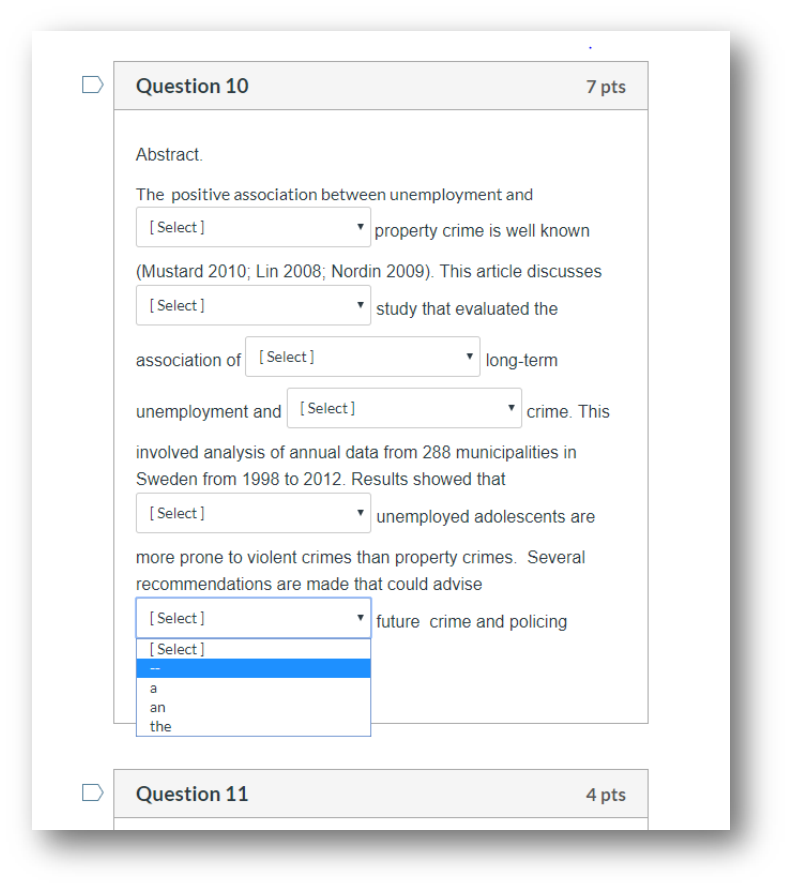
228
Multiple dropdown quiz questions were created and then uploaded to the university’s Canvas
VLE quiz tool. As shown in Figure 69, all dropdown menus gave a choice of four answers
(one correct answer, three incorrect).
Figure 69: Example of multiple dropdown question
In order to test the hypothesis that pre-qualification would affect article omission, students were
presented with ten countable nouns in twenty different contexts, firstly in simple noun phrases
and then as head nouns in pre-qualified nominal groups. Having identified the ten nouns that
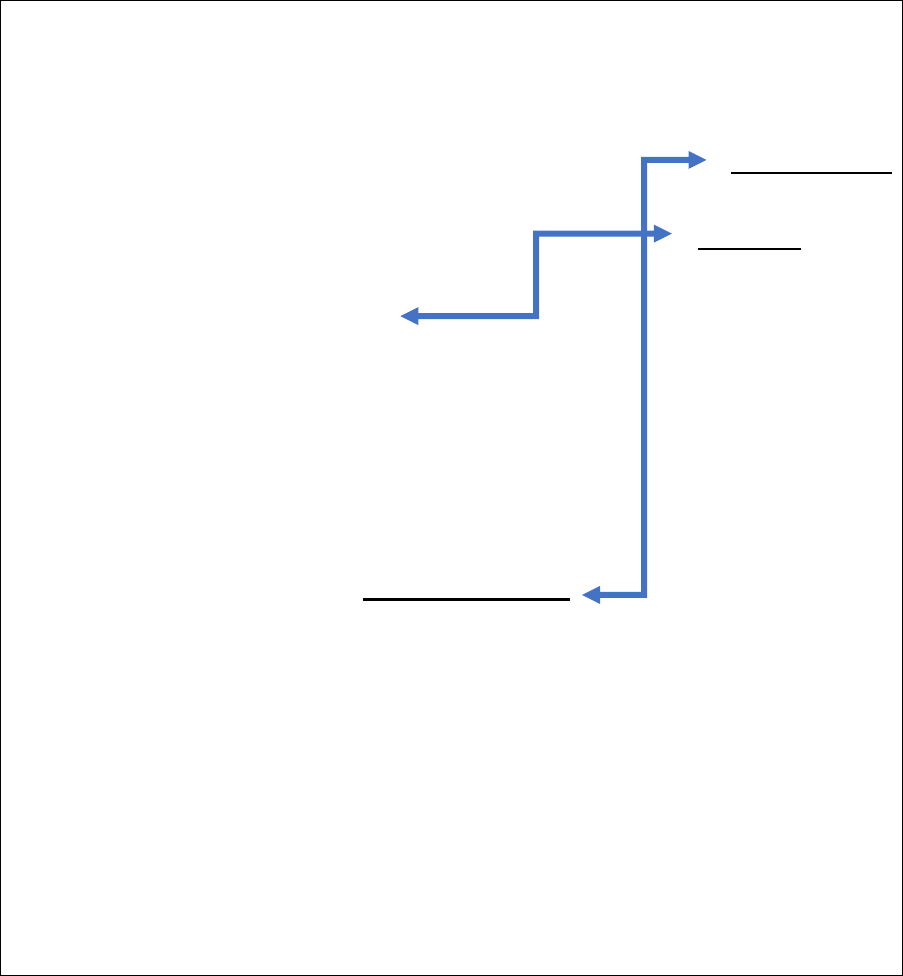
229
were either found twice in the same text or could be added to other texts of similar difficulty,
six of the nouns were found in juxtaposed forms while four required a few simple
manipulations. Figure 70 shows how ‘system’ was presented twice in one text (Question 4)
while ‘scale’ occurred in two texts (Questions 4 and 6).
Question 4
Abstract
[ ] pain is a part of childbirth. However, there had been very few studies into relative
perceived pain levels at childbirth before 2015. Thus little is known about [ ] scale of pain
that different women feel. Even in recent years, although there have now been [a] few
empirical studies, there remains little research with the rigor and scale required to
scientifically examine this crucially important area. Moreover, without [ ] system to
reliably compare findings, researchers struggled to measure subjective self-reported
perceptions and Teale's (2015) study was the first project to propose [ ] severity of
perceived pain classification system. While there are still today only [a] small number
of research projects investigating this area, interest is growing in this promising research
field.
Question 6
Abstract
This article seeks to acknowledge [_] fear as a strong presence in [_] workforce by
identifying from whence it comes. It further seeks to offer clarity on how individuals
respond to [_] fear. For this research, [a] sample of 776 employees were posed 19
questions which were measured on [_] Likert-type scale. [_] questionnaire was
developed by [the] authors in the absence of any such measurement tool which blatantly
asks employees what makes them fearful in their place of work. Distributions of [the]
sample covered entry level, supervisor level, manager level, and senior manager level.
Results indicate that concerns over the opinion of their direct supervisor and the fear of
being fired or laid off are the primary fears of employees. [_] analysis indicates additional
categories or clusters of fear. This research recommends that manager-subordinate
relationships and communication must improve to foster an open environment which
reduces the instances of [_] fear.
Figure 70: Paired noun phrase examples

230
3. Preliminary checking of questions with L1 tutors
Five L1 English tutors agreed to review the questions and provide feedback about any answers
they disagreed with. The aim was to present students with dichotomous choices with only one
correct answer. In fact, in many academic writing contexts the/a/an/ Ø can be used
interchangeably with only a nuanced change in meaning (rather than unambiguous error), but
the quiz questions aimed to present students with unambiguous choices. Questions that were
answered incorrectly by two of the tutors were immediately discarded (on the assumption they
were ambiguous). Any questions with one incorrect response were taken back to the tutor for
discussion (and only included if they agreed with the answers given by the researcher and four
other tutors retrospectively).
4. Pilot of quiz with L2 students
20 volunteer students took the quiz and gave feedback on the preliminary quiz interface which
included 30 texts and 150 cloze choices.
5. Final review and development
Based on feedback that the original quiz was taking students too long to complete, the quiz was
reduced in size to 20 texts with 100 cloze article choices in order to encourage maximum
participation. As a result, the proportion of article error types was amended: 6% Type 1 generic
contexts, 33% Type 2, 32% Type 3, 25% Type 4, 15% Type 5.
6. Reliability checking of quiz with L1 tutors
In the final development stage, three further L1 English tutors agreed to take the completed
test. Scores ranged from 97-99%, with a 96.67 pairwise agreement and a Fleiss kappa of 0.93.
Two quiz items that were not answered correctly by all tutors (signifying ambiguity of choice)
were further modified.
231
7.2.2 Ethical considerations
As requested by the University of Birmingham Ethics Board (ERN_14-1455, ERN_16-1493)
it was made clear to students that they did not have to consent to the use of their review test
data by the researcher. First, a brief 10-minute overview of the research project was presented
to the students at the end of their VLE induction on their first or second day on the Presessional
course. Students were given some background information (see Appendix 4) about the
research and several assurances about how their data would be used. Rather than ask students
to sign a form under pressure, the form was only presented to the students, by the class teachers,
at the end of the second week of the presessional programme without the researcher present.
7.2.3 The participants
The participants in this study were all enrolled on the postgraduate level EAP PG 10-week
Presesional programme at the University of Birmingham between 2015 and 2017. Each year
this programme, which runs from June to September, teaches general academic English four
days a week and an ‘English in My Subject’ module about various disciplines one day of the
week to 500 - 550 postgraduate students. The IELTS entry scores on entry to the Presessional
typically range from 5.0 (overall) to 6.5 (overall). On successful completion, students progress
to all schools across the university (apart from the Business School which is served by the
aforementioned BME programme).
This programme was chosen, rather than the BME or undergraduate programme, because 1)
the researcher was then on the management team of this course and had responsibility for the
VLE and 2) the course was an early adopter of an online blended approach to learning. This
blended approach involved a weekly online review quiz on the university VLE which tutors
used to monitor learning and progress. Moreover, Unit 1 of the programme covered

232
nominalisations and article use, thus adding questions about article use to their week 1 review
quiz was a justifiable addition to the materials.
Final participant numbers
Of the 1423 students who took the review quiz between 2014 and 2016, 466 L1 Chinese
students consented for the use of their data in this study. Eleven students were seen to spend
less than 10 minutes in the quiz interface (i.e. had not engaged meaningfully with the quiz) so
their results were removed, leaving the quiz results of 455 participants who engaged fully with
the quiz. These quiz results were added to the a spreadsheet with information about the
students’ IELTS scores.
7.2.4 L2 English proficiency levels
By 2015, due to the massive expansion of numbers, the Presessional programme was no longer
using a placement test on entry to identify students requiring further language support (now
offered on a teacher referral basis). Therefore, this study used the students’ IELTS results as
the most appropriate measure of English L2 proficiency. With overall IELTS bands ranging
from 5.0 to 6.5 (four levels), statistical tests could be applied with significance that could not
be achieved in previous studies (with only two IELTS band levels).
As shown in Figure 71 below, the overall IELTS results of the participating students (n=455)
included IELTS level 5.0 (34 students), 5.5 (205 students), 6.0 (201 students) and 6.5 (15
students) IELTS bands.
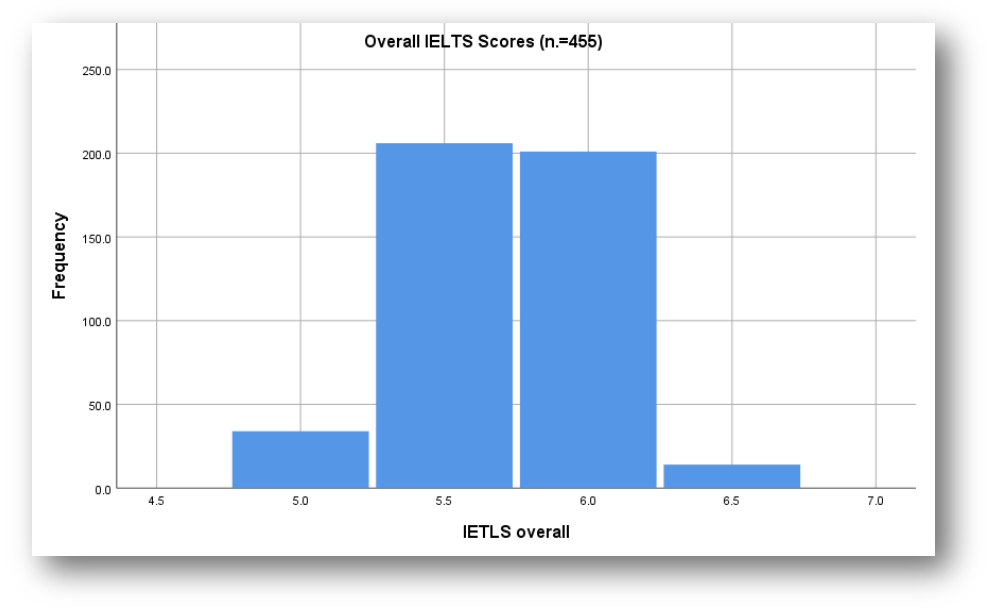
233
Figure 71: Histogram showing overall IELTs scores
However, as this thesis is focussed upon written accuracy rather than listening/speaking/
reading comprehension, the main measure of writing proficiency level used in this study was
the IELTS writing band achieved by these students prior to arrival. As presented in the
histogram in Figure 72, the IELTS results of the 455 students who took the article use quiz
included IELTS writing scores of 4.5 (4 students), 5.0 (105 students), 5.5 (239 students), 6.0
(90 students), 6.5 (11 students) and 7.0 (6 students). As shall be acknowledged in the findings,
the extremely small number of participants in the IELTS 4.5, 6.5 and 7.0 levels means that the
results are more representative of IELTS levels 5.0, 5.5 and 6.0 levels than others.
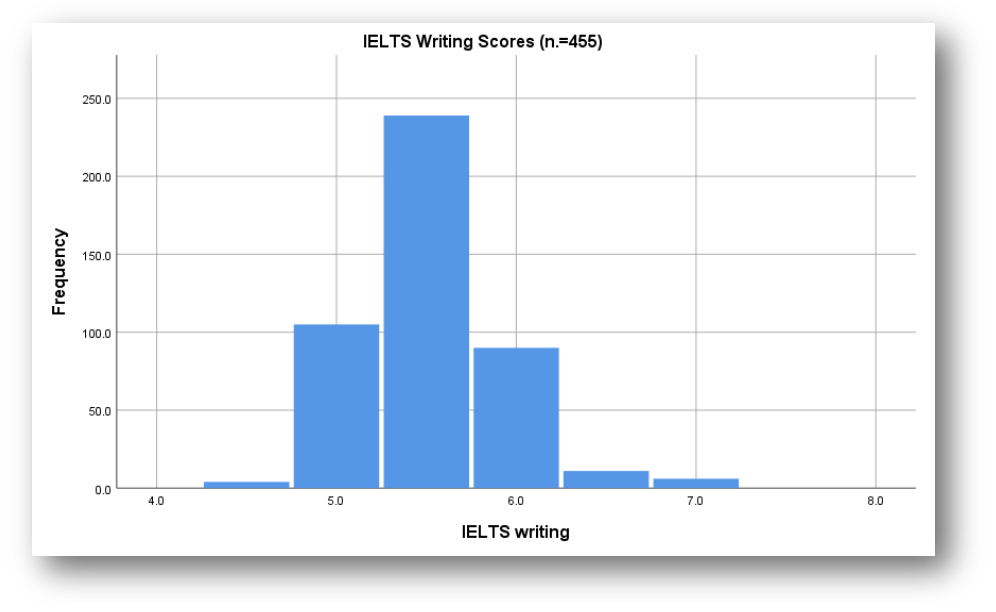
234
Figure 72: Histogram showing IELTS writing test scores
7.2.5 Procedures
The 100-item article use multiple-choice test was inserted into Unit 1 of the Virtual Learning
Environment (VLE) between the end of the first week and the end of the second week on the
10-week EAP PG programme. Generally speaking, the review quizzes on the VLE do not form
any part of the course assessment and there is variation in the extent to which individual tutors
make the quizzes optional or mandatory for their individual classes (e.g. some tutors use the
analytics to inform discussions in tutorials with students while others do not). Students could
not see their feedback about their quiz responses/the quiz answers until the quiz was closed at
the end of Week 2.
7.2.6 Data analysis
No other attempt was made to remove ‘outliers’ or ‘clean the data’ in any way other than
removing 11 students who has spent fewer than 10 minutes on the quiz. After removal of these
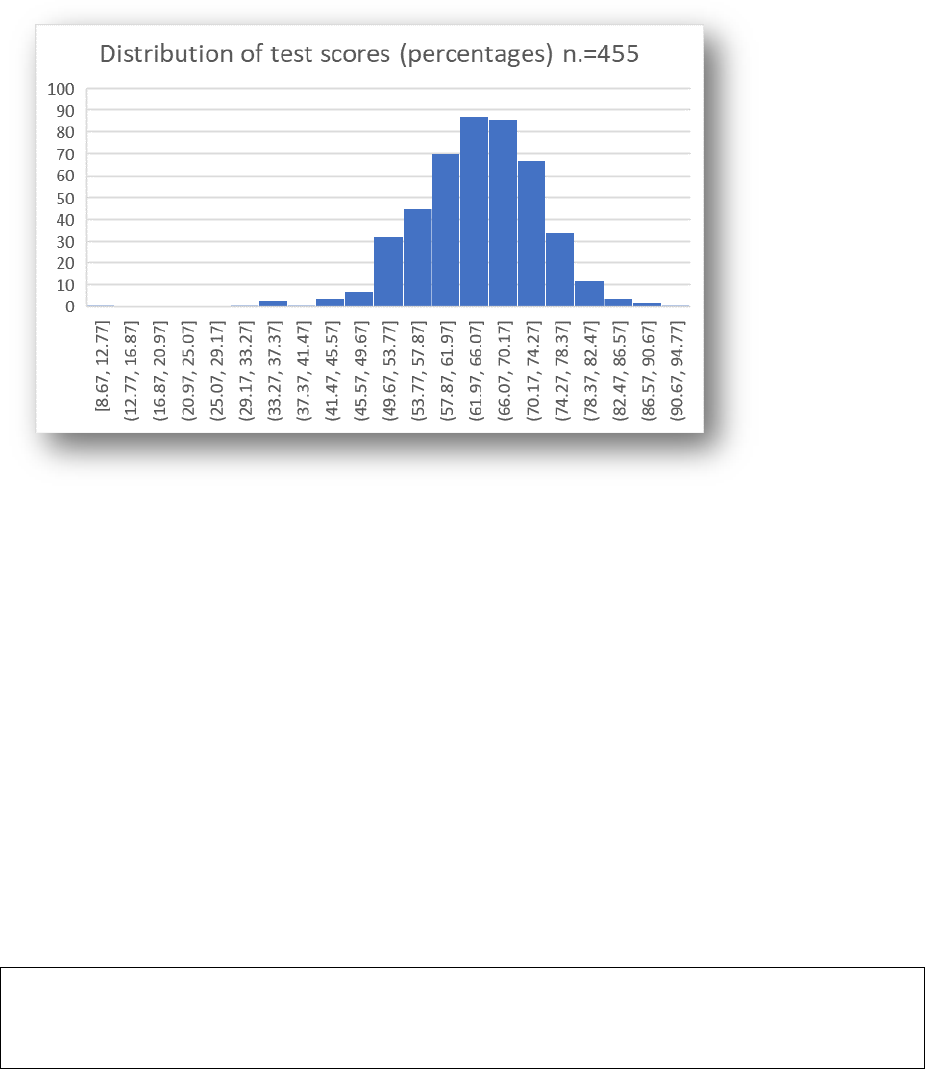
235
11 respondents the distribution of the percentage of correct responses (mean 64.63, sd 8.67) of
the remaining 455 participants was reviewed, as illustrated in Figure 73. Although the
histogram appears normally distributed at first sight, a Shapiro-Wilk Test of Normality (see
Appendix 10, Figure 96) showed that the distribution was not statistically normal (p value of
0.12). Non-parametric statistic tests were therefore used for this study.
Figure 73: Histogram of test scores
After downloading students’ responses from the Virtual Learning Environment to a
spreadsheet, various question groups were further summarised using Microsoft Excel formulas.
The researcher then checked the spreadsheet for data-entry errors and a colleague did a small
audit to check for formula error.
7.3 Findings and discussion
7.3.1 Hypothesis 1
Overspecification of definite articles in Type 1 and Type 4 generalisations (in which L1 writers
would use Ø) is a frequent error and will observed at IELTS 6.0 and 6.5 levels of proficiency
among Presessional programme students.
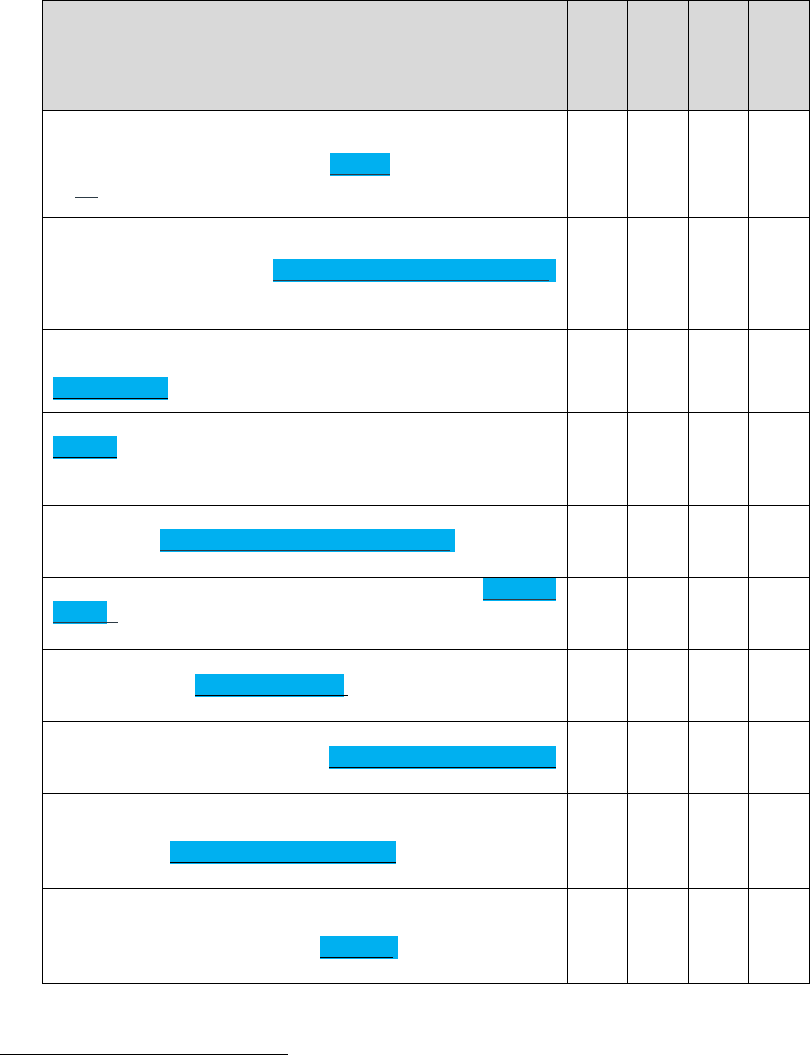
236
As hypothesised, overspecification of definite articles was an extremely frequent error
produced in the multiple-choice test. Indeed, as Table 29 shows, over half the respondents
chose a redundant definite article (an error as judged by five L1 English tutors) in three of the
Table 29: Results of ten questions investigating oversuppliance (n=455)
Question extract from fuller text shown to students
%
The
%
Ø
✓
%
Other
NR
5
Abstract
This article seeks to acknowledge [_] fear as a strong presence
in [_] workforce by identifying from whence it comes.
31
43
22
3
Abstract
The article discusses how [_] latent semantic analysis (LSA)
can be used to analyze electronic health records to show…
54
28
16
2
Compared to the service sector, the UK has witnessed a decline
in [_] industry since the 1950s.
50
35
14
1
Abstract
[_] pain is a part of childbirth. However, there had been very
few studies into relative perceived pain levels at childbirth
before 2015.
18
70
10
2
(end of paragraph) Several recommendations are made that
could advise [_] future crime and policing policy.
53
27
18
2
(end of paragraph). [__] results support the notion of [_] direct
effects of the performance appraisal characteristics on the
consequence variables.
46
33
19
2
(Start of abstract) [_]Cluster analysis is often used for [_]market
demographics segmentation.
39
45
11
3
[_] Cluster analysis is often used for [_]market demographics
segmentation.
38
45
14
3
(Abstract). This article discusses [_] study that evaluated the
association of [_]long-term unemployment and [_] crime.
23
15
60
2
This article discusses [_] study that evaluated the association of
[_]long-term unemployment and [_] crime.
35
49
13
3
5
NR = no response
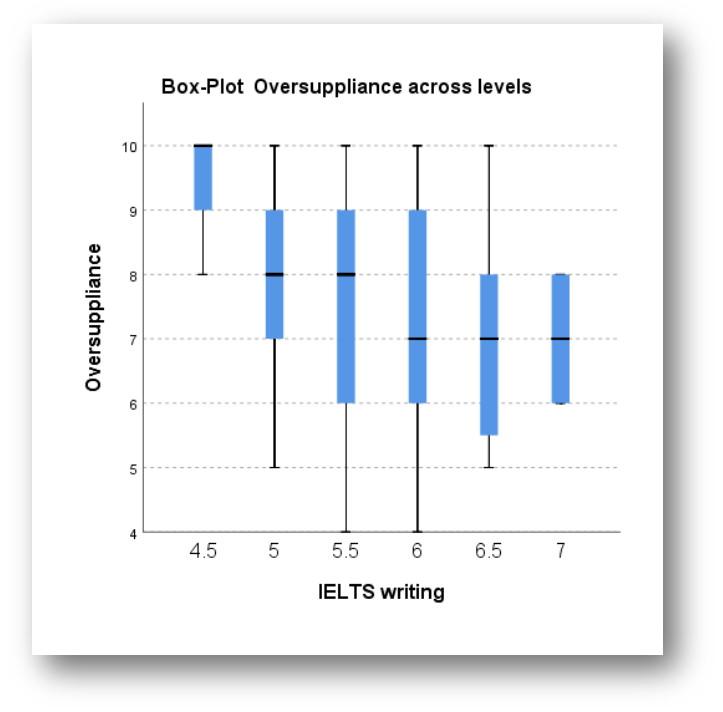
237
ten questions testing overspecification in Type 1 and Type 4 contexts. Of equal importance, in
all but one of the nine prompts, fewer than 50% of respondents correctly opted for Ø article
(the article judged as most appropriate by five L1 English tutors).
Students’ writing proficiency, as measured by their IELTS writing grades, had no significant
effect on their scores in the ten questions testing overspecification. A marginal effect can be
observed between IELTS level 4.5 and IELTS level 6, as presented in Figure 74 below. This
shows the median number of oversupplied definite articles dropped from 10/10 to 6/10 between
IELTs level 4.5 and 6.0. However, the scores show great variance and students with IELTs
6.0/6.5 and 7.0 made an equal median number of overspecifications with the definite article.
Figure 74: Oversuppliance (ten questions) box-plot (n=455)

238
In fact, Figure 74 shows the Mdn score (7/10) remained constant between IELTS 6, 6.5 and
7.0 writing levels. As a result, analysing the results of all six groups with an Independent-
Samples Kruskal-Wallis test, no significant differences (P ≤ 0.05) were observed in the
frequency with which students at different IELTS levels oversupplied definite articles (H
(5)=9.330, n=455, p=.097). However, while these findings may be representative of the
Presessional cohort of students, reliable generalisation to the wider population in HE would
need more representative samples of students at the lower IELTS 4.5 and higher IELTS 7.0
levels.
Notwithstanding the likely effect of proficiency at lower levels, the fact that overspecification
remained an issue for students with IELTS writing scores of 6, 6.5 and 7.0 provides tentative
evidence to support the view that, at least at the start of their programme, many B2 Chinese
students may oversupply definite articles with certain words in Type 1 and Type 4 contexts.
7.3.2 Hypothesis 2
Omission errors will be more frequent in contexts of pre-modified noun phrases than simple
noun phrases.
Table 30 presents the percentages of omitted articles in ten paired nominal groups (simple noun
phrases and pre-modified noun phrases). Pre-qualification has a negative impact on accuracy
in eight out of the ten noun phases, particularly with regards to the nouns algorithm, scale,
industry, and system with omission rates of 23%, 20%, 23% and 28%, respectively. A
Wilcoxon Signed Rank test showed that the differences between students’ accuracy of articles
with simple noun phrases and the same students’ accuracy with pre-qualified noun phrases
were highly significant (P ≤ 0.01, Z=12055, n=455, p=.000).

239
Table 30: Articles omitted in twenty nominal groups (with and without pre-modification)
Nominal Group
Type
Omission
%
Correct
%
Other
%
% No
Response
[an] algorithm
Simple
6
83
10
1
[the] clustering algorithm
Complex
23
72
2
3
[a] pilot
Simple
4
92
2
2
[a] long haul passenger airline pilot
Complex
7
87
4
2
[a] month
Simple
0
97
2
1
for [a] third consecutive month
Complex
3
95
1
1
[a] scale
Simple
2
95
0
3
[a] Likert-type scale
Complex
20
76
1
3
[the] industry
Simple
10
85
3
2
in [the] car manufacturing industry
Complex
23
66
9
2
[the] system
Simple
14
74
10
2
[a] severity of perceived pain classification
system
Complex
28
67
3
2
[the] law
Simple
7
90
1
2
[a/the] particular law
Complex
5
88
5
2
[the] method
Simple
6
91
0
3
[the] active learning method
Complex
11
87
0
2
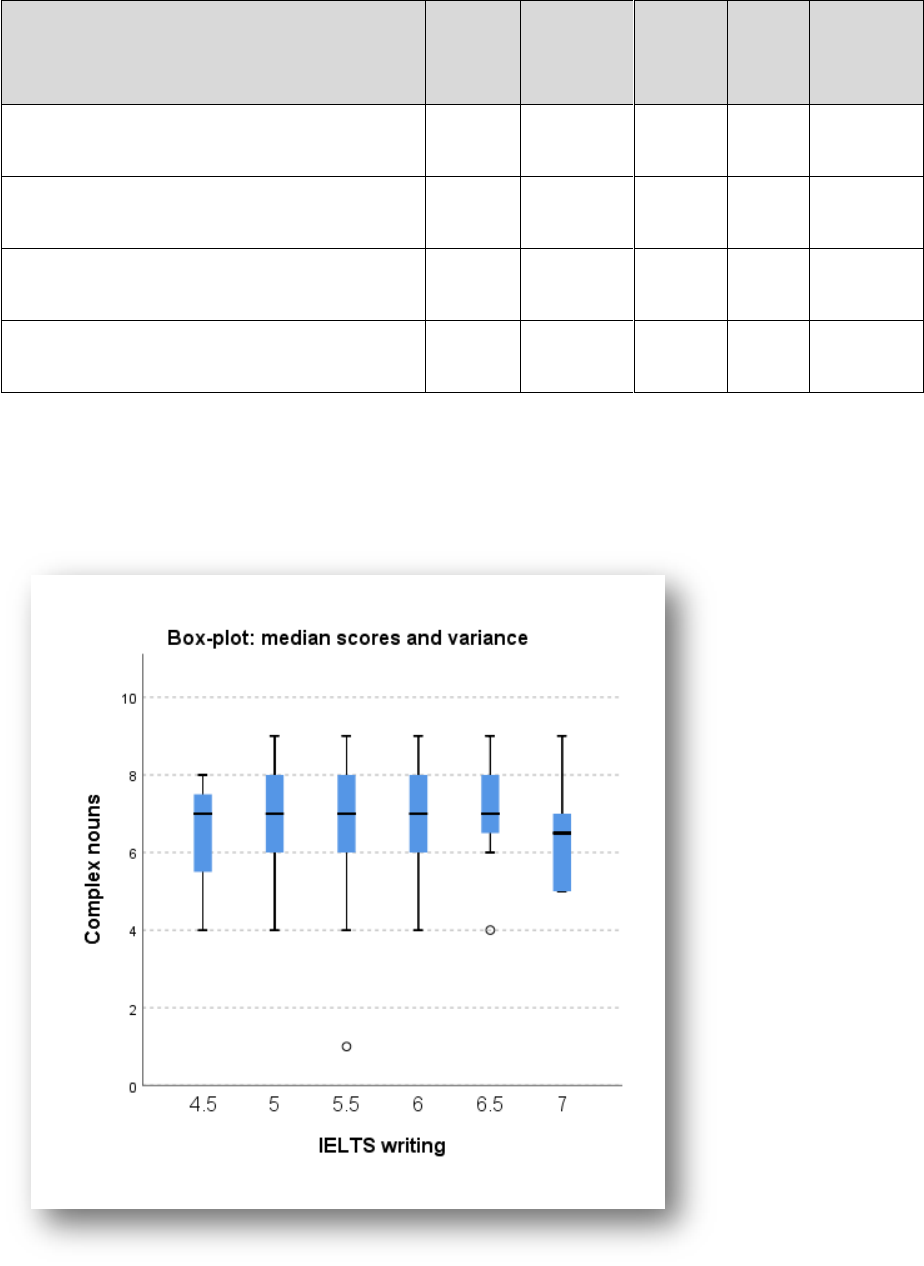
240
(Table continued) Nominal Group
Type
Omission
%
Correct
%
Other
%
% No
Response
[the] market
Simple
4
89
5
1
[the] housing market
Complex
10
76
11
3
[a] change
Simple
4
89
5
2
[a] rapid change
Complex
2
93
3
2
The effect of English writing proficiency level on the issue of omissions in article use was more
complex, as illustrated in the boxplot shown in Figure 75. In terms of simple nominal groups,
Figure 75: Boxplot of omission rates (grouped by proficiency) in complex noun phrases

241
students with higher IELTS writing scores scored better in the ten questions involving simple
noun phrases (a median of 8/10 correct) than the students with the lowest IELTS writing scores
(median 6.5/10). A Kruskal-Wallis test showed significant differences (P ≤ 0.05) between the
students’ scores with the ten words within simple nominal groups when grouped by IELTS
writing proficiency scores (H (5)=13.195, n=455, p=.022). However, when these same ten
words were placed within pre-qualified nominal groups, writing proficiency level no longer
had a significant effect. As shown in Figure 75, the students scored a median of 7/10 in all
groups and a Kruskal-Wallis test showed no significant (P ≤ 0.05) differences in the variances
(H (5)=3.346, n=455, p=.647).
7.3.3 Hypothesis 3
A student’s proficiency level on entry to the Presessional (as measured by IELTS writing
tests) will be related to their accuracy of article choice at the beginning of the programme
The Mean score in the 100-item test overall was 64.67% (with a Standard Deviation of 8.66).
As presented in Figure 76, IELTS writing scores appeared to be positively associated with test
scores. A Spearman's rho two-tailed test showed there was a moderate positive correlation
(highly significant at P ≤ 0.01) between IELTS writing band and overall scores in the 100
question quiz (r
s
=.306, n=455, p=.000), with students at higher proficiency levels showing
greater accuracy in the quiz. Furthermore, a Kruskal-Wallis test (P.= 0.000) showed that the
differences between the median values of the students grouped by IELTS writing test score
were significant (H (5)=25.222, P ≤ 0.01, n=455, p=.000).
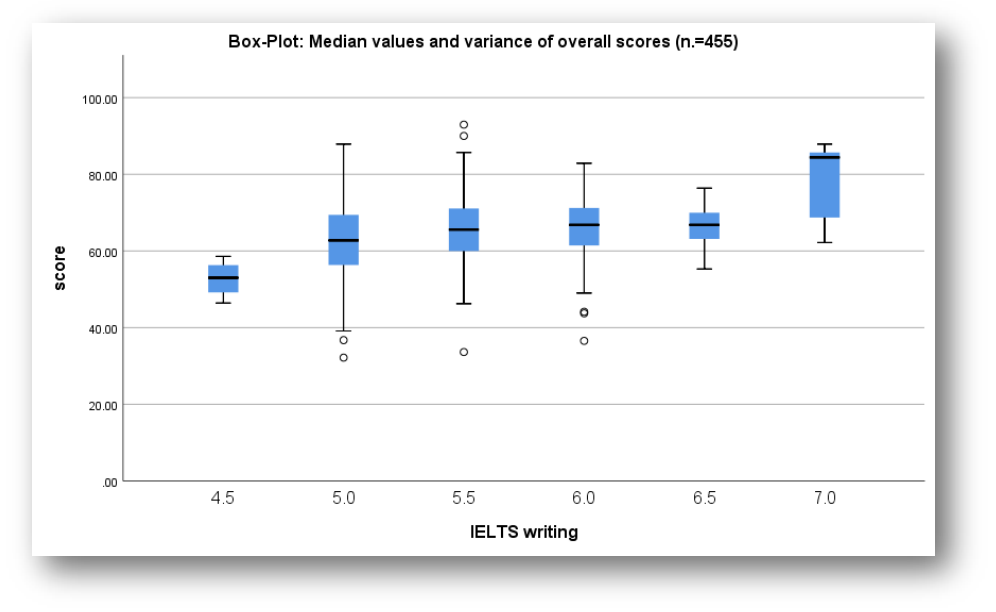
242
Figure 76: The relationship between general writing ability and overall test scores (n=455,
100 question items)
7.4 Conclusion
As predicted, a testing approach has enabled focussed attention on the ‘problems’ students have
with articles rather than revealing their generally correct use as highlighted by the corpus-based
studies in earlier chapters. The mean score of 64.67% should not be interpreted as a measure
of students’ accuracy since the students faced many more complex choices than they would
normally find in academic writing. Moreover, the methodology could also be criticised as also
testing students with items of vocabulary (e.g. ‘scale’, ‘system’, ‘industry’) that the corpus-
based study had identified as challenging – in effect setting the students up for failure.
However, results of the testing approach have given some insights into the extent to which
243
different types of article errors are affected by proficiency level and some of the possible causes
of error.
As hypothesised, on entry to the university Presessional L1 Chinese students frequently over
supplied definite articles in Type 1 and Type 4 generalisations (in which L1 writers would use
Ø) at all levels of entry proficiency. The statistical tests presented in this study provide some
evidence that this tendency to oversupply definite articles in general statements and claims
about a topic were not significantly linked to their general writing ability. Further replication
of this study with greater numbers of students with IELTS grades 6.5 – 7.0 is necessary, as the
vast majority of the students in this study had IELTS 5.5 - 6.0 overall levels of English
proficiency and it is likely that the small number of higher level students skewed the results.
Nevertheless, as most students arrive on UK presesssionals with IELTS 6.0 levels of English
(and many students start UK academic programmes each September with this score), this
finding is noteworthy. Faced with unfamiliar new topics and vocabulary students appear
unaware of the nuances of register caused by overspecification. Their likely strategy of adding
a determiner ‘if in doubt’ may explain the impression reported by other researchers of an overly
oral tone in Chinese students’ L2 academic English writing (Cobb, 2003; Hinkel, 2003;
Granger, 2004; Mayor, 2006; Gilquin & Paquot, 2007; Lee & Chen 2009).
On the one hand, the quiz items used in this study were ‘cherry picked’ from previous errors
and the low scores certainly exaggerate the extent to which students make article errors in
normal writing. Moreover, it is not suggested that the omission errors in dense noun phrases or
overspecification errors affect Chinese L1 students uniquely. Indeed, other L1 background
students are likely to make such errors, as may L1 English home students albeit to a lesser
extent as they are also novice academic writers who may present a conversational tone on entry
to university but will learn to show progressively greater register awareness throughout their
244
academic programme. However, article-less L1 background students may find the issue of
using bare noun phrases in general statements (after specifying the noun phrases in detailed
examples earlier in their writing) particularly confusing. Thus, the finding does provide some
support for the argument that register awareness, which is generally agreed to be a central tenet
of EAP teaching, should be extended on Presessional programmes to include the effect of
article use. Students with article-less L1 backgrounds may arguably need extra help in building
their confidence to use Ø articles. Interestingly, these students appear to lack the confidence to
apply the identical Ø + bare noun structure in L2 English that is required in non-referential
contexts in their own L1. By making greater reference to how expert writers move from specific
examples (with a/the) to generalised statements (with bare uncountable nouns and plural count
nouns) in academic texts, students could be helped to notice in parallel both the general-
specific text structure and the pragmatic choices of article use which these moves of focus
entail.
With regard to the second hypothesis, this study provided some evidence that pre-modified
noun phrases are more strongly associated with omission errors than simple noun phrases. The
Chinese students in this study made more omission errors when the head noun was obscured
by the use of different pre-modifiers. This supports Biber & Gray’s (2010) view of academic
language posing unique challenges to learners because of its ‘compressed’ nature. Moreover,
while students’ accuracy with articles in simple noun phrases was associated with proficiency
level, no significant relationship was shown by proficiency to their use of articles in more
complex nominal groups. This finding suggests that Chinese learners have no problem with the
grammatical rules in Type 2 and Type 3 contexts when applied to simplified language (or the
prototypical examples in grammar books), but have less accuracy in authentic academic
English. In short, it appears that it is not the rules of grammar but the application of these rules
245
in densely packed noun phrases that students find challenging, particularly when academic
texts obscure grammatical choice. This would lend weight to the argument that L2 students of
English for academic purposes need help noticing these dense nominal groups in academic
English (Fang, Schleppegrell & Cox, 2006). It would appear that academic writing and its
nominalised abstractions can obscure grammar mappings for L2 English learners in the same
way as they have been shown to obscure meaning (Halliday, 1985; Halliday and Martin, 1993).
Replication studies with a far greater number of paired noun phrases are now required. It is
also acknowledged that the effect of sentence structure and transitivity was not controlled in
article quiz questions. Nevertheless, these findings taken in parallel with those of the corpus
study findings show one possible cause of article omission for Chinese students that could
usefully be drawn attention to in EAP textbooks.
Finally, this study has investigated the effect of general writing proficiency on Chinese
students’ confidence in selecting the correct article across all types of article. In terms of article
use in all contexts (including idiomatic use and proper nouns), students’ scores in the test were
highly correlated with their IELTS writing scores. On the one hand, it therefore appears that
Chinese students show greater accuracy in their decisions in tandem with their greater general
confidence in written English. However, this effect was not significant in relation to their
overspecification of articles in Type 1 and 4 contexts or omission of articles in complex noun
phrases. Given the very small number of the lowest IELTS 4.5 level and advanced IELTS 7.0
level students, these results should be treated with a degree of caution. There is a clear need for
future studies that can recruit higher numbers of the lowest and highest proficiency level
students (and thus represent the overall population of Chinese L1 students in HE).

246
The theoretical implications of these three main findings are developed in the next chapter
along with some recommendations. One final methodological conclusion suggested here is
that a testing approach has been shown to complement the findings of a corpus-based study.
Particularly with regard to oversuppliance and the challenges involved in reliably
distinguishing between redundancy (dispreferred forms) and inappropriacy (error), this
methodology has helped to investigate two hypotheses developed from the earlier corpus-based
studies. It has been argued that while only corpus-based studies can identify actual features of
student writing and demonstrate how accurate students are in different contexts, such a testing
approach can complement and provide more nuanced understanding to the hypotheses made in
studies using learner corpus methodologies.

247
8 CONCLUSIONS
8.1 Restatement of aims
This research project had four main aims. First, it aimed to investigate how EAP tutors
currently teach or correct English article errors in academic writing. Second, it sought to
examine whether pedagogical interventions have any effect on article accuracy. Third, it
focussed on the sorts of English article errors made by Chinese L1 students (with Upper-
Intermediate English L2 levels) on entry to UK universities. Finally, it aimed to identify the
reasons why some article uses challenge these learners. As stated in the introduction, a greater
knowledge of the challenges created by the English article system for Chinese learners and a
clearer understanding of whether and how accuracy can be accelerated would help EAP tutors
to integrate a focus on articles within a student centred text-based/data-driven approach and
avoid less effective practices such as overcorrection of article uses in a manner that does not
lead to greater accuracy. This concluding chapter will first summarise the findings related to
each research question, then evaluate some of the limitations and needs for future research
before ending with some practical recommendations for the EAP tutor. As the final comments
will explain, these recommendations will support the argument made in the introduction that
an occasional lexico-grammatical focus on the article system (fully integrated within a genre-
based approach) can be consistent with the emphasis on text structure, functional moves, genre
and register awareness that is typical of the text-based/data-driven approaches most advocated
in the literature.
8.2 Summary of main findings
Contrary to some EAP tutors’ assumptions demonstrated in interviews, it is necessary to stress
the extremely high accuracy that B2 level Chinese L1 students demonstrated in the majority of
authentic academic writing tasks. While this research has investigated ‘problems’ of article
248
use for Chinese learners and suggested that certain challenges faced by Chinese learners may
be influenced by their L1, the majority of the errors and variables examined in this research
have identical causes to those made by all L1 groups of L2 English learners. In fact this
research project has confirmed that most uses of articles in academic writing are affected by
variables that concern all students equally: general level of proficiency, familiarity with the
topic lexis, genre of the task and the extent to which their attention is consciously focussed on
article accuracy.
However, the findings in this research equally do not support a naturalistic assumption that
Postgraduate Chinese learners’ article errors will ‘sort themselves out’ without intervention by
the time the students need to submit their dissertation or thesis at the end of their academic
programme. The corpus-based studies and the testing methodology in this research showed that
Chinese L1 students with IELTS 6 and 6.5 levels of academic writing continue to make article
choice errors in L2 English academic writing and that these errors sometimes contribute to an
informal tone in their writing. While the evidence in Chapter 6 supports the view that it is well
within these students’ ability to use articles more accurately in simpler descriptive tasks (such
as the case study genre) when they are fully familiar with new vocabulary, Postgraduate level
students will be required to use sources and levels of abstraction beyond that of case study
reports later in their studies and it is likely that their article issues will surface again, as they
return to unfamiliar topics with less specific referents.
On the one hand, students’ more in depth research and background reading affords greater lexis
familiarisation and knowledge of colligations, which will contribute to growing article
accuracy during their studies. On the other hand, students could be helped by leaving the
presessional programme with the autonomous learning skills that enable them to acquire,
record and learn new vocabulary in their discipline with attention to register awareness and

249
how a topic’s terms are generalised. Through EAP reading paradigms, students might also
usefully be taught how to notice the pragmatic effect of articles. If students can leave
presessional programmes with the independent confidence in proofreading their work with
attention to head nouns in dense nominal groups, perhaps distant from their determiners, their
EAP tutors will have contributed greatly to accelerating students’ accuracy in academic
writing.
8.2.1 Research Question 1
To what extent do EAP teachers in Higher Education programmes in the UK explicitly teach
or correct English article use?
The answer to this question that emerges from the research reported in this thesis is that most
EAP tutors teach and correct article use in L2 academic writing while only a small minority of
tutors totally ignore the issue. While explicit teaching in a decontextualised ‘rules’ based
approach is less common, many tutors use consciousness- raising techniques in reading classes
or frame attention to articles within proofreading skills sessions fully compliant with the
authentic text-based approach in EAP. Moreover, many tutors use student-centred approaches
to error correction (guided self-correction and peer marking) that again appear informed by
EAP best practices. Unfortunately, however, many teachers also overcorrect article use in a
more traditional manner that is arguably less consistent with contemporary recommended EAP
approaches, either because they perceive students expect such corrections or because they
assume that corrections lead to learning.
Chapter 4 characterised five types of strategic response to article errors among EAP tutors by
the presentation of five ‘teacher types’: 1) tutors who teach English articles within EAP text-
based best practices, 2) the optimistic ‘rule giving’ teacher, 3) the ‘proofreader’ (error hunter)
250
4) the reluctant corrector and 5) the principled ignorer. Most teachers surveyed in this study
reported data-driven approaches, noticing techniques and text-based approaches within the first
‘EAP paradigm’ category. However, a smaller number of tutors continue to use prototypical
grammar exercises that are most consistent with decontextualised approaches within an EFL
paradigm. These tutors appear to believe that Chinese students do not understand the concept
of article use and, assumedly, that they can succeed (where others have been unsuccessful) by
providing what they believe to be a better/simpler explanation of article rules. ‘Reluctant’ error
correctors do not wish to focus on article use, due to their doubts about its usefulness or their
own lack of confidence in the article system, but feel obliged to do so in response to student
expectations. A small group of ‘principled ignorers’ appear to believe that any focus on article
accuracy is inconsistent with the best EAP practices or progressive World English arguments.
However, the survey in Chapter 4 suggests that only a small minority of EAP tutors have such
principled objections.
The findings in Chapter 4 pertaining to error correction showed that EAP tutors’ stated beliefs
about EAP principles and their reported best practices in teaching are sometimes inconsistent
with their indiscriminate correction of article errors in academic writing. Some EAP tutors see
themselves as proofreaders whose main role is to correct every error they see on the assumption
that students learn from frequent correction. In fact, the most common ‘teacher type’ identified
in the survey was a combination of Type 1 and Type 3 (teaching within the ‘EAP paradigm’,
but correcting errors with less regard to learner autonomy). That is to say, while many tutors
report many modern data-driven methods for whole class teaching and more student-centred
approaches to error correction (peer marking), many appear to supplement best practices with
the more traditional and questionable ‘mark all errors we see’ approach in their own written
feedback. This confirms earlier research that reports a tension between EAP tutors stated

251
positions/beliefs and their actual practices (Etheringon & Burgess, 2002; Barnard & Scampton,
2008).
The extent to which the different approaches taken by EAP teachers are validated in light of
this research is very much arguable. Although the studies presented here showed that teaching
and error-correction had a significant effect on article accuracy of a few types of article use,
this improvement was not sustained six weeks after receiving the corrections. On the one hand,
this may be less relevant to Presessional EAP teachers and their students who are facing high
stakes assessments at the end of the course (for which temporary improvement in accuracy is
arguably a valid focus). Yet some tutors may be persuaded to abandon the implicit assumption
that correction leads to sustained learning and devote the considerable time required for such
corrections by both teachers and students to more constructive parts of the feedback process.
In terms of the assumptions made by ‘ignoring’ teachers (that articles are eventually acquired
more accurately without intervention), this research has confirmed that most article uses are
strongly correlated with general writing proficiency. Nevertheless, certain errors
(oversuppliance in generalised statements and omission in pre-qualified noun phrases) were
less connected to proficiency. Thus, these assumptions of students improving naturalistically
without help are also not supported.
8.2.2 Research Question 2
What are the linguistic contexts of obligatory article use in which Chinese L1 students at
Upper-Intermediate levels of English L2 are most likely to make errors?
This question was addressed both in terms of raw frequency and in terms of the ratio of
correct/incorrect occurrences of articles in different contexts. The results of all investigations
252
presented here have shown that Chinese students achieved varying degrees of accuracy in
different contexts of English article use.
In terms of raw frequency, the errors in article use by Chinese L1 students were frequently
made by omitting definite articles or (next most frequently) by oversupplying definite articles
when inappropriate, confirming previous research in this area (Chuang & Nesi, 2006; Lee &
Chen, 2009). In terms of a/an articles, the corpus-based evidence in this research suggested
that omission was the more likely error, not redundancy. Finally, in contrast to the claim made
by Chang (2001), this research has shown misuse of ‘the for a/an’ or vice versa to be extremely
rare. However, when frequency of use is taken into account (and errors are expressed as a ratio
of correct to incorrect use), this research showed that Chinese students were marginally least
accurate with a/an articles, followed by the and lastly (most accurate) in Ø article contexts.
In terms of the Bickerton Framework used throughout this thesis, when writing short essays,
the corpus study presented in Chapter 6 shows evidence that Chinese students are most
challenged by the following article contexts (in order of difficulty): IDA<4IA<1IA<5DA=3ZA
<1ZA<2DA<3IA<4ZA<5ZA (see Sections 2.2.1 and 6.3 for explanation of Framework.
Interestingly, with the exception of a/an use in non-referential contexts (4IA), an inverse
relationship between accuracy and frequency of occurrence (Type 4>2>3>5>) can be seen in
this pattern, reinforcing previous research that has found the most frequently occurring
language items are the most quickly acquired (Larsen‐Freeman, 1976). A strong case could
therefore be made for grammar and EAP materials writers to pay greater attention to such rare
uses, to help learners notice them in their reading and less attention to the anaphoric references
so overrepresented in grammar (assuming simpler uses of article will be acquired naturally by
learners).
253
In Type 1 (generic) contexts Chinese learners at Upper-Intermediate English L2 level
frequently omit and oversupply articles and display lower accuracy in generic definite and
indefinite contexts than when discussing more specific Type 2 or Type 3 referents. This
broadly confirms previous research findings (Master, 1995; Snape, Leung & Ting, 2006; Ionin
et al., 2011; Crosthwaite, 2016a). While generic use (as defined in this thesis) is far less
frequent than other uses, in both Chinese L1 students’ and L1 tutors’ essays (6.4-11.7% of
articles) their function in EAP is pertinent, in as much as contribute to defining terms and
providing the background for topics. Given the complexity and difficulty of teaching generic
article use, some recommendations are made in Section 8.4.
It was found that indefinite articles in non-referential (4IA) contexts were the second most
inaccurately used context (a TLU of 0.71). More generally, Chapter 6 reported that indefinite
articles overall were the least accurately used article by the participants (in ratio terms). This
finding is contrary to that of Díez-Bedmar & Papp (2008) who found that Chinese students
were more accurate with indefinite than definite articles, but supports Master’s (1987) finding
that a/an mastery is acquired only at the latest stages of L2 development. The divergence in
this finding underlines the difficulty of comparing studies that define proficiency levels
differently (Díez-Bedmar, 2015). The relevance of this finding is that Type 4 contexts were
shown to be the single most frequent occurring article use context in the essays of both Chinese
L1 students and English L2 tutors. Chinese students’ relative inaccuracy with indefinite
articles, in addition to their frequent overspecification of definite articles in 4ZA contexts is
thus found in many of the most common language functions in academic essays: generalising,
discussing future scenarios and conditional clauses in non-referential contexts.
Leaving the Bickerton Framework analysis, one main finding of this research was that the
dense nominalisation that often characterises academic English (Halliday & Martin, 1993,

254
Biber & Gray, 2010, Bennett, 2011) was also associated with lower article accuracy among
Chinese L1 learners. Students made significantly more article omission errors in pre-qualified
nominal groups than simple noun phrases. Moreover, while there was a significant effect of
proficiency upon the number of article omission in simple nouns phrases, there was no
significant effect on the omission rate in complex noun phrases. As shall be explained in
Section 8.4, this finding has implications for the way students are taught proofreading skills.
8.2.3 Research Question 3
To what extent does the Chinese students’ L1 background affect (1) TLU and (2) their types
of article error?
It is often assumed that Chinese students (and students from other Asian L1 backgrounds) will
find articles particularly difficult to master because their first language does not have an article
system at all. However, conflicting findings in this research respectively support and challenge
the L1 transfer effect hypothesis.
There is some support for the assumption of L1 transfer from the students’ omissions of articles
in many generic article contexts. Students’ lower accuracy with generic definite articles (0.67)
than Ø generic context articles (0.86) in the three essays (Chapter 6) provides evidence for the
L1 transfer effect hypothesis. The corpus-based results in this research demonstrated that the
B2 level Chinese students had far greater accuracy with Type 2 definite and Type 3 indefinite
articles than Type 1 generic definite articles. Mandarin does have equivalent classifiers and
demonstratives – generic references are normally achieved through bare nominal singular
forms without measure words (Li & Thompson, 1981). Therefore, the hypothesis that this
difference leads to a lack of positive transfer effects for definite generics while the equivalents
in 2DA, 3IA and 3ZA forms can create positive transfer effects (Snape, Leung & Ting, 2006;
255
Díez-Bedmar & Papp, 2008; Crosthwaite, 2016a) appears convincing. As Chinese has certain
demonstratives and classifiers that can be optionally used to pseudo grammatically determine
specific referents, this hypothesis claims that the use of English articles with specific referents
is less completely new to the students’ L1 parameters.
Evidence of negative transfer can also be inferred from the students’ relative inaccuracy in non-
referential Type 4 indefinite contexts requiring ‘a/an’. Chinese does not allow for the use of
any classifiers in such contexts (Li & Thompson, 1981) and their greater issues in non-
referential contexts could be explained by L1 interference.
On the other hand, the students examined here also oversupplied the definite article in many
contexts in which Chinese generally uses a bare nominal, somewhat contradicting the idea that
Chinese students’ errors closely follow the article-less features of their L1. Contrary to using
the same bare nominal form in 4ZA contexts in a similar way to their L1, students were shown
to add redundant definite articles. Chinese students’ evidenced lack of confidence in Ø article
Type 4 contexts thus shows the complexity of L1 transfer effects. Interviews suggested that
Chinese students believed they have a choice of Ø or the in such generalised statements and
that the definite article has an emphasising function, somewhat reflecting the fact that
classifier/demonstrative use in Chinese is a choice rather than an obligation (Li & Thompson,
1981). It could be argued that article-less L1 background students lack pragmatic awareness
of article use (Díez-Bedmar & Papp, 2008). However, a simpler conclusion could be that
Chinese students frequently face challenging choices of whether to treat new vocabulary terms
as countable or uncountable and, when in doubt, often ‘gamble’ on the word being a countable
noun requiring a determiner. The hypothesis that students gamble on the language form being
the opposite to their L1 would be an interesting area for future research.
256
In terms of gravity of error, Chinese students’ overspecification of definite articles in Ø (4ZA
and 3ZA) context has been argued in this thesis to occasionally cause a spoken tone
inappropriate for academic essays. In interviews, Chinese students showed that they
sometimes failed to choose Ø + uncountable noun structures when they mistook the noun for
a single countable noun and Ø + plural structures with a misconception that they could add
emphasis through the use of definite articles. On the one hand, a strong argument can be made
that students of all L1 backgrounds face such errors given the rather arbitrary nature in which
different articles are permissible. Indeed, all novice writers (including L1 speakers) are likely
to develop greater confidence in register nuances as they become familiar with the discipline
specific lexis. However, a convincing argument can be made that article-less L1 background
students need greater help in building confidence of using Ø when generalising. The students
interviewed in this study reported a “nothing to lose” gambling strategy that had not been
expected at students at B2 levels of writing. By inference, EAP materials that juxtapose how
new lexis in their disciplines is determined in specific contexts but unspecified in general
statements (as outlined in Section 8.4) could be valuable.
In sum, as shown by the analysis based on the Bickerton Framework and again evidenced in
students’ greater accuracy in case studies than essays, the more specific the referent (in equal
contexts of lexical density), the more confidence Chinese students seemed to show in article
choice. This greater confidence in specific contexts may be somewhat influenced by positive
L1 transfer effects. However, this thesis concludes that L1 is a minor contributor to most
errors and, counter-intuitively, students do not use positive transfer effects (bare nominal
forms) in many expected contexts. Questioned about errors made in their essays, most
interviewed students appeared to make errors due to unfamiliarity with the lexis, confusion
caused by the dense nature of academic language and the grammatical characteristics of the

257
head noun. As such challenges are shared by all L1 background students, this thesis supports
only a weaker form of the contrastive language hypothesis (L1 contributes to some forms of
error but is not the main effect).
Research Question 4
Does the explicit teaching or correcting of English article usage lead to more target-like use
of articles by Chinese L1 university students whose L2 English displays inaccuracy?
On the one hand, by the use of a control group that had no extra attention focussed upon articles,
Chapter 5’s findings showed that teaching article use or correcting article use can have a short
term significant effect of increasing students’ accuracy of article use in some contexts. In
particular, improvements in definite article accuracy (and the reduction of overspecification
errors) were significant when the teachers focussed students’ attention on article use. These
findings therefore to some extent support the claim that explicit teaching can improve students’
accuracy (Master, 1990; Master, 1995; Master, 1997; Bitchener & Knoch, 2008) and that error
correction reduces inaccuracy (Ferris, 1999; Chandler, 2003; Bitchener, Young & Cameron,
2005; Ferris & Kurzer, 2019). However, the improvements were not sustained six weeks after
the extra attention had ceased. This adds weight to the idea that teaching and article correction
improve article accuracy only for as long as consciousness is raised (Master, 1997).
For teachers who employ the ‘scatter gun’ approach to article error correction, especially on an
assumption of sustained learner improvement, rather than a temporary impact on surface errors,
this finding may have some relevance. In fact, many reasons can be given for discouraging
teachers from the excessive written correction of all errors. Over and above the temporary
effect of error correction, Chapters 4 and 5 have highlighted the challenge of the reliable
identification of article errors and there is likely to be a strong risk of unhelpful miss-
258
corrections if tutors try to mark work hastily since accurate error correction is extremely labour
-intensive. Several students also reported that they felt discouraged and embarrassed by article
corrections and this attitude is likely to have been under-reported. Occasional focussed error
correction, especially in a peer feedback context as highlighted in the recommendations, may
be justifiable. However, given the equal impact upon article accuracy of teaching, a strong
argument is made here for the preference of simple attention focussing activities (e.g. teaching
of common patterns or highlighting of examples of frequent error types on the board).
8.3 Limitations and future research
The variable most difficult to control throughout this research has been the important influence
of topic and vocabulary familiarity upon article use. The effect of task prompt was admittedly
underestimated at the study’s design stage and has since been shown to massively impact on
measures of article accuracy (Díez-Bedmar, 2015; Crosthwaite, 2016a, 2016b, 2017). It is
necessary to stress that accuracy in article use will be mainly decided by students’ familiarity
with the topic, related lexis and the nature of the task. Thus particularly Chapter 6’s findings
must be treated with a degree of caution because it is possible that different TLU rates would
have been found with different essay prompts. This effect of task prompt was again highlighted
by the higher accuracy shown by the students in the case study (discussed in Section 6.4.6 ).
Indeed, the choice of text topic was also acknowledged to have affected the accuracy levels
reported in the testing approach (which is why the TLUs for different contexts were not
compared with the corpus results). For this reason, these findings are concluded to have their
greatest merit in showing the relative accuracy levels between different contexts in the same
topic prompt. Future research on the longitudinal progress of students’ accuracy of articles
might best maintain focus on the same topic, perhaps by analysing students’ drafting of an
extended piece of work over time.
259
The strength of the corpus-led research was argued to be its use of authentic academic task
types. Nevertheless, the essay assignments required far fewer words than the assignments faced
by most Postgraduate students in their main programmes. Future research could usefully look
at student accuracy in authentic Postgraduate dissertations since comparisons of different
chapters could provide insights into relative accuracy in different article contexts (i.e. moving
from general to specific focus).
A final limitation of the corpus-based research studies was also acknowledged to be the small
number of participants. On the one hand, these limitations were somewhat addressed by the
testing approach with 455 Chinese students, with the two novel findings of the effect of pre-
qualification and overspecification being tested with a representative sample of students within
which the effect of proficiency could be framed. On the other hand, the very small number of
C1 level students (IELTS 7.0) in this study means that there is a need for future research to
confirm the findings regarding development between IELTS 6.00 – 7.00 levels and investigate
later IELTS 7.5+ levels of proficiency.
8.4 Recommendations for EAP instructors
The first advice to be offered to EAP tutors is to more clearly understand the possible strengths
and weaknesses of their Chinese L1 students at 5.5, 6.0 and 6.5 levels of English proficiency,
as examined in this thesis. These students were found to be more accurate than inaccurate and
were rarely observed to have any conceptual deficit with regards to the English article system.
To the extent that these students do make errors, it has been shown in this thesis that most of
these are developmental: students improve accuracy as their vocabulary and proficiency levels
increase. They do however face three further challenges that do not seem associated with
general English development. Firstly, in non-specific contexts (such as generic uses or
generalisations, unreal or conditional clauses) when using less familiar lexis many Chinese
260
students display a ‘nothing to lose’ approach to definite articles, adding them when
inappropriate and occasionally causing a conversational tone in their writing. This oversupply
was observed even among students with IELTS 6.5 writing ability (and in the very small
sample of IELTS 7.0 students participating in this study). Secondly, in densely packed noun
phrases students are more likely to become confused with the head noun and its grammatical
properties and omit both definite and indefinite articles when required. Thirdly, Chinese L1
students show the most inaccuracy in some of the rarest uses of articles, for example within
generic uses within definitions.
With regard to the issue of overspecification of definite articles, two teaching approaches are
recommended which, figuratively speaking, focus students’ attention on articles as a ‘side dish’
rather than ‘the main course’ of a lesson. Firstly, effective noticing of article use can regularly
be integrated into the EAP teaching of text structure and register awareness. Previous research
has shown that register awareness can be significantly improved in EAP courses (Crosthwaite,
2016b) and occasional focus on article use could form part of such genre and register
awareness. For example, the structural shape of research projects is often visualised in EAP
for learners with the hourglass shape (Swales and Feak, 2004), as illustrated in Figure 77. In
sessions dealing with this aspect of structuring academic writing, the way in which most count
nouns (e.g. system) are used in a Ø +plural noun construction in an Introduction/Conclusion
can be juxtaposed with the more specific references in the main Methods or Results. Of equal
importance, tutors could present lexis along with any divergent patterns of use related to the
general-specific cline (e.g. ‘The elderly’ or ‘policy’) as shown when presenting or revising new
lexis. By inference, article use can be seen to be most teachable in Presessionals taught in
departmental disciplines.
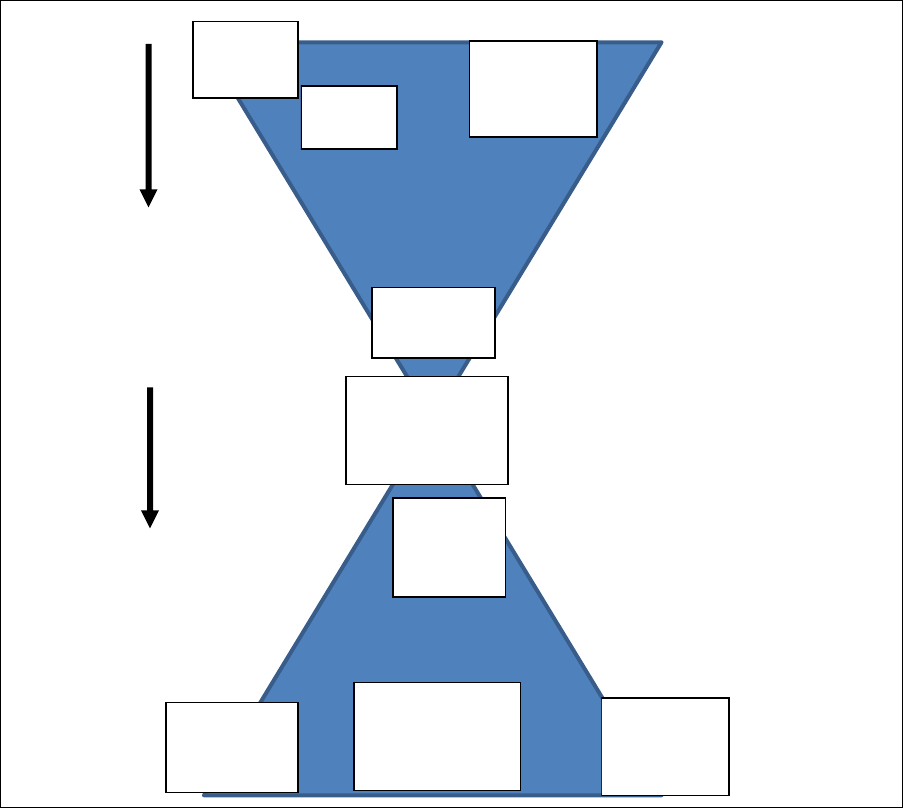
261
GENERAL
SPECIFIC
GENERAL
Research project
Introduction
Literature Review
Methodology
Results
Discussion
Conclusion
Figure 77: Mapping specific-general functions of lexis to research project structure
By preference, it is recommended that students be asked to notice article form juxtapositions
through teaching, rather than via correction for reasons already discussed (the dangers of
inaccurate corrections, time demands and the temporary effect). Moreover, whenever
possible, students should be focussed on authentic texts from their own discipline or their own
academic writing. An example is shown in Figure 78 of the results that one Chinese student
(in the researcher’s insessional English class) found by analysing his own PhD thesis.
Policy
A policy
Policy
The elderly
A 75 year old
woman
Systems
Systems
A system
The elderly

262
When the AC/DC converter was invented in 1905…. (Introduction, generic use)
New generation [XY] AC-DC converters have reduced… (Background chapter, generic use)
The experiment first tested the [XY] converter in stressed conditions. The converters were then
checked for damage…(Methodology, referential use)
The results show that [XY] converter (2) was … (Findings, referential use)
In conclusion, further research is needed into [XY] converters’ reaction to.…(Conclusion,
generic use)
Figure 78: Deduced uses by Chinese L1 Engineering student [anonymised]
A second approach that also suits the aforementioned issue of article omissions in densely
packed noun phrases lies in the use of activities that develop students’ careful consideration of
head nouns within densely packed nominal groups. Given the need to develop students’ own
autonomous proofreading skills, asking students to check each other’s work (after a brief
presentation of typical errors related to omissions with pre-qualification or overspecification)
is far more likely to raise their future attention towards article errors (with the proviso that peer
corrections are checked by the tutor). While improvements may be temporary in the first
instance, once this focus has become an independent learning habit, with practice students can
use such a focus throughout their academic careers.
8.5 Final comments
This research has shown that L1 Chinese students entering university at Upper-Intermediate
levels of English (the B2 level with which most students arrive) show near target-like accuracy
when writing about specific referents when they are familiar with the language in simpler
genres of writing. While article errors are the most frequent grammatical error made by Chinese
263
learners, this is mainly due to the fact that they are the most commonly occurring word in
academic English. However, regardless of level, Chinese B2 level students are, as seen in the
results presented in this thesis, less accurate with less familiar language in dense pre-qualified
noun phrases. Moreover, these learners are less accurate in generic uses of articles or in texts
requiring more critical discussion about unspecific referents. At B2 levels, this thesis has
shown that Chinese L1 students frequently overspecify referents when they should instead be
generalising and speculating about more abstract concepts with bare noun phrases in plural or
mass noun forms. This can add an unintended informal register to their writing which is
inappropriate for some academic genres. The two most novel findings in this research are that
neither omission of errors in dense nominalisations nor overspecificaton in unspecific contexts
are mastered by higher B2 level Chinese L1 learners and that proficiency level may have little
effect until much higher levels. While errors may ‘look after themselves’ over a lifetime, they
appear not to be developmental errors that disappear by IELTS level 6.5.
Some of the anecdotal observations that motivated this research were confirmed. Many EAP
tutors do appear to be overcorrecting article misuse indiscriminately. Occasional error
correction of articles may be appropriate for justifiable proofreading purposes, to quality
control peer correction, to model the proofreading process for students or highlight a function
of articles related to lesson aims (for example, pointing out overspecification in
generalisations). However, this thesis has presented EAP tutors with several arguments against
the overcorrection of article errors. Firstly, it is extremely time-consuming for tutors and
learners. Secondly, it is very easy to miss-correct articles if a text is read hastily. Lastly, the
evidence offered in this thesis suggests that constant correction has little sustained effect.
EAP tutors’ continued correction practices, even against their better judgement, is likely to
arise from the tensions they feel between theory and students’ expectations. It is clear that many
264
EAP tutors feel under some pressure to provide corrections regardless of received wisdom.
EAP Presessionals have been marketed to students as a means not only to learn about academic
genres, study skills and the process of academic writing, but also as programmes which develop
their language proficiency and accuracy. While most errors have a minor effect on
comprehension, articles can negatively affect the register of English and perceptions of a
writer’s meaning. In turn, as speculated by one Chinese tutor in Chapter 4, it is likely that
Chinese L1 students, who come from a background in which a focus on grammar and accuracy
takes up the greater part of college English preparation classes, are confused by the reduced
focus on form in EAP. In the knowledge that they will have to write in challenging academic
genres within months of leaving a presessional programme Chinese students either need more
information about how EAP pedagogy makes assumptions of naturalistic acquisition or, as
this thesis argues, greater occasional focus on form within their EAP syllabus.
This thesis has not argued for the appeasement of student expectations through a return to
decontextualised grammar type activities. Students frequently ask for such activities, but this
thesis has shown that they have little sustained impact on written accuracy. The added ‘English
language content’ bolted on to the EAP syllabus on many UK Presessional programmes in
recent years as a solution to students’ perceived accuracy problems is equally not an ideal
solution. Instead, a strong case is made for fully integrating an occasional focus on lexico-
grammatical forms within EAP text-based best practices. It has been shown that such a focus
can be contextualised within a genre-approach to EAP. While no evidence has been offered in
this thesis to support the efficacy of such pedagogy or for self-correction and peer correction,
such practices appear more consistent with the EAP literature, pose less risks of discouraging
learners, are more time-efficient and appear to give students the skills they will need in their
future studies without the presence of the tutor, thereby promoting learner autonomy.
265
In terms of error gravity, although most article errors are trivial surface errors that have little
impact on academic writing, this thesis has shown that article omission errors on occasion can
affect communication. Furthermore, some students appear to be oversupplying definite articles
in essay conclusions and generalised claims to the extent that the reader perceives an informal
tone to the register of writing. While all writers make mistakes in writing, the Chinese students
interviewed for this research showed they were often confused about article use in unspecific
contexts. Further research is required to investigate why Chinese students are sometimes
hesitant about applying the Ø determiner to bare noun plurals, even though their L1 similarly
requires bare noun phrases. It was speculated in this thesis that some Chinese students have
decided to add articles whenever in doubt, and future research would usefully examine whether
this strategy remains ‘fossilised’ at IELTS 7.0 - 8.0 levels of proficiency. The fact that Chinese
learners made fewer oversuppliance errors when extra attention was focussed on this problem
in addition to the finding that this error persisted at IELTS 6.5 and 7.0 writing levels lead to
the recommendation that EAP tutors should teach students the proofreading skills to check for
this informal style they may unconsciously add to their writing. Rather than overcorrecting
these errors themselves, tutors should be training students to have learner autonomy and self-
correct for these problems when they leave the EAP course.
The findings in this study have a number of further practical implications. It is important to
train new entrants in the EAP field in such student-centred approaches to teaching proofreading
and article accuracy rather than insisting that EAP never involves a focus on form. The
argument for such an integration of a lexico-grammatical focus upon determiners within the
‘EAP paradigm’ of text structure, functional moves and register awareness is also an argument
for teaching EAP students in discipline-related classes (looking at the article system mappings
unique to various topics and genres). English article teaching would therefore ideally sit within
266
a syllabus that intertwined discipline-specific registers and other lexico-grammatical aspects
(e.g. verb tense, transitivity, hedging language). Fundamentally, given that most EAP teachers
continue to focus on language form and correct errors regardless of advice from the doyens of
EAP, a strong case can be made for greater discussion about how EAP tutors can and should
focus on the grammar of such small words if they do not feel they can ignore them.

267
REFERENCES
Alexander, O., Argent, S. and Spencer, J. (2008) EAP essentials: A teacher’s guide to principles and
practice. Oxford: Garnet.
Alexander, O., Bell, D., Cardew, S., King, J., Pallant, A., Scott, M., Thomas, D., Ward and Goodbody,
M. (2008) Competency framework for teachers of English for academic purposes. Available
at:ahttps://www.baleap.org/wp-content/uploads/2016/04/teap-competency-framework.pdf
(Accessed: 1 April 2016).
Almén, D. and Nordin, M. (2011) Long term unemployment and violent crimes-using post-2000 data
to reinvestigate the relationship between unemployment and crime. IDEAS Working Paper
Series from REPEC. Department of Economics, Lund University. Available at:
https://project.nek.lu.se/publications/workpap/papers/WP11_34.pdf (Accessed: 4 January
2015).
Barnard, R. and Scampton, D. (2008) ‘Teaching grammar: A survey of EAP teachers in New Zealand’,
New Zealand Studies in Applied Linguistics, 14(2), pp. 59–82.
Bennett, G. R. (2011) A staircase model for teaching grammar for EAP writing in the IEP: freshman
composition and the noun phrase. Unpublished PhD Thesis. University of Birmingham.
Available at: http://search.proquest.com/docview/1033192284?accountid=14542 (Accessed 2
December 2015).
Berry, R. (1991) ‘Re-articulating the articles’, ELT Journal, 45(3), pp. 252–259.
Biber, D. and Gray, B. (2010) ‘Challenging stereotypes about academic writing: Complexity,
elaboration, explicitness’, Journal of English for Academic Purposes, 9(1), pp. 2–20.
Biber, D., Johansson, S., Leech, G., Conrad, S., Finegan, E. (1999) ‘Longman grammar of spoken and
written English’. Tesol Quarterly, 34, p. 1203.
Biber, D., Leech, G. N. and Conrad, S. (2002) Longman student grammar of spoken and written
English. Harlow: Longman.
Bickerton, D. (1981) Roots of language. Ann Arbor, MI: Karoma Press.
Bitchener, J. and Knoch, U. (2008) ‘The value of written corrective feedback for migrant and
international students’, Language Teaching Research, 12(3), pp. 409–431.
Bitchener, J. and Knoch, U. (2009) ‘The contribution of written corrective feedback to language
development: a ten month investigation.’ Applied Linguistics, 31(2), pp. 193–214.
Bitchener, J., Young, S. and Cameron, D. (2005) ‘The effect of different types of corrective feedback
on ESL student writing’, Journal of Second Language Writing, 14(3), pp. 191–205.
Borg, S. (2003) ‘Teacher cognition in language teaching: A review of research on what language
teachers think, know, believe, and do’, Language Teaching, 36(2), pp. 81–109.
268
Brinton, D. M. and Holten, C. A. (2001) ‘Does the emperor have no clothes? A re-examination of
grammar in content-based instruction’. In J. Flowerdew and M. Peacock, (Eds.) Research
Perspectives on English for Academic Purposes. Cambridge: Cambridge University Press, pp.
239–251.
British Council (2012) IELTS guide for teachers. Available at: https://www.britishcouncil.it/sites/
default/files/ielts_guide_for_teachers_italy.pdf (Accessed: 1 September 2016).
Brown, J. D. (2014) ‘The future of world Englishes in language testing’, Language Assessment
Quarterly, 11(1), pp. 5–26.
Brown, R. (1973) A first Language: The early stages. Cambridge MA: Harvard University Press.
Burt, M. K. and Kiparsky, C. (1974) ‘Global and local mistakes’. In Schumann, J. and Stenson, N.
(Eds) New frontiers in second language learning. Massachusetts: Newbury House Publishers,
pp. 71–80.
Butler, Y. G. (2002) ‘Second language learners’ theories on the use of English articles: An analysis of
the metalinguistic’, Studies in Second Language Acquisition, 24(3), pp. 451–480.
Bybee, J., Perkins, R. and Pagliuca, W. (1998) The evolution of grammar. Darwinian perspectives on
the origins of language. Philadelphia: Chicago University Press.
Byrd, P. and Coxhead, A. (2010) ‘On the other hand: Lexical bundles in academic writing and in the
teaching of EAP’, University of Sydney Papers in TESOL, 5(5), pp. 31–64.
Carrell, P. L. and Carson, J. G. (1997) ‘Extensive and intensive reading in an EAP setting’, English
for Specific Purposes, 16(1), pp. 47–60.
Chandler, J. (2003) ‘The efficacy of various kinds of error feedback for improvement in the accuracy
and fluency of L2 student writing’, Journal of Second Language Writing, 12(3), pp. 267–296.
Chang, J. (2001) ‘Chinese speakers’. In B. Smith and M. Swan (Eds.) Learner English: A teacher’s
guide to interference and other problems. Cambridge: Cambridge Univeristy Press, pp. 310–
316.
Chen, P. (2004) ‘Identifiability and definiteness in Chinese’, Linguistics, 42(6), pp. 1129–1184.
Chen, P. (2014) ‘The comparison of intermediate and advanced Chinese learners’ use of English
adverbial connectors in academic writing’, International Journal on Studies in English
Language and Literature, 2(8), pp. 85–92.
Chesterman, A. (1991) On definiteness: a study with special reference to English and Finnish.
Cambridge: Cambridge University Press.
Chuang, F. and Nesi, H. (2006) ‘An analysis of formal errors in a corpus of L2 English produced by
Chinese students’, Corpora, 1(2), pp. 251–271.
Cobb, T. (2003) ‘Analyzing late interlanguage with learner corpora: Quebec replications of three
European studies’, Canadian Modern Language Review, 59(3), pp. 393–424.
269
Conrad, S. and Biber, D. (2001) 'Multi-dimensional methodology and the dimensions of register
variation in English'. In Conrad and Biber (Eds) pp. 13-42. Variation in English: multi-
dimensional studies. Harlow: Pearson.
Corder, S. P. (1967) ‘The significance of learners’ errors’, International Review of Applied Linguistics,
5(4), pp. 161–169.
Cortazzi, M. and Jin, L. (1996) 'Cultures of learning: Language classrooms in China'. In N.H. Coleman
(Ed.) Society and the language classroom. Cambridge: Cambridge University Press, pp. 169–
206.
Coxhead, A. (2016) ‘Acquiring academic and disciplinary vocabulary’. In K. Hyland, P. Shaw (Eds.)
The Routledge handbook of English for academic purposes. London: Routledge, pp. 201–214.
Crosthwaite, P. (2012) ‘An error analysis of L2 English discourse reference through learner corpora
analysis’, Linguistic Research, 30(2), pp. 163–193.
Crosthwaite, P. (2016a) ‘L2 English article use by L1 speakers of article-less languages’, International
Journal of Learner Corpus Research, 2(1), pp. 69–101.
Crosthwaite, P. (2016b) ‘A longitudinal multidimensional analysis of EAP writing: Determining EAP
course effectiveness’, Journal of English for Academic Purposes, Volume 22, pp. 166–178.
Crosthwaite, P. (2017) ‘Does EAP writing instruction reduce L2 errors? Evidence from a longitudinal
corpus of L2 EAP essays and reports’, International Review of Applied Linguistics in Language
Teaching, 56(3), pp. 315–343.
Cziko, A. (1986) ‘Testing the language bioprogram hypothesis: a review of children’s acquisition of
articles’, Language, 62(4), pp. 878–898.
Dale, R., Anisimoff, I., & Narroway, G. (2012) 'Hoo 2012: A report on the preposition and determiner
error correction shared task'. In Proceedings of the seventh workshop on innovative use of NLP
for building educational applications, pp. 54–62. Available at: https://dl.acm.org/
ft_gateway.cfm?ftid=1303967&id=2390390 (Accessed 14 November 2015).
Davies, A. (2003) The native speaker: Myth and reality. Bristol: Multilingual Matters.
Díez-Bedmar, M. (2015) ‘Article use and criterial features in Spanish EFL writing’. In M. Callies &
S. Götz (Eds.), Learner corpora in language testing and assessment. Amsterdam: John
Benjamins, pp.163-190.
Díez-Bedmar, M. and Papp, S. (2008) ‘The use of the English article system by Chinese and Spanish
learners’. In G. Gilquin, M.B. Díez-Bedmar and S. Papp (Eds.) Linking up contrastive and
learner corpus research. Amsterdam: Rodopi, pp. 147-175.
Dudley-Evans, T. and St John, M. J. (1998) Developments in English for specific purposes.
Cambridge: Cambridge University Press.
Dulay, H., Burt, M. and Krashen, S. (1982) Language two. New York: Oxford University Press.
270
Ede, L. and Lunsford, A. (1984) ‘Audience addressed/audience invoked: the role of audience in
composition theory and pedagogy’, College Composition and Communication, 35(2), p. 155.
Ekiert, M. (2004) ‘Acquisition of the English article system by speakers of Polish in ESL and EFL
settings’, Teachers College Columbia University Working Papers in TESOL & Applied
Linguistics, 4(1), pp. 1–23.
Ellis, R. (1994) The study of second language acquisition. Oxford: Oxford University Press.
Ellis, R. and Barkhuizen, G. (2005) Analysing learner language. Oxford: Oxford University Press.
Ellis, R. (2006) ‘Current issues in the teaching of grammar: an SLA perspective’, TESOL Quarterly,
40(1), pp. 83–107.
Ellis, N. C. and Larsen-Freeman, D. (2009) ‘Constructing a second language: Analyses and
computational simulations of the emergence of linguistic constructions from usage’, Language
Learning, 59 (1), pp. 90–125.
Etherington, S. and Burgess, J. (2002) ‘Focus on grammatical form: explicit or implicit?’, System,
30(4), pp. 433–458.
Fang, Z., Schleppegrell, M. J. and Cox, B. E. (2006) ‘Understanding the language demands of
schooling: Nouns in academic registers’, Journal of Literacy Research, 38(3), pp. 247–273.
Feise, R. J. (2002) 'Do multiple outcome measures require p-value adjustment?'. BMC Medical
Research Methodology 2(1), p.8.
Ferris, D. (1999) ‘The case for grammar correction in L2 writing classes: A response to Truscott
(1996)’, Journal of Second Language Writing, 8(1), pp. 1–11.
Ferris, D. (2006) ‘Does error feedback help student writers? New evidence on the short- and long-term
effects of written error correction’. In K. Hyland and F. Hyland (Eds.) Feedback in second
language writing: Contexts and issues. Cambridge: Cambridge University Press, pp. 81–104.
Ferris, D. and Kurzer, K. (2019) ‘Does error feedback help L2 writers?’. In K. Hyland, K. and F.
Hyland, (Eds.) Feedback in second language writing: Contexts and issues (2
nd
Ed.).
Cambridge: Cambridge University Press., pp. 106–124.
Fleiss, J.L. (1981) Statisical methods for rates and proportions. 2nd ed. New York: Wiley.
Flowerdew, J. (1993) ‘An educational, or process approach to the teaching of professional genres’,
ELT Journal, 47(4), pp. 305–306.
Flowerdew, J. (2016) ‘English for specific academic purposes (ESAP) writing: Making the case’,
Writing and Pedagogy, 8, pp. 5–32.
Flowerdew, J. and Peacock, M. (2001) ‘Issues in EAP: a preliminary perspective’. In J. Flowerdew
and M. Peacock (Eds.) Research perspectives on English for academic purposes. Cambridge:
Cambridge University Press.
271
Gardner, S. (2008) ‘Integrating ethnographic, multidimensional, corpus linguistic and systemic
functional approaches to genre description: An illustration through university history and
engineering assignments. In E. Steiner and S. Neumann (Eds), Proceedings of the 19th
European systemic functional linguistics conference and workshop. 23- 25 July 2007,
Universität des Saarlandes, Saarbrücken, Germany, pp 1–34. Available at:
http://scidok.sulb.uni-saarland.de/ volltexte/2008/1688/ (Accessed 10 September 2018).
Gardner, S. and Holmes, J. (2009) ‘Can I use headings in my essay? Section headings, macrostructures
and genre families in the BAWE corpus of student writing’. In M. Charles, D. Pecorari and S.
Hunston (Eds.) Academic writing: At the interface of corpus and discourse. London:
Continuum, pp. 251-271.
Gass, S. M. and Selinker, L. (2010) ‘Second language acquisition’, Annual Review of Applied
Linguistics (Issues in Second Language Research), 25(3), pp. 46–73.
Gilquin, G. (2008) ‘Combining contrastive and interlanguage analysis to apprehend transfer: detection,
explanation, evaluation’, Language and Computers, 66(1), pp. 3–33.
Gilquin, G. and Paquot, M. (2007) ‘Spoken features in learner academic writing: Identification,
explanation and solution’, in Proceedings of the 4th corpus linguistics conference, University
of Birmingham, pp. 27–30. Available at: https://dial.uclouvain.be/downloader/downloader
.php?pid=boreal:75861&datastream=PDF_01 (Accessed: 1 December 2015).
Gilquin, G. and Paquot, M. (2008) ‘Too chatty: learner academic writing and register variation’,
English Text Construction, 1(1), pp. 41–61.
Granger, S. (1996) ‘From CA to CIA and back: an integrated approach to computerized bilingual and
learner corpora’. In Aijmer, K., Altenberg, B., and Johansson, M. (Eds) Languages in contrast.
Papers from a symposium on text-based cross-linguistic studies. Lunk: Lund University Press,
pp. 37-51.
Granger, S. (2003) ‘Error-tagged learner corpora and CALL: a promising synergy’, CALICO, 20(3),
p. pp.465-480.
Granger, S. (2004) ‘Computer learner corpus research: current status and future prospects’, in Applied
Corpus Linguistics. Amsterdam: Brill Rodopi, pp. 123–145.
Granger, S. (2011) ‘How to use foreign and second language learner corpora’. In A. Mackey and S.M.
Gass (Eds) Research methods in second language acquisition: A practical guide. Hoboken,
New Jersey: John Wiley & Sons.
Groom, N. and Littlemore, J. (2012) Doing applied linguistics. London: Routledge.
Halliday, M. A.K. (1985) Spoken and written language. Victoria: Deakin University.
Halliday, M. A. K. and Martin, J. R. (1993) Writing science: Literacy and discursive power. Pittsburgh:
University of Pittsburgh Press.
Hewings, M. (2013) Advanced grammar in use book with answers. Cambridge: Cambridge University
Press.
272
Hinkel, E. (2003) ‘Simplicity without elegance: Features of sentences in L1 and L2 academic texts’,
TESOL Quarterly, pp. 275–301.
Hinkel, E. (2013) ‘Research findings on teaching grammar for academic writing’, English Teaching,
68(4), pp. 3–21.
Hirvela, A. (2016) ‘Academic reading into writing’. In K. Hyland, P. Shaw (Eds.) The Routledge
handbook of English for academic purposes. London: Routledge, pp. 151–162.
Huebner, T. (1983) A longitudinal analysis of the acquisition of English. Ann Arbor: Karoma.
Hutchinson, T. and Waters, A., (1987) English for specific purposes. Cambridge: Cambridge
university press.
Hyland, K. and Milton, J. (1997) ‘Qualification and certainty in L1 and L2 students’ writing’, Journal
of Second Language Writing, 6(2), pp. 183–205.
Hyland, K. (2002a) ‘Genre: language, context, and literacy’, Annual Review of Applied Linguistics,
22, pp. 113–135.
Hyland, K. (2002b) ‘Specificity revisited: How far should we go now?’, English for Specific Purposes,
21(4), pp. 385–395.
Hyland, K. and Hamp-Lyons, L. (2002) ‘EAP: Issues and directions’, Journal of English for Academic
Purposes, 1(1), pp. 1–12.
Hyland, K. (2004) Disciplinary discourses: Social interactions in academic writing. Ann Arbor, MI:
University of Michigan Press.
Hyland, K. and Hyland, F. (2006) ‘Feedback on second language students’ writing’, Language
Teaching, 39(2), pp. 83–101.
Hyland, K. (2007a) ‘Applying a gloss: Exemplifying and reformulating in academic discourse’,
Applied Linguistics, 28(2), pp. 266–285.
Hyland, K. (2007b) ‘Genre pedagogy: language, literacy and L2 writing instruction’, Journal of
Second Language Writing, 16(3), pp. 148–164.
Hyland, K. (2008) ‘As can be seen: Lexical bundles and disciplinary variation’, English for Specific
Purposes, 27(1), pp. 4–21.
Hyland, K. (2012) ‘Disciplinary differences: language variation in academic discourses’. In K. Hyland
and M. Bondi (Eds.) Academic Discourse Across Disciplines. Bern: Peter Lang GmbH, pp. 17–
40.
Ionin, T., Montrul, S., Kim, J., Philippov, V. (2011) ‘Genericity distinctions and the interpretation of
determiners in second language acquisition’, Language Acquisition, 18(4), pp. 242–280.
Ionin, T. (2012) ‘Formal theory-based methodologies’. In A. Mackey (Ed.) Research methods in
second language acquisition: A practical guide. London: Blackwell, pp. 30–52.
273
Ionin, T., Ko, H. and Wexler, K. (2004) ‘Article semantics in L2 acquisition: The role of specificity’,
Language Acquisition, 12(1), pp. 3–69.
Jarvis, S. (2000) ‘Methodological rigor in the study of transfer: Identifying L1 influence in the
interlanguage lexicon’, Language learning, 50(2), pp. 245–309.
Jarvis, S. (2002) ‘Topic continuity in L2 English article use’, Second Language Acquisition, 24(03),
pp. 387-418.
Johns, T. (1991) ‘Should you be persuaded: two examples of data-driven learning’, ELR Journal, 4,
pp. 1–17.
Krashen, S. D. (1992) ‘Comprehensible input and some competing hypotheses’. In R. Courchene, J.
Glidden, J. St. John & C. Therien (Eds.) Comprehension-based second language teaching.
Ottawa: University of Ottawa Press, pp. 19–38.
Krifka, M. and Gerstner, C. (1987) ‘An outline of genericity’, in Conference for SNS-Bericht,
University of Tübingen (25 October). Available at:http://amor.cms.hu-berlin.de/~h2816i3x/
Publications /Krifka 1987 Genericity.PDF (Accessed 2 December 2015).
Lado, R. (1957) Linguistics across cultures. Ann Arbor, MI: University of Michigan Press.
Langacker, R. W. (1986) ‘An introduction to cognitive grammar’, Cognitive Science, 10(1), pp. 1–40.
Langendoen, D. T. (1970) Essentials of English grammar. New York: Holt Rinehart and Winston.
Larsen-Freeman, D. E. (1976) ‘An explanation for the morpheme acquisition order of second language
learners’, Language Learning, 26(1), pp. 125–134.
Larsen-Freeman, D. and Long, M. H. (1991) An introduction to second language acquisition research.
London: Longman.
Lee, D. Y. W. and Chen, S. X. (2009) ‘Making a bigger deal of the smaller words: function words and
other key items in research writing by Chinese learners’, Journal of Second Language Writing,
18(4), pp. 281–296.
Lee, I. (2005) ‘Error correction in the L2 writing classroom: What do students think?’, TESL Canada
Journal, 22(2), pp. 1–16.
Leedham, M. (2015) Chinese students’ writing in English. Implications from a corpus-driven study.
London & New York: Routledge.
Li, C. N. and Thompson, S. A. (1981) Mandarin Chinese: A functional reference grammar. Berkeley:
University of California Press.
Li, J. and Schmitt, N. (2009) ‘The acquisition of lexical phrases in academic writing: a longitudinal
case study’, Journal of Second Language Writing, 18(2), pp. 85–102.
Liu, D. and Gleason, J. L. (2002) ‘Acquisition of the article the by nonnative speakers of English: an
analysis of four nongeneric uses’, Studies in Second Language Acquisition, 24(1), pp. 1–26.
274
Long, M. H. (1983) ‘Does second language instruction make a difference? A review of research’,
TESOL Quarterly, 17(3), pp. 359–382.
Long, M. H. (1990) ‘The least a second language acquisition theory needs to explain’, TESOL
Quarterly, 24(4), pp. 649–666.
Lu, F. C. (2001) ‘The acquisition of English articles by Chinese learners’, Second Langauge Studies,
20(1), pp. 43–78.
Luk, Z. P. and Shirai, Y. (2009) ‘Is the acquisition order of grammatical morphemes impervious to L1
knowledge? Evidence from the acquisition of plural -s, articles, and possessive ’s’, Language
Learning, pp. 721–754.
Master, P (1986) 'Teaching the English article system to foreign technical writing students'. The
Technical Writing Teacher, 13(3), pp.203-210.
Master, P. (1987) ‘Generic the in scientific American’, English for Specific Purposes, 6(3), pp. 165–
186.
Master, P. (1990) ‘Teaching the English articles as a binary system’, TESOL Quarterly, 24(3), pp.
461–478.
Master, P. (1995) 'Consciousness raising and article pedagogy'. In D. Belcher, & G. Braine (Eds.),
Academic writing in a second language: Essays on research and pedagogy. Norwood, NJ:
Ablex Publishing Corporation, pp. 183-204.
Master, P. (1997) ‘The English article system: Acquisition, function and pedagogy’, System, 25(2), pp.
215–232.
Master, P. (2002) ‘Information structure and English article pedagogy’, System, 30(3), pp. 331–348.
Mayor, B. M. (2006) ‘Dialogic and hortatory features in the writing of Chinese candidates for the
IELTS test’, Language, Culture and Curriculum, 19(1), pp. 104–121.
Milton, J. (2001) ‘Elements of a written interlanguage: a computational and corpus-based study of
institutional influences on the acquisition of English by Hong Kong Chinese students.’ In G.
James (Ed.) Research reports, volume two. Hong Kong: University of Science and Technology.
Murakami, A. and Alexopoulou, T. (2016) ‘L1 influence on the acquisition order of English
grammatical morphemes’, Studies in Second Language Acquisition, 38(3), pp. 365–401.
Murphy, R. (2012) English grammar in use with answers: A self-study reference and practice book
for intermediate students of English. Cambridge: Cambridge University Press.
Nation, P. (2007) ‘The four strands’, Innovation in Language Learning and Teaching, 1(1), pp. 2–13.
Nesi, H. and Gardner, S. (2012) ‘Families of genres of assessed writing’. In H. Nesi and S. Gardner
(Eds.) Genres across the disciplines: Student writing in higher education. Cambridge:
Cambridge University Press, pp. 21–56.
275
Norris, J. M. and Ortega, L. (2000) ‘Effectiveness of L2 instruction: a research synthesis and
quantitative meta-analysis’, Language Learning, 50(3), pp. 417–528.
Nunan, D. (1991) ‘Communicative tasks and the language curriculum’, TESOL Quarterly, 25(2), p.
279.
Odlin, T. (1989) Language transfer: Cross-linguistic influence in language learning. Cambridge
University Press.
OED Online (2010) ‘Oxford English dictionary online’, Oxford English Dictionary. Available at:
http://dictionary.oed.com. (Accessed 4 June 2010).
Paltridge, B. (2001) ‘Linguistic research and EAP pedagogy’. In Flowerdew, J. and Peacock, M. (Eds)
Research perspectives on English for academic purposes. Cambridge: Cambridge University
Press, pp. 55–70.
Parkinson, J. and Musgrave, J. (2014) ‘Development of noun phrase complexity in the writing of
English for academic purposes students’, Journal of English for Academic Purposes, 14, pp.
48–59.
Phakiti, A. (2014) ‘Ethical considerations in experimental research'. In A. Phakiti. (Ed.) Experimental
research methods in language learning: Research methods in linguistics. London: Bloomsbury
Academic.
Phipps, S. and Borg, S. (2009) ‘Exploring tensions between teachers’ grammar teaching beliefs and
practices’, System, 37(3), pp. 380–390.
Pica, T. (1983) ‘Methods of morpheme quantification: Their effect on the interpretation of second
language data’, Studies in Second Language Acquisition, 6(1), pp. 69–78.
Polio, C., Fleck, C. and Leder, N. (1998) ‘“If I only had more time”: ESL learners’ changes in linguistic
accuracy on essay revisions’, Journal of Second Language Writing, 7(1), pp. 43–68.
Quirk, R. and Crystal, D. (1985) A comprehensive grammar of the English language. London:
Longman.
Rahimpour, M., Salimi, A. and Farrokhi, F. (2012) ‘The effect of intensive and extensive focus on
form on EFL learners’ written accuracy’, Theory and Practice in Language Studies, 2(11), pp.
2277–2283.
Richards, J. C. and Rodgers, T. S. (1986) Approaches and methods in language teaching: A description
and analysis. Cambridge: Cambridge University Press.
Robertson, D. (2000) ‘Variability in the use of the English article system by Chinese learners of
English’, Second language Research, 16(2), pp. 135–172.
Russell, V. (2009) ‘Corrective feedback, over a decade of research since Lyster and Ranta
(1997).Where do we stand today?’, Electronic Journal of Foreign Language Teaching, 6(1),
pp. 21–41.
276
Savignon, S. J. (1991) ‘Communicative language teaching: State of the art’, TESOL Quarterly, 25(2),
pp. 261–277.
Schultz, R. (2001) ‘Cultural differences in student and teacher perceptions concerning the role of
grammar instruction and corrective feedback: USA—Colombi’, The Modern Language
Journal, 85(ii), pp. 244–258.
Shi, Dingxu (2016) ‘Nouns and nominal phrases’. In C.R. Huang, C. R. and D. Shi (Eds.) A reference
grammar of Chinese. Cambridge: Cambridge University Press, pp. 199–255.
Shi, L. (2006) ‘The successors to confucianism or a new generation? A questionnaire study on Chinese
students’ culture of learning English’, Language, Culture and Curriculum, 19(1), pp. 122–140.
Sinclair, J. (1991) Corpus, concordance, collocation. Oxford: Oxford University Press.
Snape, N., Leung, I.K. and Ting, H.C. (2006) 'Comparing Chinese, Japanese and Spanish speakers in
L2 English article acquisition: Evidence against the fluctuation hypothesis?'. In M. Grantham
O’Brien, C. Shea. and J. Archibald (Eds) Proceedings of the 8th generative approaches to
second language acquisition conference (GASLA 2006). Somerville, MA: Cascadilla
Proceedings Project, 132–39.
Sowton, C. (2012) 50 Steps to improving your academic writing: Study book. Reading: Garnet.
Spack, R., (1988) 'Initiating ESL students into the academic discourse community: How far should we
go?' TESOL quarterly, 22(1), pp.29-51.
Swales, J. M. (1990) Genre analysis: English in academic and research settings. Cambridge:
Cambridge University Press.
Swales, J. M. (2004) Research genres: Explorations and applications. Cambridge, UK: Cambridge
University Press.
Swales, J. M. and Feak, C. B. (2004) Academic writing for graduate students. Ann Arbor, Michigan:
University of Michigan Press.
Swan, M. and Smith, B., (2001) Learner English: A teacher's guide to interference and other
problems. Cambridge: Cambridge University Press.
Taylor, J. (1989) Linguistic categorisation: An essay in cognitive linguistics. Oxford: Oxford
University Press.
The Higher Education Statistics Agency (2019) Higher education student statistics: UK, 2017/18 -
Where students come from and go to study, 17 January 2019. Available at:
https://www.hesa.ac.uk/news/17-01-2019/sb252-higher-education-student-statistics/location
(Accessed: 1 June 2019).
Thewissen, J. (2015) Accuracy across proficiency levels. A learner corpus approach. Louvain: Presses
universitaires de Louvain.
Thomas, M. (1989) ‘The acquisition of English articles by first-and second-language learners’, Applied
Psycholinguistics, 10(03), pp. 335–355.
277
Truscott, J. (1996) ‘Correction, the case against grammar classes, in L2 writing’, Language Learning,
46(2), pp. 327–369.
Truscott, J. (2004) ‘Evidence and conjecture on the effects of correction: A response to Chandler’,
Journal of Second Language Writing, 13(4), pp. 337–343.
Universities UK (2019) International Facts and Figures 2019, 30 July 2019. Available at: https://
www.universitiesuk.ac.uk/policy-and-analysis/reports/Pages/Intl-facts-figs-19.aspx
(Accessed 1 September 2019).
University of Birmingham (2016) 'Ethical Review of Research' Available at: University of
Birmingham Intranet https://intranet.birmingham.ac.uk/finance/documents/public/ethical
reviewpgstudent.pdf (Accessed: 4 December 2016).
Ure, J. (1971) 'Lexical density and register differentiation.' In G. Trim and J Perren (Eds.)
Applications of Linguistics. Cambridge: University Press.
Verspoor, M. H. (2008) ‘Cognitive linguistics and its applications to second language teaching’. In
Encyclopedia of Language and Education. Boston, MA: SpringerLink Books, pp. 1843–1854.
Wang, T. (2001) ‘Understanding Chinese culture and learning’. In Proceedings of the international
research conference of the Australian association for research in education. Adelaide,
Australia, 26-30 November: Australian Association for Research in Education. Available at:
http://www.aare.edu.au/06pap/ (Accessed 4 March 2018).
Weale, S. (2019) ‘Chinese students’ applications to UK universities up by 30%’, The Guardian
Newspaper, 11 July. Available at: https://www.theguardian.com/ education/2019/jul
/11/chinese-students-applications-to-uk-universities-up-by-30 (Accessed 1 September 2019).
Wu, X. (2009) 'The dynamics of Chinese face mechanisms and classroom behaviour: a case study',
Evaluation & Research in Education, 22 (2-4): 87–105.
Xu, Q., Shi, Y. and Snape, N. (2016) ‘A study on Chinese students’ acquisition of English articles and
interlanguage syntactic impairment’, Chinese Journal of Applied Linguistics, 39(4).
Yamada, J. and Matsuura, N. (1982) ‘The use of the English article among Japanese students’, RELC
Journal, 13(1), pp. 50–63.
Yang, M. and Ionin, T. (2008) ‘L2 English articles and the computation of uniqueness’, in Proceedings
of the 3rd conference on generative approaches to language acquisition. North America,
University of Connecticut, pp. 325–335. Available at: https://pdfs.
semanticscholar.org/ee98/4f75c2bb1172738c8ad4fbe4e44eb6618988.pdf (Accessed:
1 December 2015).
Yoo, I. W. (2009) ‘The English definite article: What ESL/EFL grammars say and what corpus
findings show’, Journal of English for Academic Purposes, 8(4), pp. 267–278.
Young, R. (1996) ‘Form-function relations in articles in English interlanguage’. In R.B. Preston and
R. Bayley (Eds.) Second language acquisition and linguistic variation. Amsterdam:
Benjamins., pp. 135–175.
278
Zdorenko, T. and Paradis, J. (2008) ‘The acquisition of articles in child second language. English:
fluctuation, transfer or both?’, Second Language Research, 24(2), pp. 227–250.
Zhang, S. (1995) 'Re-examining the affective advantages of peer feedback in the ESL writing class',
Journal of Second Language Writing, 4 (3): 209–222.
.
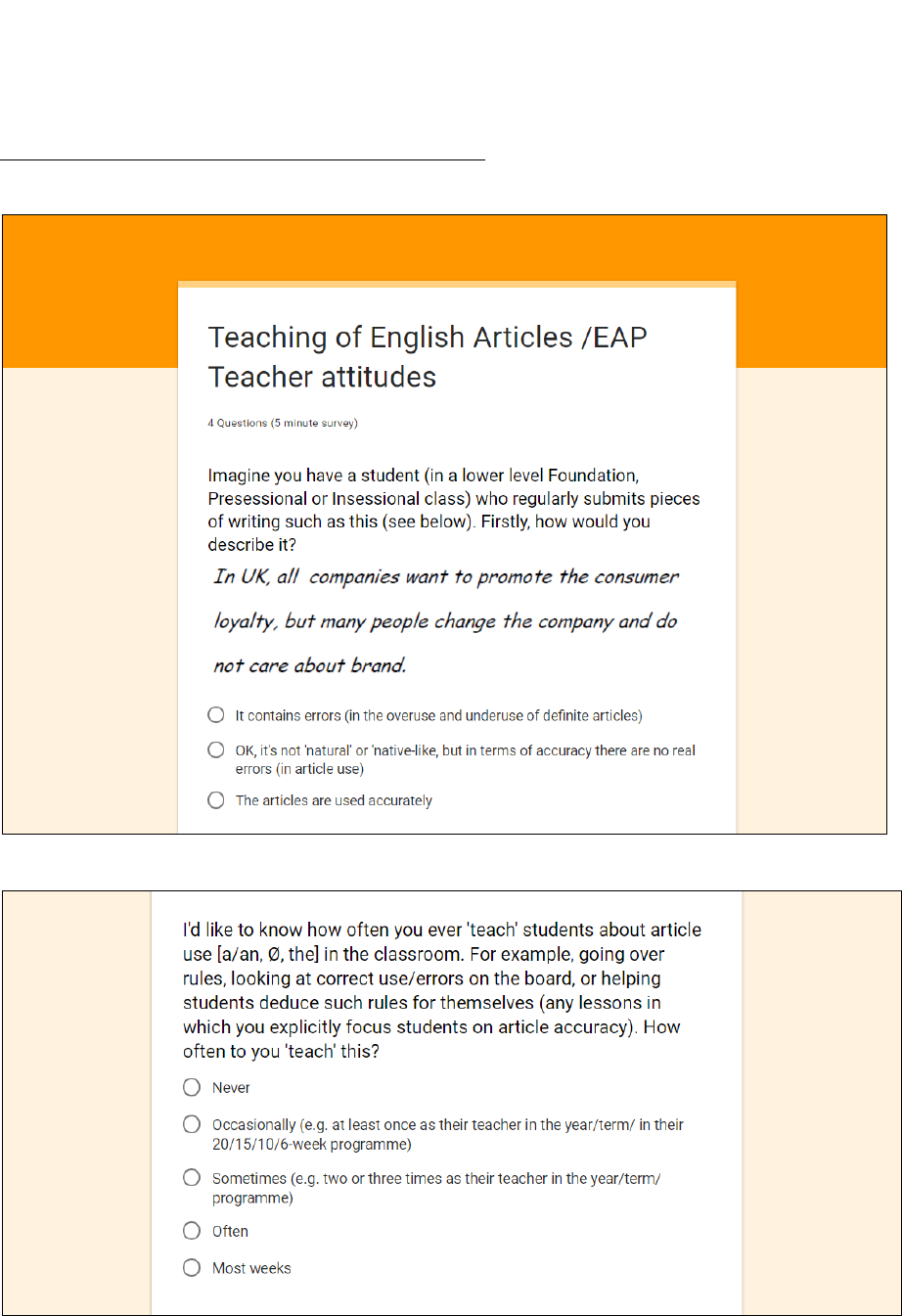
279
APPENDICES
APPENDIX 1
Teacher Survey [Online] Questionnaire (Chapter 4)
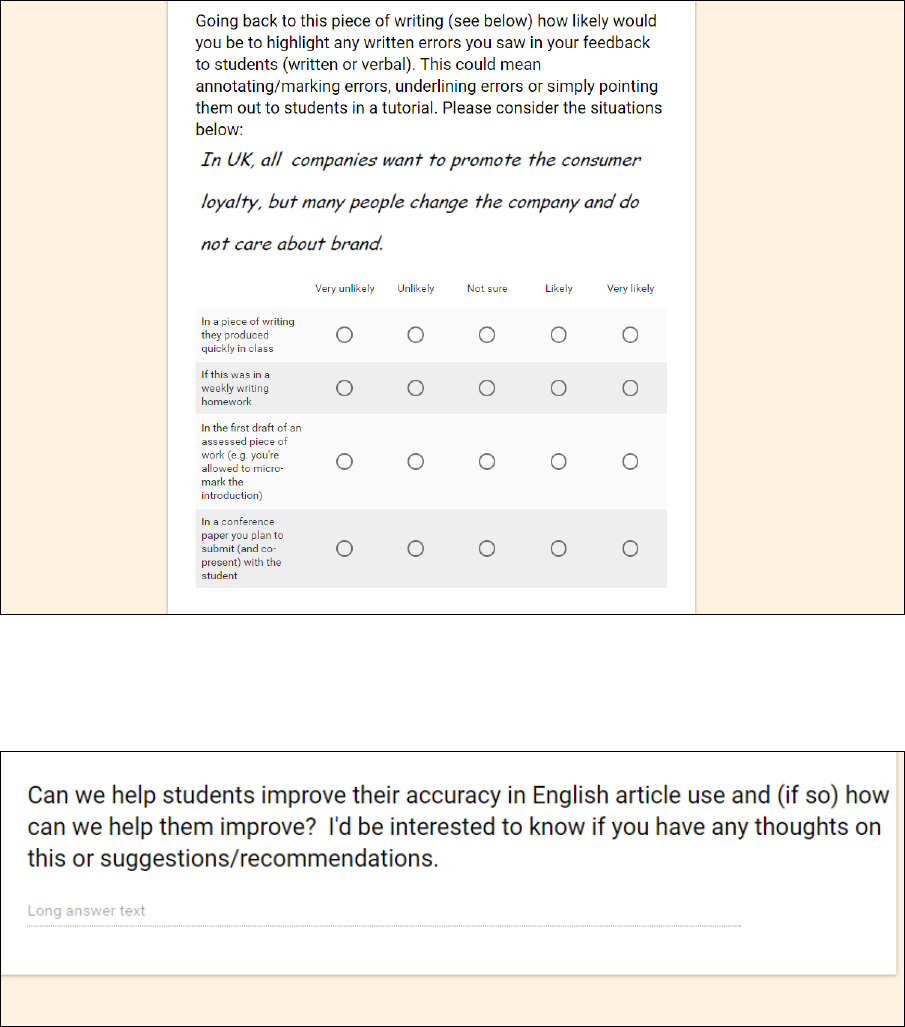
280
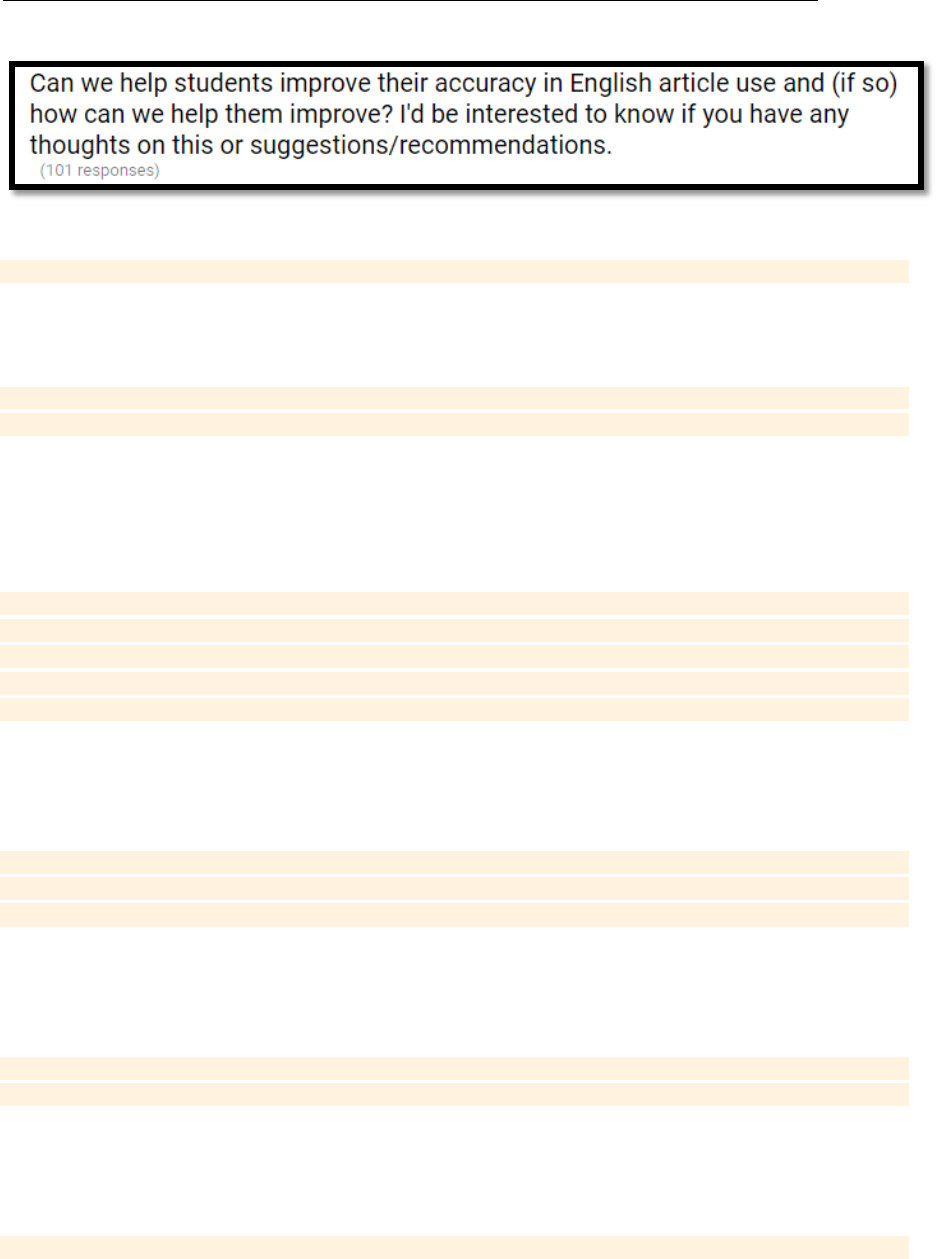
281
APPENDIX 2
BALEAP Mailing List Responses to Survey Question 4 Open-Response (Chapter 4)
Supported self study
I believe that by drawing their attention to focused examples and errors, we can them get the students
to extrapolate 'rules' and formulate hypotheses about when (not) to use articles.
it is something they need to 'notice' and get feedback on - usually through text analysis of related work
or through dictogloss.
There seems little point in teaching "rules", apart from eg abstract nouns, and advise to use plurals to
avoid error, but would, if had time, occasionally distribute a short piece of student writing and error
correct/analyse in class. I would consider this mostly to be covered in giving individual student feedback
on their writing both orally and in writing.
Students correct an anonymous piece of work and explain the reasons for any changes they make.
Possibly working in pairs rather than individually as it would increase discussion of the task. The piece
of work could be actual or a fictional piece created by the tutor and containing typical errors.
Alternatively, after a few weeks, amalgamation of the group's own typical errors would be interesting if
time-consuming to produce.
This is something students need to 'acquire' rather than learn. So perhaps the best approach is promote
noticing: to draw attention to / ask questions about the use of articles as they occur incidentally in a
lesson, rather than explicit lesson segments.
Yes by consistently pointing out instances of misuse when it would impact on meaning or the impression
they give of themselves. Asking them to record their own speech and identifying article use/misuse
works well.
Not sure. I think articles are one of 'final errors', if you like, NNS that have been in an English country
for many years can still make errors with articles. It may be improved with greater exposure to language
and language environment than direct teaching in class.
Through awareness raising exercises, regular "small doses", texts (from students' own academic fields)
with articles removed, proofreading samples of student writing.
There is no easy answer, sometimes it is because their first language does not have articles. Getting
them to notice and a bit of translation (even though it is unfashionable) can get them to recognise the
difference.
Providing guided opportunities to notice. As much exposure to authentic material as possible.

282
Yes we can Firstly draw attention to the errors. Then isolate them and explain some simple rules of
thumb, explaining that it is a common area of error. Then recommend a grammar text book (eg
Murphy/Hewings) Then recommend a series of journal articles in their subject- tell them to look at the
noun phrases
Learn about articles ourselves. Know more about how they work, while still acknowledging that even
the best theorists (e.g. Hawkins) do not themselves have a definitive answer on this. Teach heuristic
rules explicitly. Highlight errors in S work and give them the opportunity to correct. Praise improvement
in use.
Simplify article use by showing that the definite article is an audience oriented particle which signals to
the reader - you know what I'm talking about.
It seems me that the biggest area our students have difficulty with is generalising. After that, they need
to be explicitly reminded that 'a' = 'one &/or any' while 'the' answers the question 'which'. My students
have also found it helpful to be reminded that prepositional phrases, especially the construction 'the x
of y', very often signal a need for 'the'. I've found a good way to raise their awareness (and hopefully
increase their accuracy, but I've never tested this) is to have them regularly mark a short passage (from
a journal, a text book, or news article usually): they highlight all the nouns, then they examine which
take articles and explain why (not for all, but for a sampling, usually one each of null, a/an, and the).
We can certainly help them improve their accuracy in English article use. I often use comparison with
their first languages, which helps them clarify similarities and differences and may serve as memory
hooks of when to use or not to use articles in English. Analysing texts and asking the students to explain
why a particular article is used or why there is no need for an article is also very useful. Perseverance
and constant repetition of rules in various forms does, eventually, bring an improvement.
I think it is partly a developmental stage which improves over time (like the 3rd person s), which also
encourages students as some can get very down about the difficulties they have with articles. I haven't
found generic exercises such as 'correct the errors' in random sentences help really. However I have
found that activities which help students notice their own specific errors in their own writing does seem
to make some difference.
If time allows, sit down with the student on a one-to-one basis as they are writing (or correcting
something written) and ask them to explain the reasoning behind their article use or non-use, and put
them on the right path if necessary. Direct them towards some reinforcement activities which they can
do on their own. Monitor future written work to see if article-related errors persist.
In science subjects it can be important to use articles accurately, and so close marking can be helpful.
These questions are not helpful however as they are too regimented. Academic writing correction
focuses on different aspects of a student's writing each time, depending on many many other factors,
articles are only one element of this. Sometimes the mistakes made change the meaning that is
intended, then it may be important to focus on that at that moment. So much to add. But a terrible choice
for a PhD.
plenty of tutor-facilitated targeted self-study (i.e. rather than classroom teaching)
By teaching them with noun phrases and discussing specificity
I think it's very difficult, especially if a student's first language has a different or no article system.
Perhaps trying to raise their awareness of the importance or significance of articles in English and how
meaning changes ("I have cake/a cake", "he has time/the time"). Otherwise, particularly as higher level

283
students are sometimes quite able to self-correct if an error is pointed out, it seems that they just don't
see it as being that important!
For example: Introduce and revise the rules of use; look at examples correct use in texts and identify
reasons for the presence/absence of articles. However, improvement is likely to be slow and a non-
native speaker will probably still make occasional errors even if they achieve a very high level of
proficiency.
Yes, teach, practice with paragraphs of error-filled text, etc.
Not sure how much we can. [Is it even desirable? I think that depends on context. For a subject tutor
who struggles with NNS writing, it could help (at least reducing their emtional recoil from "otherness").
For a more confident tutor, it's much less important. In a less parochial sense, English is becoming
much more global (cf English Next et al), with washback into "Centre" countries from other users.] Is it
practical? I suspect not in most cases, as habits will have formed long ago and actual use is very hard
to understand and emulate. Something like Rosetta Stone might do much more good than teachers in
classrooms.
This is the most complex area of English grammar with so many rules (all of which have exceptions)
that I know there is a theory that students cannot improve in terms of accuracy through conscious
application of rules. However, as with all areas of grammar, I think occassionally revising the rules,
together with subconscious acquisition gained through immersion (reading most of all) might lead to a
gradual reduction in the number of mistakes.
I am not sure we can 'teach' the use of articles beyond a very elementary stage, I always tell students
that the grammar rules are likely to hinder as much as help them. I recommend a 'language awareness'
approach - to pay attention to the use of articles in anything they read/hear/etc. For me, how articles
are used needs to be learned almost instinctively ...
This is a difficult one; I think reading and noting collocations (eg consumer loyalty) helps. I often
compose a paragraph of student errors and put it on the whiteboard and elicit feedback from groups. I
do occasionally devote time specifically to article use but early on in a 40 week pre-sessional course.
I've been teaching EAP for 9 years, and although I think high accuracy is important in article use, it is
quite minor compared to development of content, paragraph support and analytical skills.
Collect the mistakes we find in their work and periodically present them back to the group along with
error free examples. Ask them to identify whether correct or incorrect and to rewrite the incorrect ones.
students look at a text. mark all articles and absences of articles. try to extrapolate some rules. discuss.
repeat periodically.
Yes, we can help. Constantly flagging it up in corrective feedback may help over time. Access to a
grammar reference source such as McCarthy and Carter's Cambridge Grammar. Dictagloss is a handy
activity to focus learners on accuracy at the end of a task cycle.
As an awareness-raising exercise, I sometimes give a handout with article use explained, and ask them
to go through the rules deciding which ones also apply in their language and which are different (of
course this doesn't work with students whose 1st language has no articles! it does work with eg L1
Spanish speakers...). Otherwise, I tend to focus on articles when giving feedback rather than through a
dedicated lesson on the topic - eg by collecting some article errors, especially ones which could be
misleading in terms of meaning, putting them up on a slide, adding some phrases/sentences where
articles ARE used correctly, and asking pairs/groups to locate (and of course try and explain) the errors.

284
I used to think article errors were relatively unimportant, and in many cases (e.g. "in UK") I still think
they are. But then I realised that if I was reading a student text in a less familiar (to me) area I often
genuinely didn't know whether, for example, they were speaking generically about something or
whether they were actually referring to something specific and had simply omitted the article (or vice
versa, were they referring to something specific, or had they added an unwanted article when actually
the intention was to refer generically) (hope this makes sense!). Otherwise, I ask them, when they are
reading articles in their field, to stop sometimes and read one paragraph in detail, focusing on all the
nouns and explaining to themselves why the author has chosen to use an article or not, in each case.
And sometimes I might take a paragraph myself, remove all articles, and ask them to put back the
articles where appropriate. Hope this helps!
For me it is very bound up with nouns and countability, so we need to focus on those areas in our
teaching-but getting students to 'notice' the gap between expert users usage and their own work is also
key.
Awareness-raising will be useful for some students, allowing them to improve their understanding/use
over time. Short focused activities (e.g. correction exercises, use of corpora lines to note patterns) may
also help (some) students appreciate when/where/why the use/omission of an article may to blur
meaning.
I find it difficult to explain and believe that extensive reading on part of the student is the best solution
Students can only improve their accuracy in this if they themselves believe it is important i.e. will be
better for the reader and/or get them a better grade. Most students 'know' the rules, but don't notice
their application. Recognising correct use (error correction of modified texts), using this in editing their
own work or that of peers, and responding to feedback from tutors - these are crucial.
Articles can be persistently problematic for students even at advanced levels of proficiency. At lower
levels, raising students' awareness of their use of articles can make a difference, with peer correction
being useful in this regard.
Yes, but it's very difficult. Awareness raising, examination of rules, practice exercises.
I think it's about making them aware of the differences between their L1 grammar structure and English.
In some languages, articles are not used so it's making them aware of the differences and allowing
them to see that if they're not used sometimes it can impede meaning. With countries' names such as
the UK, the USA 'the' is part of the name so is needed. However, at the same time, if meaning can be
inferred then sometimes it's not worth bothering with too much as students can get mixed up and there
are bigger errors that can be focused on.
Encouraging them to read (ideally, extensively) relevant academic articles and papers (or in this case,
just any old text!) and NOTICING / concentrating specifically on how articles are used.
I'm unconvinced that beyond pre-academic study it's really worth explicitly teaching this point at all, for
the little return which may come from doing so, not least in terms of its impact on meaning. By the time
students reach undergraduate or postgraduate level, I doubt if it's more than a minor irritation to their
subject lecturers (with perhaps a few exceptions in language-related subjects). With more and more
English-medium research published (and edited) by non-native speakers of English, occurrences of
article 'errors' may well become increasingly frequent. On the other hand, if you put on a session or
workshop (or series of such) specifically dedicated to this area of grammar, I'm sure it will be quite
popular.

285
Article usage is a particularly hoary subject. Many advanced near-native academics working in UKHE
exhibit errors of one kind or another, often displaying consistent patterns of error influenced by L1. We
used to talk about 'error gravity' a long time ago, and I believe that inaccuracy in this particular area is
seen as 'error lite'. We correct such, almost instinctively, but we cannot hope that we can be fully
effective in view of the low functional load that this complex bit of grammatical kit brings to bear.
I generally ask students to proofread and peer check. I think that students can generally avoid article
errors when they concentrate on articles specifically. However, when grammar is not the focus I think
there is a tendency to translate from the student's L1 which means they make errors with articles.
review of general rules eg. specific / abstract / introducing for first time noticing in authentic texts ie.
when reading, especially academic articles in their subject discipline dictaglosses / writing up lecture
notes
Yes - I would get them to look at examples of successful student work in the context they are going into
and get them to notice the use of the articles particular to that context. I would then help them establish
some of the context rules for this (generalised) and highlight where they don't follow these at appropriate
times in their own work.
Yes. I use some example sentences (with overuse of 'the') and have students identify which uses of the
definite article is correct. After these sentences have been argued about and checked :-) students have
to create rules of use derived from them (i.e. 'the' should be used with e.g. superlatives, and rivers, but
not with e.g. cities or months - exceptions are discussed). Then students test each other on the rules.
A few weeks later, I test them again / recycle info / check understanding (repeat as necessary). In
addition, I have them check each other's work for correct use of articles (according to the rules they've
been learning) - often students simply don't notice their own errors. Possibly have them identify nouns,
noun phrases in their writing and decide whether the definite, indefinite or zero article needs to be used.
Sometimes students overuse 'the' at the beginning of a text, where they should initially use 'a/an' - this
leads on to a discussion of (reader/writer) shared knowledge & grammatical cohesion. While it's
important to teach use of articles, at the end of the day, mistakes with articles are usually non-impeding,
so it is important that marking criteria reflects this.
We can help but it is a slow and ongoing process. I try to focus on a limited number of rules at any one
time. Perhaps more useful to get students to explain correct usage in well written texts rather than
always responding to errors.
Yes, I think we can. Feedback and consciousness raising activities work well in addition to form-focused
instruction. I would say that I wouldn't focus on articles if there are other serious problems with a
learner's writing - I suppose I see articles as quite advanced; more advanced than a number of my
learners perhaps.
By analysing texts and the way articles are used there and why
I think this is the most difficult aspect of English for a NNS to acquire; even very high-level students
have the occasional problem with articles. I think by drawing students' attention to proof-reading their
own writtwn work for article mis-use is possibly the best we can do for them.
Some basic rules e.g. with plural country names (the UK, USA etc) are helpful. Ideas which are harder
to grasp quickly, e.g. talking about generic versus specific items, can be illustrated through reading and
recognising article use. In my experience, there is no quick fix to problems with article use and students
tend to be worried about it.

286
It seems a very persistent type of error, although students usually know 'the rules'. In teaching/clarifying
situations, I tend to focus on examples where the meaning is unclear because of mistakes in articles,
eg general or specific reference, which could confuse a reader/listener rather than dwell on easily
understood examples (eg 'UK')
Learning how to use articles takes a long time so we can't expect perfection, but if they can get a few
right, that';s a good thing and it increases the positive impression of the work.
To be honest, I think that the teaching of general English deals with this area more explicitly. Rarely
does EAP material address this, yet it is, unlike many grammar areas, something that appears in general
English materials from beginner to advanced. Therefore, course writers clearly perceive it as an
important topic to revisit. They acknowledge that learners rarely get the hang of it immediately. I would
say that I am less likely to address it explicitly as an EAP teacher because it is less important than other
features of EAP. This focuses on meaning, argument and expression - only when these are unclear
would I consider articles as a discrete item in a an EAP lesson. I would be interested to read this
research to see how the teaching of articles relates (or not) relates to EAP specifically.
I try to teach them some basic 'rules'. 'The' is used for something specific, one of a kind, unique. 'A, an'
are used for one of many. And such...
1. Raising awareness of use of articles as well as understanding how they work with countable and
uncountable nouns, certain phrases and usages is very important, especially for speakers of languages
which have no articles, or use them differently. So some activities where students can work out some
patterns/'rules' can help. 2. Otherwise, extensive reading can be a strategy to develop article
awareness, perhaps unconsciously, as well as other areas or grammar. 3. Learning collocations which
contain articles is useful to build up an understanding of their use. (hope this helps)
Not sure if this can really be taught without including determiners. If students are of a high enough level
they can usually conceptually grasp the starting point that an English NP (that is not a person, place or
uncountable) will need something more: a determiner, pluralisation, or both. I find this particularly useful
in trying to get past the frustration of the exceptions/sometimes arbitrary nature of article/determiner
use with speakers of language groups which don't use articles and who are more likely to struggle with
their use.
https://www.amazon.com/Book-Practice-toward-Mastering/dp/0472086391 This book outlines 125
rules for articles, some of which are American "in the hospital v in hospital". A further inconvenient truth
is that he writes the answers to each exercise directly below the exercise. Clearly, Cole knows more
about articles than how to write an effective textbook. To me, the book is proof of what a Herculean task
we face and also proof that we are following a tone of article rules that we were never explicitly taught.
I believe that students can be taught basic rules of when an article is needed, but true finesse with
choosing defining v non-defining seems more like something that has to be picked up the same way
that natives do it: through massive exposure and experience with the language. To be a bit provocative,
we could help students learn articles by admitting that the vast majority of native English teachers have
no idea what the actual rules are. For example, it's Oxford University (with no article) but it's the
University of London. This rule is covered in Cole. They just have a feel for what's right. That's the
difference between being able to grab a guitar and play a song and being able to write the song down
with full musical annotation. If all you can do is grab a guitar and play, maybe you shouldn't attempt to
teach people annotation. Teachers, on the other hand, will generally as a point of pride have a go at it,
trying to apply simple rules to too many contexts, making up rules they think fit, and possibly just lying
to avoid telling a student they simply don't know. ^That was me many years ago until I realized how it
is the opposite of teaching to do that. Teachers should never be afraid to say "I don't know" and admit
to the limits of their knowledge.

287
My response to this is to get students to closely analyse reading texts which have either been introduced
as part of the syllabus or which they independently chosen and to look for specific language use issues
- in this case the use of the article (pre-teaching article use if appropriate) and to compare in pairs, then
larger groups and finally in plenary discussion. I might add that, for example, I often work with very able
Kazakh students who really do struggle with the use of the article even when verging on or even
reaching C1 level.
Articles, by comparison with many other features of English, are cosmetic and have no real function i.e.
they don't carry any additional information or tell you anything you wouldn't know if they were not there.
therefore these are not a top priority. However, if students have chosen to study in English that means
they must do their best to achieve a good level of proficiency and after mastering all the rest of the
grammar getting details such as articles and prepositions adds polish to the end product [spoken or
written]. Another view is that these errors are relatively 'quick-fixes' and I've taught on courses where
the aim seems to have been to sort out the easy problems while glossing over the more fundamental
ones. Regarding actually teaching - I'm afraid I have no magic formula to offer, only constant practice
and feedback.
I combine teaching of articles with the notions of specificity/definiteness and generality. I use circles (as
in set theory) to draw these notions and I also try to mention the use of ind/def art. and bare plural for
generics (all in very simple terms)
Rather depends on what is meant by improve! I think we can raise awareness and use noticing skills to
help them to see how article use is accurate in some texts and inaccurate in others, including in their
own writing. To what extent this has an impact on their real time accuracy, either in writing or in
speaking, is of course a much more difficult point to measure
I think seeing the definite article as part of teaching text cohesion (its function in signalling previously
mentioned items, assumed prior knowledge or something fully defined or unique) is the important
teaching point. I would teach it alongside the use of cohesive general nouns and the use of 'This' as a
cohesive marker, especially in topic sentences - This approach/ The reason for this etc. Attempts to
devise 'rules' are a waste of time and show lack of understanding in teachers and materials writers.
Real minefield. The so-called rules on articles are not at all useful. Constant exposure to and discussion
of instances of articles - or not - helps but I do think correction is important when done in a positive and
sympathetic way. Learners won't thank a teacher if she/he simply avoids correcting in this vital area.
George
I 'teach' articles mainly with PhD students, who are usually aiming for a high level of accuracy and want
to focus on the nitty-gritty of language. I take their frequent errors as a starting point and focus on
common patterns in academic discourse (e.g. 'in the 19th century' vs. '19th century literature') with the
aim of enabling them to reduce, if not eliminate, their errors in this area. Generally speaking, whether
or not I would correct the use of articles in your example sentence would depend on what the rest of
the student's writing was like. Missing/unnecessary articles here don't seem to impede understanding
or create ambiguity, so I wouldn't bother if the student had, for example, problems with sentence
structure that did prevent them from putting their points across.
I suppose the use of a copus could be useful.
Making them aware of errors (at least in their writing - orally is another matter?!) and asking them to
work out why these are so, in tandem with discussing the use of articles in pieces of text and
encouraging them to work out why articles/non-Articles are used. A good example of this (which I've

288
adapted to use with other relevant texts) is an activity about traffic in New Zealand in Bruce, I. (2011)
Theory and concepts of EAP, Palgrave Macmillan (sorry, full ref. and page number not to hand!)
Correcting surface errors like articles are part of our role as EAP tutors. I feel this is best done using
error codes and the student's own work rather than abstract sentence level grammar exercises.
I think it is important to sensitise students to the issue of article use and encourage them to self-correct
in revision drafts. So an overview of article use (quite well covered in Bailey) and then pointing out
examples little and often. Some students don't seem to think the issue important, while others agonise
over accuracy. I tell my students that, while clear expression of meaning is more important that total
grammatical accuracy, poor use of articles can be like an irritating scratching noise as you read, so it is
helps the reader if you get it right. I try to maintain a balance between not sweating the small stuff - as
often a meaning is clear even with the poor article use (sic) - and producing grammatically accurate
(and therefore more readable and possibly more authoritative) text. I also teach the use of articles as
part of coherence.
Yes, we can help. Noticing - encourage students when reading to notice use of articles. Read
(interesting/easier article) first time for content, second time for language, foussing on articles. Students
choose sentences to write down to refer to when writing.
I have not yet come across an effective way of correcting the use of articles where they have been
wrongly learned in the first place, which is often the case with international students I have taught. My
EAP experience consists mostly in fairly short presessional courses, on which there is usually little to
no time for language development. I think scheduling more time for articles, as well as other aspects of
language which pose difficulties, incorporating follow-up sessions, and perhaps focusing exclusively on
general language feedback on some of students' written assignments (and asking for revisions of what
they have writen with a focus on articles) could be helpful.
The students I teach are on a foundation year for undergraduate study in English speaking universities.
They have come from a background of learning English with a strong focus on grammar and speak a
first language that does not include articles. I tend to highlight examples as they come up in class and
in written work asking for suggestions and focusing on generalities of use as appropriate. I tend not to
look at article use with planned focuses on any particular use, however, as students tend to recognise
the points from previous study quite quickly and this does not seem to reduce error frequency. I believe
highlighting the errors they make will over time increase the likelihood of self correction taking place
especially if I regularly highlight the most commonly made errors .
We can help them but it is a slow drip feeding process.
I'm a second lang learner myself at PhD level and make mistakes with articles and prepositions. I'd
teach the rules which are sort of vague anyway but in general I'd let it go. They will never be perfect but
comprehensible and comprhensive input exposure to language will eventually reduce the occurances
;)
I don't see why not - after all, it's a basic building block of TEFL. However, as a pre-sessional EAP
teacher, there was hardly any time on the course to focus on language systems - our syllabus was
mostly skills-focussed.
It`s a huge challenge but students can improve. One way of helping them, of course, is through
consciousness-raising, i.e. having them puzzle out differences in meaning caused by the presence or
absence of certain articles. E.g. `Japan` vs. `the USA`, it`s also worth using the `automaticity` principle
and getting students to learn key examples as formulaic phrases.

289
Clearly we can help them, and these errors need to be highlighted as they are non-salient. However,
as ever with error correction are you sincere in your use of the word 'improve', or are you seeking
perfection. Incremental improvement and awareness is feasible, but complete accuracy is likely to
remain elusive. As my focus here is on awareness, the classroom intervention on articles is one which
occurs early, and creates the vocabulary of feedback which will be used throughout the year. The aim
is to develop triggers which can rapidly indicate errors in article use and aim for self-correction and,
later, self-regulation.
Analysis of example texts focusing on sentence and paragraph level patterns and structures.
Firstly, students need to be aware that they have a problem with their use of articles. Show them some
examples of how use of articles can change the meaning of sentences; this will demonstrate to your
students that misuse of articles can be a serious issue. Having explained to students how articles work
in English, have students peer-correct one another's work, and self-correct their own work. Ultimately,
students acquire English article usage by doing a massive amount of reading.
Analysing/deducing rules; controlled practice; reading and noticing article use; focused writing practice
There's no magic wand - they just have to learn the rules and develop an ear for how articles are used.
This latter is tricky of course because articles tend to be unstressed and therefore difficult to pick out.
Can I just point out that 1. you've used 'on' instead of 'in' 2. 'deduct' instead of 'deduce' 3. the first
question is extraordinary given that it's addressed to English teachers!
Peer-correction Reference to actual texts/sources
The resources or explanations I use depend on how much detail I want to get into, on the level of the
student, and on how eager they are to use accurate language. General guidelines on usage only work
as a starting point, but in a grammar lesson, it is often a question of practice. In any case, I would use
the student's own production to try and understand their thinking process first.
With some high level students (C1) I encourage them to produce their own cloze exercises by taking a
text, and using Word, doing 'replace all' for the articles and substituting them for an underlined gap and
then trying to replace the missing articles and checking with the original, as it is only by huge amounts
of practice that they will gain a feeling for article use (which is not 100% consistent even by natives!)
However, this practice does not help with zero articles - that would require a cloze produced by a
teacher. This develops learner autonomy and encourages them an investigative frame of mind.
Depends on the students first language. For those whose first language does not feature an article,
students most frequently depict huge problems with the concept and ineptitude with the usage.
Prolonged, regular teaching is wasteful of time seldom resulting in apparent gains in knowledge and
usage.
By drawing their attention to the rules and meaning of articles and reinforcing this when giving feedback.
Encouraging them to notice and think about why articles are used in any reading they do.
Use newspaper and magazine articles, asking students to highlight a/an/the/0 examples on a regular
basis then cross-reference to the article/zero rule. Doing this regularly can focus their attention on their
own use.
Firstly, I try to set appropriate expectations: this is an area that even very advanced users find difficult
if their L1 does not have articles (I use the example of a senior UN official from Vietnam). I tell students
that they are unlikely to make dramatic progress in five weeks or in eighteen hours of in-sessional,
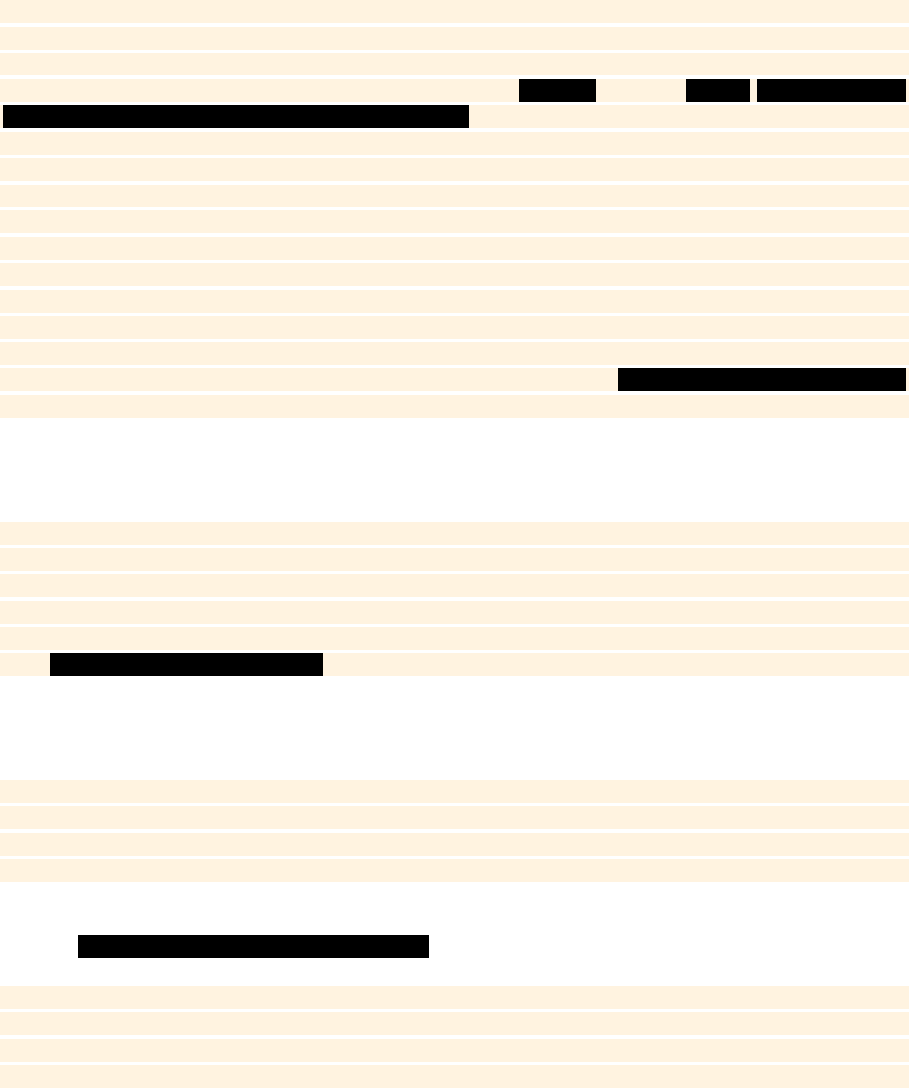
290
though they can make progress over longer timescales. Secondly, I try to teach both relatively
straightforward rules (country names with common nouns; superlative adjectives) and the general
principle. For the latter I use a flowchart produced in-house, which encourages students to ask the
question "Is this use general or specific?". I tend to rephrase this as "Do the writer/speaker and the
reader/listener both know which one they are talking about?", which students seem to find helpful.
Thirdly, I find it interesting that you describe the options as [a/an, Ø, the]. I know this is the standard
formulation, but it seems to me that many student errors with plural -s are actually part of the same
system network (in the SFL sense of a series of choices). However, I am not an SLA specialist, so this
maybe misguided.
What an interesting survey! I coordinate an in-sessional service in an ancient university. The service is
predominantly used by PG students, of which about 30% are PGRs. Much of our teaching takes place
in one-to-one tutorials. I'm answering your questions in this context. I spend a lot of time teaching article
use to PGs. We tend to approach teaching articles using Caplan's material: Caplan (2012) Grammar
Choices for Graduate and Professional Writers, Ch.5. One of the strengths of Caplan's approach is not
to teach articles, but the noun phrase. Another is to start the unit with a diagnostic test so that the one-
to-one teaching can be highly targeted. We combine this with getting students to notice and explain the
meaning of articles in their disciplinary reading. We then get students to nominate electronic articles in
their discipline and we (teach them to) make (self-)study material using their reading texts. I've seen
able students in challenging disciplines (in terms of article use) go from 30% accuracy to 95% accuracy
in a semester. In short, the key is to connect article use to meaning, to motivate learners by getting
them to notice articles and to interpret them more sensitively when reading, and (as a teacher) to take
account of disciplinary variation. BTW - Caplan is coming to our EAP conference at St Andrews in Feb
2017. You would make a very interesting conference speaker/delegate if you have time to come to StA.
The conference theme is Coherence & Cohesion. My contact details: Janie ajb31@st-andrews.ac.uk
In any case, good luck with your thesis.
Of course. This needs to be progressively trained. Accurate determination is an essential aspect of
academic writing (almost by definition!).
Dear Richard, this is a very interesting area indeed. I first came across the problem in a major way in
South Africa, where it is widely accepted now that speakers of Bantu languages do not use the article
correctly, even in academic writing. If you are interested, Vivien de Klerk, Rhodes University in
Grahamstown, has done research on this. However, in an academic context in Europe I do teach and
correct the incorrect use, mainly because many subject tutors are not as "liberal". Good luck with your
Phd! Regards, Monika Marienhagen
Helping them to identify usage in context, then awareness of their own errors through teacher correction
and finally, self correction.
This certainly is a difficult aspect of grammar of teach and sometimes the use of the article does not
even affect meaning. I'm not sure that 'grammar lessons' help so this is not really something I do.
Individual feedback followed by tutorials is the best way to tackle this area of grammar. Independent
work that is checked and discussed with the student is also helpful.
Explicit examples and practice activities, particularly showing how strange English sounds without
articles. NB "deduct" does NOT mean "deduce."
English articles are definitely a tricky issue to teach. There seem to be some very clear rules about their
use, but because there are so many, students often confuse them. Students whose L1 has this
grammatical feature (e.g. French, Spanish, Italian) will make fewer mistakes, but students whose L1 is
a case-based language (e.g. Polish, Serbo-Croat, Russian, Ukrainian), or students who are Arabic or

291
Chinese speakers will need to be continually supported with frequent exercises and focused correction
of their writing.
Yes, we can. Written and oral feedback on written work. Remedial teaching 'of article use' in class.
I point out to them the frequency of these errors, and ask them if they want me to indicate where they
are, and go over the rules with them. I also let them know whether or not they interfere with
communication or change the meaning of the sentence. However, the errors are so widespread (and
difficult to address) in speakers of EFL/ESL that my own feeling is that the use of articles is changing
in most varieties of English, especially in ELF contexts, and many students feel they are probably not
worth concentrating on.
The articles in the example are being used correctly in Indian English.
Many students see improving their use of articles as a difficult task. The rules might seem clear, but
when it comes to applying them students continue to make mistakes and feel frustrated and
discouraged about their inability to get them "right". As in the sentence above, often the errors do not
impede meaning; a proficient user of English can "fill in the gaps" without any trouble and there is no
ambiguity. However, if students' work is going to be published or produced for a wider audience, they
need to aim to produce work which is as accurate as possible. Not all readers are tolerant of
grammatical inaccuracy and it could undermine the authors' authority. I think if we don't point this out to
students, we do them a disservice. As for practical ways of improving students' accuracy in improving
English article use, I don't think there is any magical fix! I think most of it is in the hands of the students.
They need the will to improve this particular aspect of grammar, continued noticing of its use in written
texts, proof-reading of their own writing, perhaps practice grammar texts as part of independent study.
The teacher can help by focusing students' attention on articles regularly as part of feedback on
students' written production. Whilst it is useful to dedicate a lesson to article use, as it fulfills student
expectations to "do grammar", it is more important for teacher intervention to be timely and consistent.
Through text analysis and students chunking noun phrases. These chunks should then be recorded in
their unique and originally created academic phrasebanks
Exposure to natural writen / spoken English and awareness raising of patterns in article use.
292

293
APPENDIX 3
Transcripts of Six Tutor Interviews (Chapter 4)
The interviews were semi-structured. All tutors were asked questions 1-2 as worded below,
but answers were followed up with various prompts.
1. Question 2 asked about how often you teach the article system to your students. Can you
talk a little more about when you teach them and how you teach them? When are you most
likely to teach article use?
2. Question 3 asked about how likely you’d be to highlight the errors/give feedback in the
example. In general, do you give corrective feedback? How often and when do you give
corrective feedback? How do you do it?
Interview Transcripts
Interview Tutor #1
Question 2 asked about how often you teach the article system to your students. Can you
talk a little more about when you teach them and how you teach them? When are you
most likely to teach article use?
Teaching the article system? To be frank, I don’t have enough time to teach it in the classroom
in one session of its own. With the time pressure and everything we cover, I don’t have time
to dedicate time to this. We should be focussing on the process of researching and drafting their
work and looking at how texts hang together. It might come up in cohesion and I might send
them to a grammar reference for homework. But I don’t formally teach it in EAP. I think it’s
quite a trivial surface error. But each time when I correct writing…when I check students’
writing, I will check and point out any errors in articles most of the time.
Question 3 asked about how likely you’d be to highlight the errors/give feedback in the
example. In general, do you give corrective feedback? How often and when do you give
corrective feedback? How do you do it?

294
I would like to say I do peer correction and things like that…but I just don’t have time. Each
time… I correct the errors – I often use codes for all grammar errors. Students will get articles
marked two or three times…sometimes more if there’s a high stakes assignment. Maybe that’s
not ideal, but we are so short of time. So, each time if I spot any error I will just mark it. And
then in the tutorial time I will talk through it. And…if..actually if there are more than one
students making similar mistakes…in sort…maybe in of in similar usages, I will collect
examples and talk through very briefly in the classroom as a group.
How often do you correct their errors?
Most weeks I’ll micro-mark a few paragraphs of their writing. For the important assessed work
I’ll probably mark two pages of the first draft of the assignment.
Do you think that helps?
Definitely. Without correction they wouldn’t normally realise that they ‘ve used the article in
the wrong way and after I’ve picked it up they normally ask questions and try to reason…find
the correct way and they ask questions. OK, no I wouldn’t be able to evaluate how effective
this practice this. But I think in my opinion they do get better over time.
In question 4 you were asked for recommendations/suggestions about helping students
improve their accuracy of English Articles in writing….(do you have any further
comments?).
I gave a reference to a book which I’d recommend. Really, it’s also about talking to them about
their expectations. They can improve but they shouldn’t aim for perfect – that’s really unlikely
to happen.

295
Interview Tutor #2
Question 2 asked about how often you teach the article system to your students. Can you
talk a little more about when you teach them and how you teach them? When are you
most likely to teach article use?
Yes I do. So, this year I had a really high level group at the 10-week stage and I didn’t do
some things I normally do. But then I realised these students still had to do a presentation and
I often teach articles related to speaking and presentation skills. And yes, these students are
high level, but they still needed to stress articles in their speaking more, and I think in future
I’ll do it like I normally do.
In writing it’s really complicated. What I’ve found is…in a way some of them are very clear
about articles and …this is always the case…if you give them a gap-fill they would get it right
most of the time, but in their own writing it’s another thing. I think it’s because the flow is
interrupted too many times, so they don’t feel it.
So, thinking about what I normally do….In the 15-week Presessional I did this - I had one
session which was..like a 45 minute session where we look specifically at articles and then
there were two or three times when it came up and we had 5-ten minutes each time. And then
there’s the ARP feedback, so maybe I help them with articles 5 or 6 times on a longer
presessional. But I didn’t do this so much with the 10-week students.
Right, how do you do that?
OK…so…we had…we used the academic skills coursebook and there was a reference I think
in the extra materials to proofreading. It comes up really late in the materials, apart from the
Unit 1 focus on noun phrases. I think there was a proofreading exercise at the end. There was
also that poster like sheet explaining things that we can give them to download. It was helpful-
ish. But for me this EAP is a big change, I’m new to it. For me, most of my teaching in the
past 5 years has been heavily European so for an awful lot of articles it’s identical usage. They
just overuse the definite articles in generalisations. So I normally use that old Headway thing
– give them something to look at and then look through a text to think about why they’re there.
Then they have information about usage that they then read through. So it’s more awareness
raising than anything else.
Question 3 asked about how likely you’d be to highlight the errors/give feedback in the
example. In general, do you give corrective feedback? How often and when do you give
corrective feedback? How do you do it?
So on your questionnaire I put not sure for the first one (do you correct article errors during in
class writing?) because it would really depend what the focus of the in class writing was. If
it’s got nothing to do with the focus, no I probably wouldn’t. For the homework one…not sure
but likely. It would depend again. But for more regular writing tasks, it may depend on the
student. If they normally are good at them, then I would mention errors. But if they are terrible

296
all the time I tend to mark errors less. For the ARP and high stakes writing, I have to admit
that I mark article errors. I highlight the words and write ‘articles’ on areas where there are
problems. But I only do that for a few pages, then I tell them ‘that’s for you to now go and
find other errors in the rest of your work’. For the last one – when co-presenting with another
person – it would depend on the personality. If that person wants everything to be perfect, I’d
tell them.
OK, last question. In question 4 you were asked for recommendations/suggestions about
helping students improve their accuracy of English Articles in writing….(do you have
any further comments?). Do you have any more tips? Can we help students improve their
English article accuracy and if so, how?
OK, so from what I have….from what I’ve understood. OK look I’ve got my Diploma but I’ve
not done …I’m not someone who’s done a lot of reading on this. But from what I’ve
understood, articles are late acquired. So, to a certain extent, it’s one of those things that is
cyclical. It comes up at various points in what you’re teaching. It’s just a complicated thing.
So, what I’ve done in the past with …because I have taught Russians and East Europeans…so
for speaking, making it part of the rhythm. I teach it more in the speaking skills. You can
make them understand that there’s a space for the article, even by clapping it out. For example
‘as a result’…you clap on the syllable….include them in a group. The focus shouldn’t be on
‘why’, it’s just look it’s there in that chunk of language. As with everything, for some students
it really helps them, for some students it’s like water of a duck’s back. Another thing is that
box where is says known and unknown and in the next rows ‘listener knows’, ‘speaker
knows’…and students see they have to click both boxes to see they can use articles. It shows
them clearly that this thing needs to be known by both the reader and the writer to use the. And
if it’s not known by both reader and writer then it will be a or an. But it’s one of those things
that’s really hard to get them right. They make mistakes even at higher levels.
Interview Tutor # 3 (Appendix 3)
Question 2 asked about how often you teach the article system to your students. Can you
talk a little more about when you teach them and how you teach them? When are you
most likely to teach article use?
Not so much teach, but I ask students to focus on some article effects and then get them to
check their own work. In EAP it’s about getting them to notice language patterns in academic
contexts. And after that it’s also about peer marking and self-correction, more than teaching.
We have to get them to notice these patterns first…. Yes I do introduce it more formally at

297
the start. I often look at correct use first, maybe at how it works with definitions of
generalisations in the introduction, which is normally a plural form without article. This is
important because I can’t assume they’ve been taught it (article system) in the way I want them
to understand it. It fitted in quite nicely in the 10-week course this year at the beginning – I
brought forward the stuff about proofreading. But rather than focus on errrors, I first looked at
how correct use worked. Then I put a powerpoint slide up with a research article I’d chosen
but simplified a bit. I got them to focus on how articles determining specific examples at some
points and generalisations in others – I think I got this idea from Swales. Then I gave them
some proofreading exercises with correct and incorrect article use. Then I got them to start peer
marking their own work. I actually do that with every written task – they peer mark it every
time….before it comes to me. And that first time it was with aricles.
Question 3 asked about how likely you’d be to highlight the errors/give feedback in the
example. In general, do you give corrective feedback? How often and when do you give
corrective feedback? How do you do it? It’s just peer marking?
Yes, going back to your questionnaire, the only thing I think teachers should be micro-marking
themselves – because it’s so high stakes – is the ARP extended writing assessment. Otherwise
no. I think there’s a lot of teachers overmarking articles. The problem is, the student is just
going to depend on your spoonfeedinng. And to they actually learn? You’re not going to be
there in their main programme – they have to learn to do this themselves. And we have these
really amazing motivated students in EAP which is so great – I come from an ESOL
background where I spent so long trying to get students to take responsibility, but our
Presessional students get this more quickly.
Do you have any more tips? Can we help students improve their English article accuracy
and if so, how?
I think we can accelerate their progress, definitely, by helping them see the importance of
articles for moving us from non-specific to unspecific ideas, but they need to leave our course
ready to help themselves and learn how they do this in their own subject. We have lots of
independent learning resources for grammar and academic writing online – we can signpost
them to this in tutorials, but then turn it around and ask them to show you what they’ve been
working at on their own initiative in tutorials.
What place do you think grammar and a focus on form has in a Presessional EAP course?
Well my understanding of EAP is that we’re focussed on meaning in texts and I….I mean the
object is to help students understand the academic community and the expectations of this
community. OK, no we’re not language teachers and we shouldn’t be structuring what we do
around language form, but let’s be honest - it’s impossible to not teach some aspects of

298
grammar alongside the functions of academic language in a text. So when we teach academic
caution, I’m focussing students incidentally on the modal verbs, tense choice and adverbs in
the text that helps the writer hedge their language. How can we focus students on genre
differences of reflective writing and a lab report without focussing on how personal pronouns
are used in the former and greater use of passives might be found in the latter? Equally, I think
a focus on articles is useful when we look at definitions or generalisations.
Interview Tutor #4 (Appendix 3)
Question 2 asked about how often you teach the article system to your students. Can you
talk a little more about when you teach them and how you teach them? When are you
most likely to teach article use?
Yes, we need to teach articles in EAP if the students are IELTS 6.5 or below. For higher level
students, I think they’re sorting themselves out alone, but most Presessional students from
China need help. The Chinese students really struggle with articles because their first language
doesn’t have them. There isn’t much time, but I’ll try at least twice to pull some of the students’
errors that I’ve noticed and put them on the screen. They need to see how important articles
can be especially in definitions or about how generic articles work in an engineering topic and
the difference between when they generalise about a term in one paragraph but may need to
refer to specific and known things in another paragraph. And apart from that I send them to
grammar reference books. I tell them they should all have Hewing’s grammar book so if they
get a correction they don’t understand they need to look it up and learn the usage. I correct
their errors too so they can see what they need to learn.
Right, how do you do that? Question 3 asked about how likely you’d be to highlight the
errors/give feedback in the example. In general, do you give corrective feedback? How
often and when do you give corrective feedback? How do you do it?
I have codes, but I don’t have time to mark the whole assignment, so I just do a section and I
may ask them to re-write the errors. And we discuss in tutorials of course.
OK, last question. Do you have any more tips? Can we help students improve their
English article accuracy and if so, how?
I get students to keep a note of all new vocabulary and they should write down collocations
and regular phrases too. To be honest, articles can be taught lexically. The rules don’t always
make sense, it’s often just a case of learning phrases and lexical bundles that contain articles.

299
Interview Tutor # 5 (Appendix 3)
Question 2 asked about how often you teach the article system to your students. Can you
talk a little more about when you teach them and how you teach them? When are you
most likely to teach article use?
It depends on the context and when they are. If they’re on a 15-week programme I wouldn’t
try to overwhelm them by micro-marking them. Recalling your questionnaire from before.
From the get go I would try to introduce them to the idea of proofreading and learner autonomy.
So in the first week I’d expose them to the idea of how to correct some of these problems. I
created proofreading prompts… (checking countability, plurality). For articles I get them to
deduce three basic rules – that every single noun phrase needs a determiner, the
known/unknown principle and about generalisations. And I take them through these intensely
in this one session. So I’d expose the issues to them like this and make them aware of it, but I
wouldn’t keep pressing it. I wouldn’t keep micro-marking it. If they wanted to, in tutorials I’d
direct them to further resources, but it’s something they have to do autonomously. OK, if it
was the ARP (extended writing assignment) I feel there’s too much at stake so normally I
micro-mark the third page, or I would micro-mark a page or two, but they’d have to go over
the rest of it. Of course, it depends on where their weaknesses are. If they are fairly strong,
yes, it might be something we can focus on. But if they have bigger problems, these minor
issues of inaccuracy are not a priority. As teachers we’re automatically programmes to find
mistakes, but I try to hold myself back.
Question 3 asked about how likely you’d be to highlight the errors/give feedback in the
example. In general, do you give corrective feedback? How often and when do you give
corrective feedback? How do you do it?
I didn’t correct much on the 6-week course this year. But on the 10-week course last year, I
marked them …I would just put ‘G’ for grammar and I would leave it up for the student to
work out what the mistake is. I would leave it up to them to come to me if they didn’t’
understand what this issue was. I really want to reinforce learner autonomy. So another thing
I do is peer marking. I think er…I’ve especially learned this with learner autonomy, it’s more
about promoting their confidence. So with peer marking, it doesn’t matter if they’re not 100%.
It’s ok, but they will learn from their mistakes from making mistakes. And obviously I will do
some quality control.
Do you think correction of any sort helps them develop their accuracy long term?
…Er…I’m a bit off topic here but, especially coming from an ESOL background, where it’s
even more painful they will expect to be spoon-fed. But as teachers our goal is to promote
learner autonomy. I think it only helps them in the short term. I the long-term they need to be

300
able to do this themselves. I never go beyond specifying it’s ‘grammar’ …I never just give it
to them. If I find a student has repeatedly made the same mistakes, I might write at the top
‘you need to check this again for articles.
Do you have any more tips? Can we help students improve their English article accuracy
and if so, how?
When I found out on the 10-week programme, that the 10-week students are used to being in
that top 20% always. And they’ve gone from being big fish in a small pond to a small shrimp
in the ocean. They don’t realise it’s more about academic skills we’re teaching them, not
language. They expect more language, but in EAP it’s about academic discourse and skills.
It’s more about hedging and showing students how to put their academic voice in a text.
What place do you think grammar and a focus on form has in a Presessional EAP course?
There are EAP teachers who think there shouldn’t’ be any language focus in EAP. I should
state that my experience is mixed. It depends on the programme. On the Presessional courses
with older higher level students some teachers say ‘I’m not here to teach you language, I’m
here to teach you skills’. But then these teachers are correcting lots of errors so they are
focussing students on language, but not giving their students the signposts and autonomous
learning skills at the same time.
Interview Tutor # 6 (Appendix 3)
Question 2 asked about how often you teach the article system to your students. Can you
talk a little more about when you teach them and how you teach them? When are you
most likely to teach article use?
I think this is a really excellent topic. These are the trivial things that can show that you’re a
non-native. I think it’s great you’re looking at this. I’m sure loads of Chinese students are
struggling with this usage. But because they often don’t have a native tutor maybe they can’t
look at it. And there are more urgent problems they need to look at that we can help with.
To be honest when reflecting on my marking, I wouldn’t’ normally focus on article errors. I
prefer more often to focus on the way they structure their ideas. I don’t normally focus on
grammatical errors, I focus on how they convey their meaning. Also, to be honest with you,
as I…I did my Masters. And when I did all those assessment essays, I did realise that for me
personally article use…to be honest I do actually have this confusion in where to use
articles…for me it is still difficult…as I found out. It is so complex.

301
Question 3 asked about how likely you’d be to highlight the errors/give feedback in the
example. In general, do you give corrective feedback? How often and when do you give
corrective feedback? How do you do it?
To be honest, in your examples you sent to me of misusage. If I feel they just stand out, if they
are very inaccurate and confuse the reader, that would be when I’d point them out. I don’t feel
that confident correcting them, but I kind of feel I have to. Some students expect corrections.
Could you think of any cultural reasons for misunderstanding article use? As you’re
Chinese, perhaps you can help me understand whether it’s the students’ background or
their misunderstanding of academic genres that is the problem.
I don’t think it’s a problem with genre…they understand what’s needed in academic writing.
But it’s a pragmatic problem. In the Chinese system, we don’t really have this article system.
So it’s confusing where and when to put them. We have words when we want to be specific,
we can say ‘this one’ or ‘that one’. But I think like those…..I mean with these unspecific
words…. I think that pragmatically, we don’t have the articles system. I remember when I first
learned about this article system. I was in middle school. I remember the teacher saying the
article was like a hat that you have to put before of…a noun…so a noun cannot be without a
hat. But it’s very confusing, even now.
I was teaching English actually at University in China for five years. You know in China it’s
compulsory for the students to study English for the first two years. We call it ‘College English’
and we have a dedicated coursebook that they will study no matter what their subjects are. On
reflecting on these practices, we did actually do a lot of grammar practice. In fact, more often
or not we’re using multiple choice questions with texts, so you only need to pick out the correct
answer. So you’re not really producing your own writing. It’s very different…picking out the
correct one…to writing your own one. This college English is more about grammar. A major
part of it is to consolidate grammar points and a major part of it is to show them exam papers
and 60-70% of the exam is multiple choice. I don’t know why students make more errors in
their writing than they do in the tests, but I think it’s like….like being on a simulator to learn
to drive a car. However long you go on a simulator, it cannot prepare you for driving your own
car on the road. And English for Chinese students is like this. I actually use this analogy when
I teach essay writing. Knowing the rules is quite different to using the rules accurately.
Chinese students spend so much time on those multiple-choice questions but their knowledge
is not useful in real language situations. I notice some students overuse definite articles. It is
sometimes that Chinese students want to reinforce something. But it is really confusing.

302
Do you think it can have any negative effects when we correct students? Are there any
dangers of overcorrecting students? I worry what would happen if I tried to learn Chinese
writing and had lots of corrections on parallel forms like measure words or something
I wouldn’t have thought so, to be honest. They are all very keen. They can see that attending
this course can help them to improve. Actually, one of the feedback I had from students at the
end of the 6-week Presessional was ‘why don’t you teach more grammar’ and ‘why don’t you
teach pronunciation’. I think they would like more grammar.
303
APPENDIX 4
Information Sheet
Voluntary participation in research project
Background information
I am investigating frequent student errors in English article use (a/an/the). I wish to
identify the contexts that typically cause students the most confusion with a view to
developing further online resources to help students work on this grammatical aspect
more independently.
Your rights/promise of confidentiality
Your answers will be treated with complete confidentiality and any
published examples of errors analysed will be ‘anonymised’ (shown without your
name). No one apart from the researchers (Richard Nickalls and a small number of
colleagues) will see your individual responses (these will NOT be shared with other
teachers or departments).
Analysis of your written work/quiz answers will inform both my research and the
development of pedagogic materials that could help students with article errors.
What do you get from participation?
If you agree to participate, you will receive extra feedback about your accuracy in
article use. However, even if you do not participate, you will also be signposted to
further resources that can help you develop your confidence in this area of
grammar. All Presessional students will be invited to an end-of-study workshop,
regardless of participation.
You will not receive any financial payment for your participation. However, all
participants will be entered into a prize draw.
Summary of your right to refuse
• This project is voluntary. You can choose not to participate.
• There is no consequence if you choose not to participate.
• You are free to withdraw from this research project at any time before the end
of the Presessional and you retain the right to withdraw your results within a
month after competing the programme.
• The analysis will be anonymised and you will never be identifiable in any
presentation or publication of this research.

304
Consent Forms
Consent form for corpus data collection
Dear student
Thank you for expressing your interest in participating in this research project.
I wish to invite you take part in a research project and ask for your formal consent to use
some of the homework that you will submit for some research I am doing (and might
publish). As explained, your work will be treated with complete confidentiality and any
examples of errors analysed or published will be ‘anonymised’ (shown without your name).
About the study
Some students will be invited to extra sessions, depending on whether you are in a
control/experimental group. All students (regardless of participation)) will be invited to a
session about English article use in week 14 that may help you use articles more correctly.
If you are part of the experimental group, it should be stressed that you will be analysing some
errors made by your classmates and that (vice versa) your classmates will be asked to help
identify some errors in your own writing. You should only agree to participate in this research
if you are willing to discuss some article errors (including your own) identified in non-assessed
homework essays and placement test with the other study participants.
You will not receive any financial payment for your participation. However, all participants
will receive extra feedback about their essays and you may find the extra grammatical
instruction may help you write more accurately.
305
Your written work may be included in a ‘learner corpus’ which will be analysed to find
typical errors that students make in academic writing. The results of the analysis of
individual participants’ errors will not be shared with your teachers or the programme
director. Any analysis of this ‘corpus’ of written work will be presented as a whole, without
reference to individuals.
Confidentiality and your rights
• This project is voluntary. You can choose not to participate.
• There is no consequence if you choose not to participate.
• You are free to withdraw from this research project at any time before, during or after
the study. You retain the right to withdraw your results within a year after the study is
completed.
• The source files and personal information you submit/disclose will be treated with
complete confidentiality and stored very carefully on an encrypted computer drive.
• The corpus assembled from these files will be anonymised. You will never be
identifiable in any presentation or publication of this research.
If you still wish to participate in this project, I would be grateful if you could fill out the details
of the form provided and sign the form with your English or First language signature.

306
Information about the researchers
Richard Nickalls (PhD student)
EAP Tutor & EISU Website/IVLE Coordinator
English for International Students Unit (EISU)
University of Birmingham
Selly Oak Campus
Elmfield House
BirminghamB15 2RT
r.nickalls@bham.ac.uk
Dr Jeannette Littlemore (Lead supervisor)
University of Birmingham
Edgbaston
Birmingham
B15 2TT
j.m.littlemore@bham.ac.uk
Dr Nicholas Groom
University of Birmingham
Edgbaston
BirminghamB15 2TT
n.w.groom@bham.ac.uk
Agreement of consent/biographic information
Name:_____________________________
First language:_______________________
Age: Under 20 [ ] 20-29 [ ] 30-40 [ ] 40+ [ ]
Second language (other than English):__________________________
How long have you lived in England? (years/months)______________________
Current level: (B1/B2/C1):_____________
307
How many years have you been studying English? ________________
I give my permission for my submitted work to be used for research purposes (
please tick):
Signed____________________________

308
Consent documentation for use of online review (multiple-choice test) results
(Background information sheet given to students at VLE induction)
Dear student
I wish to use some of your review tests scores (which I showed you today) for my research into
Presessional students’ grammatical errors.
As explained, your score results will be treated with complete confidentiality and any
examples of errors analysed or published will be ‘anonymised’ (shown without your name).
Confidentiality and your rights
• You can still do the review quizzes and receive feedback without giving your consent.
• There is no consequence if you choose not to participate.
• The data will be treated with complete confidentiality and stored very carefully on an
encrypted computer drive.
• The results analysed from these scores will be anonymised. You will never be
identifiable in any presentation or publication of this research.
Prize Draw
I cannot pay you for letting me use your review test data. However, I have explained that your
consent could help me develop improved independent learning resources for the Presesessional
VLE. Moreover, if you consent to my use of your data I will put your name into a prize draw
and two students will win a £20 Amazon gift voucher.

309
Information about the researchers
Richard Nickalls (PhD student)
EAP Tutor & EISU Website/IVLE Coordinator
English for International Students Unit (EISU)
University of Birmingham
Selly Oak Campus
Elmfield House
BirminghamB15 2RT
r.nickalls@bham.ac.uk
Dr Jeannette Littlemore (Lead supervisor)
University of Birmingham
Edgbaston
Birmingham
B15 2TT
j.m.littlemore@bham.ac.uk
Dr Nicholas Groom
University of Birmingham
Edgbaston
BirminghamB15 2TT
n.w.groom@bham.ac.uk
If you are happy for me to use your quiz score data, please detach and sign the consent form
at the end of this document.Please contact me (r.nickalls@bham.ac.uk) if you wish to know
more about how the quiz scores will be used.
Richard Nickalls

310
Consent for use of my quiz data for research purposes
I give consent for my quiz scores to be used for analysis by Richard Nickalls for the purposes
of Research into English article errors.
Name: _____________________________
Class: _____________________________
First language: ______________________
Date: ______________________________
Signature: __________________________
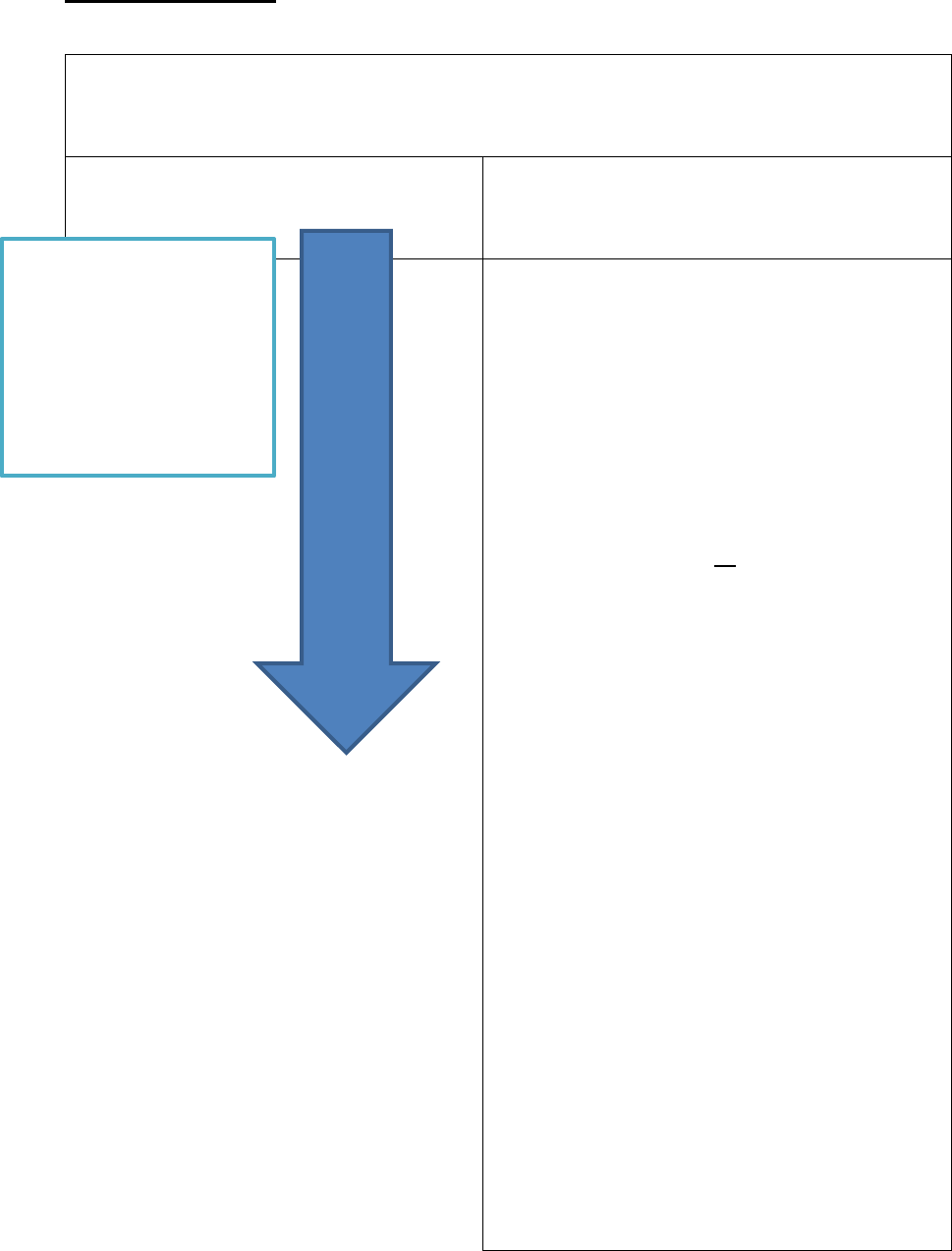
311
APPENDIX 5
Pedagogic worksheet
Is the noun (Side A)
A common noun?
A proper noun? (Capitalised)
Most proper nouns take Ø null article
William and Kate are engaged
I shop at Aldi and Waitrose
Many exceptions (some arbitrary),
Article IS used
When Proper noun qualifies a common noun:
an Aldi store
the Kate look
with Plural states/countries/unions
the United States
the United Kingdom
the European Union
with Rivers
the Thames
with Mountain Ranges
the Alps
Singular common
count nouns must have
a determiner!

312
To discuss nationalities that have no plural form
Germans / the English/the French
With Proper nouns that are unique and important
the Sun, the Prime Minister, the Queen
Common noun?
Do you wish to determine?
A single noun that your reader does not know about
The single noun that your reader knows about
The plural nouns that your reader knows about
The thing(s) your reader should know about
The ‘ranked’ thing: the only, the best, the 2nd
The thing (as apart from another)
Other determiners include numbers or other words (some,
its, their, this, these, such)
Do you wish to leave general?
Use Ø + mass noun
Information is important.
Use Ø + plural count noun
Companies need information.
Use a + singular count noun
A company without information cannot plan.
Exceptions (a few rare uses need noting):
She/he is in hospital, at home, at school (following a
preposition, we use Ø with certain buildings referred to as
a class).
She/he invented the XYZ device/concept/ method
(breakthroughs and inventions)
She/he plays the piano/the guitar (musical instruments)
The lungs/the heart/the liver (parts of the body)
When speaking as an expert about an entire class of
animals: the African Elephant has larger ears than the
Indian Elephant
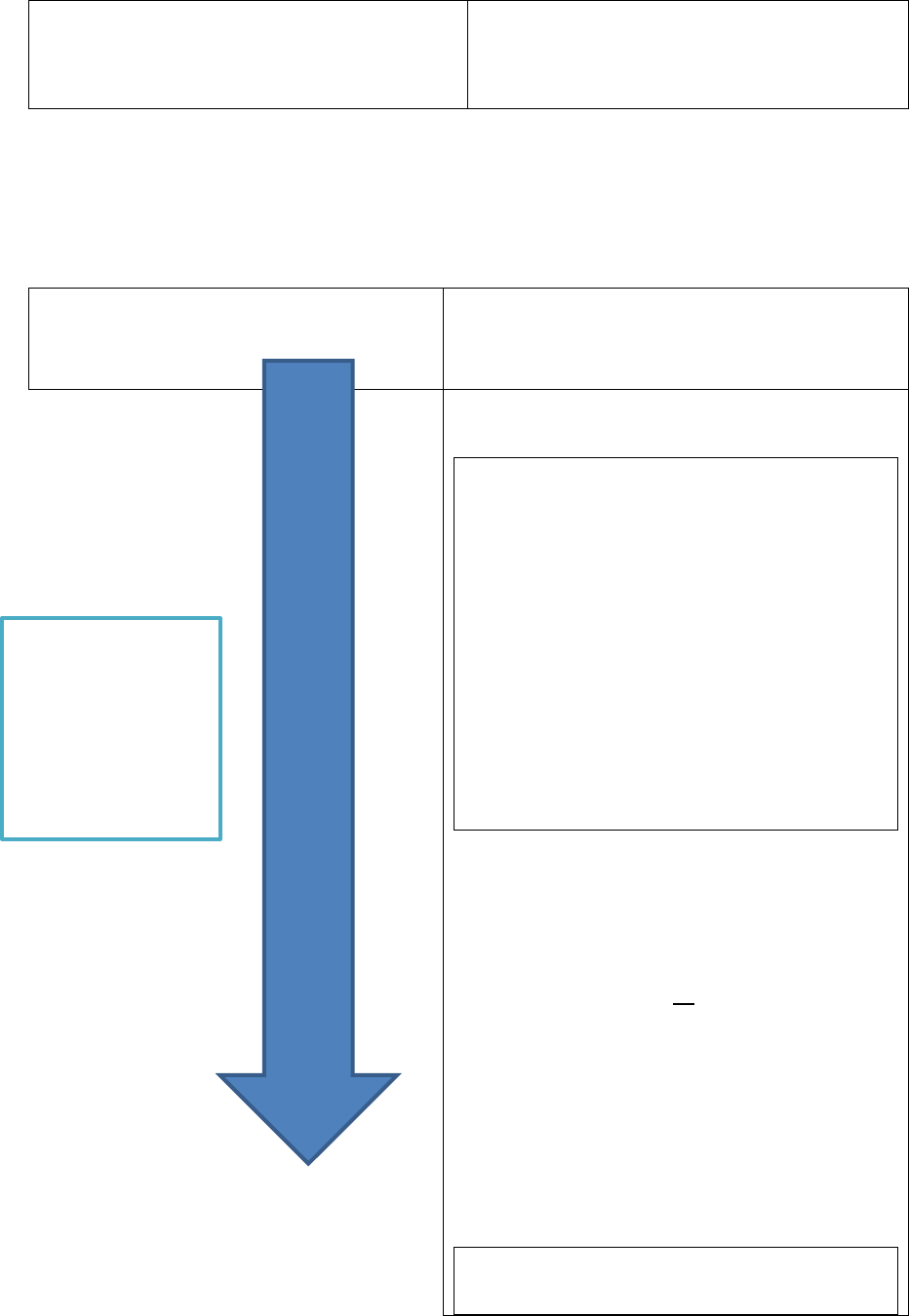
313
When using adjectives to class a group of people: the old
and vulnerable, the poor
b) Now read the text and look for examples to put in each box. (Side B/C)
A common noun?
1) A proper noun? (Capitalised)
Most proper nouns take Ø null article
2a.
Many exceptions (some arbitrary),
Article IS used
When Proper noun qualifies a common noun:
an Aldi store
the Kate look
2b.
Rule 1: Common
singular count
nouns need a
determiner!

314
with Plural states/countries/unions
the United States
with Rivers
the Thames
with Mountain Ranges
the Alps
To discuss nationalities that have no plural form
Germans / the English/the French
With Proper nouns that are unique and important
the Sun, the Prime Minister, the Queen
2.c
Common nouns?
2) Do you wish to leave use general?
Use Ø + mass noun
Information is important.
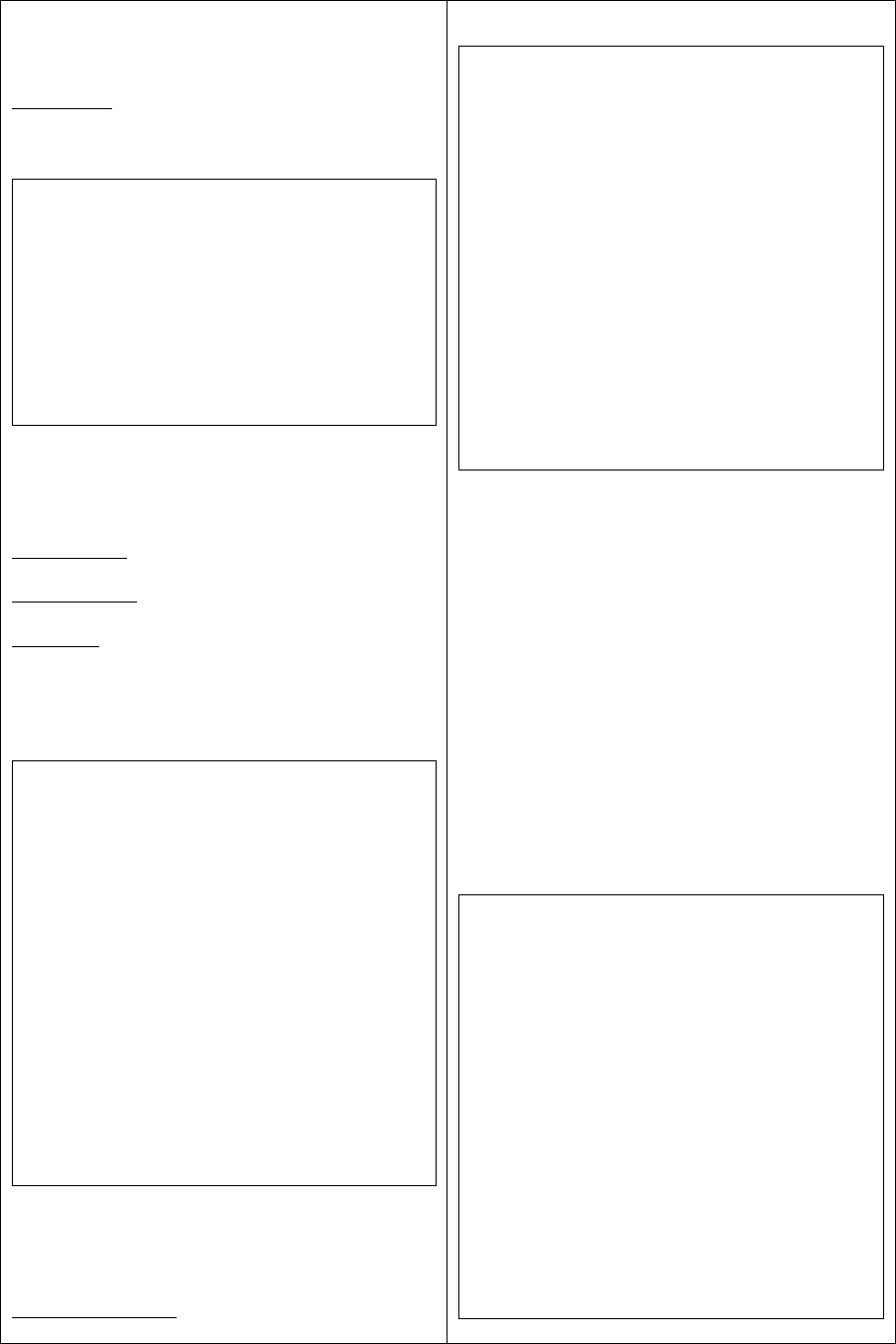
315
3)Do you wish to determine (make specific)?
A single noun that your reader does not know about
3a.
The single noun that your reader knows about
The plural nouns that your reader knows about
The thing(s) your reader should know about
3b.
The ‘ranked’ thing: the only, the best, the 2
nd
2a.
Use Ø + plural count noun
Companies need information.
2b.
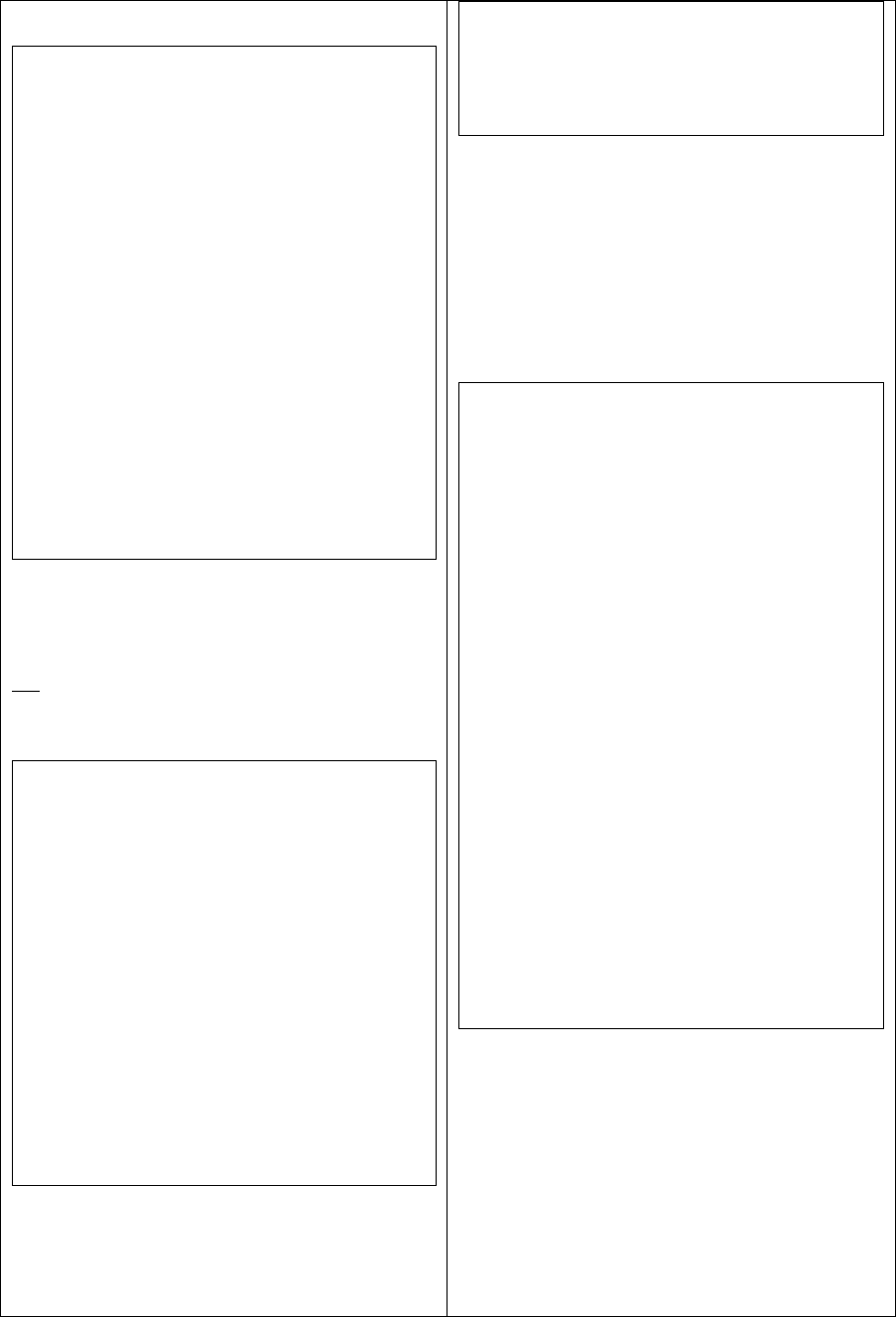
316
3c.
The thing (as apart from another)
3d.
Use a + singular count noun
A company without information cannot plan.
2c.
Exceptions (a few rare uses are very illogical):
She/he is in hospital, at home, at school (following a
preposition, we use Ø with certain buildings referred to as
a class).

317
4.Other determiners include numbers or other words
(some, its, their, this, these, such)
4.
She/he invented the XYZ device/concept/ method
She/he plays the piano/the guitar (musical instruments)
The lungs/the heart/the liver (parts of the body)
When speaking as an expert about an entire class of
animals: the African Elephant has larger ears than the
Indian Elephant
When using adjectives to class a group of people: the old
and vulnerable, the poor
Did you find any such illogical uses?
2.d.

318
APPENDIX 6
End-of-study anonymous survey (Chapter 5)
1. Overall, how useful has participanting in this research been for you?
A. Very useful
B. Quite useful
C. Not sure
D. Not very useful
E. A waste of time
1. Do you think your use of English articles has..
A. Become a lot more accurate
B. Become a little more accurate
C. Not changed
D. Become a little less accurate
E. Become a lot less accurate
2. Your teacher marks your writing homework and points out an error in an article,
e.g “Art. – you forgot the definite article).
How do you feel? (which one emotion below best described your reaction?
A. Very negative (I really dislike receiving feedback like this)
B. Negative (I dislike receiving feedback like this)
C. Not sure
D. Positive ( I like receiving feedback like this)
E. Very positive ( I really like receiving feedback like this)
3. In an academic writing class a teacher notices an error that you make with your
article (a/an/the ) and tells you. While other students are reading/writing he
quietly explains a rule to you (about article use).
How do you feel? (which one emotion below best described your reaction?
A. Very negative (I really dislike receiving feedback like this)
B. Negative (I dislike receiving feedback like this)

319
C. Not sure
D. Positive ( I like receiving feedback like this)
E. Very positive ( I really like receiving feedback like this)
4. Please use this space to provide any further (postitive or negative) feedback you’d
like to share.
Student responses
1. Overall, how useful has participanting in this research been for you?
A. Very useful [16]
B. Quite useful [6]
C. Not sure [1]
D. Not very useful [0]
E. A waste of time [0]
5. Do you think your use of English articles has..
A. Become a lot more accurate [12]
B. Become a little more accurate [9]
C. Not changed [2]
D. Become a little less accurate [0]
E. Become a lot less accurate [0]
6. Your teacher marks your writing homework and points out an error in an article,
e.g “Art. – you forgot the definite article).
How do you feel? (which one emotion below best described your reaction?

320
A. Very negative (I really dislike receiving feedback like this) [0]
B. Negative (I dislike receiving feedback like this) [2]
C. Not sure [1]
D. Positive ( I like receiving feedback like this) [7]
E. Very positive ( I really like receiving feedback like this) [13]
7. In an academic writing class a teacher notices an error that you make with your
article (a/an/the ) and tells you. While other students are reading/writing he
quietly explains a rule to you (about article use).
How do you feel? (which one emotion below best described your reaction?
A. Very negative (I really dislike receiving feedback like this) [0]
B. Negative (I dislike receiving feedback like this) [2]
C. Not sure [3]
D. Positive ( I like receiving feedback like this) [6]
E. Very positive ( I really like receiving feedback like this) [12]
8. Please use this space to provide any further (postitive or negative) feedback you’d
like to share.
It is useful because I can learn from my fault. When I do mistakes, it is easy to remember them.
This is very helpful for me to know where my mistakes are and to evaluate myself for improving
my weaknesses.
I learnt little about this form my teachers. I learnt it mostly form grammer textbooks. When doing
exams, I encountered little difficulty about article, but in writting I often hesitated how to use it.
I like the correction from teacher, however, when I make some stupid error, I feel a little bit
embrass and lesser confidence in English.
I always receive guidance from my teacher and I feel this is helpful to my learn English better. I
hope teachers could give me help usually.
It is useful for me,which help me have a better understanding about the difference of operation
and marketing,I really appreciate it.

321
I think the feedback from the teacher is helpful for me. I can learn more from the feedback and I
will try my best to avoid these error next time.
I have learned about the article use since I was in a primary school. I just can remember some
general rules for using article. It is helpful but not as much as I expect. I still want to study more
about this topic because it is very important for learning English.
it is very useful to help me improving English. :)
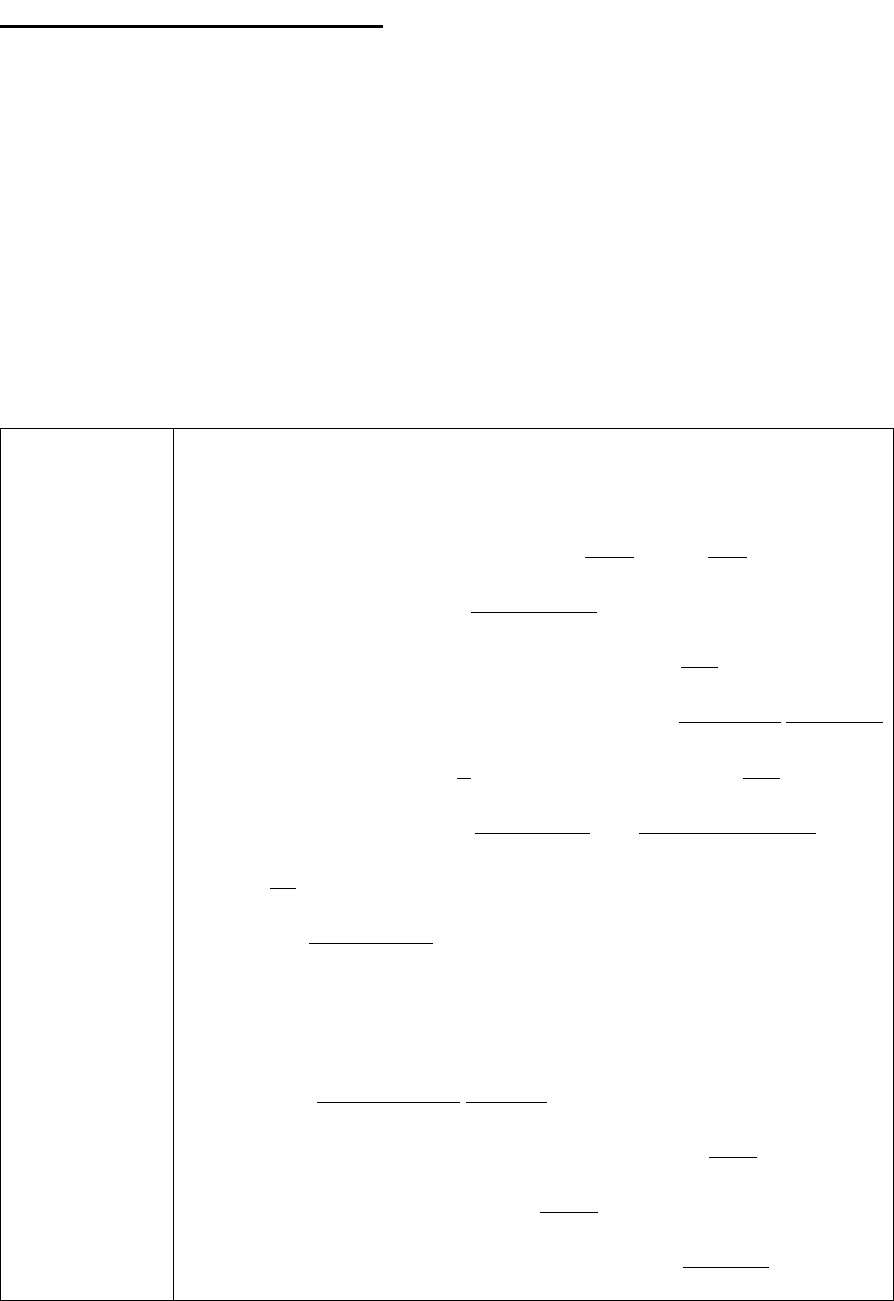
322
APPENDIX 7
BME Teaching materials (Chapter 5)
Study task 44
With your group, read the following extract from a student’s essay. A tutor has
underlined errors and has indicated problems using the correction symbols found in
appendix 1 of this guide. Discuss the errors and how the student could correct them.
W.W., Prep
Sing/pl
Modal
Aux. Vb., Sub.,
Art. Pl. expr!
Conj.
W.W.
Ref.
Many people believe that price is the only thing people care in the internet
market and brands have little contributions. Although price transparency
is one of the most important factors that people will consider on the
internet, I still disagree with the above opinion. Not only brand represents
the quality of products, but it has also many benefits for the customers.
This article will discuss what the brand is and shopping situation on the
internet. So, we can easily evaluate the price transparency is not the rule
that governs consumption on the internet.
According to Professor Bibb (in 2001), “a brand is a name, term, design,
symbol or any other feature that identifies one seller’s good or service as
distinct from those of other sellers.” Brand is also a communication tool
that guarantees the quality of products and provides the sense of safety or

323
Sing/Pl.
Art.
Art.
Conj.
Sing/pl
satisfaction for customers. So, some luxury brands such as BMW or
BENZ not only represent the quality of products but they also can satisfy
people’s desire.
• What are this student’s typical mistakes?
Identifying your own key errors is useful as you can then actively check for these when you
proofread your own work

324
APPENDIX 8
One-to-one semi-structures interviews with three students (Chapter 6)
Highlighted error:
The previous studies also formed two theories towards the entrepreneurs.
Eventual correction given to student after discussion:
Previous studies have also formed two theories towards entrepreneurs.
#1: This one, I’m not sure. I’m not sure how to use towards… = towards is a special word?
Researcher: So you’re not sure whether to say ‘the entrepreneurs’ or zero article
entrepreneurs? Can you explain why you’re not sure?
#1: Is it ‘ entrepreneurs’, no article?
Researcher: Yes that’s right, you don’t need an article here. Do you know why?
#1: The entrepreneur or entrepreneurs with s. =
Researcher: that’s correct. Why did you make the mistake?
#1: Habit? Sometimes in my mind I just use the like a habit. I see..now.
Figure 79: Student 1, conversation #1
Highlighted error: Innovation and value are the major selling points in ^consumer goods
industry.
Eventual correction given: Innovation and value are the major selling points in the consumer
goods industry
#1: This is wrong? But I think we use the only for one specific noun. Here I am being
general. In all consumer good industry.
Researcher: That’s impossible here.
#1:: (Laughing)! It doesn’t make sense!

325
Researcher: I think the easiest rule to remember is that a singular count noun needs a
determiner. This word industry.
#1:: Whatever! (laughing)
Researcher: Is it count noun or non-count.
#1:: Sighs…OK it’s a count count noun. But I was thinking….
Researcher: It’s a tricky word that catches a lot of people out (researcher shows LJ more
examples).
Figure 80: Student 1, conversation #2
Highlighted error: The limitation of the previous research explained the personality traits and
cognitive factors separately as independent aspects.
Eventual correction given: The limitation of the previous research was that it explained
personality traits and cognitive factors separately as independent aspects.
Researcher: Actually I think this one isn’t needed.
#1:: But It’s the previous research. It’s correct because it talked about the previous research
before.
Researcher: In this part of the essay, are you talking about traits and factors in a general way
or a specific way?
#1: Specific way… personality traits.
Researcher: I think in this part of the conclusion you are talking about personality traits in a
general way.
#1: Sometimes I think specific and sometimes general….OK I think I make a mistake.
Personality traits in general way?
Figure 81: Student 1, conversation #3
False self-correction: Firstly, the personality traits identified demonstrate both pros and cons.
(#1 thought the underlined (correct use) was a mistake.
#1:: Yes this was a mistake. I mean personality in general.

326
Researcher: Actually, it was correct. You need a definite article. The personality traits
identified.
#1: But you said in the conclusion it is general [ 10 secs ] I think I understand but
sometimes I ...
Researcher: the thing is this word ‘identified’. I think this changes the meaning in this
sentence. You are not being specific about the study again.
Figure 82: Student 1, conversation #4
Highlighted error: the manage team decided to enter new growing market with new product.
Eventual correction given: The management team decided to enter a/the new growing market
with a new product.
Researcher: you didn’t notice a mistake in this sentence I’m afraid.
#1: [5 secs] Oh yes a mistake, a new product.
Researcher: Any idea why you missed this mistake when you proofed it.
#1: I didn’t see it [ 2 secs] I see the mistake after I look at it…
Researcher: I’m afraid there’s another. Where’s the head noun in ‘new market’?
#1: growing
Researcher: no the head noun here is market
#1: [the new growing market]
Figure 83: Student 1, conversation #5
Highlighted error: The other one is the build-up method, which only subdivides the market by
a single factor, such as gender in cosmetics market and age in dress market.
Researcher: Is this correct or is there a problem?

327
#1: Hmmm…can I take my time? This is stressful now, you take me back to my high school…
[ student reads and rereads sentence for 50 seconds]…I’m not sure but I would prefer to put
nothing there. Let me read it again…[10 second pause]… no I’m not sure. [Teacher gives
student correction]…but …oh…there should be the here? It’s confusing. It confuses me
because cosmetics is plural…ah …ok I understand it is singular now.
Figure 84: Student 1, conversation #6
Highlighted error: The use of SAP is considered to be more attractive for the logistic
applications.
Eventual correction given: The use of SAP is considered to be more attractive for logistic
applications.
#2: I’m not sure about this one.
Researcher: So, logistical applications. Are you writing here about these applications in
general or in a specific sense?
#2: [ 20 secs Silence..] I think I know the grammar. The grammar says you can use both with
and with no article here.
Researcher: Yes. Look it’s arguably ok. Maybe it’s more style than an error. But I think most
native speakers of English would think you were being a bit informal here. You haven’t
mentioned this before and I think you’re writing about it in a general way.
#2: I think initially maybe I want to emphasise the application. But now thinking again I think
it’s a general idea, yes.
Researcher: Look, this isn’t ‘wrong’ in some contexts. Arguably this isn’t an error, but just a
stylistic problem. I personally think most native speakers would write applications with zero
article. You see, using ‘the’ here makes it sound like we have shared knowledge. But you
haven’t mentioned it before, so for me it sounds informal. But I must say, it’s a difficult one.
I might change my mind tomorrow!
#2: /Researcher: (laughing)
#2: So it’s correct in grammar to use both but in a general way it sound more normal to not
have an article?
Researcher: Yes I think so. But of course if you mentioned it before or in another context like
a presentation it would be correct.
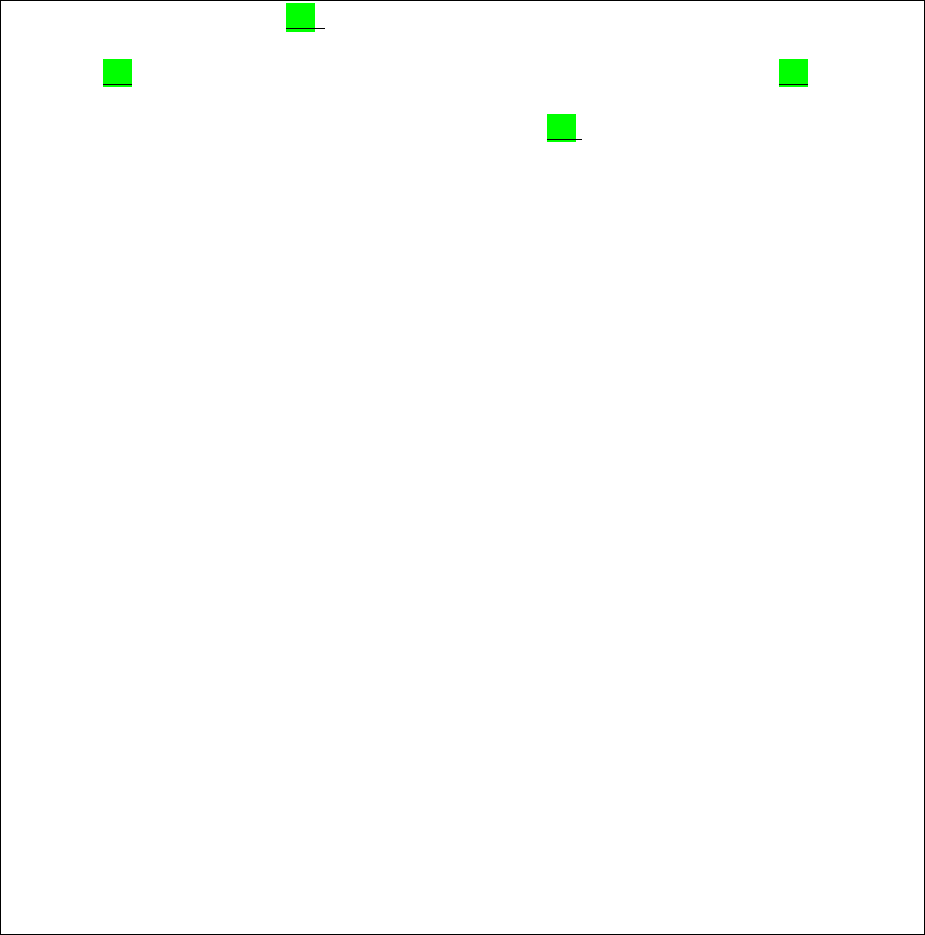
328
Figure 85: Student 2, conversation #1
Highlighted errors: Due to the overuse of conventional energies, the government needs to
invest in the sustainable energies. (later in paragraph). Rather than invest in the traditional
energies, the government needs to bulk transmission of the renewable energy.
Eventual correction given: Due to the overuse of conventional energy (supplies), the
government needs to invest in sustainable energy (sources).
Researcher: There’s are two errors here I’m afraid.
#2: So I think I should put the energy or energies?
Researcher: No I think in this context – in all these sentences energy is a mass noun.
#2: Oh…[surprised sounds] [ 5 secs] I think energies is countable.
RN:[ Yes I’m sure some specialists can talk about energies in the plural. You’ll see some
phrases with energies yes, but but I guarantee you here it’s a mass noun. There is no plural
form here. I’m 100% sure that any native speaker would write energy here as a mass noun –
because in this context people in the energy field would talk about energy. You could talk
about sources of energy – sources can be plural but not energy here. as a mass noun or
energy sources or sources of energy.
#2:: oh?! You say fossil fuels. I thought you have many energies: coal, gas, nuclear energies.[
(Researcher shows ZW some googled examples).
#2: [inaudible agreement/nodding his head]
Figure 86: student 2, conversation 7

329
Highlighted error: Many companies have adopted NASA technique in the last 50 years.
Eventual correction given: Many companies have adopted NASA techniques
(/technology/innovations) in the last 50 years.
Researcher: No, technique is countable here.
#2: [surprised] It is countable?
Researcher: yes, so you’d probably add an s to make it plural.
#2: Actually I wanted to use technology here. I remember I used technology a lot before, so I
wanted to change the word.
Figure 87: Student 2, conversation 8
Highlighted error: Criminals can overcome such IFRS regulations in
countries with the weaker investor protection
Eventual correction given: Criminals can overcome such IFRS regulations in
countries with weaker investor protection
Researcher: in this context protection is the head noun and it is a non-count noun. Are you
sure this is correct?
#2: Yes. [ 5 secs]. Protection is the head noun but I am being specific here.
Researcher: You’re being specific here…
#2: [The investor protection. Not any protection, specific investor protection]
Researcher: no I’m afraid you’re incorrect here. Well..it sounds very informal like this. It
would be better as a zero article.
#2: Maybe I mean…[7 secs] I actually think this word is difficult.
Researcher: You were being more general about criminals in general?
#2: Yes…[2 secs] Yes I think before I wrote the protection I thought…but I think count or
non-count, it is specific. It is general. Zero article?
Researcher: Zero article. I can’t see any mention of this non-count noun before.
#2: (agrees non-verbally)
Figure 88: Student 2, conversation 9

330
Highlighted error: Moreover, the youth are always affected by the peer pressure
Eventual correction given: Moreover, the youth are always affected by peer pressure.
Researcher: So, let’s look at this sentence, number 3.
#3: OK Ok
Researcher [Are you…]
#3: [Oh! Mistake! Ha ha. OK so youth are always affected…]
Researcher: No the youth is right.
#3: Oh! [5 secs]. The youth but the peer pressure has zero article?
Researcher: Why do did you write ‘the peer pressure’. It’s possible in some contexts, but not..
#3: [but I’m being specific….not any pressure, I mean the peer pressure]
Researcher: No I think you’ve qualified the word pressure which is a mass noun. You’re still
speaking in a general way. It’s the first time you mention peer pressure?
#3: Yes! Ha ha. Sometimes I think I understand but sometimes I don’t.
Figure 89: Student 2, conversation 10

331
Highlighted error: The gap between two groups of people’s income has ^ negative effect on
consumption.
Eventual correction given: The gap between two groups of people’s income has a negative
effect on consumption.
Researcher: I’m afraid there is an error you missed. There’s a word missing.
#3: Ah…oh (nodding head). The negative effect. Yes OK
Researcher: There has to be an article yes. Is it a or the?
#3: The negative effect.
Researcher: Really? Have you mentioned the negative effect before?
#3: Yes..mmmm..I just think you can’t say a negative effect. I want to say a greater impact of
the effect. I want to say this effect has a wide range not a certain effect.
Researcher: I think a native speaker would say a negative effect.
#3: (surprised)
Researcher: For me I think you’d only use the definite article here if you’d mentioned this
effect before. Did you?
#3: Yes I think so yes…
(after 3 minutes in which #3 and researcher search error)
#3: No…OK.
Reseacher: So I think the best way to explain this is that you’re not being specific, you’re
talking about things in general. And effect is a singular count noun so it needs an article. You
haven’t mentioned this – you don’t want to determine it definitely, so you use the indefinite
article.
#3: OK (laughs)
Figure 90: Student 3, conversation 11

332
Highlighted error: To solve different hukou problems of migrants in different cities, ^Chinese
central government decentralises the power of ….
Eventual correction given: To solve different hukou problems of migrants in different cities,
the Chinese central government decentralises the power of ….
#3: Mmmm….OK….. the migrants in different
Researcher: [no it should be the Chinese central
Government]
#3: OK, so perhaps it is specific. OK.
Reseacher: the main thing is you have a count noun: government. You need a
determiner.
#3: OK
Figure 91: Student 3, conversation 12
(teacher made the mistake)
Highlighted error: Zara’s regular new looks and dynamic brand attract people to ? shop.
Correction withdrawn.
Researcher: Yes it’s a mistake. So, shop – count noun or mass noun?
#3: [5 secs] No. I mean to shop. I use a verb.
Researcher: Oh…yes of course. I’m sorry. It’s fine. Yes that’s not an error if it’s a verb.
Figure 92: Student 3 conversation 13
333
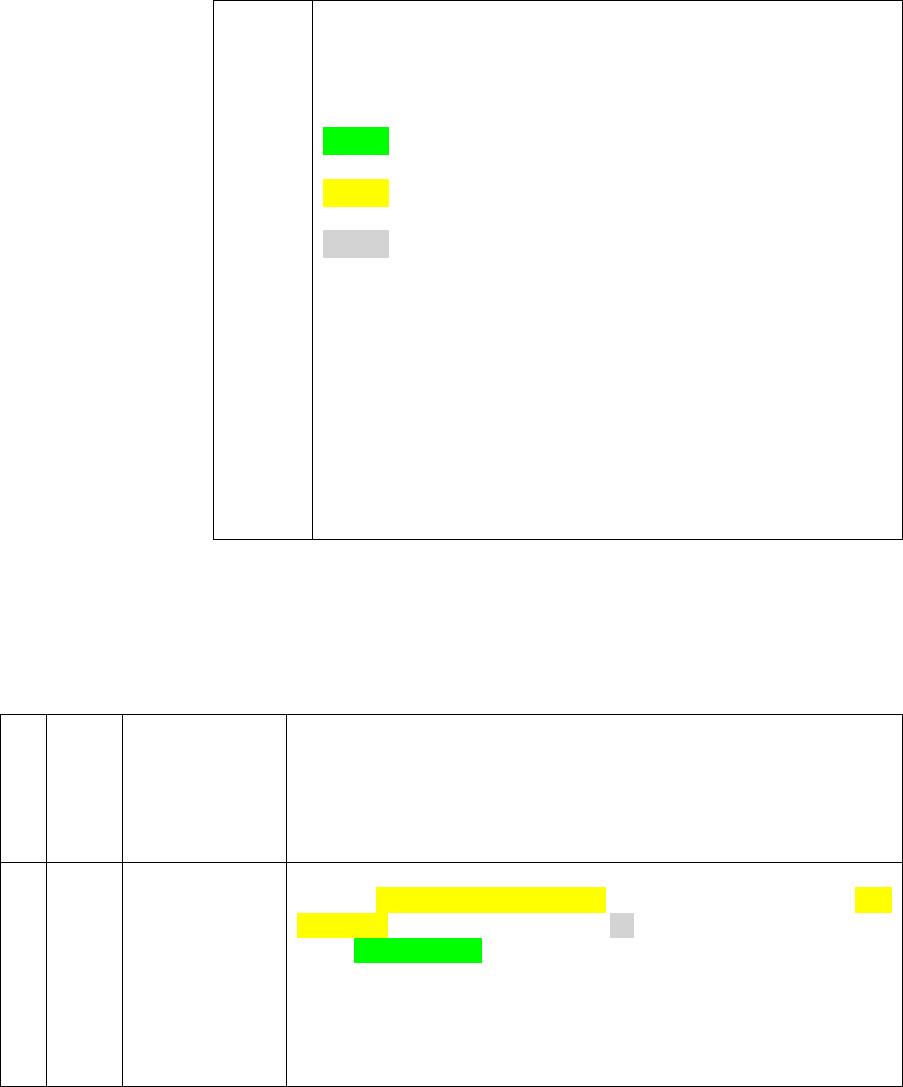
334
APPENDIX 9
Chapter 7’s Multiple-Choice quiz on article use
Key
Type 1 generic contexts (6)
Type 2 definite contexts (33)
Type 3 indefinite contexts (32)
Type 4 non-referential contexts (15)
Type 5 Idiomatic/proper nouns contexts (15)
*lexical density=the number of lexical words (or content
words) divided by the total number of word (Ure, 1971)
** Readability measured by Flesch–Kincaid readability test
(providing equivalent US grade level required).
Items
Lexical
density /
Text type
1
4
Low Density
General
English
I had [a] productive morning at work. I developed [an]
algorithm that could make [a] change to how we
enter [the] market.
[ * Lexical density: 40.92%; ** Readability score: 5.33 ]
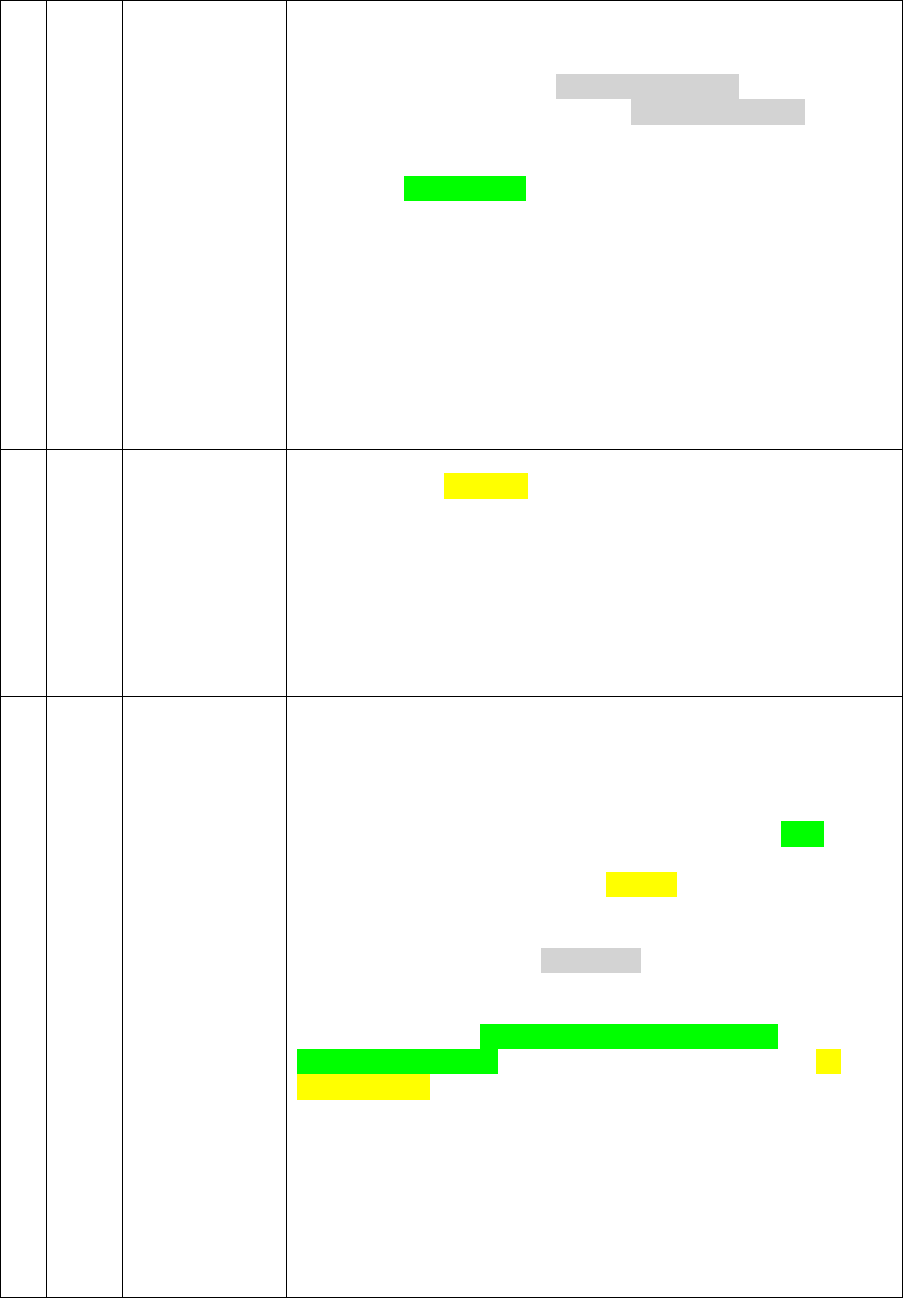
335
2
3
High Density
Academic
Writing
Abstract.
The article discusses how [Ø] latent semantic analysis (LSA)
can be used to analyze electronic [Ø] health records to show
medical terms and keywords related to the same medical
condition appearing across documents. The authors also
cover how [the] method could be applied to the management
of medical treatment by identifying unique cases for special
attention.
[* Lexical density: 63.64%: ** Readability score: 13.66
source (2)]
3
2
Low Density
General
English
Can I give you [a] piece of advice? Do you know [the] active
learning method?
[* Lexical density: 46.67%: ** Readability score:8.54]
4
6
High Density
Academic
Writing
Abstract
[Ø] pain is a part of childbirth. However, there had been
very few studies into relative perceived pain levels at
childbirth before 2015. Thus little is known about [the]scale
of pain that different women feel. Even in recent years,
although there have now been [a] few empirical studies,
there remains little research with the rigor and scale
required to scientifically examine this crucially important
area. Moreover, without [a] system to reliably compare
findings, researchers struggled to measure subjective self-
reported perceptions and Teale's (2015) study was the first
project to propose [the] severity of perceived pain
classification system. While there are still today only [a]
small number of research projects investigating this area,
interest is growing in this promising research field.
[* Lexical density: 66.16%: ** Readability score: 12.85]
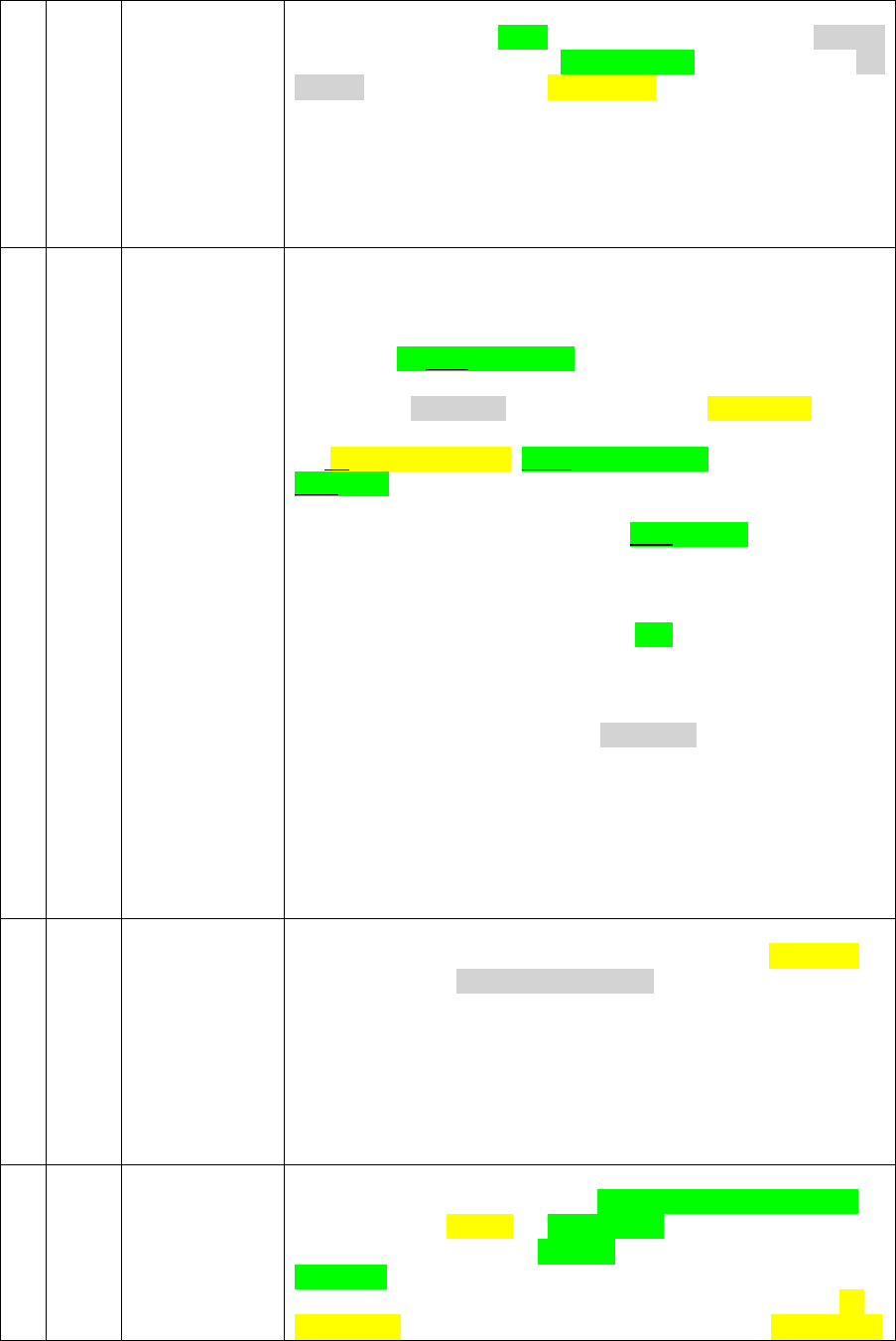
336
5
8
Mid-Density
General
English
I have two brothers. [The] older one is training to be [a] pilot
with [Ø] British Airways. [The] younger one is still at [Ø]
school. When he leaves [Ø] school, he wants to go to [Ø]
university to study [Ø] law.
[* Lexical density: 52.78%; ** Readability score: 3.65)
6
10
Mid Density
Academic
Writing
Abstract
This article seeks to acknowledge [Ø] fear as a strong
presence in [the] workforce by identifying from whence it
comes. It further seeks to offer clarity on how individuals
respond to [Ø ] fear. For this research, [a] sample of 776
employees were posed 19 questions which were measured
on [a] Likert-type scale. [The] questionnaire was developed by
[the] authors in the absence of any such measurement tool
which blatantly asks employees what makes them fearful in
their place of work. Distributions of [the] sample covered entry
level, supervisor level, manager level, and senior manager
level. Results indicate that concerns over the opinion of their
direct supervisor and the fear of being fired or laid off are the
primary fears of employees. [The] analysis indicates
additional categories or clusters of fear. This research
recommends that manager-subordinate relationships and
communication must improve to foster an open environment
which reduces the instances of [Ø ] _fear.
[* Lexical density: 54%: ** Readability score:12.73]
7
3
Mid-Density
General
English
[Ø] tennis is my favourite sport. I play four times [a] month if
I can but I'm not [a] very good player.
[* Lexical density: 52.38%: ** Readability score:3.11]
8
22
Mid density
(News genre)
It has been announced that for [a] third consecutive month
there has been [a] rise in [the] number` of people
unemployed, rather than [the] fall that has been predicted.
[The] rise was blamed on continuing uncertainty
over government economic policy, and couldn't come at [a]
worse time for [the] Prime Minister, who is facing [Ø] growing
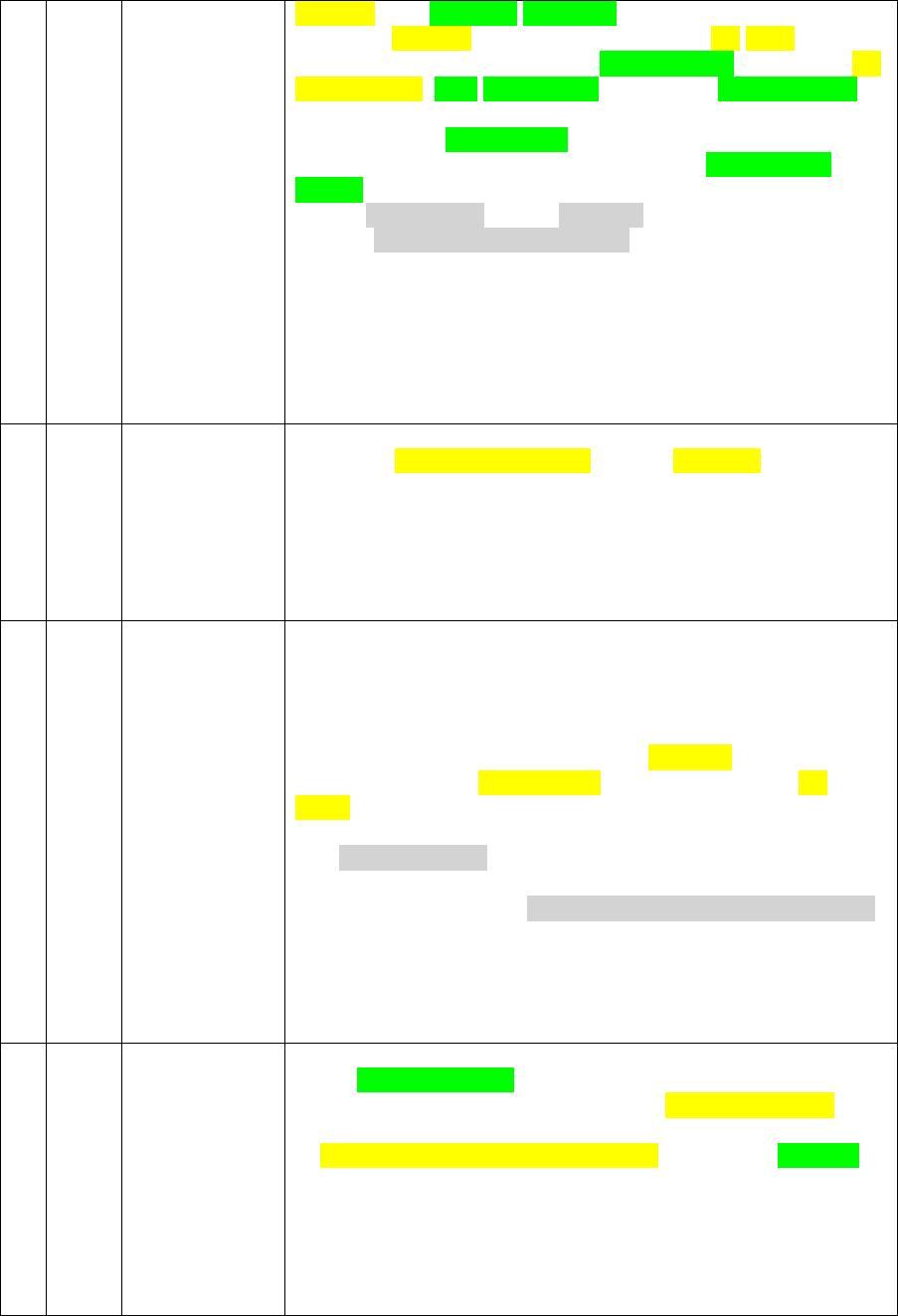
337
criticism over [the] way the policy is being so frequently
changed. [Ø] MPs are increasingly voicing [Ø] fears that
despite the recent devaluation of [the] pound and cuts in [Ø]
interest rates, [the] government still expects [the] recovery of
the economy to take three of even four years. To make [Ø]
matters worse, [the] number of small businesses going into
[Ø] liquidation is still at a record level, and [the] housing
market is showing no signs of recovery. Some backbenchers
expect [an] election before [the] end of the winter unless
there is [a] rapid change of fortune.
[* Lexical density: 51.02%: * * Readability score:14.18]
9
3
Mid-Density
General
English
We spent [a] pleasant evening having [Ø] drinks at [Ø]
home.
[* Lexical density: 55.55%: * * Readability score:4.96]
10
6
Mid Density
Academic
Writing
Abstract.
The positive association between unemployment and [Ø]
property crime is well known (Mustard 2010; Lin 2008;
Nordin 2009). This article discusses [a] study that evaluated
the association of [Ø] long-term unemployment and [Ø]
crime. This involved analysis of annual data from 288
municipalities in Sweden from 1998 to 2012. Results showed
that [Ø unemployed adolescents are more prone to violent
crimes than property crimes. Several recommendations are
made that could advise [Ø] future crime and policing policy.
[* Lexical density: 58.9%: ** Readability score: 11.6]
11
4
News genre
Since [a/the] particular law affecting random alcohol
testing was changed, there has been [an] alarming rise in
the number of pilot arrests. This was illustrated by the case
of [a] long haul passenger airline pilot who broke [the] law
and was found to be three times above the new legal limit.
[Lexical density: 52.94%: * Readability score:21.71]
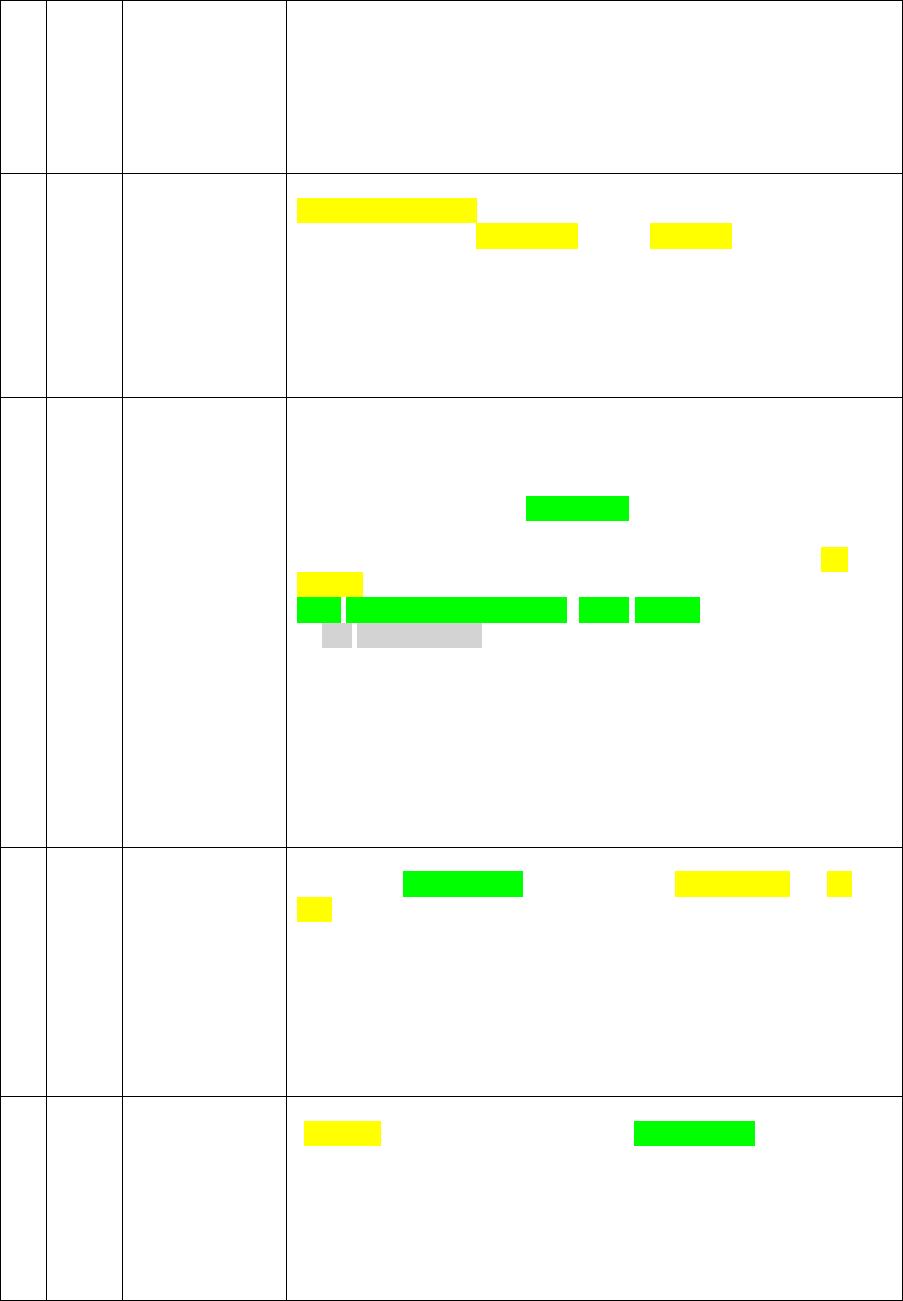
338
12
1
Mid-Density
General
English
There are millions of stars in [Ø] space.
[* Lexical density: 52.86%: * * Readability score:0.63]
13
4
Mid-Density
General
English
[Ø] unemployment is increasing at the moment and it's
getting difficult for [Ø] people to find [Ø] work. In [the] long
term, I plan to move country if things don't improve.
[* Lexical density: 53.57%: * Readability score: 6.73]
14
5
High Density
Academic
Writing
Abstract.
Performance Appraisal is an important part of management.
This study investigates [the] effect of features of
performance appraisal systems (PAS) on marketing
managers' behavioural and psychological responses. [A]
survey of US marketing managers was conducted to test
[the] developed hypotheses. [The] results support the notion
of [Ø] direct effects of the performance appraisal
characteristics on the consequence variables.
[* Lexical density: 60.34%; * * Readability score:14.28]
15
4
Low Density
General
English
When I left [the] station, I had to stand in [a] queue for [a]
taxi for [a] long time.
[* Lexical density: 36.84%; ** Readability score:5.48]
16
3
Mid Density
Academic
Writing
[Ø] most main roads in this part of [the] country follow the
line of roads built by [the] Romans.
* [Lexical density: 55.56%; ** Readability score:5.2]
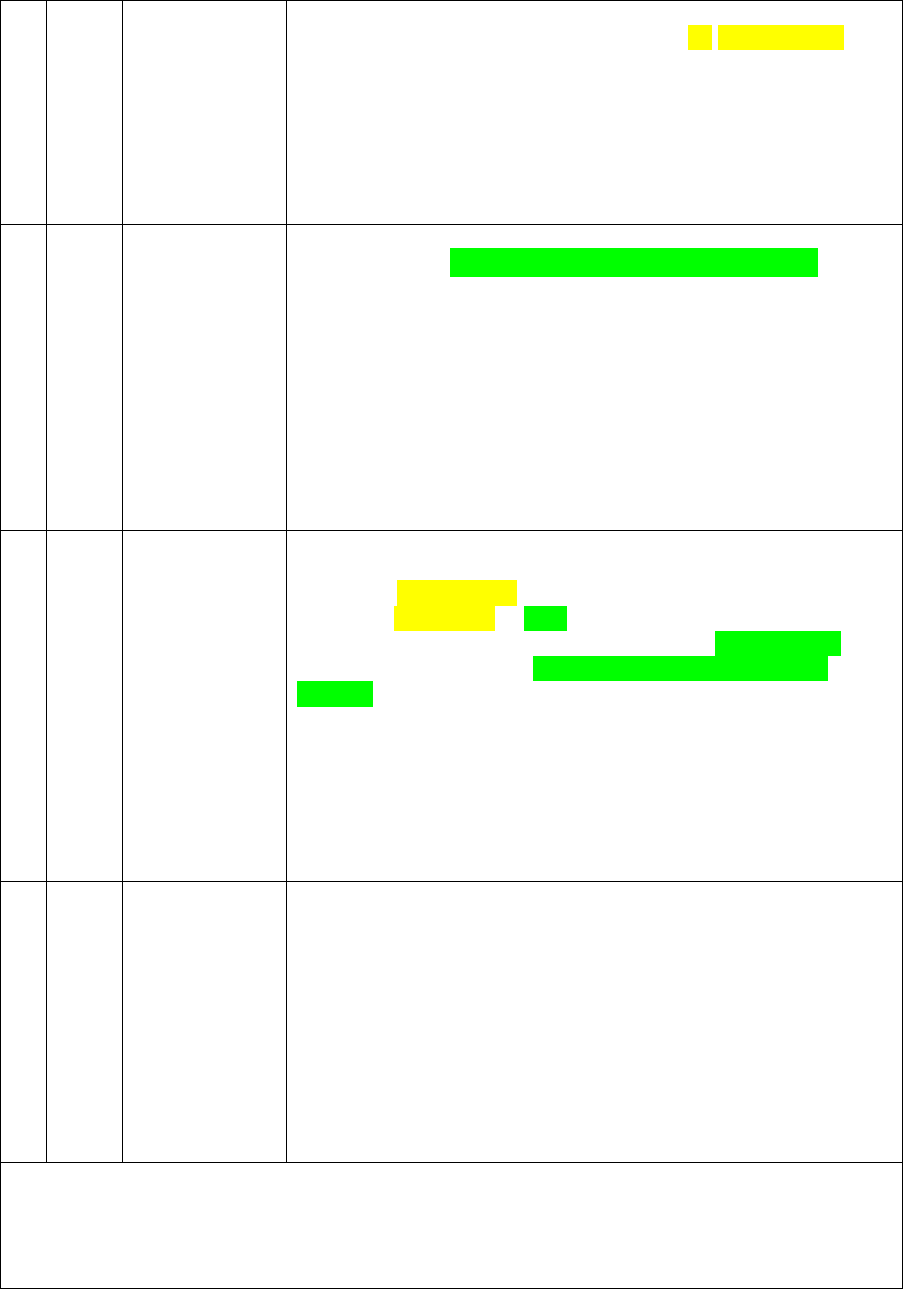
339
17
1
Low Density
General
English
It took us a long time to get here. It was [a] long journey.
[Lexical density: 50 %; ** Readability score: -0.22]
18
2
Mid Density
Academic
Writing
[Ø ]Africa has [the] highest fertility rate of the_world, nearly
7%.
[* Lexical density: 54.55%; * * Readability score: 8.01]
19
6
Mid density
(News genre)
Compared to the service sector, [the] UK has witnessed a
decline in [__] industry since the 1950s. For example, there
has been [a] decline in [the] car manufacturing industry. This
came on top of huge market uncertainty in [the] industry
following the revision of [the]diesel emission standards
system.
[* Lexical density: 51.02%; * * Readability score:13.19]
20
3
High Density
Academic
Writing
[The] Oxford English Dictionary defines organizational structure as
a formal and informal framework of policies and rules, within
which [an] organization arranges its lines of authority and
communications, and allocates rights and duties.
[* Lexical density: 58.82%; * * Readability score:21.95]
Total:100

340
Question Text Sources
[1] [6] [9] [13] [17] adapted from Murphy, R., (2012) English Grammar in Use, Cambridge:
Cambridge University Press.
[2] Fresneda, J., Gefen, D., Endicott, J., Larsen, K. (2014) A Guide to Text Analysis with Latent
Semantic Analysis. Journal of Information Systems. 41 (3). 233-235.
[3] [19] Author invented texts
[4] Adapted from Wilson, C. L., & Simpson, J. A. (2016) Childbirth Pain, Attachment
Orientations, and Romantic Partner Support During Labor and Delivery. Personal
Relationships, 23(4), 622–644. doi:10.1111/pere.12157
[6] Cooper, R.K., (1997) Applying emotional intelligence in the workplace. Training &
development, 51(12), pp.31-39.
[8] [11] [12] Adapted from Hewings, M. (2013) Advanced English Grammar in Use,
Cambridge: Cambridge University Press.
[14] Adapted from Idowu, A. (2015) Performance Appraisal Systems and their Effects on
Employee Motivation. Proceedings of the 2nd Business & Management Conference, Madrid.
[18] [20] Reproduced with kind permission from anonymous students.
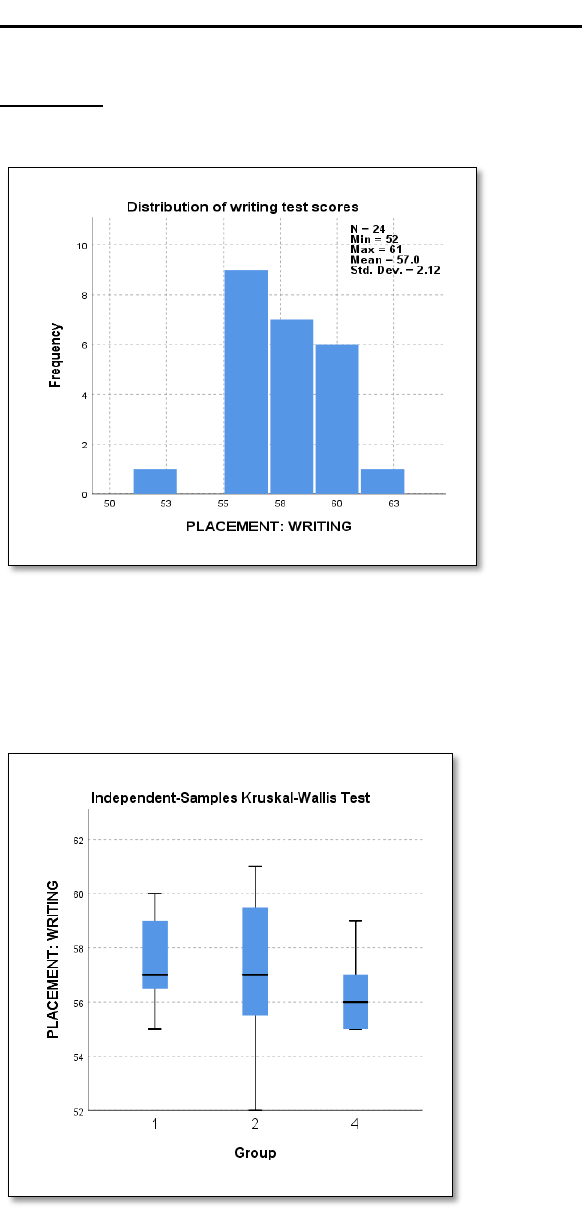
341
APPENDIX 10
Supplementary Figures not shown in main body of thesis
Chapter 5
Figure 93: Distribution of written placement test scores (Chapter 5)
Figure 94: Distribution of student scores in the placement test
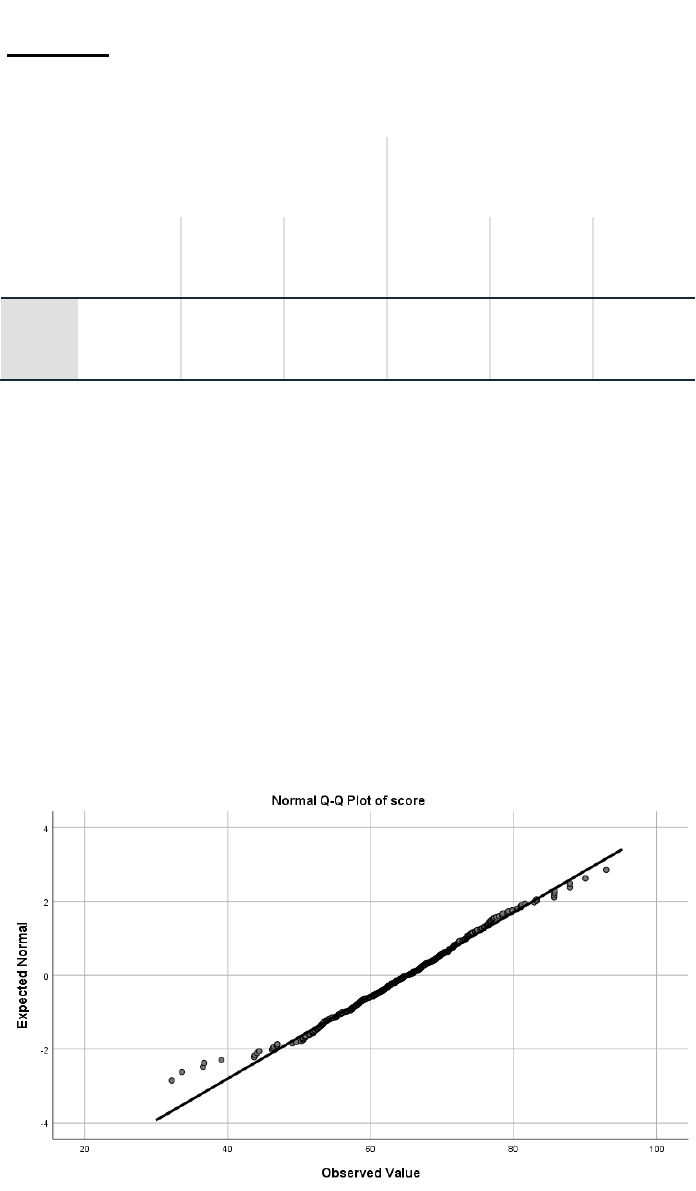
342
Chapter 7
Tests of normality
Kolmogorov-Smirnov
a
Shapiro-Wilk
Statistic
df
Sig.
Statistic
df
Sig.
score
.024
455
.200
*
.992
455
.012
*. This is a lower bound of the true significance.
a. Lilliefors Significance Correction
Figure 95: Test of normality (Q scores)
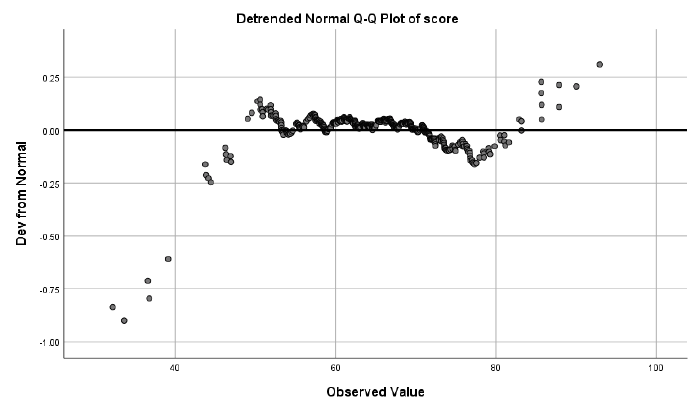
343
Figure 96: Tests of Normality (Detrended Q scores)
